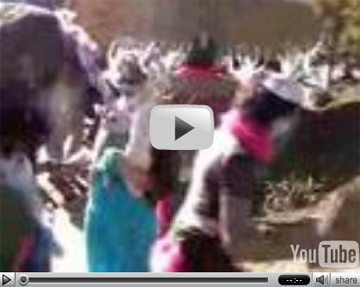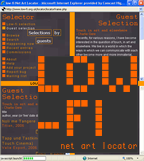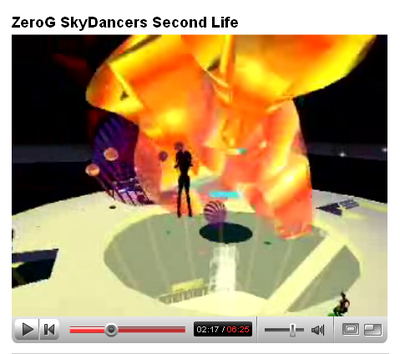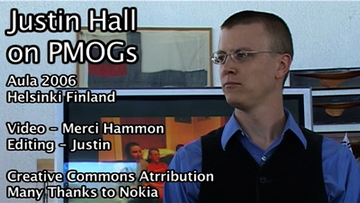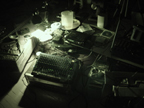July 10, 2007
[1001] 1001 nights cast news
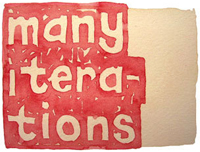
Have your Say, Workshop and more
1001 NIGHTS CAST News: THE THREE-QUARTER MARK; YOUR SAY; MOVING TIMEZONES; LONDON WORKSHOP.
THE THREE-QUARTER MARK: Sometime between tonight's performance (#750) and tomorrow's I will pass the three-quarter mark of the project. Since the two-third mark back in April, I'm very honoured to have performed stories by these new contributors to the project: Jordan Peimer (LA), Peter S. Petralia (London), Catherine Lord (LA), Adrian Heathfield (London), Sara Jane Bailes (Bristol), Karen Christopher (Chicago), Rinne Groff (NYC), Rebecca Schneider (NYC), Tony White (London), Geoffrey Batchen (NYC), Trevor Smith (NYC), Kate McIntosh (Brussels), Michael Grosberg (NYC), Hannah Chiswell (UK), Angela Piccini (Bristol), Lina Saneh (Beirut), Thalia Field (Paris), Alisa Lebow (London), Jane Gleeson-White (Sydney), Robin Bale (London), Branislava Kuburovic (Prague), Lara Pawson (London), Matias Viegener (LA), Kathryn Ryan (Sydney), James Tierney (Portland), Linda Dement (Sydney), Agnes Kocsis (London) and Nicholas Royle (London).
YOUR SAY: There is a new feedback section on the site. It's called Your Say. If you want to make a comment about a story, a performance or the project in general, please Have Your Say. You can choose to have it published on the site or to keep it private. If you want to see the published comments, hit the What You Said button.
MOVING TIMEZONES: The project moves to London on Tuesday July 17. That night, performance # 757 will be webcast at 9.10pm. That is: 10.10pm in Paris, Madrid and Prague 11.10pm in Jerusalem, Beirut and Istanbul 4.10am, July 18 in Perth, Hong Kong and Manila 6.10am, July 18 in Sydney 7.10am, July 18 in Auckland 4.10pm in New York, Toronto and Bogota 1.10pm in Los Angeles
LONDON WORKSHOP: Ten writers from the UK will join Barbara Campbell in London on July 20, 21 and 22 to write a three part story for the project. The writing workshop is part of DIY 4. DIY 4 is a collaboration between the Live Art Development Agency, Artsadmin, and New Work Network, and is being developed with Nuffield Theatre/LANWest, New Work Yorkshire, Fierce Festival, Colchester Arts Centre, The Basement Arts Production South East, and Dance4. DIY 4 is part of Joining the Dots, a Live Art Development Agency initiative supported by the Esmée Fairbairn Foundation and the Calouste Gulbenkian Foundation.
Posted by jo at 02:41 PM | Comments (0)
July 06, 2007
Régine Debatty Interviews
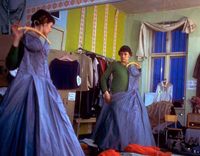
Christine Hill
"[...]Do you perform or role-play with Volksboutique? How do you differentiate one from the other?
It is good that the the word "performative" has entered the general art vocabulary, because it rescues work like mine from being labeled as Performance Art. I am extremely averse to theater, because I don't want to see a simulation of life. I want life. I want things real and in real time. And there is always going to be that unfortunate leap the mind makes when hearing the phrase "performance art" that conjures the stage whisper, or someone setting themself on fire. So I don't consider myself to be performing in the sense that we understand "acting" or staging. But I DO find that the entire thing is about performance, in terms of what in German is the word Leistung. And I do have a certain public persona that is in the work (and probably in my teaching as well). It is a part of my own personality, not something that is assumed, but it is also specific to certain projects that contain an extroverted element. Initially, my labors in the Volksboutique were specifically about pointing directly to the fact that this was an occupation. Something all-consuming, that required a sweat to be broken. And about clarifying that my own person/a was the guide through this set of ideas. This is also a way of addressing accountability and responsibility. Projects of mine require participation of various levels by viewers. How much they can access has in part to do with how they approach me as the representative of any given work. I feel this is a fair exchange, similar to any in a shop transaction..." From Régine Debatty's Interview with Christine Hill, we-make-money-not art.
Posted by jo at 01:48 PM | Comments (0)
Nina Czegledy reports on Media Forum 2007
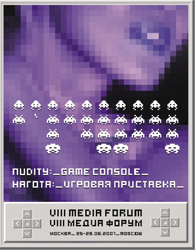
Nudity:_Game Console_
Between June 25-28, Media Forum, Moscow in collaboration with the Moscow International Film Festival, presented Nudity/Game console - a series of events including a Vito Accoinci retrospective, round table discussions and a video art competition. The theme of this year was: Nudity/Game console. The ERA Foundation hosted the Media Forum events in their centrally located, elegantly renovated gallery space.
In this report I would like to focus on the round table discussions - especially as the majority of the presenters happened to be women working with research & practice in digital fields/communities. Instead of lengthy descriptions, links are provided below for further information.
"Cultural cooperation online", the first discussion on June 26th was presented by Angela Plohman, content developer of Labforculture. The organization provides extremely useful tools for those in the arts who wish to collaborate across borders. The constructive, practical value of this information and knowledge platform was very much appreciated by the audience as attested by the numerous questions and comments.
On June 27, Anne Nigten of V2 lectured on "Research and development in the interdisciplinary field from an art perspective" followed by Dmitry Bulatov on "The third modern - denuding the media. The technobiological art work." Last but not least Margarete Jahrman showed us "Pong Dress" and Ludic Society. All of these presentations were very well received with lively Q&A periods.
Next day, June 28, "Super-Embodiment of Woman Artists in Media Arts" was presented by Irina Aristarkhova, Nina Czegledy and Elena Kovylina. Irina noted in her introduction that "Nudity and the Nude - have become key issues in contemporary art, theory and politics. Women artists face what Foucault called 'hysteriarization of female body', while men artists face an issue of 'absent male body' (Kelly Oliver) and respond to it with various strategies. One might argue that both Western and Eastern European women artists have exhibited 'too much body', and to a certain extent find it difficult to leave "body" behind. However, we rarely discuss what impact socialist gender policies and practices have had on this process within aesthetics. If performance art leaves us with legacy of 'too much body' - 'super-embodiment', - one wonders of it morphs into (new) media art as question of 'machine' / 'cyborg' embodiment and its identity."
In the course of our presentations both Irina and myself emphasized that feminism and gender issues can not be separated from the particular history of the region. Lack of clarification of this issue leads to numerous misconceptions and miscommunication. Case histories of media art were presented including "I am a robot" by Boryana Dragoeva Rossa (Bulgaria) and "Reality Resonance" by Erika Katalina Pasztor (Hungary), followed by the outstanding Russian performance artist Elena Kovylina, showing her "Pick a Girl" video performance featured at the Sydney Biennale 2006. The questions and comments at the end of our panel revealed that controversy and strife are still embedded in this discourse.
The schedule left room for us to visit some artists studios, participate in the mega-retrospective by Oleg Kulik and Vinzavod and old factory converted into a mixed use art center and luxury boutiques - where hopefully the Media Art Lab will have its future home. There is so much more including Art4 the private contemporary art museum, Moscow Rolls Royce, the electroboutique, traffic jams, night life etc. etc -worth a visit!
nina [via Spectre]
Posted by jo at 10:37 AM | Comments (0)
July 05, 2007
Interferences
Interferences ... is an interactive installation created by Matteo Sisti Sette and Maribel Pozo which consists of a back projection screen showing an artificial life system which is sensitive to electromagnetic waves emitted by users mobile phones.
In its ‘natural’ state, image and sound are in constant evolution, moving and growing as if alive. Their growth and evolution is altered in the presence of electromagnetic waves.
This work tries to draw attention to a phenomenon whose physical and material relevance we tend to ignore. Little is known about the effect these radiations produce on human body. Maybe they are not dangerous. Many elements of our environment are not, yet they concern us because of their aspect or noise or odour. If we couls [sic] see, or hear the amount of energy which is carried by electromagnetic waves and which passes through our body, would we behave the same way as we do?
The installation is created with Pure Data and Processing. [posted by Garrett Lynch on Network Research]
Posted by jo at 07:19 PM | Comments (0)
July 02, 2007
Spinal Rhythms:
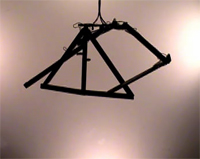
Autonomous Embodied Evolution of a Biomimetic Robot's Rhythmic Motion Behavior
ABSTRACT: "The robotic art work Spinal Rhythms investigates the qualities and dynamics of physical movement performed by inanimate shapes. To avoid mimesis the robot’s body is a primitive abstraction, a connected system of bare wooden limbs linked by joints. The spotlight lies on the action that brings this inorganic shapes to life - the motion. Actuated by elastic shape memory alloy springs the robot performs slow and noiseless movements that differ from robotics’ typical electrical motor characteristics. The movements are the subject of an embodied evolutionary computation process that controls the robotic performance. By repetitive mutation and evaluation the system evolves the actuation signals for the robotic muscles and makes the robot find temporal solutions for the sensitive dynamics between software, hardware and environment. The fault-prone hardware-body of the robot and changing environmental conditions create an unstable fitness landscape that demands continuous adaptation of the activation patterns. The evaluation process uses image analysis to grade the performance of motion patterns according to a fixed set of fitness functions and attempts to find activation patterns that produce more movement while consuming less energy. Trained in an autonomous loop without human supervision the robot is granted a certain awareness of its own body.
The art work presents a solution on how to bridge the gap between digital and robotic artificial life art. It introduces the shaping power of evolutionary systems – widely employed in digital artificial life – into a real-world setup full of complex dynamics and unpredictable conditions. The crucial differences between digital and analog worlds – constituted in the messiness and unpredictability of real life – are emphasized instead of being inhibited. The exhibition setup which shows one machine intelligence training another machine intelligence serves as an allegory on the future superiority of artificial intelligence that will advance without human help." From Spinal Rhythms: Autonomous Embodied Evolution of a Biomimetic Robot's Rhythmic Motion Behavior by EVA SCHINDLING. [PDF] Project website >>.
Posted by jo at 01:49 PM | Comments (0)
July 01, 2007
[iDC] SHOWING
![]()
Presentational rather than Representational
In our cultural landscape of blogs, webcams, profiles, live journals, and videosharing sites, the intimate lives of everyday people are on parade for all to see. One could say that a new culture of erotic exposure and display is on the ascendance, fueled by the impulse to reveal the self, and streamlined by DIY media technologies. In many ways this culture would seem to be less a representational than a presentational one, where we are compelled to solicit the attention of others, act for unseen eyes, and develop new forms of connective intensity -- as if this were somehow the very condition of our continued existence, the marker of our worth.
Within this new culture of self-exposure, one could say that the dream of panoptic power has vanished, or reversed course. Does the drive to willingly display the self constitute a surrender to the controlling gaze, or simply a shift in the dynamic of the game? For within these presentational environments, performance and role-playing reign supreme, and new forms of subjectivity and identity emerge.
These new cultures of self-display challenge us to rethink foundational concepts in film and media theory and, consequently, to rethink the very conditions of our approach. For clearly these cultures are not necessarily those of mastery and visual pleasure. They do not resolve easily to questions of perception, power, and language. They are cultures of showing as much as those of watching. Instead of a reliance on questions of spectatorship, representation, and scopic power, we are challenged to foreground issues of performance, affect, and display.
Instead of a privileging of reception, we are challenged to incorporate authorial intent or originary motivation. For these new media phenomena are not only texts to be read: they are solicitations, conductive excitations, embedded within networks of erotic exchange. There are pleasures and affective stimulations that motivate these new acts of connection, sharing, and erotic display, for all players on the circuits of production and reception, including both displayer and watcher. Their texts must not only be decoded but their circuits traversed, in implicated ways that destabilize any one-way analysis and its deflections of libidinous investment.
There is much to be gained in rethinking the dynamic between voyeurism and exhibitionism, compensating for the under-theorization of the latter. In film theory, concepts of "attraction" have provided useful tools in thinking forms of exhibitionistic address that counter the voyeuristic orientation of film analysis. In contrast to the mechanisms of maintaining a coherent narrative world, transporting the viewer into another time and space, attractions are those phenomena that directly solicit the viewer's attention in the here-and-now. They can take the form of narrative asides, spoken in confidence to the viewer outside of the diegetic space; as spectacles for their own sake; or as shots which exist purely to titillate the viewer, having no function in the furthering of the narrative. They prompt modes of apprehension that rely less on discursive flow than on direct transmissions that arouse or tease the viewer, engaging the immediacy of the bodily sensorium. In this way they are similar to the way that affects can counter meanings.
In the case of new media of self-exposure, sharing, and erotic display, one could suggest that the emblematic "pose" functions as such an attractor. The pose is a form of exhibitionistic spectacle -- direct address, performative display, or bodily stimulus -- that stands in contrast to the narrative or conversational flow of a social world, whether real or imaginary. It bypasses demands for narrative coherency and instead conducts transversal operations at the level of both the semiotic and the sensational, the reflective and the transmissive. It solicits attention while at the same time functions as portal or conduit for a reciprocal flow: a conductive excitation geared to develop a degree of connective intensity.
Since the pose feeds on reciprocality, it can prompt the changing of roles and positions. In this way it can be seen as a catalyst for identity-formations. Especially as witnessed in the database-driven format of the online profile within which the pose is often embedded, identity is performed through the adoption of specific codes (whether gender or otherwise). One is called upon to play roles in order to assume symbolic mandates, to the extent that "impersonation" becomes a core act of self-identification. Yet the pose does not only operate extensively but intensively, and such "impersonations" arise equally through the internalized transmission of affects. Emergent forms of identity arise through flows of affective resonance that are themselves a powerful social and subjectifying force.
Such impersonations and internalizations can be understood to be driven by lack or by abundance. As a performative player, we are driven by a primary lack at the core of the psychic apparatus. It compels us to seek fulfillment through the gaze of the other: the elementary fantasmatic scene of being looked at (validated) by an unseen presence. The imagined gaze observing us becomes a kind of ontological guarantee of our being.
It serves to put us in our place -- to subject us. In this way, erotic cultures of exposure and display can be seen as driven by the need to perform for the gaze -- the Big Other, the symbolic order -- and therefore to write themselves into existence. Yet at the same time, these insertions of the self into the symbolic order can be regarded as a way of channeling or dissipating surplus energy. From such a viewpoint, the connective intensities that drive these new forms of self-exposure and display are those of expending excess, and the allure of showing could parallel that of sacrificing. The pose, as event-portal, becomes a double-edged solicitor.
Jordan Crandall
iDC -- mailing list of the Institute for Distributed Creativity iDC[at]mailman.thing.net http://mailman.thing.net/cgi-bin/mailman/listinfo/idc
List Archive:
http://mailman.thing.net/pipermail/idc/
iDC Photo Stream:
http://www.flickr.com/photos/tags/idcnetwork/
Posted by jo at 12:51 PM | Comments (0)
June 27, 2007
The Present Group presents
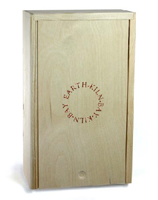
Earth-Kiln-Bay-Kiln-Bay
Land Art Performance meets the digital world. Artist’s work presented online for the public to experience: The Present Group, a quarterly art subscription service, unveiled an interactive online version of Earth-Kiln-Bay-Kiln-Bay today. For his piece (the second edition of The Present Group) artist Presley Martin collected weathered bricks from a beach in Berkeley, CA. To insert himself into the process, Martin glazed and fired these cast-offs before returning them to the beach and arranging them in a simple circular form. As the tide rose and fell, the waves of the San Francisco Bay continued to weather and re-distributed the bricks. With the help of The Present Group and the United States Postal System, the bricks continue their journey around the country, each stage collected and re-presented to the homes of TPG subscribers. Emily Kuenstler sums up the work in her statement,
“I find Martin’s work especially relevant to the times in which we now live. While the seriousness of world events and crises require daily reckoning with meaning, reclaimed objects inherently illicit new meanings, recontextualized. Rethinking where we have been as a society—and how we have gotten here—is crucial; doing so in a pure, considered aesthetic gesture is restorative.”
An interactive, digital version of the work, with video documentation of Martin’s performance, is now available for the public online, along with an interview, critique, annotated links to other resources, and a discussion of the work.
A New Way of Supporting Contemporary Art: Subscription Art
The Present Group’s quarterly subscription model is a new approach to funding artists while expanding the base of art lovers and collectors. TPG aims to de-mystify the art world one piece at a time, by interviewing the artist, commissioning critics to help subscribers contextualize the work, and by providing a free online resource and discussion area built around each piece. Subscribers can learn about and absorb each piece at their own pace, in the comfort of their own homes, without the intimidation factor of a gallery or museum. As Oliver Wise, co-founder of The Present Group, points out, “It’s the most current contemporary art class you can take.”
For more information contact: Oliver Wise – oliver[at]thepresentgroup.com
Posted by jo at 01:43 PM | Comments (0)
TAGallery
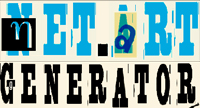
link.of.thought_ thought.of.link
TAGallery by CONT3XT.NET extends the idea of a tagged exhibition and transfers the main tasks of noncommercial exhibition spaces to the discourse of an electronic data-space. The method of tagging allows the attribution of artworks to different thematic fields. EXHIBITION_003 was tagged / curated by Ursula Endlicher and Ela Kagel, who started the blog Curating NetArt in May 2006 as ongoing conversations about various topics surrounding media arts. Their exhibition link.of.thought_thought.of.link for TAGallery is an extension of this blog in dialogue-form and a meta-curatorial statement of their perspective on the challenges of curating media / net / art.
With projects / works by: UBERMORGEN / Alessandro Ludovico / Paolo Cirio, Jo-Anne Green / Helen Thorington (Turbulence), Aleksandra Domanovic / Oliver Laric / Christoph Priglinger / Georg Schnitzer, Cornelia Sollfrank, Eva Grubinger / Thomas Kaulmann, 0100101110101101 (Eva and Franco Mattes), Ruth Catlow / Marc Garrett (Furtherfield), Graffiti Research Lab, Mushon Zer-Aviv / Dan Phiffer.
Exhibition :: Curator's dialogue :: Curator's bio/CV :: Curator's blog [posted on newmediafix]
Posted by jo at 10:59 AM | Comments (0)
June 26, 2007
Metabiosis - Go Forth & *
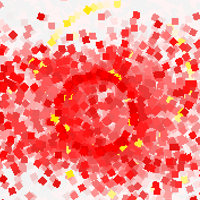
Call for Participation
Metabiosis - Go Forth & * by Aymeric Mansoux and Marloes de Valk :: Medialounge, The Media Centre, 7 Northumberland Street, Huddersfield, HD1 1RL :: Opening: 11 July 7 - 9pm :: Exhibition runs from 12 July until 17 August 2007 :: 10am - 5pm, Monday to Friday.
Create your own data-packet to live on a network of computers. Give your packet a personality! Is it shy? Outgoing? Is it afraid to leave its home or is it more of a traveler? Is your packet screaming for attention or is it more of a loner? Answer the questions and set your packet free. Your packet will soon bump into other packets, and start to interact, maybe even to breed, but its limited lifespan means that one day it must face the inevitable ... packet heaven. Follow your packets ups and downs, its travels and its offspring by following its journeys through the three computer based ecosystems in this installation.
Metabiosis — Dependence of one organism on another for the preparation of an environment in which it can live. Metabiosis is a collection of works about digital life and autonomous creation processes. We are developing, writing, sketching, investigating and working on a series of sub projects, with as a final goal a software that combines all our efforts. Because we are working in a modular way, we cannot predict the eventual results, but at the moment we’re working on creating small ecosystems on a network of computers. In these ecosystems you’ll be able to seed little packets of data. The packets are in reality only a set of numbers, but they do have some special features. The packets can jump to other computers with ecosystems, they can reproduce and they can die. This system of networked ecosystems, inhabited by self replicating data packets, is an experiment and a game for those who are curious about the possibility of digital life in the ever growing ecosystem of connected computers.
This website contains articles about different aspects of Metabiosis: the code, texts with thoughts, ideas and research, input that gives us new ideas, and information about events such as exhibitions or performances.
Posted by jo at 10:02 AM | Comments (0)
June 25, 2007
The G-7 Stock Puppets
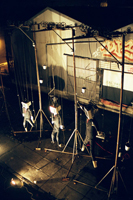
An Internet-driven "Commodities" Trading Environment
The G-7 Stock Puppets are an Internet-driven kinetic installation that tracks the movements of global stock markets with seven larger-than-life marionette puppets. Using a real-time data stream, a network of PC laptops, and a complex electro-mechanical control system, the installation reanimates the abstract machinations of global financial markets as an absurdist carnival puppet show.
Unfortunately, the script for this puppet show remains a bit hazy. One moment, we might find the NASDAQ puppet soaring 20 feet into the air, consumed with the latest IPO elation. The next moment, without apparent reason or warning, the Nikkei puppet might fall to the ground, crumpling into a fetal posture of weakness and desperation. From the opening to the closing bell, the puppets continue to rise and fall in serendipitous synchronicity with the "arbitrary" movements of the G-7 market indices. Clearly, in this puppet show, the markets themselves are the "puppet masters". But we may ask ourselves, "Who are the puppets?"
Physical Particulars: The puppets are made from 8 foot tall fiberglass mannequins, dressed in gray-pinstriped double-breasted suits, accessorized with standard-issue red power ties. Large VGA monitors for heads stream stock ticker symbols and index numbers for the individual markets. Each puppet movement cues a face animation of the appropriate finance minister on the monitor head- the face morphing and contorting in relation to the direction of market movement. The puppets are elevated and articulated by cables extending down from pulleys supported 25' overheard on seven individual puppet towers. Surrounding this mechanized market ballet is an ambient soundscape of shouted buy and sell orders, bells and gavels, racing heartbeats and terrified curses.
Performance: In the middle of the semi-circle arc of puppet towers is a "Blackjack style" trading table, staffed by a tuxedo-clad dealer. The dealer keeps up a steady banter of market analysis, beckoning the brave to come forward and speculate on the index of their choice. Feeling bullish on Germany? Step up and place your "bet" on the Germany circle. No money please, just the random ephemera you happen to have with you- keys to unknown locks, photos of ex-lovers, business cards from clients you'd rather forget, or whatver else you might find in your pockets, purse or backpack. If the corresponding puppet goes up, choose your prize from the pile of profit in the trading pit. If the puppet goes down, you lose your "bet" and build the pile of profit for the next day trader.
Token Theoretical Elaboration: The Puppet installation is a gentle commentary on our society's near pathological infatuation with global stock markets in this era of the "new economy". At the same time, it is also a serious experiment to map the complex information stream of financial data onto dynamic objects in the physical world. Our intention is to re-embody this information ecology in a manner that reveals some of the character and patterning encoded in the fragments of the data stream. And during the process, we hope to also laugh a bit at the arbitrary control this data stream holds over many of our emotional lives and reckonings of self-worth. [Via Pasta and Vinegar]
Posted by jo at 02:01 PM | Comments (0)
June 22, 2007
Canal Street Station

Participatory Public Pay Phone Who-Dunnit
31 Down's interactive telephone mystery Canal Street Station runs through October 31, 2007. To play, call this toll-free number from a pay phone inside the station: 1-877-OR-WHAT-31 (1-877-679-4283). Note: This mystery takes place on the N, Q, R, W, 6, and J, M, Z platforms, not the A, C, E, station.
Canal Street Station is a free public media art installation set in the Canal Street Subway Station in New York City. Participants are invited to make a toll-free call from any public payphone in the Canal Street station (inside of the turnstyles). Participants will then be guided on a pay phone mystery. The game takes approximately 45 minutes to complete.
Tajna Tanovic stars in this public pay phone who-dunnit set in the maze of tiles that make up the Canal Street Subway Station. This is an interactive piece that challenges participants to test their skills at listening and following directions. Players are put in the shoes of Mike Sharpie, private investigator, as he searches the depths of Canal Street Station for a young French woman that may have committed a murder, or may be a figment of Mike's wandering imagination.
"Canal Street Station" is co-produced by 31 Down radio theater and free103point9 and presented by free103point9 as part of the transmission arts non-profit's Tenth Anniversary celebration. Created by: Ryan Holsopple, Shannon Sindelar, Mirit Tal, and Tanja Tanovic.
Posted by newradio at 10:44 AM | Comments (0)
June 18, 2007
The Art Happens Here: The Full Exhibition Review by Paddy Johnson
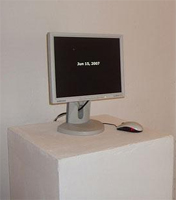
@ iCommons iSummit 2007
[...] Individual works are of varied success, largely reflecting the portability of the artist’s practice. In that respect probably the most successful work in the show, came from the New York art collective MTAA whose net art piece On Kawara Update displayed beautifully on an “antique” computer screen dating to (I’m guessing) the early 90’s. Unlike some many art titles that leave viewers befuddled, this work tells you exactly what the piece does. Drawing upon the canonical On Kawara’s “Today Series”, an ongoing project whereby the artist creates Spartan black canvases with only the date, and a separate collection of news clippings from the day, MTAA’s update recreates that same canvas for the web as a splash page displaying only the date which is also a link to a program that pulls news stories from that day with Creative Commons licenses [editors note: apparently most newsfeeds are CC licensed so MTAA decided it wasn’t worth the effort to make a specific filter]. Now, to be honest, I’ve always had problems buying into the original series MTAA draw inspiration from, namely because the artist spent a life time doing the project without apparently getting bored of it. For me, this piece immeasurably improves the latter not only because the filter [if it existed] adds a layer of specificity to the work, but by automating the repetitive aspect of the work, thereby eliminating criticisms lodged against artists who remake the same piece through out their lifetime...." Read the full review at iCommons iSummit 2007.
Posted by jo at 05:55 PM | Comments (0)
June 14, 2007
SMS2Wall + Mobile Whispers
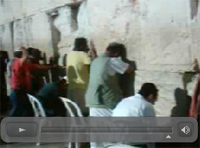
Your Prayers Delivered to the Western Wall
SMS2Wall is a result of an effort to enable people all around the world to communicate their intimate messages to the Western Wall, directly from their mobile phones. Whatever the wish, prayer, hope or thought you would like to address to Western Wall, all you have to do is to compose text message (SMS) with the text: WALL (space) your message and send it to 46898. We will print out your message and (without revealing the message or your personal data) place it as a note into the Western Wall in your behalf.
Every week we will publish a video of the notes being placed in the Wall, so you can verify that your message has indeed reached its destination. You are welcome to use this service whenever you feel the need to express your inner self and reach to Western Wall. It is our imperative to treat you and your intimate message in a decent and professional way, emphasizing the attention and respect for privacy and prompt service.
Mobile Whispers is a global platform with the goal of aiding people all over the world in their spiritual and emotional needs, regardless of race, nationality or religion. We utilise the latest (mobile) technology in closing the distances in time and place and enabling communication between people and their intimate destinations, ensuring the highest sense of responsibility and respect to people's privacy and their inner values. Together with our network of worldwide mobile and internet connections combined with our proven technology and operated by experienced and knowledgeable team, we are able to deal with each request promptly and in the highly professional manner. Our vision is to bring closer people and places. We are working intensely to develop new and meaningful services each time.
Posted by jo at 07:21 PM | Comments (0)
June 13, 2007
Rosemarie Fiore
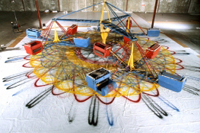
Scrambler & Firework Drawings
Rosemarie Fiore utilises common appliances and machinery, including amusement part rides, to facilitate her mark making explorations. The Good-Time Mix Machine: Scrambler Drawings appear as gigantic mandalic spirograph patterns (technically Hypocycloids), incredibly up to 60×60ft in size!
‘I connected a gas generator and air compressor to buckets of paint and secured them into the seats of a Scrambler amusement park ride. Once the ride was in motion, paint sprayed out of the benches onto vinyl tarps placed underneath. The result is a series of enormous hypocycloid designs which recorded the hidden patterns created by the ride as it turned’
Continuing a process based path her firework drawings appear as Rayogrammic chromatography experiments with subtle overlapping colour arrangements. This time she uses the after burn of live fireworks’ exploding to create saturated abstract compositions! Who could resist ‘lit fireworks on paper, collage’ as a media description?
More on the Hypocycloids & other Spirographic drawing machines
More Drawings of Harmonic Motion [blogged on dataisnature]
Posted by jo at 07:29 PM | Comments (0)
June 12, 2007
Torrent Raiders
Aaron Meyers put together a short promo music video-ish thing for Torrent Raiders! Music by Cursor Miner.
Torrent Raiders is a dynamic network visualization realized through the idioms and aesthetics of arcade-style video games. Driven in real-time by the activity of bit torrent swarms, Torrent Raiders takes place on the ad-hoc networks created by bit torrent users. Torrent Raiders playfully addresses issues of domestic surveillance and intellectual property by putting players in the role of a mercenary copyright enforcer, encouraging them to capture evidence against peers on torrents in order to collect bounties. Players assist in the distributed surveillance of these torrent swarms, sending information to a central server where it will be used to drive further visualizations of this information. As a dynamic visualization exploring privacy, piracy and surveillance, Torrent Raiders challenges Internet users, content pirates and government spooks to examine their allegiances and mistrust their computer connections.
Posted by jo at 06:59 PM | Comments (0)
Erkki Huhtamo:
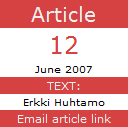
On Art, Interactivity and Tactility
"I have secretly caressed paintings in museums, shaken hands with statues..." This line from asong called "The Tourist" recently caught my attention. Is this an expression of projected affection? The confession of a madman? An account of innocent touristic pranks familiar fromtravel snapshots? Or is it a deliberate subversion of received codes of behavior with - perhaps - ideological implications? As it turns out, the protagonist of "The Tourist" is a loner, "a man lost inhis hometown." Touching paintings and sculptures is a compensation for the lack of a human touch that he has been searching for "in wrong places." Touching the untouchable, crossing theline, avoiding the public eye. Our experiences in public spaces often include the temptation to 'exceed the limits,' at least for a passing moment. Such actions often involve the hand. I have met'normal' people - including artists - who occasionally practice shoplifting. Not for profit or the need for anything - the stolen object is something insignificant, like a piece of gum. For suchpeople the act of shoplifting is more like a sleight-of-hand that challenges the limits of the permissible. It is also a test of one's agility and "guts," bringing to mind the lonely endeavors ofRobert Bresson's Pickpocket (1959). More determined challenges are the "para-legal" arts of street graphics and graffiti that often spring from alienation. They represent the need to "makeone's mark" and to assert one's presence while remaining anonymous, a shadow figure. Posting notes or spraying tags is linked with tearing down, covering, replacing. These acts are part of anunfinished/able urban semioclasm, a palimpsest taking place anywhere where bills are posted and bare walls - potential surfaces to be filled - are available." From On Art, Interactivity and Tactility by Erkki Huhtamo, NeMe.
Posted by jo at 05:53 PM | Comments (0)
June 07, 2007
Interview with Susana Mendes Silva
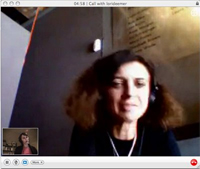
Explorations of 'Constraint'
Interview with Susana Mendes Silva by Miguel Amado; Commissioned by Rhizome.org :: Lisbon-based Susana Mendes Silva is a pioneering artist in the Portuguese new media art scene. Although her practice reaches beyond the conventional genres of this field, her technologically mediated performances, in which she explores the emotional states underlying personal relationships in general and intimacy in particular, granted her a deserved recognition both locally and abroad. She is about to relocate to London, where she will do a studio-based PhD at Goldsmiths College and, recently, she presented the latest installment of her important work ‘art_room’ in the US at Upgrade! International in Oklahoma City. This led Rhizome Curatorial Fellow Miguel Amado to interview her about her practice.
MA: Tell me about your background.
SMS: I have studied Visual Arts in Lisbon’s University and have been showing my work since 1996, being part of what one defines as the generation of Portuguese artists of the mid- to late-1990s.
Recently, I have had a solo show, called ‘Did I hurt you?,’ in the Zoom program (dedicated to cutting edge projects) at Lisbon’s Carlos Carvalho Gallery, and a site-specific installation was commissioned for the group show ‘(Re)Volver’ at Lisbon’s independent space Plataforma Revolver. My practice, however, is not only studio-based, as I participate in several projects that take the form of discussions or talks. For example, I was a participating guest in the ‘Bare Life’ conversation, moderated by Christina McPhee, that took place during July 2006 at Empyre - http://www.subtle.net/empyre - in a collaboration with Documenta 12 Magazine.
MA: What are your interests as an artist?
SMS: My practice addresses the human condition in general and allegorically explores constraint in particular. Constraint can be related to a physical or a psychological condition as well as to an ethical positioning and socio-cultural conditioning. There are also related concepts playing an important role in my work: limit - in its physical and psychological meanings; impossibility - as an imposed boundary (by the self or by others); violence - as a visible or invisible exercise of force; affection - in the sense of a human feeling and of disease, either of the mind or the body; and desire - as a powerful human drive. I am very interested in subverting concepts, rules, and prevailing points of view. I am therefore committed to a critical vision about art and of the world.
MA: You operate in different media, some that one defines as ‘traditional’ (drawing, photography), and other that one calls ‘new’ (video, Internet)...
SMS: I am not very concerned if the media that I employ is seen as old or new, but whether their properties are suitable for my work. I understand media as tool, as something that can be used according to the project that I am developing in a given moment. I use media very freely, and frequently in a grouping manner – for example, in installations and performances. If one considers Lev Manovich’s definitions of cyberculture and new media, some of my works would belong to the first category, some to the second, and others to both.
MA: How do you approach these different media?
SMS: For me, it is fundamental to use media in an experimental way, and to explore specificity, whether site-specificity, media-specificity, or context-specificity. This is a strategy that encompasses and is an attempt to overcome the dichotomy of constraint-freedom that exists in artistic practice. My work is associated with some kind of discovery, mapping, or combinatory method. This is quite present in the way I function and brings together the dimensions of each project.
MA: Can you discuss one of your most well known projects, ‘Artphone’ (2002)?
SMS: In 2002, I applied to be a participating artist of ‘Free Manifesta.’ This was a project by the New York artist Sal Randolph, that was part of Manifesta 4 held in Frankfurt am Main, Germany. A place in Manifesta 4 was purchased by Sal, for $15,099, in an ebay auction. Any artist who wished was invited to show their work, and over 225 artists and groups participated in public art projects which took place across the city as well as through the broadcast airwaves, telephone and mail systems, and on the Internet. I did a performance, via mobile phone, called ‘Artphone.’ There was a flyer and an online page with my personal mobile phone number and the sentence: ‘Don’t be afraid to ask everything you always wanted to know about contemporary art.’ I received the calls and established a completely spontaneous and improvised conversation (about a contemporary art issue) either with someone I knew or with someone I had never met before.
MA: This work led to ‘art_room’ (2005), right?
SMS: Yes, as a development of ‘Artphone,’ I created ‘art_room.’ I used a webcam in a webchat site called webcamnow. In this site there was only the possibility to exchange text messages as the software available did not support voice messaging. The performance occurred during a pre-set schedule, during June. When I started the performance, on the first day, I went to Room One to announce what I was doing by simply posting the sentence: ‘Don’t be afraid to ask everything you always wanted to know about contemporary art.’ I moved to a free room (from 30 rooms, only three had people in them), and I began to chat with some of the people. I soon realized that some of the users felt like they ‘own’ the website (no matter what room I moved into), and they began to become very aggressive towards me. If ones looks at the performance’s documentation, one will only see my eyes, as I was hiding behind my laptop, because some of the users kept saying that I was showing off too much (even though I was properly dressed). In order to avoid the disturbance, I ended up ‘veiled’ by my computer.
MA: The interaction with the user, in ‘art_room,’ was different from that of ‘Artphone’?
SMS: This time the result was totally the opposite from what I expected. Even though there were a couple of interesting chats, the experience of a certain degree of intimacy and significant questions was this time replaced by aggressivity and exclusion from most of the usual members. For example, in the second day I was expelled from the ‘family and friends’ area: my camera was shut down, and I was disconnected as a user by the moderator in an arbitrary way.
MA: Nevertheless, there was another installment of ‘Artphone’ later that year.
SMS: During ‘Prog:me’ in Rio de Janeiro, Brazil I did ‘Artphone’ again yet using Skype this time (still with no image). One of the interesting things was that visitors could talk to me from the exhibition space. This went quite well and it was not very difficult to overcome some shyness or awkwardness. I spoke with people from all ages and from different backgrounds, including some artists and curators. Several visitors saw the show more than once and spoke with me on different occasions. Every time I talked with a person it was a very intimate experience.
Carlos Sansolo (one of the curators of ‘Prog:me’) expressed this ambivalent feeling - of pleasure and fear - very accurately: ‘The Portuguese artist Susana Mendes Silva proposed the ‘Artphone.’ The idea is quite simple: she provides her address so we can talk to her through a microphone and headphones from the computer about contemporary art, using the computer as a telephone. I have talked many times with Susana, never about art, always about technical issues and always presenting one other artist that appeared while talking to her. Actually talking to an unknown person on the phone gives you a certain degree of intimacy that I always felt terrified about. As a matter of fact, I have always felt a certain compulsion to confessing things to this unknown voice. My first thought is always about the history of sexuality of Michel Foucault, about this fear of confessing in intimate moments. She says: ‘Have no fear, ask me what you’ve always wanted to know about contemporary art’ - and all I felt was fear. The simple presence of a voice that talks about contemporary art has the ability to inspire disturbing or great situations for whoever contacts it. One may think it is a reflection on intimacy on the Internet. The work is not only a proposition, but the result of this chat that can never be completely predictable.’
MA: When was the performance done for the last time?
SMS: The last time was at the Upgrade! International in Oklahoma City - as part of the Upgrade! Lisbon’s presentation - and I used Skype with voice and video on both locations. However, a year ago, I tried to do ‘art_room’ in a very different way. I was participating in the exhibition ‘Between word and image,’ at Fundacion Luis Seoane in A Coruna, Spain and, on the opening program, there were some performances. I distributed A4 posters in the museum building announcing that people could meet me in the patio next to the auditorium. I had a table with two chairs (one for me and other for the participant) and I received the visitors that wished to talk with me for two hours. It was very interesting to interact in physical presence, and some of the people started to call it the ‘confessionary’.
MA: Do you plan to reenact this version of the work?
SMS: I always try to do both the ‘Artphone’ and the ‘art_room’ with different components, and this version was an attempt to explore new features for the work, but repeating this performance will depend on the context of its presentation.
MA: What do you think about the passage of the piece from a technologically-mediated context to a face-to-face situation?
SMS: It might sound strange but the situations are not very different. I guess that, on face-to-face, I was a bit nervous because I was not sure if someone would participate. Also, it was more awkward when I was wondering who would be the next person to approach me, perhaps because there was no device separating us.
MA: What are you working on now?
SMS: I am working on my studio and doing research for some projects that will happen later this year. One of them is a group show that will take place within a Lisbon psychiatric hospital, and I am sure that the audience’s reaction will be very different from that of a conventional exhibition space. Next September I will start a studio-based research program at Goldsmiths College in London. I’m very excited with the prospects of this experience, as I will be living and working abroad for the first time and I am sure that this will initiate new directions in my practice.
Posted by jo at 11:04 AM | Comments (0)
June 06, 2007
Blogged
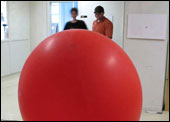
the bubble inflated by blog traffic
Is 'blog' the new 'bubble', ready to blow out? According to the metaphor used in Blogged, an interactive installation by Bill Shackelford the answer is: yes. This piece of 'web 2.0 art' consists of red balloon (a bit less than 2 meters large) blown up using traffic generated by linking blogs during a specific day. Like in a flash mob, Shackelford uses the efficiency of communicating information on the net, exploiting online communities to spread the word and so determining the event success.
The installation was opened on Thursday May 31, 2007, live from the Ohio State University Art and Technology show 'Digescape'. During this 24 hours event Shackelford submitted his link for consideration to a number of blogs, hoping that they would have blogged it including a link back to the Blogged home page. Each visit logged in a MYSQL database, counted one second of compressor-generated air inflation into the balloon. Visitors joined and monitored the balloon status through a live video feed. Schakelford explains that he's concerned to understand the way things actually are, to determine what is valid and important: "The questions that I find most interesting deal with our place in the natural world and how it has changed over time with technology, invention and human ingenuity". 'Blogged' shows clearly how quickly artwork spread from blog to blog and, simultaneously, how fast the artwork is forgotten the day after. It's instantaneous joy what the ranking causes. And however blog is where the debate on net art goes on." - Valentina Culatti, Neural.
Posted by jo at 10:39 AM | Comments (0)
June 04, 2007
network by mark dixon
http://www.markdixon.me.uk/network.htm
Posted by jo at 01:17 PM | Comments (0)
June 01, 2007
UAPD NYC Action: Sign Event
Urban Attractors Private Distractors (UAPD) is a collaborations between Angie Eng, Vietnamese artist, Rich Streitmatter-Tran and a collective of student interns in New York and Ho Chi Minh City. The two groups conduct actions in public centres highlighting private behavior in public space and the invisible boundaries/filters prompted by mobile technologies and urban invasions of one's public space. The next action is 06.09 @ 1pm: 'Street Eat'. All actions meet @ eyebeam.
Posted by jo at 06:15 PM | Comments (0)
May 29, 2007
Valerie Bugmann
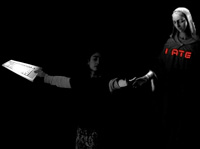
Secret Under My Skin
Secret Under My Skin, by Valerie Bugmann, is a performance that allows us to reflect on our natural necessity/desire to express our emotions, to share our innermost thoughts and to see them extended in the world.
The performance takes place in the room of secrets where a skin-to-skin communication network* is employed. Here, the performer and the space await the opportunity to become alive through the interaction with the participant who comes to intimately confess/convey a secret by touch. A lighted keyboard floating in the darkness invites the participant to type a secret into its glowing keys. Once typed out, by simply touching the keyboard the secret is reintroduced into the participant’s body in the form of its new physicality – an electric wave. The secret, now flowing from the keyboard into the participant’s body is ready to be further transmitted/confessed to the performer by touch.
Once skin-to-skin contact is established with the performer, the participant will be able to see his/her secret revealed on a wearable display on the performer’s body; the participant is then confronted with a very intimate part of him/herself. Despite the secret being displayed on the performer, it remains unread by anyone expect the participant, or has the performer – this almost inert object of inscription, desire and redemption - actually become aware of the secret through the transmission?
Skin-to-skin communication, as a suitable technology to express intimate thoughts, generates an intense effect as we recognize ourselves as part of the other through touch. Secret under my skin brings together different notions and implications of touch in this confession-like context, exploring new behaviors and novel parameters of social interaction that can develop out of this contact.
*a network in which touch permits the transmission of information from one person to the other using the physical conductive characteristics of the body. More >>. Also see Digital Communication with a Human Touch [In-gesture].
Valerie Bugmann finalized her studies in Art and New Media at the University of Los Andes in Bogota in the year of 2002. From 2002 till 2005 she realized a Master in Art and Technology in Goeteborg, Sweden. Since then she has concentrated in the application and analysis of new technologies of communication in her artwork. She is interested in the impact these have in the way we relate to ourselves and to the world. through performative and interactive art she has invited the spectators and participants to take part in a communication structure in which each person has a decisive role. She is currently doing her doctoral studies for a University of Plymouth PhD at the Planetary Collegium's Z-Node, based in the HGKZ (School of Art and Design in Zurich), Switzerland. Keywords: wearable computing, cognition, theater, interaction design.
Posted by jo at 05:58 PM | Comments (0)
May 24, 2007
Lisboa 20 Arte Contemporanea: LX 2.0 Project
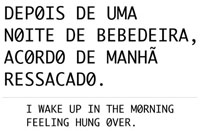
Young-Hae Chang Heavy Industries
Lisboa 20 Arte Contemporanea launches next Thursday, May 24, LX 2.0 Project's new commission: Manhã dos Mongolóides (Morning of the Mongoloids) by Young-Hae Chang Heavy Industries.
For LX 2.0, Young-Hae Chang Heavy Industries created the Portuguese version of Morning of the Mongoloids, the laughable, yet tragic (and extremely ironic) story of a white men that wakes up after a night of “drunken partying” to find himself no longer who he used to be. Without any motive or underlying logic, the man wakes up and gradually realizes he is Korean. He looks Korean, he speaks Korean and he lives in Seoul, when just the night before he was a white man living in a western country. The piece is a delightful insight on the prejudiced views towards Asian cultures and specially, Korean culture. Not only are we faced with the main character’s stereotypes of Asian people, as he gradually comes to terms with the improbable change, we, westerners, are confronted with our own biased views of the rest of the world. It is us, not “china men” who are being ironically portrayed. It is a mirror-like device and it is returning us our own prejudiced image of ourselves.
Posted by jo at 09:28 AM | Comments (0)
May 22, 2007
Synthetic Performances
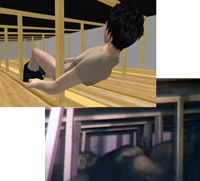
Second Life Re-enactments
While virtual environments like Second Life offer artists a new platform for the creation of original works, it's always interesting to see the past being reinterpreted. I'm pretty sure it was Marshall McLuhan who said all new media consumes its predecessor's content before settling on a new form, and we have witnessed his observations unfolding with the Radio > Television > YouTube evolution.
Eva and Franco Mattes (of 0100101110101101 fame) have taken this ethos of appropriation to heart in their ongoing Synthetic Performances. Seminal performance works from the 1960’s–80’s have been re-staged in Second Life and exhibited in-world and on their web site. Re-performances to date include Joseph Beuys' 7000 Oaks, Valie Export's Tapp und Tastkino, Vito Acconci's Seedbed (he was a bad boy) and Chris Burden's Shoot.
More images after the jump, or you can skip right to their site. If you have an SL account, click here to visit the 7000 Oaks performance in Second Life. More images >> [Posted by christo on selectparks]
Posted by jo at 05:28 PM | Comments (0)
Machine Therapy by Kelly Dobson
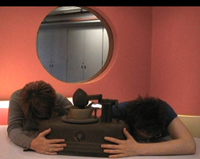
Human-Machine Resonance
Machine Therapy by Kelly Dobson (2002-present): I began singing with large machines in public spaces, discovering that I could come to be in resonance with the sounds of their motors. The motor sound was experienced then as inseparable from my own voice, as like when singing in resonance with another person. I experienced a connection with these machines as if body extensions. Sometimes I felt that I was controlling the motors of these giagantic machines with my voice; sometimes I felt that they were pulling me along. They brought me through expressions physical and vocal that I would have found no other way. This experimental balancing act and communication with the machines facilitated personal exploration, discovery, and development.
I am working to bring this form of experience directly to other people. I host Machine Therapy sessions with machines I have made or found. Small-size movie (5.4MB QuickTime). Related: Blendie.
Thesis Abstract: In this thesis I describe a new body of work called Machine Therapy, a methodology for revealing the vital relevance of subconscious elements of human-machine interactions that works within art, design, psychodynamics, and engineering. This practice highlights what machines actually do and mean, in contrast to what their designers consciously intended. Machine Therapy is a cyclical process that alternates between discussion of and sessions for empathic relationships with domestic appliances, personal extension and connection via wearable and prosthetic apparatuses, and the design of evocative visceral robots that interact with people's understandings of themselves and each other. Combining research and practice in digital signal processing and machine learning, mechanical engineering, and textile sensor design, I have been able to create new objects and relationships that are unique in some aspects while maintaining quotidian familiarity in other aspects. This is illustrated through the documented construction of several projects including re-appropriated domestic devices, wearable apparatuses, and machines that act in relation with users’ autonomic signals. These Machine Therapy devices are evaluated in studies of participants' interactive engagements with the machines as well as participants' affective responses to the machines. The Machine Therapy projects facilitate unusual explorations of the parapraxis of machine design and use: these usually unconscious elements of our interactions with machines critically affect our sense of self, agency in the social and political world, and shared emotional, cultural, and perceptual development. [via architectradure]
Posted by jo at 03:06 PM | Comments (0)
May 21, 2007
Rafael Lozano-Hemmer at La Biennale di Venezia
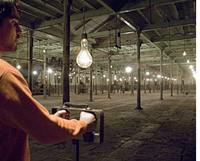
Pulse Room
Pulse Room, one hundred incandescent light bulbs controlled by the heartbeat of the public :: Mexican Pavilion at the 52nd International Art Exhibition – La Biennale di Venezia :: Press Preview: 7-9 June, 10 AM-8 PM :: Receptions: 7, 8 and 9 June, 8-10 PM :: Exhibition: 10 June–21 November, 2007 :: Palazzo Van Axel, beside the Chiesa dei Miracoli, Cannaregio 6099, Venice 30121 Italy :: +39-041-520-4807 .
Rafael Lozano-Hemmer represents Mexico at the 52nd Biennale di Venezia with the exhibition “Some Things Happen More Often Than All of the Time”, curated by Príamo Lozada and Bárbara Perea, a show which will mark Mexico’s first official participation in the Biennale. The exhibition will consist of 6 large-scale installations covering 1,000 square metres of the Palazzo Van Axel, a 15th-century gothic landmark bordering the Chiesa Santa Maria dei Miracoli, in the vicinity of the Rialto bridge.
Lozano-Hemmer (Mexico City, 1967) develops large-scale interactive installations combining the languages of architecture and performance art. His work uses technologies such as robotics, surveillance and telematic networks to create platforms for audience participation, creating "anti-monuments for alien agency". His large-scale light and shadow installations are inspired by animatronics, carnivals and phantasmagoria, situating the spectator as a fundamental component to “complete” the work.
“His work succeeds in giving the unchoreographed the power of a full orchestra..."-- CK Kuebel, NY Arts Magazine
Lozano-Hemmer’s work in kinetic sculpture, installation, video and photography has been shown in over thirty countries, including the Biennials of Sydney (Australia), Shanghai (China), Liverpool (United Kingdom), Istanbul (Turkey) and Havana (Cuba). His work is part of important private and public art collections such as those of the Museum of Modern Art in New York, La Colección Jumex in Mexico City, Fundación Cisneros Fontanals in Miami, the Daros Latin America Collection in Zürich and the Tate Collection in London.
The official participation of Mexico in Venice is the result of joint efforts by Secretaría de Relaciones Exteriores, Consejo Nacional para la Cultura y las Artes, Instituto Nacional de Bellas Artes, Consejo de Promoción Turística and the generous support of the Fundación/Colección Jumex and the Fundación BBVA Bancomer. The non-profit Patronato de Arte Contemporáneo, which has also contributed funding and resources, is in charge of the administration of the project. The receptions, starring DJ sets by Sonido Changorama, will feature sponsored drinks by Jumex, Tequila Cuervo and Cerveza Sol.
A bilingual catalogue will be published by Turner Libros, featuring essays by Manuel de Landa, José Luis Barrios, Barbara London, Cuauhtémoc Medina, Victor Stoichita and curators Príamo Lozada and Bárbara Perea.
Coinciding with the 52nd Biennale di Venezia, Lozano-Hemmer’s work will also be exhibited at Art Basel Unlimited, at the Luminato Festival in Toronto and in the exhibition “Automatic Update” at the Museum of Modern Art in New York.
Contact information:
Consejo Nacional para la Cultura y las Artes:
Plácido Pérez Cué, Director General de Comunicación Social
Tel. +52 555 662 1907
Fax +52 555 662 4314
pperzcue[at]correo.conaculta.gob.mx
Contact for Rafael Lozano-Hemmer:
Natalie Bouchard
Tel +1 514 597 0917
Fax +1 514 597 2092
natalie[at]antimodular.com
http://www.lozano-hemmer.com/
Contact for the curators:
Proyectos Hélix
Príamo Lozada and Bárbara Perea
+ 39 340 755 9584 in Venice
+ 52 555 207 6411 in Mexico
helix.curatorial[at]gmail.com
Rafael Lozano-Hemmer is represented by Galería OMR (Mexico City), bitforms gallery (New York) and Galerie Guy Bärtschi (Geneva).
Posted by jo at 03:28 PM | Comments (0)
070707 UpStage Festival

Performances Announced
Shadow puppets, flights of fancy, air guitar and a visit to a London building site will be some of the virtual attractions at 070707 UpStage Festival - a feast of online performances on July 7, 2007 to celebrate the release of UpStage 2.
New Zealand and international artists are creating work specifically for the UpStage environment, which will be performed for an online audiences and simultaneously screened at the New Zealand Film Archive in Wellington.
UpStage is software that allows audiences from anywhere in the world to participate in live online performances, created in real time by remote players. Audiences need only an internet connection and web browser and can interact through a text chat tool while the players use images to create visual scenes, and operate "avatars" - graphical characters that speak aloud and move.
The diversity of proposals for the festival has impressed the organisers. "It's exciting to see UpStage being used in such a variety of ways," said UpStage project manager Helen Varley Jamieson. "We have all manner of artists - writers, musicians, dancers, performers, videographers, story-tellers - experimenting with how they can use the internet as a creative medium and a site for their work."
The full list of performances and artists is on the UpStage web site. Performance times will be publicised on the UpStage and New Zealand Film Archive web sites soon, and live links to the stages will be accessible from the UpStage web site on July 7; online audiences just need to click!
The performances will be screened live in the the New Zealand Film Archive mediagallery where visitors can buy a coffee, take a seat and watch the performances taking place from remote locations around the world. Exhibitions Manager Mark Williams says "It will be like watching a live movie, as the shows unfold in front our eyes."
UpStage workshop facilitator Vicki Smith has been providing graphic, technical and tutorial support for artists and education groups who are creating performances, and says that the level and range of work being produced promises breathtaking cyberformances (online performances) for audiences to view and take part in.
UpStage 2 is funded by the Community Partnership Fund of the NZ Government's Digital Strategy, with the support of partners CityLink, MediaLab and Auckland University of Technology, and developed by programmer and digital artist Douglas Bagnall.
The launch takes place on 28 June and will be accompanied by an exhibition at the NZ Film Archive from 28 June to 15 July, and the festival on 7 July.
For further information and images, contact:
Helen Varley Jamieson: helen[at]upstage.org.nz
Vicki Smith: vicki[at]upstage.org.nz http://upstage.org.nz/blog/
Posted by jo at 02:57 PM | Comments (0)
1001 nights cast
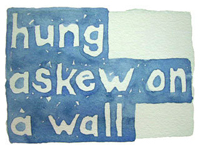
# 700 Tonight!
1001 nights cast Performance # 700 will be on May 21 at 9:30pm from Madrid.
That is: 8:30pm in London and Lisbon; 3:30pm in New York, Montreal and Bogota; 12:30pm in Los Angeles; 10:30pm in Beirut, Jerusalem, Istanbul; May 22, 3:30am in Hong Kong and Perth; May 22, 6:30am in Sydney; May 22, 7.30am in Auckland.
Since the 600 milestone in February, these new contributors have joined the team: Sheila Ghelani (London), Derville Quigley (Dublin), Maria Miranda (Sydney), Norie Newmark (Sydney), Ruth Watson (Auckland), Christopher de Bono (New York), Arnold Zable (Melbourne), Jordan Peimer (Los Angeles), Peter S. Petralia (London), Catherine Lord (Los Angeles), Adrian Heathfield (London), Sara Jane Bailes (Bristol), Karen Christopher (Chicago), Rinne Groff (New York) and Rebecca Schneider (New York). Many many thanks to these and all the other contributing writers.
Posted by jo at 09:42 AM | Comments (0)
Anne-Sarah Le Meur
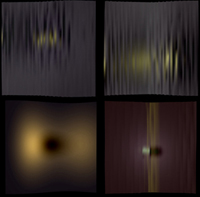
# Eureka + Eye-Ocean
Anne-Sarah Le Meur will present at Eureka: The Moment of Invention, a dialogue between art and science, May 31, 2007.
Eye-Ocean--experimental real time 3D--is on line for 5 days. It is a mono-screen version of an immersive and interactive 3D artwork, Into the Hollow of Darkness, based on exploration and contemplation of non realistic light phenomena in computer generated image. The images are abstract but organic, metaphors of a world both cellular and cosmic, very carnal, so minimal that they become archaïc, a sort of pre-semantic vision (before language). Eye-Ocean is part of the Abbaye de Maubuisson at Contemporary art center in Val-d’Oise during Nuit Blanche on the October 6, 2007.
Posted by jo at 08:21 AM | Comments (0)
May 11, 2007
Oracle by Justin Bennett
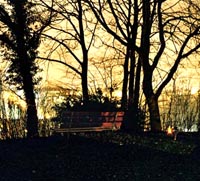
Available for Consultation Now
Oracle: A project by Justin Bennett for the City of Luxembourg: The Oracle, situated in a park on the rue de Trèves, is available for consulation from 28th April until 2nd December, 2007. A park bench by a clump of trees provides the perfect place to rest, to enjoy the view over the city, and to consult the oracle.
The Oracle predicts the future, of course, but it also comes up with wise statements, comments about the visible environment, personal advice, riddles, instructions for performative actions, political observations, and inspiration for all visitors. It attempts to answer all questions, especially those that the visitor didn’t ask. It is truly a 21st century oracle, using state-of-the-art random technology to prepare and share its wisdom.
The oracle speaks the languages Luxembourgish, French and German. For those not willing to make the journey to the city of Luxembourg, or for the linguistically challenged, an online consultation in English is available. However, because of the great distances involved, and the limitations of bandwidth, the oracle cannot guarantee its habitual variety or accuracy.
Oracle responses inspired by, among others: Delphic utterances, I Ching, Nostradamus, Eno/Schmidt’s “Oblique Strategies”, Situationist International, “Kerndenkers” by André Garitte, Jean Luc Godard’s “One plus one”, George Brecht, Confucius.
voices: Sonja Neuman, Christophe Dumont, Stephie Büttrich.
texts: Justin Bennett, Stéphanie Templier, Renate Zentschnig.
curator: Hou Hanru. - Trans(ient) City program.
production: Art Public Contemporain, Paris.
Posted by jo at 12:32 PM | Comments (0)
May 10, 2007
Wafaa Bilal: Domestic Tension
Iraqi born artist Wafaa Bilal has become known for provocative interactive video installations. Many of Bilal's projects over the past few years have addressed the dichotomy of the virtual vs. the real.
He attempts to keep in mind the relationship of the viewer to the artwork, with one of his main objectives transforming the normally passive experience of viewing art into an active participation. In Domestic Tension, viewers can log onto the internet to contact, or shoot, Bilal with paintball guns.
Bilal’s objective is to raise awareness of virtual war and privacy, or lack thereof, in the digital age. During the course of the exhibition, Bilal will confine himself to the gallery space. During the installation, people will have 24-hour virtual access to the space via the Internet. They will have the ability to watch Bilal and interact with him through a live web-cam and chat room. Should they choose to do so, viewers will also have the option to shoot Bilal with a paintball gun, transforming the virtual experience into a very physical one.
Bilal’s self imposed confinement is designed to raise awareness about the life of the Iraqi people and the home confinement they face due to the both the violent and the virtual war they face on a daily basis. This sensational approach to the war is meant to engage people who may not be willing to engage in political dialogue through conventional means. Domestic Tension will depict the suffering of war not through human displays of dramatic emotion, but through engaging people in the sort of playful interactive-video game with which they are familiar.
For the duration of May, 2007, Iraqi born artist Wafaa Bilal will live in the FlatFile Galleries in Chicago. The public can watch him 24 hours a day over a live webcam; and if they choose, visitors to his website can shoot him with a remote controlled paintball gun.
Bilal’s self imposed confinement is designed to raise awareness about the life of the Iraqi people and the home confinement they face due to the both the violent and the virtual war they face on a daily basis.
You can participate - eg shoot at him with a paintball gun - by clicking here.
See this site for some videos and more about the Wafaa's work. [via selectparks]
Posted by jo at 03:29 PM | Comments (0)
Synk
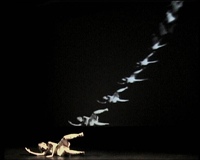
Real-time Processing
Synk is an experimental dance / video / audio piece where video and audio samples and recycles the movements of the dancer on stage, creating rich layers of images and sound. The performance deals with transformation of time ; distortion, displacement, delay, layering and buffering. The idea of Synk is that no prerecorded video or audio will be used, only material sampled during the performance are presented, to investigate live as raw material, and to impose a structure on a live situation to allow unpredictable results within that frame structure. Synk was made in 2002 and performed in a split-evening with the video ensemble 242.Pilots.
On Friday May 4th, (HC Gilje) performed Synk with Kreutzerkompani and Justin Bennett. More images from Synk (click on the small images).
Posted by jo at 02:32 PM | Comments (0)
Sinister
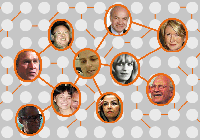
Social Networks Foster Conspiracy
Annina Rüst's Sinister "is a service based on research into software designed to identify and analyse suspicious behaviour through communication patterns rather than the content of conversations (data-surveillance). Visually, Sinister appears as a friendly social networking environment, but it suggests that social networking also fosters conspiracy. Online chat bots and automatised scoundrels (artificially intelligent characters) infiltrate chat networks and discuss seemingly common-place topics such as gardening, but occasionally include criminal harmful comments. You can telephone the bots and insert your own messages into their conversations also, using voice recognition software which looks for con-spirative content. The software then maps and interprets these online conversations, comparing diagrams to a database to determine the possible unfriendly uses people might have for the online social network. In the gallery-based installation, the seats represent the nodes in the social network – by moving the seats around as you join into conversation with your fellow visitors, the computer can then draft and analyse new diagrams based on the connections in the social network you create." Part of MY OWN PRIVATE REALITY: GROWING UP ONLINE IN THE 90S and 00S.
Posted by jo at 01:16 PM | Comments (0)
AUR: a Robotic Desk Lamp
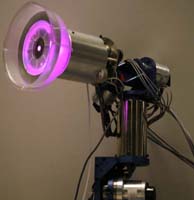
Performs Lives
AUR: a Robotic Desk Lamp is a robotic desk lamp, a collaborative lighting assistant. It serves as a non-anthropomorphic robotic platform as part of Guy Hoffman's Ph.D thesis on human-robot fluency and nonverbal behavior. The lamp's design was conceived around an existing 5-DoF robotic arm, and is aimed to evoke a personal relationship with the human partner without resorting to human-like features. By retaining the lamp's "objectness", I hope to explore the relationship that can be maintained through abstract gestures and nonverbal behavior alone.
The lamp is animated using a custom pipeline enabling the dynamic control of behaviors authored in a 3d animation system. This week, it will take its first stab at performing alongside human actors in MIT Dramashop's Playwrights in Performance. That's right, a robot, on stage, live, with nothing but an emergency button to save it. What: "The Confessor" - a play by Rony Kubat written especially for this human-robot ensemble.
When: May 9, 10, 11 @ 8pm
Where: Kresge Rehearsal Room B (seating *very* limited)
How: As part of MIT Dramashop's "Playwrights in Performance" and in collaboration with the MIT Media Lab
Posted by jo at 12:11 PM | Comments (0)
May 09, 2007
liners performance -- May 10, 2007

The "liners" performance by Zach Lieberman and Theo Watson revolves around a simple graphical idea: a line which starts and never ends. The performance mixes different video clips that people have sent them of lines being drawn, along with live content, in order to tell the story of a seamless line which never ends. The two performers use custom software to seemlessly mix together a large series of live and pre-recorded linear expression into a ceaseless, evolving, whimsical landscape, in which one line leads to the next. From a line of simple pixels, to a hand drawn line, to a horizon line, to a line of text, the performance is not at all about getting to a final destination, but completely about the delight of traveling.
They are accepting contributions until noon on May 10th. For information on what kind of material and where and how to send it, click here
Posted by newradio at 05:40 PM | Comments (0)
Art Intercom: An Interview Series with the iCommons Artists in Residence
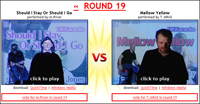
MTAA
Art Intercom: An Interview Series with the iCommons Artists in Residence. Featuring Art Collective MTAA: MTAA (M.River & T.Whid Art Associates) is simply described on their website as “a Brooklyn, New York-based conceptual and net art collaboration founded in 1996.” I like them because they give me wine when I visit their studio. I like their work, because it is characterized by economy of expression without being generalized or simplistic. What’s more, they frequently extend this aptitude to create feedback systems that require the same streamlined response from their audience. The result is very clean and eloquent communication mediated by or in the form of websites, installations, sculptures and photographic prints. Creative Commons licensing plays a critical role in their work, because it provides a set of pre-established rules for use of their work so that they don’t have to. In short, it simplifies the conversation, and facilitates the elegance that defines their art.
In the two part interview that follows I discuss specific works and what the collective has planned for the iCommons Summit. Part One; Part Two.
Posted by jo at 09:14 AM | Comments (0)
May 07, 2007
Schwelle

@ Elektra 08
Schwelle II at Elektra 08 / Place des Arts / Cinquieme Salle Series, May 10-12, 2007 :: Schwelle is a three part new media and performance project using cutting edge acoustic and interactive technologies to explore the extreme threshold states of consciousness that constitute human experience. Part II is a live performance in which the audience confronts a lone single performer Michael Schumacher, master improviser and former dancer with William Forsythe's Frankfurt Ballet, experiencing the traumatic transition period between death and rebirth. Utilizing wireless sensor networks in the room and on the dancer's body, Part II creates a stage environment where light, sound and objects take on their own choreography, performing with Schumacher, breathing, and behaving alongside him. Where does the body end and the room begin? What happens in the threshold where body and room merge, mutually influencing and transforming each other?
Concept/Direction: Chris Salter in collaboration with Michael Schumacher
Performer: Michael Schumacher
Dramaturgy: Heidi Gilpin
Lighting: Leah Xiao
Sound Design/Programming: Marije Baalman, Daniel Grigsby, Chris Salter,
Philip Viel
Interaction Design/Sensing/Programming: Marije Baalman
Production Technical Director: Harry Smoak
Co-Production: Elektra Festival and Place des Arts/Cinquieme Salle with
the support of Tesla Medien Kunst Labor-Berlin, Transmediale, ACREQ, Hexagram, Concordia University, FQRSC
Thursday-Saturday, May 10-12, 2007, 20:00
Place des Arts/Cinquieme Salle
Place des Arts
For tickets please call: 514-842-2112
or http://www.pda.qc.ca
Posted by newradio at 01:34 PM | Comments (0)
May 03, 2007
the story of a never ending line
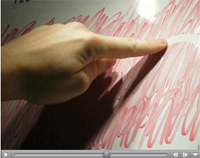
Call for Contributions
Zachary Lieberman is making a performance at the OFFF festival along with his good friend Theo Watson (of L.A.S.E.R TAG fame). The idea of the performance is really quite simple -- the story of a never ending line -- and the performance will be made up of both videos as well as live material, and synthesized graphics.
We are asking you, with your awesome brains and wicked fast design skills, to send us videos in your own style, of a line being drawn from one side of the screen to another. It can be animated, live video, computer generated, or some other way we can't even think of yet.
We would love to get videos from you to use in our performance. The more imaginative the better! All the videos used will be credited at the end of the performance so it will be a great chance to show what you can do with a line and 5 seconds of time. Multiple submissions are encouraged!
Rules:
1: The line should start off screen, enter on one side and leave on
another (doesn't have to be right to left, can be any side to any side, including the same leaving on the same side the line started on).
2: The line should have the effect of being drawn, not moved across the screen. See examples bellow.
Good: http://impssble.com/OFFF/good.mov
Bad: http://impssble.com/OFFF/bad.mov
3: Once a part of a line is drawn it should not move too much, the animation should be the effect of drawing the line (as in the good movie above).
4. The video doesn't necessarily have to be the drawing of a line (although most of what we are working with is), but it can also be something moving along a very clear path. The idea should be about going from point a to point b.
5. Both sound or silent is ok.
6: Videos should be 3 - 8 seconds long, 640 480 quicktime format. (320x240 also ok)
7: Videos should be submitted to zlieb[at]parsons.edu or theo[at]muonics.net (if under 10MB) or posted online for download.
8: We need them by tuesday 8th of May.
We hope you enjoy this challenge, and would like to take part in our project. Thanks and have fun!
zach & theo
Posted by jo at 11:52 AM | Comments (0)
Bjørn Magnhildøen
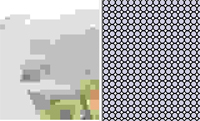
Chyphertext / Noisetext Performance
Bjørn Magnhildøen: Chyphertext / Noisetext Performance :: May 3, 20:00 - 21:30 (central european summertime)* Places: web, mail. Subscribe to the noisetext list to receive performance emails. Thanks to noisetext list admin phaneronoemikon / lanny.
Haphazard description of the performance: a c(h)yp(h)ertext performance betatesting, in a series of protocol performances dealing with networked online events. In addition to a text and code feed, there are images, sounds, a webcam, text interaction, and email.
The images are rather randomly chosen among jpgs less than 750 bytes in size. The sound is realtime generated midi from the textfeed the webcam updates every five sec or so the interaction are textbased, you can input text in the form to the right, longer or shorter one-liners - these inputs goes into the feed and from there into the sound output also. Mails are sent out as part of the event. If the thing hangs, halts or hucks up, try to reload the page or restart the browser. Any report or comment appreciated.
Thanks to Norwegian Cultural Council for funding protocol performance, and Atelier Nord for hosting noemata and the event.
* CEST = central european summer time = UTC/GMT +2 hours.
In other timezones the performance will be:
England: 19:00 - 20:30 (UTC +1)
US Westcoast: 11:00 - 12:30 (UTC -7)
US Eastcoast: 16:00 - 17:30 (UTC -4)
(see eg. http://www.timeanddate.com/worldclock/ )
Posted by jo at 10:51 AM | Comments (0)
May 01, 2007
LIVE: (Possession & Poetry Part 2)
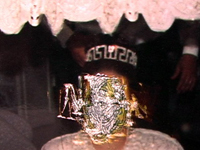
Machfield at Tanzquartier Wien
PREMIÈRE: LIVE: (Possession & Poetry Part 2) :: May 10-12, 2007, 7pm :: Length: 3 hours (TQW Foyer and Studios) :: Tanzquartier Wien | Studio.
When someone goes on a journey then they narrate something: for two months, the choreographers Sabina Holzer and the “fictionaut” Jack Hauser went in search of material for their new production, studied Morocco and Spain as well as films, music, texts and dreams. The unforeseeable and the unknown – essential components of every journey – are also the essential parameters of LIVE. On stage with the Machfeld artists’ collective, consisting of Sabine Maier and Michael Mastrototaro as well as the musician Martin Siewert, Holzer and Hauser go into the adventure and the way of work of traveling:
“Some things are prescribed, a lot is prepared”, say the performers. They follow the gestures, sounds, lines and colours which have been appearing carefully. A secret system of phantasms? This and other things the audience is invited to discover with them.
Bon voyage!
Concept, staging: Sabina Holzer, Jack Hauser
Live video, video editing: MACHFELD (aka Sabine Maier & Michael Mastrototaro)
Live soundtrack: Martin Siewert
Realisation, performance: Jack Hauser, Sabina Holzer, Sabine Maier, Michael Mastrototaro, Martin Siewert
Production: Sabina Holzer / Jack Hauser and Tanzquartier Wien.
With the support of the City of Vienna.
MACHFELD, International Arts and Culture Society
A-1020 Vienna, Max Winter-Platz 21/1
Phone: +43(0)650 99 103 04
http://www.machfeld.net
http://www.myspace.com/machfeld
Posted by jo at 10:47 AM | Comments (0)
April 30, 2007
It takes 154,000 breaths to evacuate Boston
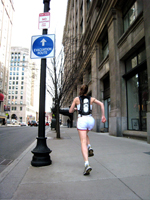
How do you measure fear?
Right now, kanarinka is running the entire evacuation route system in Boston and measuring its distance in breaths. The project is an attempt to measure our post-9/11 collective fear in the individual breaths that it takes to traverse these new geographies of insecurity.
It takes 154,000 breaths to evacuate Boston consists of a series of running performances in public space (2007), a web podcast of breaths (2007), and a gallery installation of the archive of breaths (2008).
It takes 154,000 breaths to evacuate Boston is presented by iKatun for the 2007 Boston Cyberarts Festival. The project will be on view at the Cyberarts Gala on Fri, May 4, 2007, 6:30pm at the Hotel @ MIT, Cambridge, MA. If you want to attend a running performance, email kanarinka AT ikatun DOT com for upcoming dates & locations or just subscribe to the podcast.
Posted by jo at 11:14 AM | Comments (0)
From White Box to Inbox
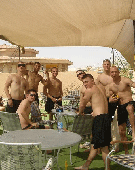
Jesse Aaron Cohen
On the last Friday of every month, archivist Jesse Aaron Cohen 'opens' a new email exhibition. The shows are delivered to subscribers' inboxes, in the form of thematized collections of digital images. (Below is the root directory for these images.) Cohen is based in New York and many of the shows in his series revolve around immigrants to the city and diaspora Jewish culture. The current one, number 28, is called 'Dr. Z's' and features scans of ads for 'health, beauty, and wellness products and practitioners as they appeared in programs from various Yiddish theaters in New York between 1890 and 1928.' The title is inspired by dermatologist Dr. Zizmor's (Dr. Z's) ubiquitous subway ads, as traced in the supplementary links included in the email. Each of the exhibitions features such extra info and is contextualized by a brief curatorial statement.
Number 21 was simply called 'Myspace,' and the statement read, 'This exhibition features images found on the Myspace pages of US soldiers currently in Iraq. Click on the photo to view the profile.' Together, and without extra editorializing, the images painted a broader picture of the anxieties and banalities, of the soldier's daily life. Exhibition 4 ('Envelope Art') focused on mail, itself, and identified 'four disparate groups in which envelope art has thrived as a creative medium, namely: members of the US Armed Forces, Deadheads, incarcerated Americans, and video game enthusiasts.' Once again piecing together artifacts to make a thoughtful cultural statement, Cohen's musings might also apply to email art: 'If the medium is the message, then the message of envelope art seems to generally involve craft, dedication, boredom, and the desire to communicate personality with the recipient from afar.' - Marisa Olson, Rhizome News. http://brightbrown.fastmail.fm/
Posted by jo at 09:05 AM | Comments (0)
April 25, 2007
a show of hands: May 1, 2007
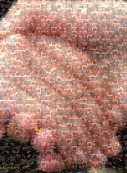
Show of Solidarity
A year ago, the immigration reform movement swept through city centers across the United States in an historic series of marches. Over a million workers and their families took to the streets. This year a second wave of marches has been planned (May Day 2007). Although media outlets frequently focused on Latin American immigrants, the rallies invited all immigrants and their supporters to make their presence known, and many answered the call. After attending that march and being swept in the currents of political change, I began a show of hands.
As a show of hands is still in its early stages, I encourage readers to explore it and to send their feedback. Remember to register for Literatronica (even just as a guest) so the system can best adapt to your reading habits. Literatronica is available to authors who are interested in developing their own literary hypertexts. Readers can see a list of the current selections at the site.
Culminating in the May 1, 2006 marches, a show of hands is an adaptive hypertext written on Literatronica (or Literatronic), a system developed by Colombian doctoral candidate (FSU) Juan B. Gutierrez. Although the piece is in-progress, [Mark Marino] wanted to take this moment to present its early manifestation in commemoration of the marches that inspired it.
The icon of a show of hands is a photomosaic (there are currently two in the piece), featuring images of the hands of the marchers as well as of those of other people I encountered through Los Angeles at the time. The photomosaics also act as navigational maps, leading to the various storyheads in the tale. The reader chooses from the hands.
The hands could not be reduced or flattened to an iconic Brown Power fist. While at the march, I snapped pictures of hands, waving flags, raising banners, cradling cell phones, and aiming cameras. Marches often become a single image in the newspaper, members dissolve into a solitary stream. However, the vision, this showing of hands could not have been predicted, and the hands themselves, in all their activities and difference, good not have been imagined. And this is the age of multiple media as this Flickr set from the Chicago march attests.
The photomosaics bring together these photographs to form the broader image of this moment. Of course, due to the gaps inherent in mosaics, the image requires the viewer to complete it, to integrate the pieces, to recognize the larger pattern in what might be called gestalt. Read more >>
Posted by jo at 02:18 PM | Comments (0)
boredomresearch's
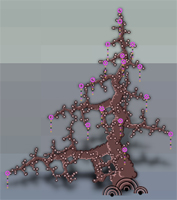
the Forest of Imagined Beginnings
boredomresearchs' latest web project is now live! Go to Explore the Forest of Imagined Beginnings & leave your thoughts embedded in the trees.
boredomresearch are interested in creating landscape environments online that develop over time, where users can explore and manipulate these environments, creating an individual experience which is both contemplative and rewarding. In the Forest of Imagined Beginnings there are no clear rules or objectives. It is simply an online landscape that is vulnerable to the whims and wants of the community that adopt this digital terrain as their own.
Forest of Imagined Beginnings will be exhibited at enter_unknown territories, International Festival & Conference for New Technology Art, Cambridge UK (25th-29th April). During this festival boredomresearch will be discussing the development of this work in a public presentation on Saturday 28th April.
This project has been co-commissioned by folly, Lancaster & enter_unknown territories, International Festival & Conference for New Technology Art, Cambridge UK and supported by the National Centre of Computer Animation, Bournemouth University.
Posted by jo at 12:32 PM | Comments (0)
April 21, 2007
1001 nights cast

night 667 from LA
This week 1001 nights cast passed the two-thirds milestone with a story by Caroline Lee for night 667. And this Sunday, for the first time, the International Date Line will be crossed. This event gets Barbara Campbell across the Pacific without missing a date on the calendar and she gets a 24 hour holiday as a bonus (largely spent in an economy class seat).
Performance number 671 will be on April 22 at 7.30pm from Los Angeles. That is: 10.30pm in New York, Toronto and Bogota; April 23, 3.30am in London; April 23, 4.30am in Madrid, Paris, Berlin; April 23, 5.30am in Beirut, Jerusalem, Istanbul; April 23, 10.30am in Hong Kong and Perth; April 23, 12.30pm in Sydney.
As you can see, for most places other than North and South America, there will be no performance on the April 22 date. Campbell will do three performances from LA before heading to the east coast of the US. The pop-up news page on the site will give the relevant information about changes to performance times according to where you are. You'll start to see lots of new writers' names, as well as European ones returning.
Posted by jo at 11:53 AM | Comments (0)
Turbulence Commission:
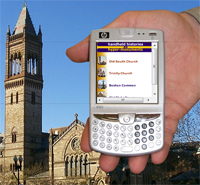
Handheld Histories as Hyper-Monuments
Turbulence Commission: Handheld Histories as Hyper-Monuments by Carmin Karasic, Rolf van Gelder and Rob Coshow, with special thanks to the HP mscapers team, Brett Stalbaum, and Jo Rhodes :: Part of the Boston Cyberarts Festival, pick up a smartphone at the Judi Rotenberg Gallery, 130 Newbury Street, Boston :: April 21-28, 2007, Tues-Sat 10am-6pm. Gallery talk today: 2:00 pm.
Designed for HP iPAQ 6900 series smartphones, Handheld Histories as Hyper-Monuments uses GPS and mobile technologies to address historic bias in Boston's public monuments. The artwork gathers non-official stories to socially construct hyper-monuments that exist as digital doubles, augmenting specific historic monuments. For example, imagine you are near the Old South Church in Boston, MA, USA. The smartphone sounds church bells to get your attention. It then displays an easily identifiable image of the Old South Church circa 2007, followed by images of the church that take you back in time. Finally you see the location as it was in its natural, wild state. You can send text, image and audio content to the website from the monument location via any internet enabled device. Or use any internet browser to view and add histories to the hyper-monuments.
HHHM requires HP mediascapes locative media software to create content rich hotspots on GPS aware maps. Once the HHHM mediascape is installed on a handheld device, a GPS fix is required to automatically display the hyper-monument. WiFi internet connectivity is best for viewing and contributing to the hyper-monument via the handheld's browser.
“Handheld Histories as Hyper-Monuments” is a 2007 commission of New Radio and Performing Arts, Inc., (aka Ether-Ore) for its Turbulence web site. It was made possible with funding from the LEF Foundation.
BIOGRAPHIES
One November morning in 1994, CARMIN KARASIC was listening to digital artists on NPR when she realized she was a digital artist trapped in a Fidelity Technical Project Manager's body. This simple realization changed her life. A multimedia artist focused on Internet Art, she is also an Assistant Director of Boston Cyberarts, and on the faculty of Lesley University. Her work can be seen online in several e-zines, websites, and galleries, such as CAGE. She has exhibited in the Boston area at the DeCordova Museum, MIT List Center, the Attleboro Museum, Computer Museum, New England School of Art and Design, The Art Institute of Boston, and The Brodigan Gallery; in NY at the Studio Museum, Harlem; Brooks Gallery at Cooper Union, and the New York Hall of Science; and Austria, Canada, Japan, and Germany. Carmin has been awarded a Mudge Fellowship from the Groton School and a duPont Fellowship from the Art Institute of Boston.
ROLF VAN GELDER is an artist and web developer. Self-taught, he has been creating visual art since the early 80s. He has been collaborating with Carmin Karasic since the 1990s. They created "d{s}eduction dialogue" for the 2001 Boston Cyberarts Festival and "Virtual Quilt" (2002) for the DeCordova Museum and Sculpture Park, Lincoln, MA, USA (with Clara Wainwright). In 1995 Rolf founded one of the first on-line art galleries, CAGE - Cyber Art Gallery Eindhoven (http://www.cage.nl). His work has been exhibited in over 50 exhibitions in the U.S.A., Canada, Austria, Portugal, Italy, Sweden, Germany, UK, Spain and the Netherlands.
ROB COSHOW is an artist/photographer who recently graduated Magna Cum Laude from the Art Institute of Boston. Trained in classic wet-lab photography as well as digital and new media, Rob has honed his experimental approach to create works that bridge multiple disciplines. In 2006, he exhibited his “Crab Cake” robots at Axiom Gallery, and collaborated with Jeff Warmouth, Roland Smart and other Boston artists to create “Art Show Down” at Art Interactive. He has received various honors for his photography and illustrious reviews for his new media work.
Posted by jo at 10:10 AM | Comments (0)
April 20, 2007
N3KROZOFT LTD's Aether 9
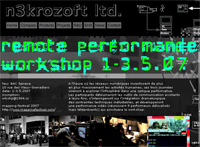
Collaborative Video Performance
the N3KROZOFT LTD media group is pleased to announce the world premiere of the collaborative video performance, Aether 9. Linking nine performers in various remote locations around the globe, this performance will occur on May 3, 2007, 21:00 CET, in the framework of Mapping Festival Geneva, in conclusion to a 3-day workshop directed by N3KROZOFT members.
Conditions of participation: [1] Participating in the workshop : If you wish to follow the workshop in Geneva: plase send an email to wrkshp[at]1904.cc describing briefly your experience and motivations (moderate knowledge and experience of video tools + originality of ideas is expected). Workshop dates are: May 1st-3rd, 14:00-18:00. Workshop location: BAC, Geneva (see below).
[2] Participating as a remote performer: Artists wishing to participate in one of the remaining performance slots: please send an email to remote[at]n3krozoft.com. Requirements for remote performers:
- You need to have access to an imaging device (webcam, miniDV camera) and a computer linked to the internet.
- Sufficient knowledge of video tools + performance is expected, to operate for instance a webcam and upload its images to a server. Server access will be provided.
- Knowledge of Max/msp or Pure Data is an advantage, but not a necessity.
- You are required to be available through skype or similar protocols for instructions and synchronisation during the days prior to the performance (1st-3rd May).
- 100% availability during the performance and at least 1 hour prior to performance is crucial.
Questions and Answers
Q - What will this look like?
A - The basic concept: 9 different locations will be linked during a 60 minute performance. The performance will be projected as a 3x3 grid of videoframes.
Q - When and where will the performance take place?
A - The performance will occur on Thursday 3rd May 2007, 21:00 (9 PM) Central European Time. The location is the BAC (Bâtiment d'Art Contemporain), 10 rue des Vieux-Grenadiers / 28, rue des Bains, Geneva, Switzerland.
Q - Is it possible to watch the performance on the internet?
A - The performance will be visible through the internet. Not directly as a video stream, but as a standalone viewer application, which will be available at http://n3krozoft.com/remote. If you are in charge of a public venue, you are welcome to use the standalone viewer to broadcast to performance to an audience. Click here to find your local performance time: http://tinyurl.com/2rjxhb
Q - Will there be any dogma/ritual imposed on the performers?
A - The content of the performance will be dictated by a formal set of rules, which will be established in part during the first 2 days of the workshop. The significance of time and the subjectivity of human experience in a specific
timeframe will be a crucial element of the performance.
Q - What technology will be used for the transmission of images?
A - To insure the possibility for performers in low-tech situations to participate, the system will be designed for robustness rather than for speed. Since streaming video needs a considerable upload rate, the transmission of images will occur rather through image-by-image upload, allowing participants to use slower transmission lines. The target frame refresh rate will be 5 seconds, similar to the transmission rate of the videophone devices in use during the 1990's. At the main performance venue, buffered playback will occur at much faster or slower framerates, depending on the performer's actions.
Posted by jo at 10:33 AM | Comments (0)
Brad Kligerman Ars Virtua Artist-in-Residence (AVAIR)
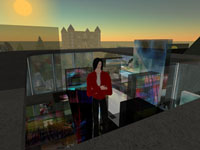
Determining Image-Space
Brad Kligerman Ars Virtua Artist-in-Residence (AVAIR) « Organizing light in the time and space of the projected image » (the determination of an Image-Space) :: Opening TONIGHT April 20 (23:59 SLT) & April 21 (12:00 SLT - noon) :: Go Here >>
Artist and Architect Brad Kligerman has turned the idea of art making upside down or rather inside out in his AVAIR exhibit. Kligerman questions the idea of materiality in the rendered environment and the nature of image. He successfully blends the idea of moving through "space" with the idea of moving through image in his new multi-sim installations.
Over the course of Kligerman's eleven week residency he has collected images from various experiments in SL. These images have been deftly applied to objects which form a path through three "machines." Kliger uses these machines to extract data from SL in order to understand materiality, quote the history of art and painting and contrast with what has become "traditional" Second Life architecture. The end result is a series of places where image and space become one.
"In contrast to projects that view virtual worlds as simply another node in a communication strategy, this project attempts to find another creative and productive scenario by interrogating the physical and material extents of SL."
"This project recognizes synthetic space not for its faculties of communication, but rather for its potential as a representational, sensational medium. "
"Image resonates on its surface, through its envelope and beyond its physical reach, to capture, through the distribution of space, its tangible atmosphere. Avatars merge in image, emerge through the image, we lose ourselves in the image, of art, only to reemerge through it. The colors, lights and forms, the tensions and compressions of the space's force, superpose to project an «Image-Space »."
AVAIR is an extended performance whose purpose is to investigate the nature of art making in the 3D synthetic environment of Second Life. It is an examination of policy and institution, as well as a reflection on place and art. Artists are given a stipend and technical support. They are expected to have an open studio, produce an exhibition, and make a public presentation. Their methodologies are documented here. Orchestrated through the classic structure of the gallery, the performances run at any time of the day or night, and create a platform for exchange between artist and audience.
“AVAIR” is a 2006-2007 commission of New Radio and Performing Arts, Inc., (aka Ether-Ore) for its Turbulence web site. It was made possible with funding from the Jerome Foundation.
Ars Virtua is a new media center and gallery located in the synthetic world of Second Life. It is a new type of space that leverages the tension between 3-D rendered game space and terrestrial reality, between simulated and simulation. Ars Virtua is sponsored by the CADRE Laboratory for New Media.
Posted by jo at 10:19 AM | Comments (0)
Clandestine Insurgent Rebel Clown Army
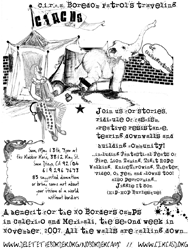
Circus of (Im)Migration
The Boredom Patrol of the Clandestine Insurgent Rebel Clown Army is a gaggle of clowns who spend their days trying to create a world without borders by clowning fascists. They display their videos online and the lovely Minutemen gladly patricipate in the networked performance by engaging in a debate about immigration with all the other posters. You can see their videos here.
The Boredom Patrol is doing a traveling Circus of (Im)Migration from Portland to Tijuana, all along the west coast of the US and a bit of Mexico. Join us for stories, ridicule of fascism, creative resistance, tearing down walls and building community, including Fantastical feats of Fire, Lion Taming, Tight Rope Walking, Knife Throwing, Burlesque, Punk Rock Opera, Theater, oh yeah and clowns too!
..We are C.I.R.C.A. because we live in the borderlands, always in between, on the edge of the nation state, mischevously ambiguous...You can see our lovely flyer here and our travel schedule here.
Posted by jo at 08:50 AM | Comments (0)
April 19, 2007
Emma on Relationships
How to Play
Call (617) 544-3022. You will hear: "Hi this is Emma. Leave a message for me or one of my friends. To leave a message for me, press 1. For Chris, press 2, for Jamie, press 3, for Emma's brother, press 4, for Eugene, press 5, for Sarah press 6, and for Paresh, press 7." Leave a message (up to 15 seconds). You can ask a question like "How do average girls get with hot guys?" or whatever you want. Listen to what other people are saying by choosing one of the cards on the right. Emma will try to respond to your questions and concerns in her next episode. The latest episode is on the topic of "Breasts." Please call. Website.
Posted by jo at 11:38 AM | Comments (0)
April 16, 2007
Domenico Quaranta's Interview with
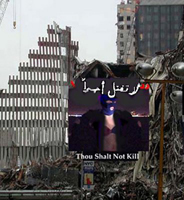
Second Front: A Leap into the Void
At first sight they may appear like a pop hybrid between the X-men and the Four Horsemen of the Apocalypse, reviewed through the exaggerated and postmodern aesthetics of a virtual world such as Second Life. Quite the contrary. They are the first performance art group in Second Life: serious guys, practicing artists, curators and academics in real life, who decided to sound out the performative possibilities offered by a public virtual space that is growing at an impressive rate and being filled up by media agencies, stores, products, brands and inhabitants.
Second Front officially formed on November 23, 2006, gaining new members up right until the last few days. Now they are: Wirxli Flimflam aka Jeremy Owen Turner; Tea Chenille aka Tanya Skuce; Man Michinaga aka Patrick Lichty; Alise Iborg aka Penny Leong Browne; Tran Spire aka Doug Jarvis; Great Escape aka Scott Kildall; Lizsolo Mathilde aka Liz Pickard; Gazira Babeli aka CLASSIFIED.
The attention of “in world” media comes fast, even if Second Front doesn't seem to work much on communication: its very first performances are set up, unannounced, in public spaces, for a little, unconscious audience. Then, almost immediately (January 5, 2007) comes the big intervention scored at Ars Virtua Gallery – the most notable contemporary art gallery in Second Life – for the opening of the visionary installation by the American artist John Craig Freeman (JC Fremont in Second Life). And may other performances...
Saying that Second Front is opening new paths in an unexplored territory is not rhetorical; and the loose, immodest and a little bit punkish way in which they do it is definitely unrhetorical. Their key feature is openness: openness and plurality of visions and perspectives, quite blatant in this interview (where almost each one of them decided to give his/her answer to the same question); they are open about a wide range of interventions, from reenactment to improvisation to code performing; open about different ways of shaping their work for the art audience, from prints to video to live broadcasting. They are growing up before our very eyes. And, rest assured, they hold good things in store.
DOMENICO QUARANTA: What is Second Front?
MAN MICHINAGA: Second Front is an international performance art group whose sole venue is the online world, Second Life. Second Front has members from Vancouver, St. Johns, Chicago, New Orleans, and Milan (to name a few), and works with numerous artists from around the world.
WIRXLI FLIMFLAM: As of January 14th, Second Front received official legitimacy from The Ava-Star tabloid (owned by Die Zeit in Germany) as the “first performance art group in Second Life”. This basically makes us the in-world equivalent of Fluxus – perhaps we could also be nicknamed “SLuxus”. This sudden rush from formation to celebrity has been quite fascinating since Second Front officially formed on November 23, 2006.
As for a more detailed idea of what Second Front is all about, some people in Second Life might confuse us with a “performing arts” group rather than a “performance arts” group. We are not a circus act nor a dance or a theatre troupe although our artistic practice might superficially resemble those other performing acts at times.
TRAN SPIRE: Second Front is a network of performance interested artists exploring new and different environments, specifically the online 3d animated game world of Second Life. The members have come together through a myriad of personal relationships that existed during the early days of the group’s formation. This dynamic has morphed and mutated to include and involve variations on membership based on who is available and what presence can they perform with the others.
DQ: What does it mean, for you, to make performances in Second Life? Do you make rehearsals or do you prefer improvisation? Do you work with code or do you simply make what all other avatars do?
ALISE IBORG: So far we have done both. I think it depends on what kind of performance we wish to make. If it is better improvised we will probably do that. Each has its advantages and disadvantages. With prerecorded performances, we can fine tune and edit out things we don't want the audience to see. But with improvised performances, the work takes on a life of its own fueled by the creative energy of our players which really shows through. Also, many times, it's the surprises and unintended actions that make the work really come alive!
MAN MICHINAGA: Performing in Second Life gives Second Front the opportunity to work at scales they would not normally be able to work in if done in the physical world, and often has the opportunity to play to a wider audience. Our level of preparedness is dependent on the context for the event.
In regards to whether we use code or not, Second Front is using a growing set of code-based interventions in its performances, thanks to our techno-doyen, Mama Gaz Babeli. In regards to our avatars, and props, almost nothing we use is ‘standard’, but some of us retain a few basic props like specific wings, or even old beginner’s props like hair as a sign of their past as newcomers to Second Life.
WIRXLI FLIMFLAM: When we rehearse and plan scripts for major public performance events, we still have to rely on individual improvisation. Nothing is ever entirely scripted so each member can do their “own thing” and have breathing room yet at the same time not be confused as to what they should be doing. We use scripts and rehearsals etc. as a guide to help the performing member to feel secure with the thematic manner with which they wish to improvise. This allows for group cohesion both on an optical and practical level.
GREAT ESCAPE: Second Life offers a unique space for performance. Without the normal constraints of the body ― the usual center of performance - and without a traditional audience, we can try and do things that have been previously thought to be impossible.
TRAN SPIRE: Performing in Second Life introduces variables and situations that complement and push further the understanding and comprehension that the members of the group share as a sense of what is real. By engaging the contrived space of an online gaming environment the challenges to perform are exaggerated by the parameters that persist as the interface with the context, the others members of the group, audiences and the templates of performance as an art medium. All of the tropes of performance are available to the group to use at will, hopefully to ends beyond the surface of what may appear evident around us.
GAZIRA BABELI: The real performance starts with login, the rest is performance record. The avatar just tries to forget being a code.
DQ: Do you prefer, for your performances, a public space or an art venue?
MAN MICHINAGA: Second Front chooses its venues to fit the context of the piece and the performance. In the case of Border Control, it was done at Ars Virtua, therefore the context was that of an art space. For our Breaking News and Abject Apocalypse pieces, these were context specific (the Reuters building and the Star over the Christmas Tree at the US’s NBC Rockefeller Plaza), and were performed in situ, with the product being the documentation.
WIRXLI FLIMLAM: Personally, I prefer a large and well-known public venue that is not usually within the context of high-art. So for example, IBM, Sears, American Apparel, Wired, and Reuters are all great examples of the kind of venues I think are really inspirational for me. Again, this is a personal preference and not necessarily reflective of Second Front as a group.
GREAT ESCAPE: It depends on the nature of the performance. An art venue is interesting because it brings Second Life into the physical space. I think it is ideal to broadcast the performance at an art venue while engaging a specific site in Second Life.
GAZIRA BABELI: In art venues you can be welcomed with cheers, in public spaces with bullets. I prefer the latter, as death doesn’t exist.
DQ: What kind of audience are you looking for? Do you think that a performance in Second Life could be displayed also in the real world?
MAN MICHINAGA: We are interested in reaching out to audiences who are interested in Second Life, and are curious of the possibilities that avatar-based performance art can have. Currently, Second Front is performing in hybrid venues, such as simultaneous events in its home, the BitFactory in Han Loso, and in physical spaces, like Vancouver’s Western Front, and Chicago’s Gallery 416. We do hope that in addition to our performances in Second Life, Second Front can have exhibitions of its performances, imagery, video, and ephemera in the physical as any and all possible media. We do not wish to be limited by media, and also wish to spread our curiosity to the widest possible audience.
GREAT ESCAPE: One thing I think we’re looking to do is to question the underlying assumptions of Second Life and what it means to be a virtual being in that space. A dominant trend in Second Life is to shop, make friends online and participate in a virtual economy. We think this can be a venue for unique artistic expression. In this way, anyone in Second Life is an appropriate audience. The possibilities for the space haven’t been fully explored as of yet and so I think people are much more receptive to performances that they might be in real life. Because it is so new, we can have a huge affect on people’s thinking.
TRAN SPIRE: I like the idea that the notion of an audience is being blurred by my own participation in this group. I am conscious of the fact that during all the stages of our performances from pre-production planning emails to after-party videos, I am both a performer with the group and an audience to the many things taking place. Anything that contributes to challenging this space and dichotomy between creator and audience I think is an interesting thing to pursue.
ALISE IBORG: We are looking for open-minded audiences who are not afraid to be part of the performance. And absolutely, Second Front could be displayed in the real world. The term that I use to describe this intervention into the real world, is 'virtual leakage'.
I define virtual leakage as a two way exchange between the virtual and the real, through which new hybrid meanings can be made. Meaning-making can no longer operate within the hermetic cases of the real vs. virtual, but instead, becomes a back and forth exchange in which ideas migrate by osmosis. While we as Second Life avatars become more real in the virtual world, so too, that we as human inhabitants of the real world become more virtual.
In my opinion, there is an amazing opportunity for Virtual Reality (VR) to stake its own territory but in order for VR to produce meaning that breaks from the real and from past artistic social practices, and to become a medium that produces singular works, the binary of the real vs virtual must be dismantled. Only then, will we be able to look at VR not as a simulation of the real, but as a simulation of itself.
GAZIRA BABELI: I prefer an unaware audience, an audience who does not necessarily have to understand what’s going on. Second Life is a real world.
DQ: Can you tell me something about the performances you had till now? How did your approach changed from the first one?
MAN MICHINAGA: Like any experimental troupe, we are always learning, and this affects our performance process. In addition, for Breaking News, many of us were only recently active, so our first performance was a really interesting experience. In short, Breaking News was an absurdist play on the 18th Century idea of the Town Crier, played out in the latest of 21st Century news facilities. By shouting out non-sequiteur, moment-to-moment headlines, Second Front hoped to perhaps jam the usual flow of information in the Reuters space, and possibly (ridiculously enough) barge into Adam Reuters’ office itself! On the second occasion, we did get an audience, as passers-by stopped and sat to listen to our tabloid headlines. Of course (we assume) they did not take us seriously. For Border Control, we knew we would have an audience, and that we would need to fill a fairly set period of time with detailed orchestration, we experimented at the BitFactory, rehearsing a series of vignettes that fit the context of JC Fremont & Rain Coalcliff’s Mexican Border installation. The first act, “Border Patrol” was a Dada-esque performance of the increasing militarization of the borders throughout North America. Following that, “Red Rover” was a play on the creation of a border in the traditional children’s game, but in our case the border decided to break down the audience instead of the other way around. Lastly, the final act, “Danger Room” was a piece that was intended to inspire a gestalt of danger and chaos in the age of Terror, but unexpectedly, chaos erupted and the sim actually crashed, whether by our actions or a combination of us and the audience isn’t really clear. The approaches for the two pieces are quite different, as one is ad-hoc and the other following a set choreography and set. Are we changing? Of course; it wouldn’t be interesting if we weren’t. We learn new things each performance, and while certain things get easier, we then try to push the envelope harder in other areas.
TRAN SPIRE: I like to think that part of the script of each performance is written in the code of the place or environment in which it is situated. This lets the content be influenced by not only the art or non-art context but also by the different terrains that can exist in the real life as well as Second Life.
DQ: What do you think about art in Second Life? Is performance the only possible way to make art out there?
MAN MICHINAGA: Absolutely not. While Second Life has limitations like any medium, the members of Second Front are excited to see individuals working in many different forms of expression, such as live music, ‘painting’, sculpture, even fireworks and aerial ballet. While Second Life is relatively new, the possibilities for expression in virtual worlds has yet to be fully explored. That’s why Second Front was created!
WIRXLI FLIMFLAM: Context is extremely important here. Part of what makes Second Life itself is the fact that every moment seems like part of a performance. The fact that everything can be customizable in Second Life as well as the fact that just about any object can be wearable enhances my personal impression that performance art is the most “authentic” medium of Second Life in that Greenbergian sense.
GREAT ESCAPE: Right now, the Second Life galleries are mostly replicating paintings and sculpture, enhanced with visual effects in Second Life. These are what you’d expect with the first generation of art-making in any new medium. I think that what we’ve seen so far in Second Life is only a glimpse of what the future holds.
ALISE IBORG: Absolutely not. Second Life has offered the ability for anyone to create in VR which means that there is boundless possibilities for creativity and unprecedented work. In my opinion, VR is in itself a new medium but what is unique about VR is that through its technology, it can create work that can free itself from past art practices, though, there is also amazing avenues of creation by referencing precedent artists and works, For instance, our Last Supper performance appropriates one of the most canonic religious events by producing an event of binging and purging art itself!
GAZIRA BABELI: Second Life is a frame-space which can include all sorts of artistic perversion. I call it performance, anyway. But if you find a better definition, please let me know.
DQ. What is your relationship with your Real Life counterpart?
MAN MICHINAGA: There really is none. Patrick Lichty does not exist. Only I am real, and I control him. On a more serious note, the relationship between Man and Patrick is completely in line with my RL life. I am very sensitive to context, and the way I act in one context may be very different from another. In Second Life I feel that one has to be “Larger than Life”, and that's what Man is – He’s a big dark, figure – part angel, part rock star, part architect, part actor. That is, all the things that Second Life gives the individual more freedom to be if they so desire. I think that most of Second Front do this with great effectiveness and aplomb. My greatest concern is “the risk of the Artist”; that is, the bleed between worlds that I take by making potentially controversial art in Second Life. I think that Second Life is the first place where we can say that sometimes our action online DO matter, and this is very perplexing.
GREAT ESCAPE: I think that the avatar Great Escape occupies a strange nook in my subconscious. In many ways, Second Life operates as a fantastical dream state. We can fly, teleport and pick up houses and cars. My avatar has purple skin and fire out of his hair. When I go to sleep at night, images of the other Second Front members often fill me head. So for me, my avatar is embedded in my psyche, rather than an extension of my self.
WIRXLI FLIMFLAM: In a lot of ways, the relationship between Wirxli and Jeremy is much more closer than one might think from first seeing me. I did intentionally want to make Wirxli more of an alien than human or perhaps as a kind of first-generation “post-human”. I was also reading up about the stereotypical shaman in most cultures who is gender-ambiguous... so in this case, there is a slight departure here from my Real Life self.
TRAN SPIRE: I prefer to triangulate, dimensionally shift my relationship to each of the entities constituting themselves as versions of me. Therefore, I am waiting for the two to have a discussion and then ask me to join in on the conversation. I am interested to hear what they come up with and how they define themselves in regards to existence in a spatio-temporal plane, and whether they recognize each other.
GAZIRA BABELI: My body can walk barefoot, but my avatar needs shoes.
LINKS:
Second Front - http://slfront.blogspot.com/
Gazira Babeli - http://gazirababeli.com/
The BitFactory - http://patricklichty.com.thing.net/bitfactory.html
Ars Virtua Gallery - http://arsvirtua.com/
Imaging Place - http://imagingplace.net/
Domenico Quaranta is an Italian art critic and curator focused on New Media Art. He is the author of the book Net Art 1994 – 1998: La vicenda di Äda'web (Milan 2004) and, together with Matteo Bittanti, the editor of GameScenes. Art in the Age of Videogames (Milan 2006, http://www.gamescenes.org/). He curated several exhibitions in Italy, including: GameScenes (Turin 2005), Radical Software (Turin 2006), and Connessioni leggendarie. Net.art 1995 – 2005 (Milan, 2005). He teaches “Net art” at the Accademia di Brera in Milan.
A LEAP INTO THE VOID: INTERVIEW WITH SECOND FRONT by Domenico Quaranta is was commissioned by Rhizome.org.
Posted by jo at 06:00 PM | Comments (0)
April 15, 2007
Karaoke DeathMatch 100 (AKA KDM100)

New Rounds Daily, April 15 - June 4
Artist collaborative M.River & T.Whid Art Associates face off in the most brutal performance art smack down of the new millennium… Karaoke Deathmatch 100! This alcohol-fueled blood feud features 50 rounds of sing-along fury (taped live over an 8-hour period with hardly any pee breaks). No Carpenters hit too cheesy, no heavy metal lyric too trite for these teleprompter warriors to hurl in a battle to the end. Who will emerge victorious? Only YOU can decide.
MTAA's Karaoke DeathMatch 100 is a video blog performance that takes place over 50 days starting April 15th, 2007 and ending June 4th. Each day, a new round is posted pitting M.River & T.Whid against each other in drunken karaoke competition. Visit the web site daily to view the sets of videos, vote for your favorite and discuss the artists' performances. At the end of the competition, the votes will decide who is the Karaoke DeathMatch 100 Champion.
The web version of KDM100 is an official selection of Visual 07. 7º Festival De Creación Audiovisual Ciudad De Majadahonda. The gallery version of KDM100 premiered at the Leonart '05 art festival in Leonding, Austria.
KDM100 was shot in May 2005 over 8 hours.
credits:
video production:
Bill Hallinan, Andre Sala and George Su
web production:
T.Whid & M.River
Developed using open-source software: Wordpress, X-Poll and embedthevideo.
URLs:
web site: http://www.mteww.com/kdm100/
QuickTime feed: http://feeds.feedburner.com/kdm100m4v
Windows Media feed: http://feeds.feedburner.com/kdm100wmv
also available on iTunes...
Posted by jo at 02:17 PM | Comments (0)
April 12, 2007
Object of Desire by Yael Kanarek
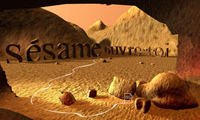
Three Languages, Four Ports of Entry
World Premiere of Internet art project Object of Desire by Yael Kanarek: Object of Desire is the third chapter in World of Awe, and online travelogue that chronicles a search for lost treasure in a parallel world called Sunset/Sunrise. The project imagines a post-gender and post-national protagonist. Born from an observation that language defines borders and territory on the Internet, Object of Desire examines these borders, as the chapter is written in three languages: English, Arabic and Hebrew. Challenging the notion of fixed territory, thirteen scenes of the online project download from servers in four locations-—in Ramallah, Tel Aviv, Izmir and New York.
Object of Desire has four web addresses by which to enter: New York; Tel Aviv; Ramallah; Izmir.
Object of Desire was awarded a 2005 Renew Media Fellowship (funded by the Rockefeller Foundation)
Friday April 20, 2007, 7:15 PM: Artist's Talk with Yael Kanarek :: 8:00 PM: Panel Discussion: Plausible Maps, Possible Worlds: Memories for a Post-National Future with Galit Eilat (moderator), Livia Alexander, Hakan Topal, and Michael Connor :: Exit Art, 475 Tenth Ave (at 36th street), New York, NY 10018, Tel. (212) 966-7745.
Posted by jo at 12:39 PM | Comments (0)
April 11, 2007
Last Tag Show Net Performance
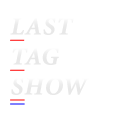
Exploring the Facade of Web 2.0
Multiplace 2007 | network culture festival presents Last Tag Show :: On 14th of April watch http://www.lostpostservice.net/lts for a net performance exploring the facade of Web 2.0. Name it social media hack or Web 2.0 circuit bending, but above all the show is going to refer to global performance of users building and enhancing their own web image setting thus a social mask and yielding a performance of it's kind.
Last Tag Show will start at 8am London time, 3am NY time, 9am Prague time, 11am Moscow time and will run for 24 hrs. For time converter tool go to world time server.
Posted by jo at 02:44 PM | Comments (0)
April 10, 2007
SKINdoscope
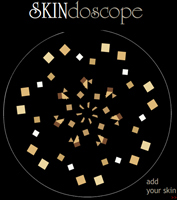
A Game of Alterity and Identity
Participate in Martha Gabriel's SKINdoscope by entering your personal data and your skin color (by clicking the button "add your skin"), and choosing your position in the kaleidoscope. You can also interact with the SKINdoscope by controlling th speed, mirrors, zoom and filters, or by choosing a specific visualization mode (skin, gender, name, age, etc...), therefore changing the visual presentation and effects.
The skin is the largest human body organ, and besides being its protecting layer and a system that regulates the body temperature and receives pain and pleasure stimuli, it also strongly contributes to the individual identification: it is the skin that in the first place separates physically our inside and the outer world – the other.
Among several skin characteristics that distinguishes one person from another, its color is one of the most interesting and maybe the most controversial. The human skin has nuances of colors that form together a true and interesting aquarelle. The skin has been reason for passions and wars in the human history, for it can either unite or separate, either regarding the semblance or the difference. “The difference is simultaneously the base of the social life and permanent source of tension and conflict.” (Gilberto Velho, in “Cidadania e Violência”, 2000).
According to the skin color and some other physiological and characteristics, the present work – SKINdoscope –builds a kaleidoscope on the web, where the poetics and visual result are formed and depend on the relationship between the pieces and the shapes and colors of each one, in a game of alterity and identity.
The SKINdoscope is formed by the pieces that represent people who have interacted with the work – the size of each piece is proportional to the person’s BMI (body mass index), the color of the piece is the person skin color and the shape of the piece is determined according to the person gender. The position each piece occupies in the space of the kaleidoscope is defined by the person herself/himself, and she/he can choose who to stay close or far, or even to overlay.
In this context, the present web-art work intends to lead the participant to reflect about questions related to the poetics of the alterity, the value and importance of the difference, and the way we interact with it when we face it by positioning ourselves among others.
Posted by jo at 04:36 PM | Comments (0)
DEAF: Snack&Surge Brunch: Marked Up City
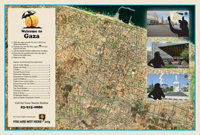
You Are Not Here.org: Gaza - Tel Aviv
Marked Up City: You Are Not Here.org: Gaza - Tel Aviv :: Hosted and introduced by Nat Muller (NL) :: Saturday 14 April 2007, 11:00 – 13:30 hrs :: Location: V2_Studio :: Entrance: € 7,50 :: LIVE STREAM (REALVIDEO) - 14 april, 11:00-13:30 (Clicking on the above link before the indicated time will result in an error message!) This live stream can be viewed with the free RealPlayer.
Cities are more than their streets and squares, their commerce and inhabitants: they are part and parcel of a whole economy which brands and markets "the urban experience" to us as a commodity. Tourism is of course the latter's most logical instrument: more often than not we are sold a sugar-coated product, which discards the dynamics, frictions and population groups, which make up the city proper. Marked Up City dips into the belly of city branding and urban tourism... with a twist.
You Are Not Here.org (YANH), urban tourism mash-up project by artist Thomas Duc (US), media activist Mushon Zer-Aviv (IL/US), interaction designer Kati London (US) and new media hacker Dan Phiffer (US) :: Laila El-Haddad (PS/US), journalist and writer :: Merijn Oudenampsen (NL), specialises in issues concerning flexibility of labour, precarity, gentrification, and city branding.
The SNACK & SURGE Brunches create a performative and gastronomic theatre of operations addressing political, technological and artistic questions relating to the poetics of power. We invite the DEAF audience to kick off their day pondering the aesthetics, actions and media of resistance and critique. Part hang-out, part culinary experiment, SNACK & SURGE intends to be a caress for the palate, an opener for the mind, and a rebelliously festive wake-up for the mood.
Rise and start your day deliciously: biting at the poetics of power!
Food by: anders eten.com
Posted by jo at 01:34 PM | Comments (0)
Time Based Text
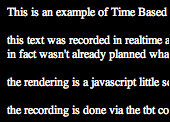
The gesture in computer art
"Thinking about gesture in art, people usually refer to choreography. If the topic is related to IT, instead, usability becomes the issue. But, what about gesture in computer art? Does it mean natural interaction or is it just a matter of performance? Certainly, a gesture is a way for emphasizing communication. Based on this concept, pioneers of net.art (or as we should better say 'net.art is dead') such as Jaromil and Jodi are exploring this area with a project called Time Based Text (TBT). TBT is a free software that records performances of written text and vehicle it as additional information. This is both a command line and console tool that records and playback keyboard strokes with a millisecond precision. As a command line tool it can record from standard input or playback to standard output (from and to a file or pipeline), so it can be interfaced with other software reproducing a sequence of actions.
As a console tool it offers a simple typing interface to record and playback text exactly as it is typed, including all corrections and hesitations. This'd be a unique possibility in electronic poetry, literature, and even daily email. The authors simply describe this process as: saving and reproducing every single action during the composition of a text let us vehicle emphasis in written communication. But, this 'recorded' gesture is then a new time-based medium." Valentina Culatti, Neural.
Posted by jo at 12:23 PM | Comments (0)
Mladen Bizumic: How If – A Translation in III Acts
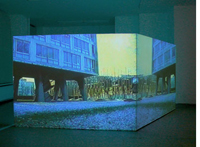
A 'Spatial Opera'
Mladen Bizumic: How If – A Translation in III Acts :: 29 March – 28 April 2007 :: Finissage April 27, 19.00 :: PROGRAM: initiative for art + architectural collaborations, Invalidenstrasse 115, D-10115 Berlin :: t: +49 (0)30 39509318 :: in collaboration with Künstlerhaus Bethanien.
PROGRAM – initiative for art + architectural collaborations presents ACT III of the exhibition How If – A Translation in III Acts by New Zealand artist Mladen Bizumic. Bizumic's first solo exhibition in Germany is structured as a ‘spatial opera’ in which he explores the facets of contemporary geopolitics in relation to representations of architecture. In each of the piece’s three acts, we find the contribution of other artists, musicians, theorists and in one instance, his mother. Act III is presented at PROGRAM, while ACT I & II form the installation at Künstlerhaus Bethanien.
Bizumic’s work is often based on the architecture, urban context and history of the space in which he is living. How If - A Translation in III Acts activates Berlin, his current abode, as the urban fabric comprising the space between Künstlerhaus Bethanien and PROGRAM.
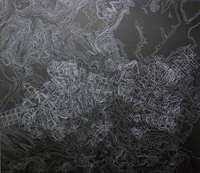
ACT III (at PROGRAM)
Since 2004 Bizumic has been working on a multi-channel video project called event.horizon.black.hole. An angled wall in the gallery acts as a screen for a pair of mirrored video projections. A video of the crumbling architecture of the UNESCO Headquarters in Paris is projected back-to-back with images of an avalanche on Mt. Cook, itself a UNESCO world heritage site in New Zealand. Mirrored along the bend in the wall, each pair of projections resembles an enormous, constantly morphing Rorschach blot. On this occasion, a multi-channel soundtrack has been added, bringing together ambient sounds taken from the Berlin Museum Island (also a world heritage site), with the flapping noises of flags outside the UN Headquarters in New York. The projections dematerialize the wall while the soundtrack organizes notions of nationality, geography, and the concept of a world heritage.
ACT I (at Künstlerhaus Bethanien)
Freud Museum (for her) 2006-2007 is a vitrine of fragments from buildings in Vienna. Two commissioned works accompany this: a piano piece composed by his Viennese girlfriend (a musician), and a ‘psychoanalytic poem’ written by his mother (a psychologist) which both articulate the personal dimensions embedded in the work. The material index of Vienna’s built environment becomes a self-consciously museological display – it’s materiality abstracted and questioned in turn by the music and poetry.
ACT II (at Künstlerhaus Bethanien)
Sister Cities of Berlin (Paris) 2007 is a video installation depicting streetlights seen through the glazed door of a building near the National Highway 7 in Paris. The distorted image through the glass is contextualized as a voice-over begins to tell a story of the Parisian suburb Le Kremlin-Bicetre, loosely based on an interview conducted by Bizumic with French artists Saadane Afif and Valerie Chartrain – themselves residents of the aforementioned building. The characters in the narrative are reduced in their description, but a counter point of complexity is provided by the collision of images, poetic verses and ambient sounds composed by MINIT.
Mladen Bizumic (born 1976, lives and works in Berlin) will present his work in the New Zealand Book at the Venice Biennale (2007). Notable exhibitions in the past include: Through the Picture at the 2nd Moscow Biennale (2007), Busan Biennale (2006), Hide-Tide, CAC, Vilnius and Zacheta National Art Museum, Warsaw (2006), Re: Modern, Künstlerhaus Vienna (2005), Fiji Biennale Pavilions, Govett-Brewster Art Gallery, New Plymouth (2003), Mladen Bizumic, ARTSPACE, Auckland (2002).
PROGRAM is a nonprofit project aimed at testing the disciplinary boundaries of architecture through collaborations with other fields. Initiated in 2006 by Carson Chan and Fotini Lazaridou-Hatzigoga, PROGRAM provides a discursive platform for artists, architects, critics and curators to explore ideas through exhibitions, performances, workshops, lectures, and residencies. PROGRAM intends to diversify the ways we understand and make architecture by engaging the discourse with emerging creative processes that activate the space between pure theoretical research, professional praxis and architecture's social role.
The exhibition is generously supported by Creative New Zealand and the New Zealand Embassy in Berlin.
opening hours:
Tuesday–Friday 14.00–19.00 hrs
Saturday 11.00–19:00 hrs
For further information please email info@programonline.de, or visit http://www.programonline.de
Posted by jo at 11:31 AM | Comments (0)
Turbulence Commission: The Simultaneous Translator
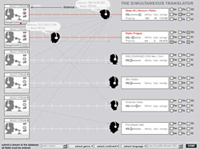
Live Performance on April 15
Turbulence Commission: The Simultaneous Translator by John Roach and Willy Whip [Requires Windows OS] LIVE PERFORMANCE: Sunday April 15; 12:00 PM EST to 3:00 PM EST
The Simultaneous Translator (SimTrans) is a Windows based audio interface that enables anyone to load audio streams and manipulate them in real time on the Internet. SimTrans makes the delays and fluctuations of the Internet visible and audible. The Internet becomes your collaborator as you create your mix, and the instability you usually try to avoid becomes a tool for creation. Distance and delay are manifest within the interface numerically and as a series of sliding heads; there is also a link to Google Earth where you can watch the dynamic flight of data travel between yourself and the audio source.
“SimTrans” is a 2007 commission of New Radio and Performing Arts, Inc., (aka Ether-Ore) for its Turbulence web site. It was made possible with funding from the Murray G. and Beatrice H. Sherman Charitable Trust.
THE PERFORMANCE: The Simultaneous Translator grew out of the artists’ live networked performance project "Simultaneous Translation," in which the delays of the internet are used to dynamically effect the live performances of geographically distant artists.
The performance will take place from 12:00 PM EST to 3:00 PM EST on Sunday April 15. Log on via http://turbulence.org/Works/simtrans.
Participants: Greg Davis (USA), Kenneth Goldsmith (USA), John Hudak (USA), Keyman (France), Lawrence Li (China), Mice69 (France), Miguel Ramos (Spain), Joe Reinsel (USA), John Roach (USA) and Willy Whip (France).
BIOGRAPHIES
JOHN ROACH doesn't consider himself an installation artist, a sound artist, or a sculptor, but prefers to think of himself as a nomad, touching down in whatever place is most hospitable to his ideas. Recent projects have been an installation at the 2B Gallery in Budapest, Hungary; a collaborative performance with objects and video at the Saint Stephen Museum in Szekesfehervar, Hungary; and a web video project called Sweet Music. He continues to work with Willy Whip on their long-standing live networked performance project Simultaneous Translation.
WILLY WHIP is a designer and teacher in hypermedia interactivity. Outside his institutional work he likes to produce mashups that fertilize his own secret garden. This personal research and development leads him on a quest for hybrids: connect this information to that information; grow new contents; release new senses. Recent activity includes projects with the artists Anika Mignotte, Reynald Drouhin, and Du Zhenjun.
Posted by jo at 09:20 AM | Comments (0)
April 09, 2007
Urban Interface | Berlin (Olso)
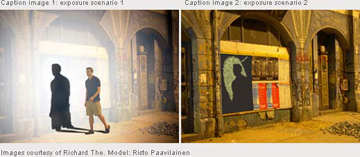
Interspaces of Public/Private Urban Space
Urban Interface Berlin :: A symposium, exhibition and curatorial research project exploring the interspaces between public and private urban space :: April 15 to May 6, 2007 :: Berlin and Oslo :: Some of the works are:
Exposure, by Jussi Ängeslevä (FI) and Richard The (DE), is a spatial art installation combining smart materials, simple sensor electronics and poster design to weave micro narratives for the unsuspecting public as they navigate through the urban landscape. An array of unobtrusive, monochromatic posters is arranged along a segment of a passageway. Adjacent to the individual posters a light gate is watching when a pedestrian passes by the poster. The light gate is connected to a tele-objective camera flash and triggers it, casting the person’s shadow momentarily on the poster. The poster, being covered with fluorescent ink, captures the shadows and retains the glowing silhouette, becoming an integrated element of the poster’s graphics which gradually fade away. The work can be seen as a commentary and counter-reaction to the established disempowerment of the individual. Above and beyond the exhausted Big Brother discourse, Exposure takes a stand also on the new emergent "Participatory Panopticon", or "Little Brother", the ever present prying eye of the neighbours’ ubiquitous camera equipped digital device.
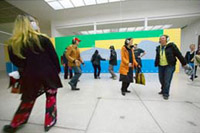
The project series Mitting operates at the interface between the sociologically and culturally different boroughs of Mitte and Wedding. For two days, the area that has been defined for the exhibition acts as a space for actions and as a starting point for mobile and stationary events. Oliver Hangl puts on two “Secret Tours” through public and private spaces that bring the coexistence of these parallel cultures to awareness. The participants, equipped with two-channel wireless headsets that enable them to choose between two alternative streams of information presented by the guides and musical liveacts, will be led through the different areas by two tour guides as well as musicians, actors, artists, DJs and a technical crew. Statements from pedestrians and local residents will flow into the liveact audio streams.
Mitting separates levels of perception while isolating the participants. On the streets, in warehouses, flats, and wherever the groups enter, they appear mute to residents and passers-by. Because of the dialogue that is sent inward through headphones, the action bears a subversive potential. But the participants should also be alert to when reality turns suddenly into fiction.
Oliver Hangl declares spaces, participants and watchers an open field of imagination, an audiovisual energy field that oscillates between performance, demo-protest and communication experiment… „Remember, that it’s all in your head!“ (Gorillaz)
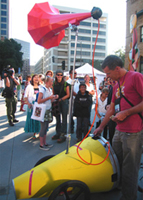
Daniel Jolliffe presents the project Berliner Stimmen in the context of urban interface | berlin. His work is a mixture of mobile sculpture and performance that examines the participatory moment. Visually, Berliner Stimmen is a sculpture mounted behind a bicycle, but its main function is performative. Over a period of three weeks, Jolliffe will cycle through the borough of Mitte, Wedding and Gesundbrunnen three times a week. While he is travelling, the loudspeaker broadcasts previously recorded one-minute calls. It is possible for each caller to have his message broadcast in the public space. The past realisations of the project under the name of One Free Minute in San José and Vancouver have shown that the callers use this public platform for different reasons. The spectrum of the recorded messages includes private statements and stories as well as commercial announcements and political speeches. In times when governments and public agencies are increasingly vigilant of who is saying what and where, citizens and activists can express their opinions in Berliner Stimmen freely and without fear of repression.
Also on exhibit: Laura Beloff's Head; Zone-out of Vision.
ABOUT urban interface | berlin
The project deals with the changing notion of private and public space that occurs due to, particularly, the everyday use of communication technologies. The artworks in the context of urban interface convey the idea of public space as an accessible and contributive sphere and call attention to a more sensitive engagement with the private, physical and digital spheres.
The works are developed for individual spaces by participating artists and if possible realised in cooperation with hosts. Hosts can be private individuals as well as companies, which then communicate the artworks out of their private spaces into the public. Private becomes public, public becomes private. Art space intermixes with urban space.
In responding to selected public and semi-public sites and their inherent qualities, the artworks will become focal points of the shifting conceptions of private and public space. Being often immaterial and digital and located at the difficult-to-define boundaries of private and public space, the artworks challenge all users – perceivers, organisers and the local authorities to formulate and discuss their individual understanding of those spaces. At the same time, the dispersed and temporary nature of the artworks challenges the formula of exhibitions in public space.
This website is conceived as an archive and contributive forum which ideally could serve as a knowledge platform for other art projects dealing with or happening in public space. To that end, relevant processes between the involved parties such as artists, sponsors, organisers and the city administration will be published on this website. Hence this website can be understood as another interface between private and public, theory and practice.
The thematic discourse is extended to presentations and panels accompanying the exhibitions
Posted by jo at 05:27 PM | Comments (0)
March 28, 2007
WindMaker
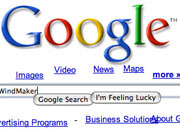
Feel the Breeze
WindMaker is an ambient weather widget that applies the current wind conditions to your Web site. First, it uses a United States ZIP Code to grab local conditions from the Yahoo Weather RSS feed. Second, it parses your Web site into individual pieces such as text blocks and images. Finally, WindMaker sets the pieces in motion according to the strength of the wind.
Add WindMaker to your own Web site in one step. Insert the following JavaScript into your HTML just before your closing BODY tag. WindMaker does the rest. [via]
Posted by jo at 03:59 PM | Comments (0)
March 27, 2007
Institute for Infinitely Small Things
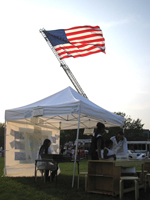
Transferring Patriotism
Transferring Patriotism is a new work by the Institute for Infinitely Small Things now on sale at Evolution de l'Art Gallery. The Institute is selling its patriotism to any interested buyers. Once the sale is made, the full transfer of our patriotism to you will occur in the following way:
Two members of the Institute will fly to your country. We will meet you and a witness from your country at the border between your country and the US Embassy or Consulate. We will set up a table with four chairs. We will sit at half of the table on American territory and you will sit at half of the table on your country's territory. We will then proceed to share an American beer. Then we will share a drink from your country. We will repeat those drinks until we are all drunk. At that point, the transfer of patriotism will be complete.
Price: Cost of two plane tickets from Boston, MA, USA, to your country plus additional logistic costs. Sale handled via Evolution de l'Art Gallery.
The gallery Evolution de l’Art arises from a collaboration between SPACE (Juraj Carny, Diana Majdakova and Lydia Pribisova) and Cesare Pietroiusti. Evolution de l’Art is a gallery for contemporary art which only sells artworks that are immaterial, with no physical residue, and it does not release certificates of authenticity, nor statements or receipts. EdlA will represent, on a non-exclusive basis, artists whose artwork is, at least in the case of some specific projects, alien from any physical-material component. Beyond this condition, there will not be any other limitation or requisite for represented artists in terms of medium or technique.
Posted by jo at 10:20 AM | Comments (0)
March 26, 2007
An Event for a Conversation

'fancy a skype chat?'
An Event for a Conversation celebrates social networking and is designed to explore the social and technological aspects of communication through experimental events and conceptual research. This experimental and research process will develop towards, and inform the final interactive and relational ‘Event for a Conversation’.
The first event ‘fancy a skype chat?’ took place yesterday (March 25); ‘fancy a skype chat?’ invited people to an online, social event hosted by the artist Rebecca Gamble. Gamble's goal was to re-create the pub-like environment of informal chat around a table over a drink, by inviting people to ‘bring their own’, ‘log on’ and start chatting over Skype. Through this event, the artist hoped to connect people and their different environments through online conversation, in a virtual environment. It was documented through the texts of the ‘Group Chat’ on Skype, from screen grab images of the artists’ desktop at 10-minute intervals, and in other ways the participants added to it. The conversations themselves were not recorded.
Posted by jo at 10:24 AM | Comments (0)
March 25, 2007
1001 nights cast
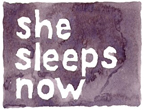
TIME CHANGES
1001 nights cast: Daylight Savings ended in Australia and started in Europe on Sunday March 25. Performance # 644 on March 26 is at 6pm from Sydney, that is: 4pm in Perth, Hong Kong and Tokyo; 9am in London; 10am in Madrid, Paris and Berlin; 11am in Beirut, Jerusalem and Istanbul; 4am in New York, Toronto and Bogota; 1am in Los Angeles. And then will get earlier with each passing day. If in doubt, wait for the "Performance # xxxx begins in XX:xx hrs/mins" countdown clock on the Today Now page.
New writers always invited to contribute. Story submission deadline is always 3 hrs before performance time (sunset).
Posted by jo at 05:23 PM | Comments (0)
New Media Art in a Control Society

Transcript from a Performance
Adam Trowbridge: New Media Art in a Control Society :: Transcript from Performance :: The Hunter Museum of American Art, Chattanooga, TN, USA
March 22, 2007 :: video stills here
As noted in the transcript, the majority of the statements read were not original and instead shamelessly stolen (edited and unedited) from various sources: theoretical texts, artists' statements, manifestos and paranoid rambling. Transcript:
This is...a performance and new media art...or maybe not. [video begins] [text below is read]
- - Gilles Deleuze said "Maybe speech and communication have been corrupted. They're thoroughly permeated by money and not by accident but by their very nature. We've got to hijack speech. Creating has always been something different from communicating. The key thing may be to create vacuoles of non-communication, circuit breakers, so we can elude control." End quote.
- - The phrase "new media art" is pointless.
- - The selection of medium is not the selection of a wardrobe for an idea. We are well past ideas and communication. Medium should be selected like legal and illicit pharmaceuticals: where do you want to go today?
- - What is a digital painting? Idiotic.
- - Contemporary art is both scattered and networked, always in motion. Medium, if anything, is a measure of speed and distribution. Is the texture of an oil painting that different from that of flypaper? Video is faster and shedding the weight of the poetic yet precious medium of film. Photography is a film still. Internet-based art is faster but still flails, lashed down by too many examples of bad information design masquerading as art.
- - THEY create DELIRIOUS RULES and sell you free access to their BACKSTAGE if you follow these sick rules. YOU KNOW IT.
- - Deleuze and Guattari's rhizome has been falsely represented as a metaphor for a network and for networked art. Deleuze and Guattari did not deal in metaphors.
- - Rhizomatic action is a force relationship in which power is distributed then scattered before it can begin to collect. This is not a metaphorical description but a plan of action.
- - Over 650,000 Iraqi civilians were killed by military intervention in Iraq and we are here to discuss...what?
- - Images can shatter the old order leaving nothing the same as before.
- - All hoarding, speculation on art, must cease and be seen for what it is: usury and exploitation.
- - In the beginning, you enjoyed it. You were caught in the middle of the WAR between THEM and THE OTHER SIDE, and you were trying to help THEM win the war.
- - All true language is incomprehensible, like the chatter of a beggar's teeth.
- - Six billion worldwide population, all living, have a Computer God Containment Policy brain bank brain, a real brain in the brain bank cities on the far side of the moon we never see.
- - Marketing has become the center or the "soul" of the corporation. We are taught that corporations have a soul, which is the most terrifying news in the world.
- - Human beings are not fully conscious of their real life...usually groping in the dark...at every moment groups and individuals find themselves confronted with results they have not wished.
- - Control is short-term and has rapid rates of turnover, but is also continuous and without limit.
- - New media art involves people who make watering plants more complex than it needs to be by using cell phones that call the Internet when the plants need water.
- - If you can talk about it, why paint it?
- - The Dia: Beacon is a tomb for the last gasp of studio art, let it be a monument and move on.
- - Man and machines can make symbiotic art.
- - Psychogeography: The study of the precise effects of geographical setting, consciously managed or not, acting directly on the mood and behavior of the individual.
- - Inevitability of gradualness. Usually, in a few years, you are made string bean thin or grotesquely deformed, crippled and ugly, or even made one foot shorter or one foot taller, as the Computer God sees fit.
- - In the future we will have foreign genetic material in us as today we have mechanical and electronic implants. In other words, we will be transgenic. However, there's no excuse but marketing for purchasing a glowing rabbit.
- - Users of the world are presented with fresh, owned content every day. We have the technology, the precedents, and the duty to make new art out of this owned content.
- - A lot of people say that new media is revolutionary. They say the net is subversive. But how subversive can you be in an exclusive club where it costs $1,000 for a computer and $50 a month to connect to the Internet.
- - The main function of Art is to distinguish rich people from poorer people.
- - Many young people strangely boast of being "motivated"; we re-request apprenticeships and permanent training. It's up to us to discover what we're being made to serve, just as our elders discovered, not without difficulty, the ultimate end of the disciplines.
- - Personal expression and human and artist centrality can be abandoned.
- - Complex machines are an emergent life form in the masturbatory fantasies of those siding with control. I distrust transhumanists but I want to be friends with a computer.
- - Any moralistic or spiritual pretension or representation purposes for art must be abandoned.
- - Primarily, based on your lifelong Frankenstein Radio Controls, especially your Eyesight TV, sight and sound recorded by your brain, your moon brain of the Computer God activates your Frankenstein threshold brainwash radio lifelong, inculcating conformist propaganda, even frightening you and mixing you up and the usual, "Don't worry about it."
- - Professionalism in the arts (and the accompanying stratification of skills) must be abandoned in favor of a progressive (class-less) artistry of both a personal and collective nature.
- - Over the last decades, using positions of power in your STAGE-WORLD reality, THEY introduced their key words and also their sick DREAMWORLD- TO-SELL key ideas in every aspect of culture in the STAGE WORLD society where you live : songs, movies, humor, even propaganda.
- - Derive: An experimental mode of behavior linked to the conditions of urban society: a technique for hastily passing through varied environments.
- - The economic and cultural exploitation of the artist has reached appalling proportions. The individual and/or collective artist, whose work is plagiarized as commercial 'technique', or exported as cultural commodity, has little control over these conditions.
- - Consciousness is not exclusively restricted to the brain. Human bodies have no boundaries.
- - The artist must be concerned with the moral relationship that his/her endeavors have to the institutions within which he/she expresses his/her work.
- - The majority of what I've read has been shamelessly stolen from various sources: theoretical texts, artists' statements, manifestos and paranoid rambling. They stand as a collection of connections and disjunctions. I am, we are, a manner of speaking.
- - Art is not knowledge.
- - Art does not communicate.
- - There is nothing here for you.
- - Gilles Deleuze said that new situations could "...at first express new freedom, but they could participate as well in mechanisms of control that are equal to the harshest of confinements. There is no need to fear or hope, but only to look for new weapons".
[via nettime]
Posted by jo at 04:12 PM | Comments (0)
March 23, 2007
Interview with Gazira Babeli by Tilman Baumgärtel
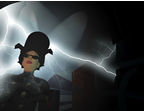
My body can walk barefoot, but my avatar needs Prada shoes
Tilman Baumgärtel: Is Gazira Babeli your real name? If not, tell us a bit about your existence outside of SL.
Gazira Babeli: Yes, it's my real name in Second Life but most of people call me Gaz'. Outside SL, my existence is not so different from yours... drinking, eating, sleeping, meeting people, looking at a computer monitor and working the least possible.
Tilman Baumgärtel: You mess around with the code in Second Life. Can you give me a non-technical description how you insert your code into the system?
Gazira Babeli: Codes are just instructions, imperative verbs. An example: PUSH-IT-FAR... a box, a Museum, a Church, an avatar-person... or an entire avatar audience. The result could be spectacular and/or create social troubles. I found it easier to call these instructions "performances" or "actions". It makes sense in SL frame-space 'cause the results look more like a sensible real space than a computer output.
Tilman Baumgärtel: Why do it at all? Isn't Second Life fun enough as an imitation of the real?
Gazira Babeli: Yes, imitation is fun, but it's only the "background color" of every possible behavior. I'm exploring that.
Tilman Baumgärtel: Why intervene into Second Life, if there is a whole world out there. What is difference between a performance in SL and in the real world?
Gazira Babeli: I would say that the term "whole world" itself is more or less virtual. There's a whole world of people working in call-centers and one hand-making shoes. There's a whole world considering itself privileged because it can have access to information and spends a great deal of its life idling on Office or on a Web Browser. We keep forgetting that what we call Real Life has been a virtual frame for a long time. Second Life offers the chance to build and deconstruct this space in the form of a theatre performance. What's the difference? I'm trying to find out. For the moment I like to say: my body can walk barefoot, but my avatar needs Prada shoes.
Tilman Baumgärtel: Are you familar of the net.art of the 1990s, and is your work influenced by the likes of Jodi et al?
Gazira Babeli: COME.TO.HEAVEN actions are inspired by Ives Klein and JODI. Weird mix, don't ask me why. I also loved Alexei Shulgin 386DX shows and some extremely conceptual stuff by Florian Cramer. RTMark net.prankster projects was really weird. It has been a very meaningful scene. For me net.art is like a wild middle-age of Internet.. Second Life seems to offer a Renaissance Perspective.
Tilman Baumgärtel: Do you create any work outside of SL? Have you shown your work in the real world and if yes how?
Gazira Babeli: This is an interesting problem. First: I cant get out of Second Life because I exist only thanks to Second Life. Two: I saved thousands of high-resolution images and videos that some people, in the physical world that u call RL, are willing to publish. An interesting solution would be the one I experienced with the PEAM festival. I simply offered the curator the digital images and a very detailed license with all the print specifications. At present Im finalizing the shooting of a movie which draws inspiration from "Simon of the Desert" by Bunuel and from the early Buster Keaton. The set is a portable desert, as big as 16 regions, and very likely the title is going to be "Gaz' of the Desert". I hope it will reach somehow physical world, because the only thing I really cant stand in SL is going to the movies. I find it very disturbing for an avatar who is already living in a film-like environment.
Tilman Baumgärtel: Did Linden labs approach you or even try to kick you out due to you actions, especially the "Grey Goo" performance? Or did the builders of the Virtua Art Center come down on you?
Gazira Babeli: During "Second Jesus", one of my first performances, I have been contacted by a Linden. I believe it only wanted to understand if my aim was to offend Christian beliefs; I did not want to offend anyone, of course. "Grey Goo" was a trivial trick, quite amazing but totally harmless. Media probably misunderstood some information, spreading the "grey goo bandits" panic. I do not believe Lindens want to interfere as "virtual cops", they have more substantial problems and aims. I think Lindens would prefer residents to solve their internal troubles instead of filing a "Report Abuse". The Artwork "DONT say" is the result of this consideration: it allows to register those words we consider abusive and when someone pronounces them is seized by a tornado and shaken up until he apologizes. The effect is very cartoon-like.. Wile E. Coyote and Road Runner. After "Singing Pizza" (the symbolically abusive installation in Ars Virtua), the director Rubaiyat Shatner wanted to talk to me, he was worried and amused. We became friends though maintaining different views on SL-Art. Most SL residents believe they can build only visible "objects", but the range of behaviours and the margins of freedom are wider than most people think.
Tilman Baumgärtel: Most of your works seem to focus on manipulation of the technology of SL rather than e.g. intervening into the social conventions. Why?
Gazira Babeli: It's strange.. some people asked me the same question reversed. From my point of view, we are talking of two elements which are complementary, not divisible. SL is a complex society and without a univocal final aim. It includes heterogeneous social forms and conventions. The social-symbolic exchange is generally based on a sort of parody of the consumer-oriented western world... in brief, gadgets on which to build up one's identity. This happens in a fairly anarchic and pacific way, thanks to a "dictatorship" of the technologic protocol, strictly defining properties and utilization concessions. Now we consider Google as a friend but even Google is a strange phantom-dictatorship on information. It this good or bad? Try to imagine internet without Google. Now, SL is a smaller environment compared to the Web, but I think it is a step ahead. My art consists in experimenting in an ironic and "pop" way the complementary and often contradictory aspects of a "whole world" which, despite being inhabited by "puppets", it hosts at least a million people. Real people.
Tilman Baumgärtel: A lot of people are put off exactly by the consumerist or capitalist leanings of SL, and - unlike you - not every body sees them as a satire, but rather as a confirmation of the status quo. Can you imagine a more utopian system (without money, without exchange value, without work...), and would you prefer it?
Gazira Babeli: We are mixing up two different issues: anthropological observation and ethical judgement. Of course Id love to login in a space called "First Utopia"! I can even imagine it but only from a technical point of view peer-to-peer protocols taught me a lot. Would I prefer it? I honestly cant answer to this question, first I should live in it a few months. Second Life, on the contrary, is an accomplished fact. If I like SL? I never said that and I dont want to say it. You talk about satire, I repeat parody. The distorted and conscious imitation of a model is something concerning theatre or literature.
If you have grandeur manias you can buy a castle and crown yourself King even if you are connected from a small flat in the suburbs; if you feel antisocial you can become a black box there are the headquarters of the French National Front and of the Anti National Front. The majority of the people I met are aware of this imitation-distortion the parody of what we call real life. ["My body can walk barefoot, but my avatar needs Prada shoes" Interview with Gazira Babeli by Tilman Baumgärtel via nettime] Related 1, 2.
Posted by jo at 01:18 PM | Comments (0)
March 20, 2007
Eva and Franco Mattes' re-enactment of Joseph Beuys'
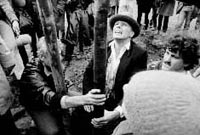
7000 Oaks
Eva and Franco Mattes (a.k.a. 0100101110101101.ORG) are reenacting Joseph Beuys' "7000 Oaks" in Second Life :: Beuys' project began on March 16, 1982, at Documenta 7, in Kassel. His plan called for the planting of seven thousand trees, each paired with a columnar basalt stone. Beuys intended the Kassel project to be the first stage in an ongoing scheme of tree planting to be extended throughout the world as part of a global mission to effect environmental and social change.
The Mattes planted the first virtual tree on March 16th, 2007, exactly 25 years after the original oak was planted. The 7000 basalt stones have been stacked on Mattes' island in Second Life: Cosmos Island. The diminishing pile of virtual stones will indicate the progress of the project, which will go on until all 7000 oaks and stones will be placed. Second Life inhabitants will have the chance to take part to the performance, placing stones and trees in their lands.
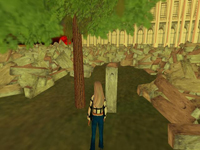
This work is part of Eva and Franco Mattes series of "Synthetic Performances": reenactment of historical performances inside synthetic worlds where body, space and time can be completely reinvented. The series started at the beginning of 2007 and will feature works by artists like Vito Acconci and Marina Abramovic.
"Joseph Beuys' 7000 Oaks" is commissioned by Centro de Arte Juan Ismael, Fuerteventura (Canary Islands, Spain), for the exhibition "Deambulatorios de una jornada, en el principio y el proyecto Tindaya", curated by Nilo Casares.
Posted by jo at 03:00 PM | Comments (0)
March 19, 2007
Logo.Hallucination

Pattern Recognition of Hidden Logos
After investigating on 'semantic capitalism' and 'taylorisation of speech' with the project 'Google Adwords', Christophe Bruno reflects on the economic dynamics of collective hallucination. According to the French net artist "The Web, specifically in its version 2.0, is an implementation of control strategies in writing." On the contrary, the image can't be easily interpreted by a machine remaining a hardly accessible territory. Therefore, he created Logo.Hallucination, a software based on neural image recognition that continuously monitors images on the Internet, to track pattern similarities with corporate logos. The idea is to use image recognition technologies to detect subliminal logos or emblems forms, hidden (mostly involuntarily) in the visual environment or whole images on the net. The 'found' images can be accessed through a weblog, with an argued comparison between the original picture and the (supposedly found) original brand logo.
Like Cayce Pollard, protagonist of William Gibson's 'Pattern recognition', Bruno investigates to find brand loyalty secret that would become every marketing research gold mine. Clearly here there's a massive amount of irony. Every time a hallucination is detected, an email is then sent to the image owner - if the owner is known, to inform him that the "automated monitoring spiderbot has detected a potential infringement of Intellectual Property Law." Logo.Hallucination confirms Bruno's theory on the alliance between the society of control and the Web 2.0 spectacle: media corporations cannot measure their messages real effects and hence they need an additional control structure, like Google and the same Web 2.0. The role of this panoptic web part, achievement of the society of control, is to scientifically analyze the message effect and observe its deviations. The resulting outcome will be sold back to media corporations, so to continuously optimize the whole process in loop." -- Valentina Culatti, Neural.
Posted by jo at 04:40 PM | Comments (0)
March 14, 2007
Franck Ancel's Triptych
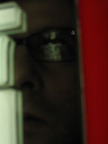
5/5 + 5C + 5G
5/5: In 2004, Franck Ancel completed a triptych on architecture, image and technology by projecting the words "Mobile Wireless Digital" onto the screen of the Montparnasse Tower in Paris. Today, under the title "5/5", he is projecting on the Théâtre de l’Agora à Evry, France his two projects "5C" and "5G", in connection with this line of research.
The trail presented here in the shape of a diptych challenges known and recognized limits, and the outdated boundaries of the past. These documents trace the use of a special form of GPS tracking based on a real experience, that of a separate journey, while also questioning virtuality in the age of world globalisation. Therefore, it is not about abandoning criticism of technological uses to technological uses of criticism. After all, it is through a person's very existence that the temptation to understand the space of his or her time arises, and this forms the focus of this presentation, in which a particular journey becomes an objective creation.
5 Continents (5C): Between 18:00 and 19:04 hours, Paris time, on Saturday 17 December 2005, the first artistic creation from an in-flight passenger plane took place. It was transmitted live over the Internet during a flight from Shanghai to Munich, at an altitude of 30,000 feet and at a speed of over 900 kilometres an hour. This live transmission at "X" moment was the culmination of a series of 5 communications "From Scenography to Planetary Network", for and on 5 Continents.The transmission was posted in real-time on our website, via a wifi satellite link relaying images and sound from the plane. This performance was made possible thanks to Lufthansa's offer to provide FlyNet with Boeing's in-flight online connectivity service, Connexion by Boeing.
This webcast makes a formal nod to the sleeper John Giorno, the poet of "Sleep", a legendary film for the Neo avant-garde art movement made by Andy Warhol in 1963, New York. This time round, a sleeper has left the Asian New York of tomorrow. This world first lasted 64 minutes. In the video recording 64 key words appeared in a combination of 12 interplays on five themes (five continents, colours, senses, elements, years), initiated with an eye to the forthcoming 2010 World Expo in China.
5 Guggenheims (5G): In 2006 we collected data in front of the 5 Guggenheim museums. The traces of this journey echo the possible virtual construction of a space on a planetary scale symbolised by these museums. The shift from a fluid virtual architecture to a constructed reality takes shape in the form of a 3D video animation created by Bryan Bey and a resin model created with 3D prototyping, made in collaboration with the IDO creation company from the elements we had gathered together. 5G is made up of photos and GPSb.
Posted by jo at 11:03 AM | Comments (0)
March 13, 2007
from a land down under (myspace)
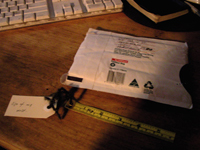
Being MTAA, Just for one Day...
Once upon a time, I made a site for MTAA on myspace. (Yeah, I know, I know.) Then, a person named “Penny” from Australia asked to be MTAA’s friend. So I, of course, said, “Yes”. Then she asked if I wanted to be part of a chain of email performances. So I, of course, said, “Yes”. (Yeah, I know, I know.) This is where it gets a bit complicated but stay with me. Penney made a list of performers. The person above MTAA name was to send us an artwork and the person below our name was to get an artwork. Now, the person above our name was Emily. Emily emailed that she thought that email was a bit impersonal (or at least I think that was what she thought), She asked if she could mail us some art. So I, of course, said, “Yes”. Today, in the mail, came Emily’s first project.
Wonderful right? If we get another one, I’ll post it on the blog as well.
Now, as for sending an artwork, the person we got was Penny (who, you’ll remember, also started the project.) What did we send her? We sent her a set of instructions for a performance on how to be “MTAA” that, if she completed and documented, would be the artwork. (Yeah, I know. I know.) Anyways, here is what we sent her:
Being MTAA, Just for one Day
To Be Performed by Penny Spankie
Dress in a black t-shirt, blue jeans, black boots, and a black belt. Perform any or all of the following artworks/ actions. Each performance attempted should be documented with 2 photographs or 2 short videos.
1. lying propped up in bed
2. checking your hair in a mirror
3. tossing a paper airplane out of a window
4. pointing at public sculpture
5. jumping over things on the street.
6. holding an open umbrella inside your home.
7. listening to music with headphones on.
8. drinking a beer not in a bar
So, guess what? She wrote back with this documentation of choice #2 (Checking your hair in the mirror)
Reply Video - for MTAA - Email Art - RCW
Reply Video - for MTAA - Email Art - RCW
Perfect.
So, If we get any more email myspace art, you’ll see it here. That’s all for now. Thanks Emily and Penney. [posted by M.River on MTAA-RR]
Posted by jo at 04:40 PM | Comments (0)
An American in Iran: Kristen Alvanson's
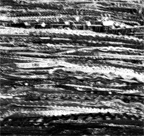
ARTISTRY OF NOTIONS AND COSMIC DRAPERY
The interactions of things, the undulation of entities in the space, the art of stitching events together, or in a word, cosmogenesis of all kinds requires abundant sewing work and notions artistry.
American Artist Kristen Alvanson, who relocated to Iran in 2006, has created a new website Artistry of Notions and Cosmic Drapery highlighting her current projects including Middle Eastern focused Maskh Project, Graveyards and Lumpen Orientalism as well as a section on the artist's forthcoming book entitled Lessons in Schizophrenia and her dESIRE Project.
Maskh Project: the connotation of the word maskh in Farsi is more than metamorphosis; it includes experiencing limits of one's identity or existence usually with the assistance of new independent vehicles of material and abstract articulation, as in the case of spirit possession. Maskh project is a visual compendium of drawings diagramming Alvanson's metamorphoses in the Middle East in the form of spells and maps.
Graveyards: project as a psycho-geographic exploration of Middle Eastern graveyards, entombments and post-mortem spaces escapes necromanticism or fascination with ruins by illustrating the cognition and encounters with space and time, and consequently the twofold of dwelling and thinking, in the Middle East.
Lumpen Orientalism: gathers the fragments of a lost civilization, the decaying parts of a once breathing animal. Named after a term suggested by China Miiville, Lumpen Orientalism is a photo-blog engendering an anomalous fascination with the Middle East in a similar way to the mongrel techniques of Gilles Deleuze, H. P. Lovecraft, Gaktan Clirambault and William Beckford for tackling this enigmatic monstrosity, the Middle East.
Lessons in Schizophrenia: is the artist's forthcoming book, based on real events which led her to leave the US for the Middle East in a cataclysmic process. It includes an introduction by the Iranian Philosopher Reza Negarestani entitled Epithemic.
The dESIRE Project: is an ongoing investigation on desire which includes artistic components; it is an attempt to reach concrete but not necessarily corporeal definitions of desire by tapping into its obscure formations. dESIRE Project is intertwined with the mathematics of natural numbers, countability / uncountability, pimp as a nomadic dissipater, stock market, legal contracts, intangibility and expendability of desires. Alvanson's dESIRES, both intangible and their photographic representations, are for sale on the Market section of her website.
Posted by jo at 01:29 PM | Comments (0)
Turbulence Artist’s Studio:
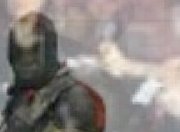
Michael Takeo Magruder
Turbulence Artist’s Studio: Continuum… by Michael Takeo Magruder :: Needs Flash Player 8+ plugin and stereo audio
Continuum… reflects upon the evolution of our collective history through the real-time analysis of global news information networks. As no event transpires in isolation, each moment of our existence is defined by the sum of an infinite number of interconnected occurrences. Given that no individual can absorb and process the totality of this information, how can we obtain an informed notion of the present?
"Continuum…" was commissioned by Oog online, a commentary and opinion platform for the online edition of De Volkskrant a major Dutch daily national newspaper.
Michael Takeo Magruder is an American artist based in the UK deploying New and Technological Media within Contemporary Art contexts. He is a long-standing member of King's Visualization Lab located in the Centre for Computing in the Humanities, King's College London. His artworks have been showcased in over 150 exhibitions and 30 countries. Artistically, his interests concern the simultaneous utilization and dissection of new technology as a means to explore the formal structures and conceptual paradigms of the digital realm. He seeks to create artworks in which there are no divisions between technologies, aesthetics, and concepts.
Posted by jo at 11:18 AM | Comments (0)
March 09, 2007
X-Com: An Auditive Mapping-Project
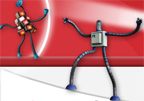
Soundscapes as Cultural Artifacts
X-Com: An Auditive Mapping-Project by MACHFELD (aka Sabine Maier & Michael Mastrototaro) :: In cooperation with: Cityvarsity and Trinity Session, Johannesburg, South Africa.
In times of global networking MACHFELD (Sabine Maier & Michael Mastrototaro) and the Trinity Session (Marcus Neustetter & Stephen Hobbs) use digital and analog devices to create an auditive communication-soundscape. This soundscape will be transformed to a crosscontinental sub-room in form of an art-radio broadcast. Supported by students of the Cityvarsity we will analyse the phenomen of inter- and transcontinental communication and we will find an answer for the question: How are soundscapes related to cultural facts?
This audio mapping will be the starting point of a Ö1 Kunstradio Broadcast which will air in autumn 2007.
MACHFELD, international Arts and Culture Society, Max Winter - Platz 21/1, A-1020 Vienna.
Posted by jo at 08:19 AM | Comments (0)
March 08, 2007
Independent Robotic Community
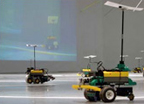
Social Network for Robots and Humans
"In a special edition of El Pais Digital reporting the Arco festival in 2001, the Spanish artist Ricardo Iglesias, one of the net art pioneers in his country, said that nothing or almost nothing ("only cliché") can be said about net art in five or six lines. However he mentioned a series of isolated topics that interconnected, related to each other, that'd really express net art: the network, the global and decentralized communication, interactivity, the virtual spaces, telepresence, the chaos theory, the active and interactive principle, the telematic interfaces, the post-biological culture, the hypertextual perspective, on line-chat, the rhizome image and the state of uncertainty.
His latest artwork, Independent Robotic Community, is a sum of all of the above. Developed with Gerald Kogler the project focuses on new forms of interaction between robots and humans on two levels.The first one features a community of 20 small robots divided in two groups. Each group has a primary level of socialization and a series of sounds conforming with a single vocabulary. Each robot's initial state consists of a very simple movement within a delimitated spatial environment. When it comes across other robots, it swaps data about its state with sounds and increases its degree of socialization and the complexity of its movements. On a second level humans can interact with robots using mobile phones and Internet, communicating with them in real time and further influencing the socialization process within the independent groups. The result is an original visual representation of a social network that includes both the subjective point of view of a spy camera and the graphic display of social statistics. As to confirm that net art is the art of networking." Valentina Culatti, Neural.
Posted by jo at 08:48 AM | Comments (0)
March 07, 2007
‘If the route’: The Great Learning of London

[A Taxi Opera]
‘If the route’: The Great Learning of London [A Taxi Opera] :: PerformanceStudio Voltaire :: Friday 9th March at 7.30pm :: The radio works: 104.4 Resonance Fm, Wednesdays 9pm 14th of March - 25th April 2007. More times below.
A collaboration between artist Beatrice Gibson and musician Jamie McCarthy, ‘If the Route:’ The Great Learning of London is a live performance and radio work in seven parts based on The Knowledge (the infamous London cabbie navigation system and mnemonic device students must master in order to become licensed cabbies). The Performance: The live performance of the 'if the route' has been developed collaboratively with 10 students from Knowledge Point and four improvising string players. A complex and fascinating mathematics of the everyday, The Knowledge involves learning 320 routes or runs mapped within a six-mile radius of Charing Cross. Traveling approximately 26,000 miles across the city on Honda C90's, knowledge students memorize a total of 30,000 streets. ‘Calling over’ entails that after the completion of the days run[s], students must call them out, reciting them out loud. Partners form to call over runs to one another, using recital and repetition as a means to remember the city.
Knowledge Point on Caledonian road, one of several taxi universities students may attend and whose curriculum includes a series of mnemonic devices to aid in their endeavor, is filled with pairs of men and increasingly the odd woman aurally reciting sets of directions to one another. Entering it is to be surrounded by the city fragmented and auralized into sets of sentences and street names, a veritable symphony performing the city as text .
Using the technique of calling over as its principle sound source, the performance of ‘if the route’ celebrates and elaborates this formidable system and poetic by re-contextualizing it within in the space of the gallery. Modeled on paragraph seven of Cardew's original score, Gibson and McCarthy's compositional structure emphasizes the practice of calling over as an ongoing process of repetition, memorization, rehearsal and navigation, articulated in a networked and non heirarchical manner.
The Score
‘If the Route’ takes it title from The Great Learning, the well known score by the radical and experimental 60’s composer and musician Cornelius Cardew. Informed by similar developments and ideals in the Fluxus movement and realized around the same period, Cardew’s work was rooted in belief of the democratic potential of music as a social platform, his score’s often intended for implementation by untrained musician-performers. Cardew’s version of the Great Learning was a score in seven paragraphs, rooted in and acoustically generated by the Confucian text of the same name. Playing on the title of ‘the great learning’ as it relates to The Knowledge and its own system of learning, and borrowing from the methodology, structure and political intent of Cardew’s score, Gibson and McCarthy have used both aural and non aural research into the knowledge as the generative principle behind composition. The score for 'if the route' provides the basis for both realization of live perfo rmance and the radio works.
The Radio Works
Mirroring the seven paragraphs of Cardew’s score, the radio piece comprises seven parts and takes place over seven weeks. In keeping with the spirit of Cardew and the political gesture of experimental composition in general, seven practitioners from varying fields and disciplines have been commissioned by Gibson and McCarthy to use and translate the score for radio according to their own personal and varying interpretations.
Participants include; artist and architect Celine Condorelli, artist Beatrice Gibson, musician and composer Kaffe Matthews, musician Jamie McCarthy, artist and writer, Tom McCarthy, poet and cabbie, Simon Phillips, and architect and theorist, Eyal Weizman in collaboration with Peter Mörtenböck & Helge Mooshammer (Networked Cultures)
Wednesday 14th March 9pm Beatrice Gibson and Jamie McCarthy
Wednesday 21st March 9pm Celine Condorelli
Wednesday 28th March 9pm Simon Phillips
Wednesday 04th April 9pm Eyal Weizman in collaboration with Peter Mörtenböck & Helge Mooshammer (Networked Cultures)
Wednesday 11th April 9pm Tom McCarthy (International Necronautical Society)
Wednesday 18th April 9pm Kaffe Matthews
Wednesday 25th April 9pm Beatrice Gibson and Jamie McCarthy
'If the Route:' The Great Learning of London is generously supported by Arts Council England. Partnered by Studio Voltaire and Resonance FM.
With special thanks to London Contemporary Dance School at The Place.
Posted by jo at 11:43 AM | Comments (0)
NeuroZappingFolks

Santiago Ortiz
LX 2.0: Contemporary Online Experiments: NeuroZappingFolks is a non-linear zapping through the Internet, a path leading to the inside of a web of relations, a web that can be explored from one tag to a site, to another tag, to another site... from word to image to word to image. NeuroZappingFolks is then the simulation of a brain lost in the web (lost between servers, but also lost in Internet's double identity: word and image).
Santiago Ortiz was born in Bogota, Colombia, in 1975. Artist, mathematician and a researcher on art, science and representational spaces, he has been exploring the development of shared spaces for different kinds of knowledge. Ortiz has been using communication, creative, and literary techniques, as well as digital space and architecture ones. He works as a teacher, having lectured all over Spain, Portugal and Latin America. He is one of the co-founders of the Blank magazine and of the Bestiario company-collective. He lives in Lisbon and Barcelona.
Posted by jo at 10:12 AM | Comments (0)
March 06, 2007
REAL Alien Invasion of "Our Minutemen" at a Home Depot
Videos are posted on YouTube and the comment and rating interactions become a network performance. The video itself refers to and calls into question YouTube itself. Thanks to all the Minutemen's anti-clown comments, they made the video one of the most commented on videos on YouTube the day it was posted. More of our videos are in the "related" chunk of the YouTube page and here: http://circasd.org/clown-media.html. Related post >>
Posted by jo at 04:02 PM | Comments (0)
March 02, 2007
Email Clock
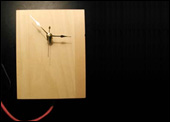
A networked clock that reads email
Like every person who spends most of his day in front of a computer, Tom Igoe is obsessed by his email. Researcher and Teacher at NYU Interactive Teleccommunications Program (ITP), he can't stop checking his inbox constantly. Unfortunately the evolution of the email programs, that alert the users as soon as a message comes in, is Email Clock feeding this obsession. This is why Igoe decided to invent a device that hopefully will allow him to get rid of the anxiety generated by the email flow. It's called Email Clock, it's a work in progress and consists in an analogic clock that reads email. This Newtworked Sculpture, as its author refers to it, would run at a normal pace when there is no email waiting , but every new kilobyte of email would drive it hyperactively forward. A java application living on an application server would check Tom's email accounts, noting when new data arrived. With each new message, the application would send the number of bytes to a microcontroller attached to the internet. The microcontroller would then move the clock. If this device is going to be successful in allevieting anxiety over the inbox is not certain. However it is a good example of what Physical Computing is, that is an approach to learning how humans communicate through computers that starts by considering how humans express themselves physically. Taking the body as a given, physical computing researchers have to learn how a computer converts the changes in energy given off by our bodies, in the form of heat, light, sound, and so forth, into changing electronic signals that it can read interpret. In this case the computer will hopefully absorb the bad vibes produced by anxiety - The irony that hides behind this idea makes the Email Clock a real Smile Machine." Valentina Culatti, Neural
Posted by jo at 11:14 AM | Comments (0)
February 27, 2007
Flavonoid
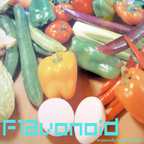
Translating 1st Life into 2nd Life
Speaking about 1st Life and 2nd Life connections, the Flavonoid project by Near-Future Laboratory colleague Julian Bleecker is of great interest. To put it shortly, it’s a mechanism for translating embodied, kinesthetic activity into 2nd Life actions.
A homebrew, Internet-enabled kinesthetic sensor, conceptually similar to a traditional pedometer, is being designed as a networked object that bridges the geophysical worlds (1st Life) and online digitally networked worlds (2nd Life). By providing data feeds about the kinesthetic activities of the person wearing Flavonoid, various embodiments representing that data can be created in 2nd Life, such as the appearance of online avatars, or that avatar’s wealth or capabilities.
So how does it work?
The Flavonoid Kinesthometer, a wearable networkable device, can transfer data as a networked object, providing simple data feeds of one’s movement over long periods of time. This data provides a channel of RSS information used as a baseline of information that can be translated to 2nd Life representations.
(…)
Flavonoid is envisioned as a platform, using standard, open feed technologies, for a variety of embodiments. The initial embodiment being a dynamic site “badge” — a small snippet of HTML that can be embedded on virtually any site, such as one’s blog or social networking home page.
The Flavonoid project proposal gives a more thorough description of what is aimed at here.
Why do I blog this? because this project takes the “Internet of Things” in a more interesting mode that what we’ve seen so far. By creating a framework for linking digital environments and the material world (”the leakage of digital networks into the physical world turns that world into a framework for a hybrid 1st Life/2nd Life”), it redefines the notion of embodiment in both environments.
This is an issue that interest me both to think about the future of ubiquitous applications and also as a user experience researcher. From a psychological point of view, there are intriguing questions to address here; especially regarding the overlap of spatial environments, their perception and how the interaction in each of them have an influence in the others. [blogged by nicolas on pasta and vinegar]
Posted by jo at 09:29 AM | Comments (0)
February 24, 2007
Do It With Others (DIWO): E-Mail-Art at NetBehaviour

A Collaborative Exhibition at HTTP Gallery, London
Hi DIWOists,
The Furtherfield crew has been discussing ways to get the most out of the co-curating session on Sunday when we will discuss and experiment with ways of exhibiting the contributions at HTTP gallery (don't forget the opening is next Thursday).
Other known contributors to this process in the gallery on Sunday are Frederik Lesage and james[at]jwm-art.net, others are welcome. Please check back with the list at 1.30 on Sunday for details of thewebcast and public chat room where you can join the discussion online. Until then you can view a gallery floor plan and tech spec here.
So here is a summary of our considerations, proposals and a number controversies for your feedback!
CONSIDERATIONS:
1) How to Survey the Contributed Materials for the Curation Process: There have been over 600 posts to NetBehaviour since the start of this project and we have 2-5pm on Sunday to review and discuss how to present contributions. The main ways that we have for looking at work is:
- through our mailboxes
- through an index of attachments that can be view browser here
Your Suggestions Please: We would like your suggestions for any other (reasonably straight forward) way to order materials for review.
2) Categories - How to Order and Discuss Materials.
It would be useful to have some broad themes or categories to discuss. Here are a couple of possible categories with examples (and these really are just examples) of what we mean.
- Threads - discussions, exchanges, actions and responses eg Sachiko Hayashi's 'The Other Half',
- Collaborations and remixes eg RandomLab's reblogging and remixing, Michael Szpakowski's remix of Thomson and Craighead's 'Additions' image
- Digital becomes Material eg Sim Gishel has sent a 'Will Work For Food' vehicle, brian[at]netartguy's currency could be laser-printed as actual currency, Other works proposed for print, Other works actually sent to HTTP etc
- Proposals/ Instructions- eg Ant Scott's installation proposal, Glorious Ninth's Love Potions
- Generative/machine Art- eg. Sim Gishel's data-mining, ARN's generative pngs
- Stand alone streams - movies, soundfiles and images eg images by Clive McCarthy, lem urtastic - movies by Lizzie Hughes, Alan Sondheim - mp3s by james[at]jwm-art.net
- Texts eg Janedepain's recent 'Poetic Terrorism and Guerrilla Art in the 21st Century' and technical discussions.
PROPOSALS:
1) We propose that the main projection consists of a Mailbox containing a DIWO archive for searching by gallery visitors. This would be organised into themed directories that would coincide with the categories listed above. PLEASE SUGGEST: more or other categories.
2) We propose that we highlight and exhibit some 5-8 works (made by individuals or collaboratively) in the form of objects, printouts, projections and sound. These would be up for discussion and debate from this point - to be decided on Sunday.
CONTROVERSIES:
1) The question of selection - how do we create an exhibition in a physical space that communicates the DIWO spirit?
- how do we highlight a selection of works?
- how do we stay true to the open principle of including all submissions?
2) Contextualisation
- do some works need contextualising in order to be accessible to gallery visitors eg should some works be displayed with titles, artist, date, materials, description of process etc?
- if so how, and who does it?
3) Is everything that has been posted to NetBehaviour since February 1st considered a submission to DIWO?
- including announcements and reblogging?
4) A number of people have proposed works in private emails to Marc or myself- should these be included under the rules of submission?
Whoever wants to contribute to the curation of this show- share your views here on the list or come along on Sunday ttp://www.http.uk.net/DIWOcurating.shtml
Let's DIWO!
: ))
Ruth [via netbehaviour]
Posted by jo at 12:01 PM | Comments (0)
February 22, 2007
Turbulence Spotlight
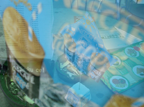
"Zeno Boundary" by Kevin Hamilton
Turbulence Spotlight: Zeno Boundary by Kevin Hamilton :: "Zeno Boundary" collects portraits of places regarded as public, created according to a prescribed photographic system. Images uploaded by contributors are dynamically animated into a looped sequence of pans and zooms through the space. The project originated in Spring 2006 as part of the Mobile Studios project, in cooperation with curators of the 13 Kubikov collective in Bratislava, Slovakia. After touring with Mobile Studios through Eastern Europe, the project continues as part of the 2007 Depauw Biennial Exhibition, in Greencastle, Indiana.
Kevin Hamilton currently teaches at the University of Illinois, Urbana-Champaign, where he is appointed to the Painting/Sculpture and New Media programs. Recent work has included co-organization of a symposium series about Walking, and the creation of interactive artworks for gallery and public settings. His scholarship includes research on manifestations of absence in contemporary and historical telecommunication technologies, and development of new methodologies for interdisciplinary collaboration. Kevin has exhibited or lectured at festivals and art institutions in Spain, Holland, Slovakia, Hungary, Canada, and the United States.
Posted by jo at 06:10 PM | Comments (0)
February 20, 2007
Botanicalls

The Plants Have Your Number
A small group of plants in a building in New York City is quietly exchanging information. Botanicalls--a project of a team of four students at the ITP program at NYU--allows thirsty plants to place phone calls for human help. When a plant on the botanicalls network needs a lot or a little water, it can call a human and ask for exactly what it needs. When humans phone the plants, the plants orient callers to their habits and characteristics, including how they like to be watered and cared for. Call 212.202.8348 to hear more about each of the plants.
Botanicalls opens a new channel of communication between plants and humans, in an effort to promote successful inter-species cohabitation and understanding. How? Plants call people about their needs. People can call the plants to understand them better. The project originally spawned from completely non-technical conversations about indoor container gardening and the air-filtration qualities of common houseplants. Our concern about bringing plants into the ITP community was their chance of survival-- high-paced technologists seldom have time to stop and smell the flowers, let alone water them. 'But, what if,' we wondered, 'the plants could call us and tell us what they needed when they needed it? If they assigned us tasks, would this alters or engages us,' and the project was born.
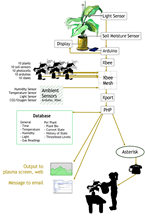
The Botanicalls project is fundamentally about communication between plants and people. We are empowering both by inventing new avenues of interaction. Plants that might otherwise be neglected are given the ability to call people and request assistance. People who are unsure of their ability to effectively care for growing things are given visual and aural clues.
The goals of this project:
1. Keep the plants alive through an interdependent relationship with co-habiting humans by translating the communication protocols of the plants (leaf habit, color of foliage, droop, etc) to more common human communication protocols (email, voice phone calls, digital visualizations, etc). More than keeping individual plants alive, we want to keep the system and project alive.
2. Make a connection between people and plants. Explore/enhance/create/visualize people's emotional connection to plants, the ways plants help humans, how caring for a shared resource can create sense of community, how natural life is a valuable counterpoint to our technical environment.
3. Gather data, create a complex and dynamic network, documentation for do-it-yourself style propagation of the project, record process. [via]
Posted by jo at 02:54 PM | Comments (0)
February 19, 2007
love_potion

DIY installations
love_potion is a distributed artwork that uses borage plants, seeds, scents, magic spells and networked technologies. All of its elements are featured on the glorious ninth website and can be woven together by us or by you, inside a gallery space or as DIY installations in our homes, gardens or public spaces.
You can join our invisible network of tactical gardeners by preparing your own love_potion made from borage, an herb that reputedly drives away sorrow, uplifts the spirits and when shared with others nurtures compassion and peace. Follow the potion recipe, find out how to grow your own borage, download the glorious ninth sound and visuals (or make your own) and put together a love_potion DIY installation.
Posted by jo at 05:54 PM | Comments (0)
February 15, 2007
A LEAP INTO THE VOID:
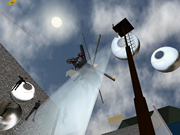
INTERVIEW WITH SECOND FRONT
"A LEAP INTO THE VOID: INTERVIEW WITH SECOND FRONT" by Domenico Quaranta; Commissioned by Rhizome.org.
At first sight they may appear like a pop hybrid between the X-men and the Four Horsemen of the Apocalypse, reviewed through the exaggerated and postmodern aesthetics of a virtual world such as Second Life. Quite the contrary. They are the first performance art group in Second Life: serious guys, practicing artists, curators and academics in real life, who decided to sound out the performative possibilities offered by a public virtual space that is growing at an impressive rate and being filled up by media agencies, stores, products, brands and inhabitants.
Second Front officially formed on November 23, 2006, gaining new members up right until the last few days. Now they are: Wirxli Flimflam aka Jeremy Owen Turner; Tea Chenille aka Tanya Skuce; Man Michinaga aka Patrick Lichty; Alise Iborg aka Penny Leong Browne; Tran Spire aka Doug Jarvis; Great Escape aka Scott Kildall; Lizsolo Mathilde aka Liz Pickard; Gazira Babeli aka CLASSIFIED. The attention of “in world” media comes fast, even if Second Front doesn't seem to work much on communication: its very first performances are set up, unannounced, in public spaces, for a little, unconscious audience. Then, almost immediately (January 5, 2007) comes the big intervention scored at Ars Virtua Gallery – the most notable contemporary art gallery in Second Life – for the opening of the visionary installation by the American artist John Craig Freeman (JC Fremont in Second Life). And may other performances...
Saying that Second Front is opening new paths in an unexplored territory is not rhetorical; and the loose, immodest and a little bit punkish way in which they do it is definitely unrhetorical. Their key feature is openness: openness and plurality of visions and perspectives, quite blatant in this interview (where almost each one of them decided to give his/her answer to the same question); they are open about a wide range of interventions, from reenactment to improvisation to code performing; open about different ways of shaping their work for the art audience, from prints to video to live broadcasting. They are growing up before our very eyes. And, rest assured, they hold good things in store.
DOMENICO QUARANTA: What is Second Front?
MAN MICHINAGA: Second Front is an international performance art group whose sole venue is the online world, Second Life. Second Front has members from Vancouver, St. Johns, Chicago, New Orleans, and Milan (to name a few), and works with numerous artists from around the world.
WIRXLI FLIMFLAM: As of January 14th, Second Front received official legitimacy from The Ava-Star tabloid (owned by Die Zeit in Germany) as the “first performance art group in Second Life”. This basically makes us the in-world equivalent of Fluxus – perhaps we could also be nicknamed “SLuxus”. This sudden rush from formation to celebrity has been quite fascinating since Second Front officially formed on November 23, 2006. As for a more detailed idea of what Second Front is all about, some people in Second Life might confuse us with a “performing arts” group rather than a “performance arts” group. We are not a circus act nor a dance or a theatre troupe although our artistic practice might superficially resemble those other performing acts at times.
TRAN SPIRE: Second Front is a network of performance interested artists exploring new and different environments, specifically the online 3d animated game world of Second Life. The members have come together through a myriad of personal relationships that existed during the early days of the group’s formation. This dynamic has morphed and mutated to include and involve variations on membership based on who is available and what presence can they perform with the others.
DQ: What does it mean, for you, to make performances in Second Life? Do you make rehearsals or do you prefer improvisation? Do you work with code or do you simply make what all other avatars do?
ALISE IBORG: So far we have done both. I think it depends on what kind of performance we wish to make. If it is better improvised we will probably do that. Each has its advantages and disadvantages. With prerecorded performances, we can fine tune and edit out things we don't want the audience to see. But with improvised performances, the work takes on a life of its own fueled by the creative energy of our players which really shows through. Also, many times, it's the surprises and unintended actions that make the work really come alive!
MAN MICHINAGA: Performing in Second Life gives Second Front the opportunity to work at scales they would not normally be able to work in if done in the physical world, and often has the opportunity to play to a wider audience. Our level of preparedness is dependent on the context for the event. In regards to whether we use code or not, Second Front is using a growing set of code-based interventions in its performances, thanks to our techno-doyen, Mama Gaz Babeli. In regards to our avatars, and props, almost nothing we use is ‘standard’, but some of us retain a few basic props like specific wings, or even old beginner’s props like hair as a sign of their past as newcomers to Second Life.
WIRXLI FLIMFLAM: When we rehearse and plan scripts for major public performance events, we still have to rely on individual improvisation. Nothing is ever entirely scripted so each member can do their “own thing” and have breathing room yet at the same time not be confused as to what they should be doing. We use scripts and rehearsals etc. as a guide to help the performing member to feel secure with the thematic manner with which they wish to improvise. This allows for group cohesion both on an optical and practical level.
GREAT ESCAPE: Second Life offers a unique space for performance. Without the normal constraints of the body ― the usual center of performance - and without a traditional audience, we can try and do things that have been previously thought to be impossible.
TRAN SPIRE: Performing in Second Life introduces variables and situations that complement and push further the understanding and comprehension that the members of the group share as a sense of what is real. By engaging the contrived space of an online gaming environment the challenges to perform are exaggerated by the parameters that persist as the interface with the context, the others members of the group, audiences and the templates of performance as an art medium. All of the tropes of performance are available to the group to use at will, hopefully to ends beyond the surface of what may appear evident around us.
GAZIRA BABELI: The real performance starts with login, the rest is performance record. The avatar just tries to forget being a code.
DQ: Do you prefer, for your performances, a public space or an art venue?
MAN MICHINAGA: Second Front chooses its venues to fit the context of the piece and the performance. In the case of Border Control, it was done at Ars Virtua, therefore the context was that of an art space. For our Breaking News and Abject Apocalypse pieces, these were context specific (the Reuters building and the Star over the Christmas Tree at the US’s NBC Rockefeller Plaza), and were performed in situ, with the product being the documentation.
WIRXLI FLIMLAM: Personally, I prefer a large and well-known public venue that is not usually within the context of high-art. So for example, IBM, Sears, American Apparel, Wired, and Reuters are all great examples of the kind of venues I think are really inspirational for me. Again, this is a personal preference and not necessarily reflective of Second Front as a group.
GREAT ESCAPE: It depends on the nature of the performance. An art venue is interesting because it brings Second Life into the physical space. I think it is ideal to broadcast the performance at an art venue while engaging a specific site in Second Life.
GAZIRA BABELI: In art venues you can be welcomed with cheers, in public spaces with bullets. I prefer the latter, as death doesn’t exist.
DQ: What kind of audience are you looking for? Do you think that a performance in Second Life could be displayed also in the real world?
MAN MICHINAGA: We are interested in reaching out to audiences who are interested in Second Life, and are curious of the possibilities that avatar-based performance art can have. Currently, Second Front is performing in hybrid venues, such as simultaneous events in its home, the BitFactory in Han Loso, and in physical spaces, like Vancouver’s Western Front, and Chicago’s Gallery 416. We do hope that in addition to our performances in Second Life, Second Front can have exhibitions of its performances, imagery, video, and ephemera in the physical as any and all possible media. We do not wish to be limited by media, and also wish to spread our curiosity to the widest possible audience.
GREAT ESCAPE: One thing I think we’re looking to do is to question the underlying assumptions of Second Life and what it means to be a virtual being in that space. A dominant trend in Second Life is to shop, make friends online and participate in a virtual economy. We think this can be a venue for unique artistic expression. In this way, anyone in Second Life is an appropriate audience. The possibilities for the space haven’t been fully explored as of yet and so I think people are much more receptive to performances that they might be in real life. Because it is so new, we can have a huge affect on people’s thinking.
TRAN SPIRE: I like the idea that the notion of an audience is being blurred by my own participation in this group. I am conscious of the fact that during all the stages of our performances from pre-production planning emails to after-party videos, I am both a performer with the group and an audience to the many things taking place. Anything that contributes to challenging this space and dichotomy between creator and audience I think is an interesting thing to pursue.
ALISE IBORG: We are looking for open-minded audiences who are not afraid to be part of the performance. And absolutely, Second Front could be displayed in the real world. The term that I use to describe this intervention into the real world, is 'virtual leakage'. I define virtual leakage as a two way exchange between the virtual and the real, through which new hybrid meanings can be made. Meaning-making can no longer operate within the hermetic cases of the real vs. virtual, but instead, becomes a back and forth exchange in which ideas migrate by osmosis. While we as Second Life avatars become more real in the virtual world, so too, that we as human inhabitants of the real world become more virtual. In my opinion, there is an amazing opportunity for Virtual Reality (VR) to stake its own territory but in order for VR to produce meaning that breaks from the real and from past artistic social practices, and to become a medium that produces singular works, the binary of the real vs virtual must be dismantled. Only then, will we be able to look at VR not as a simulation of the real, but as a simulation of itself.
GAZIRA BABELI: I prefer an unaware audience, an audience who does not necessarily have to understand what’s going on. Second Life is a real world.
DQ: Can you tell me something about the performances you had till now? How did your approach changed from the first one?
MAN MICHINAGA: Like any experimental troupe, we are always learning, and this affects our performance process. In addition, for Breaking News, many of us were only recently active, so our first performance was a really interesting experience. In short, Breaking News was an absurdist play on the 18th Century idea of the Town Crier, played out in the latest of 21st Century news facilities. By shouting out non-sequiteur, moment-to-moment headlines, Second Front hoped to perhaps jam the usual flow of information in the Reuters space, and possibly (ridiculously enough) barge into Adam Reuters’ office itself! On the second occasion, we did get an audience, as passers-by stopped and sat to listen to our tabloid headlines. Of course (we assume) they did not take us seriously. For Border Control, we knew we would have an audience, and that we would need to fill a fairly set period of time with detailed orchestration, we experimented at the BitFactory, rehearsing a series of vignettes that fit the context of JC Fremont & Rain Coalcliff’s Mexican Border installation. The first act, “Border Patrol” was a Dada-esque performance of the increasing militarization of the borders throughout North America. Following that, “Red Rover” was a play on the creation of a border in the traditional children’s game, but in our case the border decided to break down the audience instead of the other way around. Lastly, the final act, “Danger Room” was a piece that was intended to inspire a gestalt of danger and chaos in the age of Terror, but unexpectedly, chaos erupted and the sim actually crashed, whether by our actions or a combination of us and the audience isn’t really clear.
The approaches for the two pieces are quite different, as one is ad-hoc and the other following a set choreography and set. Are we changing? Of course; it wouldn’t be interesting if we weren’t. We learn new things each performance, and while certain things get easier, we then try to push the envelope harder in other areas.
TRAN SPIRE: I like to think that part of the script of each performance is written in the code of the place or environment in which it is situated. This lets the content be influenced by not only the art or non-art context but also by the different terrains that can exist in the real life as well as Second Life.
DQ: What do you think about art in Second Life? Is performance the only possible way to make art out there?
MAN MICHINAGA: Absolutely not. While Second Life has limitations like any medium, the members of Second Front are excited to see individuals working in many different forms of expression, such as live music, ‘painting’, sculpture, even fireworks and aerial ballet. While Second Life is relatively new, the possibilities for expression in virtual worlds has yet to be fully explored. That’s why Second Front was created!
WIRXLI FLIMFLAM: Context is extremely important here. Part of what makes Second Life itself is the fact that every moment seems like part of a performance. The fact that everything can be customizable in Second Life as well as the fact that just about any object can be wearable enhances my personal impression that performance art is the most “authentic” medium of Second Life in that Greenbergian sense.
GREAT ESCAPE: Right now, the Second Life galleries are mostly replicating paintings and sculpture, enhanced with visual effects in Second Life. These are what you’d expect with the first generation of art-making in any new medium. I think that what we’ve seen so far in Second Life is only a glimpse of what the future holds.
ALISE IBORG: Absolutely not. Second Life has offered the ability for anyone to create in VR which means that there is boundless possibilities for creativity and unprecedented work. In my opinion, VR is in itself a new medium but what is unique about VR is that through its technology, it can create work that can free itself from past art practices, though, there is also amazing avenues of creation by referencing precedent artists and works, For instance, our Last Supper performance appropriates one of the most canonic religious events by producing an event of binging and purging art itself!
GAZIRA BABELI: Second Life is a frame-space which can include all sorts of artistic perversion. I call it performance, anyway. But if you find a better definition, please let me know.
DQ. What is your relationship with your Real Life counterpart?
MAN MICHINAGA: There really is none. Patrick Lichty does not exist. Only I am real, and I control him. On a more serious note, the relationship between Man and Patrick is completely in line with my RL life. I am very sensitive to context, and the way I act in one context may be very different from another. In Second Life I feel that one has to be “Larger than Life”, and that's what Man is – He’s a big dark, figure – part angel, part rock star, part architect, part actor. That is, all the things that Second Life gives the individual more freedom to be if they so desire. I think that most of Second Front do this with great effectiveness and aplomb. My greatest concern is “the risk of the Artist”; that is, the bleed between worlds that I take by making potentially controversial art in Second Life. I think that Second Life is the first place where we can say that sometimes our action online DO matter, and this is very perplexing.
GREAT ESCAPE: I think that the avatar Great Escape occupies a strange nook in my subconscious. In many ways, Second Life operates as a fantastical dream state. We can fly, teleport and pick up houses and cars. My avatar has purple skin and fire out of his hair. When I go to sleep at night, images of the other Second Front members often fill me head. So for me, my avatar is embedded in my psyche, rather than an extension of my self.
WIRXLI FLIMFLAM: In a lot of ways, the relationship between Wirxli and Jeremy is much more closer than one might think from first seeing me. I did intentionally want to make Wirxli more of an alien than human or perhaps as a kind of first-generation “post-human”. I was also reading up about the stereotypical shaman in most cultures who is gender-ambiguous... so in this case, there is a slight departure here from my Real Life self.
TRAN SPIRE: I prefer to triangulate, dimensionally shift my relationship to each of the entities constituting themselves as versions of me. Therefore, I am waiting for the two to have a discussion and then ask me to join in on the conversation. I am interested to hear what they come up with and how they define themselves in regards to existence in a spatio-temporal plane, and whether they recognize each other.
GAZIRA BABELI: My body can walk barefoot, but my avatar needs shoes.
LINKS:
Second Front - http://slfront.blogspot.com/
Gazira Babeli - http://gazirababeli.com/
The BitFactory - http://patricklichty.com.thing.net/bitfactory.html
Ars Virtua Gallery - http://arsvirtua.com/
Imaging Place - http://imagingplace.net/
Domenico Quaranta is an Italian art critic and curator focused on New Media Art. He is the author of the book Net Art 1994 – 1998: La vicenda di Äda'web (Milan 2004) and, together with Matteo Bittanti, the editor of GameScenes. Art in the Age of Videogames (Milan 2006, http://www.gamescenes.org/). He curated several exhibitions in Italy, including: GameScenes (Turin 2005), Radical Software (Turin 2006), and Connessioni leggendarie. Net.art 1995 – 2005 (Milan, 2005). He teaches “Net art” at the Accademia di Brera in Milan.
Posted by jo at 10:55 AM | Comments (0)
February 08, 2007
1001 nights cast
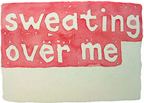
February 10: Performance #600
1001 nights cast will reach another milestone this Saturday: Performance #600 from Sydney on 10 February at 7.53pm which is: 5:53pm in Perth :: 8:53am in London :: 9:53am in Madrid, Paris and Berlin :: 11:53pm in Beirut, Jerusalem and Istanbul :: 3:53am in New York, Toronto and Bogota :: 12:53am in Los Angeles.
If you'd like to read any past stories please go to the new FASTER archives pages.
Since the half way mark was passed in early November, these new contributors have written for the project: Kristin Hannaford (Central Qld); Sam Twyford-Moore (Newcastle, NSW); Kate Richards (Sydney); Cecilia Berth (Sydney); Myo Sei Murphy (Sydney); Sam Grunhard (Japan); Folake Shoga (UK); Lesley Stern (San Diego); Adam Possamai (Sydney); Cathy Naden (Vancouver); Eileen Myles (San Diego); Mary Paterson (London); Colin W Gore (Sydney); M John Harrison (London); Beth Jackson (Brisbane); Josephine Starrs (Sydney).
The project will be moving again to the northern hemisphere, departing Sydney and arriving in Los Angeles on night 666 (April 17)! Stay tuned for time change updates.
Posted by jo at 06:30 PM | Comments (0)
February 07, 2007
0100101110101101.org's
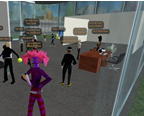
3 classic performances at Ars Virtua!
Chi5 Shenzhou sent me a TP (TelePort) to Ars Virtua and the audience as well as the critics and artists were already milling about while gathering their energy and nerves waiting for the retro-performance-bonanza to begin...
Hey there performance art fans!
Today was a special day in that the reknowned con-ceptual artists, Franco and Eva Mattes aka. 0100101110101101.org were back at Second Life's Ars Virtua for another arousing round of exhibitions! This time their retro-performance trinity was being broadcast (possibly projected) into a contemporary art museum in Trento (Italy) known as the Galleria Civica d'Arte Contemporanea.
For this day (evening in Italian time), Franco and Eva focused on remediating the classics of performance art. If you scroll down the blog a bit, you will realize that they remediated a previous performance remediation by myself and Great Escape... How Postmodern is that! More >> [blogged by Jeremy on Wirxli FlimFlam's Second Life Blog]
Posted by jo at 11:50 AM | Comments (0)
January 31, 2007
Hazardous:
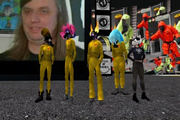
Second Front watches "Strange Culture"
This week we were invited to attend the premiere of "Strange Culture", an independent film by Lynn Hershman which discusses the infamous case of the arrest and pending trial of Steve Kurtz from the Critical Art Ensemble. The film will be shown at the Sundance Film Festival this week and has the distinction of being the first-ever feature film shown in Second Life.
It seemed altogether appropriate to have the first-ever performance art group in Second Life present at opening night (afternoon). We decided to don hazmat suits and gas masks to show our support for the defense in the ongoing Kurtz case. Second Front was unusually subdued in its urge to create a large-scale performance. We sat quietly and watched the film. The only sound besides the movie soundtrack was the constant clicking of the Second Life cameras as we documented this historic event.
Watching a movie in Second Life was totally weird. When you get to the movie theater, you hit the play movie control on your SL window. We're all watching the same film, but a different times! That seems like the most significant difference from a traditional cinema. Continue reading Hazardous: Second Front watches "Strange Culture" by Great Escape, Second Front.
Posted by jo at 01:00 PM | Comments (0)
January 30, 2007
Stay in Place

Telesharing
"Stay in Place reveals the resurgence of small complicities between two friends in a chat session while the screen acts as a mirror of oneself and the other, and makes us reflect about personal relationships in the presence of new technologies." -- Arlan Londoño, curator
STAY IN PLACE is a reflection of connection moment between two friends through a Chat by Internet. In this way, a teleshared space arises among them when both maintain a telematic talk by this channel. This scene is captured by the creator of this video, Sara Malinarich, with the intention to trap this spontaneous action in which both achieve to articulate a narration in the context of an unique and unrepeatable situation.
According to this video, the woman that is in the upper window is Maren Pimstein, who was located in Santiago of Chile at 14:32 hrs. of June 12 of the 2006; the another is Sara Malinarich, was in Cuenca, Spain at 19:32hrs of that same day.
Few years ago, both women were girlfriends on the University of Chile. Normally Maren and Sara used make up every time before going out. The day in which this action occurs, Sara had to leave again. For this reason she took her makeups again and she begins to be makeup herself, using the screen of the computer as a mirror and, as well as, an intangible backup for her friend that, from the another side, feel that this results very similar for her, finally, both knows that this is a renewal among them of their old complicities.
This work speaks us, not only of a concrete theme of human relationships, also of the simultaneous and multicultural settings produced by the connection by webcam across the distance. In the same way, meeting places and people on a digital backup. This technological backup admits new elements of composition, implying new narrative possibilities, but also present us anxieties such as where the action occurs? How many artworks have been produced on a simultaneous way during this action? Why these friends have been themselves motivated by their digital clones?
STAY IN PLACE is a proposal directed to the experimentation into the cyberculture land, oriented to the collaborative creation to distance through Internet. This artwork arises after the development of other projects proposed and directed by the author of this piece, related to the scenic arts and the new technologies, such as, "ORBITA. Festival for the teleshared actions by webcam" (2004-2005) and "INTACT. Interface for the teleshared action" (2005-2006).
The reflections considered in the implementation of ITCT at the service of the scenic arts, are basically the digitalization of the body and the transmission of data in real time, as well as the fusion of the scenes into one space of digital nature. STAY IN PLACE connects elements that are inherent to the action and the new technologies, such as: Light, speed, body, sound, communication, virtuality and digital code, de-materialization and data transformation. [via Rhizome]
Posted by jo at 02:51 PM | Comments (0)
January 24, 2007
Performing Second Life

Gaza Stripped
These past couple of months has been extremely productive for me... Not only was the performance-art group that I co-founded, Second Front formed within days of me actively creating my avatar (Second Front est. November 23, 2006) – this very same group was able to add Gazira Babeli to our roster almost exactly a month later. For those who do not know Gazira Babeli already, she is probably considered to be the very first dedicated performance artist in Second Life. Little is known about the RL life of Gazira Babeli. This is an avatar who likes to hermetically exist only within the virtual bubble-economy of Linden Labs. All the public knows for sure is that she hails from Milan, Italy and is a “code performer”.
You may have seen her at Ars Virtua slinging endless pans of singing pizzas or possibly had to scrape off the globs of both the nanotech industry’s and Linden Labs’ worst virtual nightmare, “grey goo”. If “Gaz’” (as she is known in SL) took a special liking to you, you may have had the privilege of being barfed on! If you have not already witnessed Babeli’s official performances and artistic interventions yet, you are very likely to be her unwitting “audience” sooner or later. Just make sure you do not offend her with any foul language as she is likely to send an intelligent yet sinister tornado after you in order to make you repent your impolite ways. http://www.gazirababeli.com/DONTsay.html)
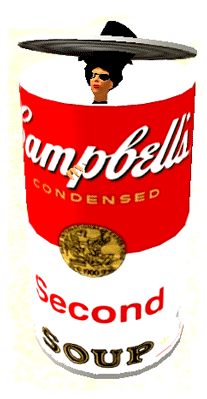
I interviewed Babeli about modernist White Cubes, contemporary Pop-(T)art(s), “Fluxus Hut” pizza toppings and the generally non-lucrative enterprise of performance art in Second Life...
Wirxli: The Second Life art-critic, Lythe Witte has written a previous article for SLatenight magazine called “The White Cube of the Virtual Art Space” where she questions whether or not the modernist white cube gallery model is worth reproducing in Second Life.
You might recall from a few days ago that we were all hanging out together feeling depressed and bored about the fact that even Second Life itself felt like one big and boring white cube.
"...My question is, what kind of methodology do you think is needed to make interesting art that can be comprehended within the unique context of Second Life?
Gazira: To realize an “artistic” or “aesthetic” experience, it requires a frame-space that is contemporarily physical and conceptual; it could be a frame, a museum, a computer network, a bedroom... or just a plain box 'dressed' like a RL art-galley. This referential "cube gallery" reminds me of the ironical artwork made by Marcel Duchamp called "Box in a valise" (Boîte-en-valise, 1942)
Although the "box gallery" could be a valid expression, I prefer thinking the whole SL environment as (a kind of) frame-space. It means that scripted and built objects, avatar-people and their behaviors become essentially parts of the artwork...a "world in a valise", in this case. :)
Wirxli: So there are parallels between the Second Life infrastructure as a kind of “artistic” framing device and the statements made by the early RL performance-art group, Fluxus where they blurred the boundaries between “art” and “life”?
Gazira: Sure, and it is very similar with the Linden's statement: "Your World. Your Imagination". We still don’t understand what “life” is and yet, we are talking about a second one. One life at a time, please! Maybe these lives (RL and SL) are not so different: symbolic abstractions and virtuality are common attributes.
Wirxli: Is there a difference in your mind between "performance art" in SL and "performing arts" (theater etc) in SL? Also, everyone in SL seems to be either intentionally or unintentionally an artist of some sort - in what way does a performance art group like Second Front stand out from the regular surreal, yet routine activities of SL residents?
Gazira: Yes, SL looks like a very democratic kind of theatre. Everyone is an actor, director and audience together. But is that so different from what we call RL? I think that "intention" is the keyword. The artistic goal could be primarily some shared aesthetic way of thinking and it also needs a shared kind of intentions, so I enjoy being part of the Second Front crew. I think Second Front is the first example of Second Life as the embodiment of a "native" artistic proposal..."
From Gaza Stripped by Wirxli Flimflam, Slate.
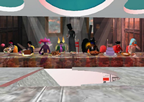
Performance Art for a Virtual World
Aidan: I read on your blog that you're an Alien…
Wirxli Flimflam: Yes I consider myself an alien but at the same time accessible enough to pass for Post-Human ;-)
Aidan: Do people react instinctively to your avatar appearance?
Wirxli Flimflam: Hmmmm..most people are polite, it is always hard to know what people really think. Some have immediate surface reactions though, they can tell right away that I am an artist of some kind, usually.
Aidan: And it's a benefit to Second Front that you all vary in appearance?
Wirxli Flimflam: I have noticed that by instinct, performance artists choose to be Tranny-esque. I like to keep my avatar recognizable. I would like to endorse the meme of brand recognition. Other avatars in the group like to change their appearance, but I am also the PR face of SF so I like to keep things familiar.
Aidan: How did your last performance go at Ars Virtua?
Wirxli Flimflam: No regrets, if that is what you mean, I consider it "early work". We learned a lot from it. Continue reading Performance Art for a Virtual World by Aidan Aquacade, SL Enquirer (scroll down).
Posted by jo at 08:26 PM | Comments (0)
Viroid Flophouse
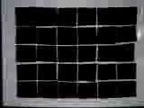
An Exploration of Playable Art
The Viroid Flophouse was an exploration of playable art in an online gaming environment, which incorporated movement, motion tracking, streaming technologies and telematic performance, within the common theme of "virus."
It was a hybrid game/performance environment created by ADaPT (Association for Dance and Performance Telematics) which includes among others Arizona State University (Tempe, Arizona), Nottingham Trent University (Nottingham, UK), Wayne State University (Detroit, Michigan) and Waag Society for Old and New Media (Amsterdam, NL).
The sites functioned as rooms in the "flophouse," in which on-site participants could interact with remote participants.
The ADaPT members involved in this production included a team from Arizona State, spearheaded by John Mitchell, a small team from Waag Society headed by Josephine Dorado, with additional input from Johannes Birringer (Nottingham Trent University).
Previous renditions of the project:
ADaPT had already experimented with one rendition of the project, named the Saira Virous which involved teams from Nottingham Trent University, headed by Johannes Birringer, and Wayne State University, headed by Kelly Gottesman.
Birringer's documentation of the Saira Virous can be viewed at the following urls:
http://art.ntu.ac.uk/performance_research/birringer/lat5.htm
http://art.ntu.ac.uk/performance_research/birringer/lat.htm
http://art.ntu.ac.uk/performance_research/birringer/lat4.htm
That rendition of the project mainly focused on the extension of dance performance telematically within an online gaming infrastructure, via streaming and projected media integrated with live performance.
The introduction of OSC (Open Sound Control protocol) into the gaming structure: In our rendition of the project, the goal was to enhance the interaction by incorporating the sending and receiving of OSC data (Open Sound Control protocol) combined with motion capture, into the scenario.
The incorporation of osc data transmission over a network, in combination with motion capture via softVNS, enabled the sites to communicate the performers’ positions to each other. That data, in turn, could be used to control game events.
The gaming structure: The game structure was developed and was based on the action of the remote and local gamer "sharing" the same space. In other words, the gamer in Arizona and the gamer in Amsterdam had to position themselves in the same virtual gaming space in order to get to the next level. The game was played by Arizona and Amsterdam players in this fashion, with supplementary commentary being streamed in sports commentary style, from Birringer.
Posted by jo at 09:45 AM | Comments (0)
January 22, 2007
Dear Internet v1.
![]()
Networked Technologies and the Paradoxes of Social Relations
In preparation for an upcoming exhibition at Maryland Art Place (MAP) Dear Internet --a project by Mark Cooley and Edgar Endress--will be accepting letters via Dear Internet. Dear Internet v1. investigates how networked technologies become platforms for the paradoxes of social relations in digital culture. Connection, fear, communication, alienation, interactivity, dislocation, intimacy, disembodiment, are all possible and often simultaneously present in our attempts to interact with others online and off.
The installation: A live screening of Dear Internet develops, with the help of participant input, over the course of the exhibition and serves as a partial expression of networked consciousness. Content for Dear Internet v1. is collected from 2 primary sources:
- A participatory blog that forms a collective memory of "users" experience in networked living. Dear Internet (the blog) is an unmoderated site for the publishing and archiving of letters written by Internet users concerning their relationships with the Internet. Through http://dearinternetuser.blogspot.com, users may address the internet directly and indulge in their deepest thoughts, feelings and fantasies with the abandonment, comfort and protection that only online anonymity can provide. Texts gathered from http://dearinternetuser.blogspot.com are remixed and projected in the gallery while they are read with text to speech software.
- Live IP surveillance cameras are accessed using a variety of well-known advanced google search techniques and projected in the gallery space. While these surveillance cameras are accessible to any internet user, they remain largely unknown to casual internet users. However, the cameras have attained significant attention from hackers, technophiles, security professionals, bored surfers and others. The interest no doubt comes from the common presumption that these surveillance cameras are left unsecure unintentionally by camera owners who have neglected to set-up camera security features. Internet users are often able to access full control of an accessed camera's, zoom, pan, snapshot and other features. Camera controls are removed from the interface for the Dear Internet installation and the cameras are set to refresh every 30 seconds.
Posted by jo at 02:24 PM | Comments (0)
Robert B. LISEK's
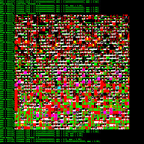
GENGINE
Fundamental Research Lab invites you to the Lecture and the Opening Reception for Robert B. LISEK's GENGINE :: January 25 - February 25, 2007 :: Lecture: Thursday, January 25, 6 pm :: Opening: Thursday, January 25, 6-8 pm :: National Gallery of Art Zacheta, Warsaw.
Gengine, the first part of project SUPRAMIND that aims to build a general-purpose intelligent system based on a visual inference engine which allows us to solve problems by extracting new information from existing. Gengine module use genetic programming as an automated "invention machine". In the Zacheta Gallery presentation the DNA of the members of Fundamental Research Lab has been used. After the translation, the sequences have been treated by various genetic programming techniques. The output sequences have been used to create extraordinary diagrams, objects and instructions on what works to make. Each object alludes to the different conditions that include not only mathematical, but also social and philosophical roots.
The purpose of the whole project Supramind is to create a artificial general intelligence ‘implants’ [SUPRAGII], i. e., programs that can be used to solve problems in many completely different fields.
The next modules of the project SUPRAMIND in preparation:
2. visual inference engine based on dynamic probabilistic logic network (NYU)
3. knowledge representation engine based on hyperposets (ready core >> FLOAT project, LMCC NYC) and optional Suprabot extensions:
4. open source game engine for visualization and sensing (UTD)
5. robotic sensimotor interface (the Hanson Robotics)
6. natural language processing interface (UTD)
The SUPRAMIND is sponsored by the Arts Links, the University of Texas at Dallas, and in cooperation with the Harvestwork Digital Media Arts Center in New York.
Robert B. LISEK is an artist, mathematician and a founder of FUNDAMENTAL RESEARCH LAB; he is involved in the number of projects focused on alternative art strategies, hacktivism and artificial intelligence. A pioneer of art based on GAI (general artificial intelligence). His visionary combination of GAI and telerobotics explores the possibility of building distributed, intelligent entities.
Downloadable images:
http://www.flickr.com/photos/fundamental_data/
Info and contacts:
http://www.fundamentalresearch.org/
lisek[at]fundamental.art.pl
Posted by jo at 09:50 AM | Comments (0)
January 19, 2007
Packet Garden
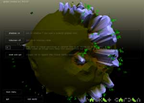
Landscapes of net behaviour
Packet Garden, developed by Julian Oliver, captures information about how you use the internet and uses it to grow a private world you can later explore.
The (free) software keeps track of all the servers you visit, their geographical location and the kinds of data you access. Uploads make hills and downloads valleys, their location determined by numbers taken from internet address itself. The size of each hill or valley is based on how much data is sent or received. Plants are also grown for each protocol detected by the software; if you visit a website, an 'HTTP plant' is grown. If you share some files via eMule, a 'Peer to Peer plant' is grown, and so on.
None of this information is made public or shared in any way, it's your own private landscape.
Somewhat related, Visualization of statistics in computergames, by Michael Zoellner and Daniel Kupczyk, tracks and projects the behaviour of German internet users in a 3D world. Topics as different as politics, sex, sports, environment or economy are translated into the appearance, behaviour, and the sounds of an avatar. As the stream of data creates and changes, so does the population of this world, unvealing a mirror image of the net society.
The game consists of three scenarios with different levels of interactivity and abstraction. The first level shows a landscape of islands, each island representing a subject area, coded by colours and textures connected to the topic. the avatars feel attracted by the topic islands to which they belong and stay close to them.
The second level gives the player more possibilities for interaction and to influence what is happening in the game.
The third level represents a realistic environment, a scene in the street with a supermarket, cars and lawns. This representation projects the statistics in a real world. in a later further development the game could be experienced in an augmented reality environment, meaning that the avatar would be projected in a real scenery.
Search words which date back further in the past are represented by ghost-avatars. One can recognize very fast how different weekdays and daytimes influence the search words and hereby the significance of the categories. On a Sunday morning you will find another population as during the nightly hours of a working day.
Via a comment by Bjoern, information aesthetics and selectpark + La petite Claudine. [blogged by Regine on we-make-money-not-art]
Posted by jo at 09:54 AM | Comments (0)
January 18, 2007
Schwelle
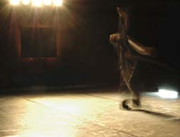
@ Tesla/Transmediale 2007
Schwelle is a new media and performance project using cutting edge acoustic and interactive technologies to explore the extreme threshold states of consciousness that constitute human experience. The multi-part project uses High Definition image and multi-channel sound, interactive installation and live performance to create states of consciousness in the spectator akin to the thresholds states that one experiences at the edge of trance, sleep and death. For transmediale '07, Tesla presents parts 1 and 2.
Part 1 is a turbulent exploration told by way of image and sound of the experience undergone at the time of the dissolution of the body and of consciousness. Part 2 is a live performance in which the audience confronts a lone single performer Michael Schumacher, master improviser and long time dancer by William Forsythe’s Frankfurt Ballet, experiencing the traumatic transition period between death and rebirth. Utilizing wireless sensor networks in the room and on the dancer’s body, Part 2 creates a stage environment where light, sound and objects take on their own choreography, performing with Schumacher, breathing, and behaving alongside him. Where does the body end and the room begin? What happens in the threshold where body and room merge, mutually influencing and transforming each other?
Schwelle is a co-production between artists and researchers from cultural and scientific institutions in Canada, China, Germany, Holland, China, and the USA. Schwelle, Part 2 was partially developed during a project residency at Tesla in Summer 2006 and will receive its world premiere at "tesla zur transmediale".
Part I
Concept/Direction/HD Video/Sound: Chris Salter
Collaboration Sound: Daniel Moody-Grigsby and Philip Viel
Part II
Premiere: Tesla/Transmediale 2007, Berlin, February 2007
Concept/Direction: Chris Salter, in collaboration with Michael Schumacher
Dramaturgy: Heidi Gilpin
Lighting Design: Lea Xiao
Sound Design and Programming: Marije Baalman, Daniel Moody- Grigsby, Chris
Salter, Philip Viel
Interaction Design/Sensing Systems: Marije Baalman
Objects: Thomas Spier, Flora Luna
Production Stage Manager/Technical Director: Daniel Plewe
Production Assistents: Daniel Wessolek, Alexander Wilson, Brett Bergmann
Tesla: Medien-Kunst-Labor, Klosterstrasse 68, Berlin
Thursday-Saturday, February 1-3, 2007. 20:30
For tickets/more information, please visit http://kasse@tesla-berlin.de
Christopher L. Salter, Ph.D.
Asst. Professor of Computation Arts
Faculty of Fine Arts
Concordia University
Researcher_Interactive Performance and Sound Hexagram
Posted by jo at 03:00 PM | Comments (0)
January 17, 2007
Nathaniel Stern

In and Around: the Implicit Body as Performance
"Theorists and producers of the "mixed reality" movement within interactive art argue that inviting action and enactment, rather than producing illusion and simulacrum, creates more immersive spaces. Mark Hansen’s concept of the "body-in-code," for example, reads the sensorimotor body here as an "activity" and a "being-with," where the body is "distributed beyond the skin in the context of contemporary technics."
Others, such as Brenda Laurel and Chris Salter, have sought to re-think critical histories of digital practice in order to locate interactive and digital art more precisely in the theatrical or performance realms.
My research contends that in such spaces, it is the body, itself, which is performed. A body in space can "act" as a site of emergence, a boundary project, and an incipience. While Rebecca Schneider’s "explicit body" in feminist performance art performatively unfolds (Latin: explicare) and explicates, the implicit body concordantly enfolds (Latin: implicare) and implies. Inter-action is both constitutive of, and always already involved in, the space of the body as relational. Like an animated moebius strip, the body is: in and around.
This paper attempts to think through digital art as a proscenium for, and framer of, the implicit body. I’m not necessarily interested in work or environments that are more illusory or more immersive, but that, rather, ask us to move in ways we normally wouldn’t, pushing the boundaries of performativity and affect. Like space itself, bodiliness is "susceptible to folding, division and reshaping… open to continual negotiation" (K Kirby). By setting the stage, interactive artists-as-directors create productive tensions between the per-formed and the pre-formed, shifting our experiences of "body". At stake, are potential strategies for intervention in our understandings of enfleshment, art that contextualizes embodiment towards specific ends." In and Around: the Implicit Body as Performance by nathaniel stern [blogged by nathaniel on nathaniel & the non-aggressive]
Posted by jo at 03:54 PM | Comments (0)
eRiceCooker
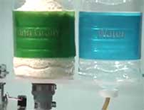
Rice is nice?
eRiceCooker, by Annina Rüst, tracks Internet news about genetically modified rice. Whenever there is a new report about GM rice, a quarter cup of rice is dispensed into the cooker. When there's enough rice for a meal, water is added automatically to the rice and the cooker is switched on. When the rice is ready, an email is sent out to inviting people to eat the rice.
The more news reports appear, the more rice is cooked, the more often invitations are sent out, increasing awareness to issues surrounding genetically modified organisms by producing excessive amounts of cooked rice and attempting to feed people with it.
Check it out at the upcoming Dorkbot Oldenburg, Edith Russ Haus für Medienkunst, January 19, 2007.
Another great rice project: Nigel Helyer's Everything's nice with American rice proposes a radical "green" solution to the so called free-trade agreements which promote the importation of American rice into the Japanese rice economy. Imported rice is converted into "Bio-fuel" that, in turn is used to power local rice cultivating equipment to produce Japanese rice, whilst at the same time reducing the reliance upon imported fuel oil. [blogged by Regine on we-make-money-not-art]
Posted by jo at 10:59 AM | Comments (0)
The Institute of Unnecessary Research
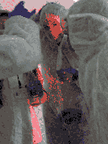
pluckEhisquare_anti
The Institute of Unnecessary Research is a concept by Anna Dumitriu and looks at the relationship of artists to science and research. Anna is listed as Director, other artists a listed as dept heads, mimicking the institutional model. There are depts of Artificial Life, Neurofeedback, cross species communication and so on. The project is both web based and event based via interactive performances.
Artists are innovators, if a new piece of technology or a new medium, becomes available; artists want to try it, to experiment with it, to push the boundaries. Some artists take on the role of a scientist in almost a performative way and some scientists equally take on the role of artist. Attitudes to science, medicine and art have changed over the last five hundred years, in that whilst Science has become more formalized, Art has become increasingly less so. By stepping outside the testable hypothesis artists are free to go off at tangents, to get bogged down in aesthetics and be mavericks. [via Rhizome]
Posted by jo at 09:11 AM | Comments (0)
January 16, 2007
WhisperBox
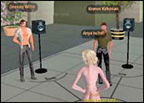
Interactive Sound Installation in Second Life
Second Life, one of the most populated MMORPG, is an important watching point to verify how the borderline between real and virtual tends to become more and more ephemeral. In the last months Second Life has seen many famous names and brands of the real world coming into its virtual spaces. The Reuters news agency has opened a virtual editorial office, IBM decided to test here its v-business (virtual business) idea. Many other events as lectures, talks (Lawrence Lessig), concerts (Suzanne Vega) has packed the SL dwellers agenda. So an interactive audio installation couldn't be missed. A certain Robbie Dingo (this is the name of the homonymous British sound designer avatar) programmed his WhisperBox (a 21st Century Folk Song).
The installation, hosted by the SL Phoenicia Center for Contemporary Art, captures words and pieces of the conversations that happens amongs the avatars inside its space (a circular space marked off by seven speakers) and translate these pieces in sounds. Tones and rhythms are directly influenced by the conversation progress. Furthermore WhisperBox provides also a visualization form of the spoken words, appearing near each avatar in a sort of 3D balloon. The displayed text then is an echo of the previous conversations. Clicking on different avatars with active balloons, their spoken words are played as music, and the previous conversations are immortalized, in a sort of inextricable and synaesthetic loop, made out of real and virtual, present and past, expression and representation." Vito Campanelli, Neural.
Posted by jo at 10:15 AM | Comments (0)
January 15, 2007
Turbulence Commission:
![]()
"html_butoh" by Ursula Endlicher
Turbulence Commission: html_butoh by Ursula Endlicher :: [Needs Flash Player; high speed Internet connection (DSL/Cable or better); speakers on; Mozilla Firefox 2.0+, Opera 9.10+, Netscape 8.0+, and Safari 2.0+]
"html_butoh" questions the way information is indexed on the Web; it enacts the "Global Top 500" websites and is choreographed by their real-time HTML structure. Small video clips show participants translating the "functionality" of each HTML tag into movement. The URLs, and therefore the "stage," changes every 3:28 minutes, running through 500 websites within a twenty-four hour cycle. "html_butoh" runs on the html-movement-library, an open-for-participation video clip database. In Butoh--a Japanese dance technique--the dancer "becomes" an image through her movements, which parallels to how a web browser scans through HTML and displays its content. By submitting to the html-movement-library every participant instantly becomes part of the "html_butoh" performance.
"html_butoh" is a 2007 commission of New Radio and Performing Arts, Inc., (aka Ether-Ore) for its Turbulence web site. It was made possible with funding from the Jerome Foundation.
BIOGRAPHY
Ursula Endlicher was born in Vienna, Austria and has lived and worked as a "multiple-media" artist in New York since 1993. Her work resides at the intersection of Internet art, performance and multi-media installation. She focuses, with a critical and yet humorous eye, on the underlying structures of the Web, questioning online identity while often anthropomorphizing and enacting the Web, and bringing the Web into a "physical" realm via alternative human-machine communication interfaces. Endlicher has been shown internationally, including "artport," Whitney Museum, New York and "Illegal Machines" at Art Athena, Greece. Recently she participated in "No body on this line", a research lab at Tanzquartier, Vienna, Austria. Endlicher initiated a discussion and web conference about "Curating net art" with Mobile-Studios.org in 2006. She has lectured about her work in the US and Europe.
Posted by jo at 09:57 AM | Comments (0)
January 10, 2007
Teleklettergarten
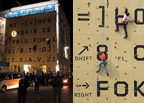
Physical and Programming Commitment
Teleklettergarten -In collaboration with the group FOK, Bitnik reconfigured the facade of the art university in Linz to become the world largest keyboard. The facade was converted into a climing wall with oversized keyboard keys and buttons as a input interface for a computer. The visitors who participated in Teleklettergarten passed through a trainee programm and where trained as software developers. Through physical commitment the climbers and the programmers collaboratively inputed code into an oversized programming environment. In a week-long performance the collaborators programmed codes, scripts and tools and demonstrated various software functions.
Aim of the Teleklettergarten was not only to make programming a physical experience but to also use this public and collaborative programming interface to collectively demonstate against the arbitrary awarding of software patents for core functions which are the basis of day-to-day work with computers. By ensuring that the illegal action (the execution of patented code) is performed by an anonymous collective, no single person can be made responsible whilst being able to publicly demonstrate the restriction these patents mean for programmers and for the whole user community. [via VVork]
Posted by jo at 12:11 PM | Comments (0)
January 02, 2007
Flickeur
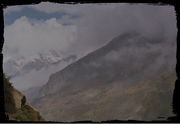
Stream-of-Consciousness Movie
Flickeur (pronounced like Voyeur), by Mario Klingemann, randomly retrieves images from Flickr.com and creates an infinite film with a style that can vary between stream-of-consciousness, documentary or video clip. All the blends, motions, zooms or timeleaps are completely random. Flickeur works like a looped magnetic tape where incoming images will merge with older materials and be influenced by the older recordings' magnetic memory. The virtual tape will also play and record forward and backward to create another layer of randomness. This principle will create its own sometimes very suggestive or scary story. It might take a few minutes until the tape has accumulated enough material to not show any empty screens anymore.
Flickeur is part of the NET.ART section at Art Tech Media 06 which can be seen in various museums across Spain in 2006.
Posted by jo at 06:47 PM | Comments (0)
December 20, 2006
Broken City
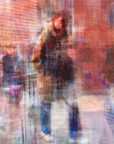
Transcoding
Broken City by James Alliban: This piece lies somewhere between generative art, software art, interactive fiction and photomontage. Interacting with it allows the user to paint different combinations of the various elements of a city and its inhabitants, and compose a random soundscape. Mini-narratives are generated from these ever-evolving juxtapositions.
The fragmented aesthetic employed within this hypermediated environment echoes our increasing ability to multi-task due to the computerisation of western society. It is an examination of this quasi-evolutionary development of human culture which Lev Manovich calls transcoding. [via Rhizome]
Posted by jo at 06:27 PM | Comments (0)
December 19, 2006
Low-fi Guest Selections
Charlie Gere + Cory Arcangel
Touch in art and elsewhere by Charlie Gere :: Recently, for various reasons, I have become interested in the question of touch, in art and elsewhere. We live in a world in which the ways in which we can communicate with each other become more and more immaterial, incorporeal and virtual, particularly through the increased use and greater ubiquity of digital technologies. In this context touch is often occluded and, at the same time, overly fetishised. In the last half century or so, there has been an increasing interest in touch in art, especially in relation to performance and telematic works, that may be a response to the increasing virtualisation of culture, though the question of touch can be traced in far older works, particularly some of those dealing with the life of Christ, which is, whether we are religious or otherwise, the founding myth of Western culture, and which has determined much of our understanding of questions of presence and absence, corporeality and spirituality, and our relation to the senses and thus to touch.
Cory Arcangel's Offline Art Show: Hello, for this project I have been asked to curate a small "online" artshow by low-fi.org.uk. Therefore, for a reason I am unable to explain myself, I have decided to put together this show "offline" aka - with no internet connection. So, since I have no Internet, I can't check my bookmarks to see what I've been interested in lately, and I can't search though my email to help me remember cool stuff I've seen lately, so basically I just have to remember the stuff off the top of my head. More >>
Posted by jo at 04:26 PM | Comments (0)
Touching the Invisible
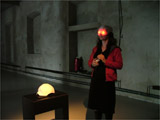
Working with the Invisible Flow of Information
Touching the Invisible characterizes the work performed at the Smart Studio and reflects how we work with the invisible flow of information. As it is channelled and directed into specific lines of investigation, the bits and waves transform through an eclectic mix of ideas into compound forms that become both visible and tangible. Our aim is always to bring the invisible out into the real space we inhabit, to invite the visitor for interaction, and overturn the outcome. The exhibition is built around six individual pieces representing different aspects and interpretations of the theme, that in different ways challenge our preconceived notions on flux and immobility, on thought and matter, on time and space.
The generative processes that lead to the final work can often start from discussions in the group, where we try to find associative paths between individual definitions, for example by delimiting an area of interest with keywords or images that may provoke a multitude of interpretations. The shifts of meaning that occur in the process are used as an asset that can add an unexpected twist to the issues and their realisations.
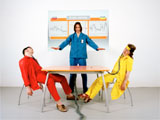
Brainball is a game, an art object and Smart studio's first completely hybrid research project. The players move a ball on a table by the sole use of their brainwaves. Encouraging competition through relaxation, the game objective is to score a goal on the opponent's side with the least possible action. Brainball is an exciting and social game but also an interesting tool for learning how to control your mental states. It has been exhibited in as widely different contexts as art and design exhibitions and medical fairs, and is seen as one of the studio's most successful hybrid objects.
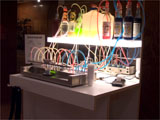
Brainbar is a mechanical bar that mixes drinks according to the visitor's brainwaves. The bar reads the brain frequencies (EEG or electroencephalogram) in the alpha and beta wavelength. These wavelengths are generally considered to be synonymous with the states of relaxation and activity in the mind. Thus the BrainBar serves the drink most suited for you, at the moment of measurement. BrainBar can be seen as a mediator or manipulator designed to give a party its perfect state of enhanced socialising, carefully adjusting the drinks served so that every guest stays within acceptable parameters for a “good” behaviour or, if the settings allow, a “bad” behaviour. By the use of alcohol and medical herb essences, the bar can emotionally equalize or polarize the group of guests. This can be seen as a sociological experiment exploring how much a person is prepared to submit to external forces and how far the person can allow a machine to intrude on the body.
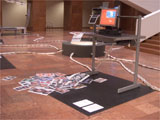
A paranoid web spider searching for the Devil on the net. By detecting inverted pentagrams in images stored on the Internet, the program determines if the image has evil content and alerts the siteowner. HellHunt is an application based upon the use of so-called vision algorithms, a way of enabling computers to detect and distinguish geometrical configurations inside pictures. The active algorithm in this piece traces down the diabolic symbol of the reversed pentagram on images stored on the Internet. When the program hits an image that corresponds with the algorithm, it draws the lines of the hidden pentagram on it. Furthermore, it saves the address of the page and sends an e-mail to it, kindly demanding the removal of the harmful image.
Posted by jo at 04:09 PM | Comments (0)
December 18, 2006
Interactive Telecommunications Program
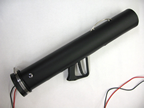
Winter Show @ NYU
As promised, I went to the ITP Winter Show opening today @ NYU; had a couple of thoughts about the show. Spoke with Benedetta Piantella Simeonidis and Lesley Flanigan who created the Sonic art weapon: Ravezooka which I mentioned yesterday.
.
Benedetta also has a personal blog hosted at NYU. The Sonic art weapon is programmed in MAXMSP and it seemed to me that this is a good program to learn since it's so visual. LemurPlex, located in Brooklyn, NY, not far from my Studio, appears to be the best place to learn MAXMSP around here, in NYC, - and you can see all the courses you can take at the LemurPlex -
I've passed by LemurPlex several times but never spoken to anyone - and several of the projects in the ITP show had connections with LemurPlex.com. I think I'll look them up and take an intro course to MAX -as I think I can learn from them how to execute some of my ideas for modern art, ideas I don't think I can execute in traditional paint media - these ideas need electronic media.
By the way, the Sonic Art Weapon cost less than 100 dollars to manufacture and has applications in science (Mars Robotic Probes would benefit from the technology used here, for example).
Other exhibits in the ITP show that I liked - LocationAura which similar to We Feel Fine, a subject I have already written about in Webmetricsguru.com; Catherine Colman and Nanna Halinen were not aware of the program (I think they should have been - as LocationAura tries to do, more or less, exactly what We Feel Fine does, much better) - but for a graduate project, LocationAura was pretty good - with a focus on mobile phones that We Feel Fine does not have (but does not need, either).
The Interactive Pond by Diane Chen, Peng Zhao and Hye Ki Min where you can play with a fantastic virtual reality pond and get your hands wet was pretty neat. Whales in the Sewer was pretty funny but I'd feel sorry for any whales that actually got caught in a city sewer. Orb was pretty amazing - I wanted to touch it - but I was told it would hack my hands off if I did; you can see a good picture of the Orb in action here. Future TV is an interesting project - getting information on anything on TV by clicking on that part of the image though it's more of a concept as everything had to be hand programmed - but the idea is great, especially if bots can go out on the web and pull the data in.
And while there is a strong element of telecommunications at the ITN show, there are several students who did not go in that direction; I don't know why they're in the program in the first place.
I think it's important for the ITP program not to lose it's focus - all the projects in this show, in my opinion, should have been about using technology to interact and create communication - but not all were.
Links: ITP Winter Program [blogged by by Marshall Sponder on Smart Mobs]
Posted by jo at 06:52 PM | Comments (0)
December 14, 2006
susana mendes silva's
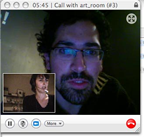
art_room
art_room: Don't be afraid to ask everything you always wanted to know about contemporary art.
My Skype name is susana_mendes_silva, call me.
art_room (#3) :: Saturday December 16, 1:00pm - 3:00pm (CT) | 7:00pm - 9:00am (GMT) :: Untitled [ArtSpace] Upgrade! International: DIY, Oklahoma City.
susana mendes silva :: arslonga[at]netcabo.pt
Posted by jo at 01:59 PM | Comments (0)
December 13, 2006
Haiku Trader
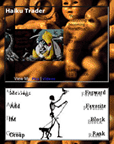
Distributed Creativity and MySpace
Haiku Trader is a new media poetry / performance artwork that began in 2005. The art work as such utilises the social network myspace as a virtual collaborative space investigating the theme of distributed creativity and aesthetics. Practically speaking, what this means is that the work is not 'limited' to this profile but must be conceptualised as the network it involves progressively over time. This network can be explored through the virtual traces left as haiku 'comments' throughout the myspace community as well as in the group which this profile acts as 'moderator' for - Desert Islands.
Leon Tan works as a lecturer and psychotherapist at AUT University, and as a consultant for an ICT company Cogitatus Solutions. He is also a doctoral candidate in art history and film tv & media studies at the University of Auckland. He researches interactivity, psychoanalytic social theory, social and cultural software. He is also a new media poet / artist. His current work experiments with distributed authorship in poetry utilising social software platforms. [posted on Rhizome]
Posted by jo at 11:07 AM | Comments (0)
December 11, 2006
Second Life
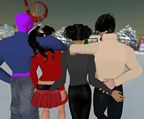
First Annual SL Literary Festival
First Annual SL Literary Festival :: Verum's Place, Yanguella :: December 16, 2006; 2:00 pm SLT :: Contact Carla Herrera, carla[at]contemporaryguide.com for more information.
Schedule of Events (Tentative/subject to change) :: Throughout the day there will be poetry readings, streaming music, discussions, art display, interactive literature projects, classes and workshops.
TBA: Patrick Lichty / Man Michinaga - Discussion: Digital Narrative and Online Spaces.
2:00 Opening ceremony Greetings & guest speaker on front lawn ::
3:00 Schedule of Workshops and Classes begin Signs and teleporters provided :: Workshops and classes run throughout the day and will conclude at 6:30 for fireworks And storytelling :: 4:00 Tours of the Gothsburg castle begin Tours last 30-45 minutes. :: 3:30 Open mic at Verum's place Essays & poetry welcome :: 4:00 Poetry Challenge $L100. to the winner :: 5:00 Tramp's Theatre Troupe Surprise performance :: 6:30 Fireworks By Spider :: 7:00 Storytelling circle on front lawn :: 8:00 Event close/Open chat/discussion.
Posted by jo at 04:25 PM | Comments (0)
[iDC] Introduction and Blinks & Buttons
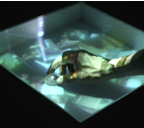
Networked Photography
I'm Sascha Pohflepp, currently based in Berlin, where I spent the last couple of years at the University of the Arts' (UDK) visual communication department (some of the work from that time can be found at http://www.pohflepp.com). I also frequently contribute to the blog We-Make-Money-Not-Art.com and occasionally work with the Mediamatic foundation in Amsterdam.
My most recent work is a two-fold thesis project, titled "Between Blinks & Buttons". It is a try to look at photography as an increasingly connected process and the implications which arise from that – both for the individual but also for the process of remembering and the camera as an object in itself. Quoting from the introduction:
"Photography has become a networked process. It no longer ends with pasting putting prints into an album. Instead, making them public through services like Flickr is rapidly becoming one of the main ways how we treat our visual memories. The photographic process extends from preserving a moment to an act of telecommunication, with numerous implications on how we perceive reality, how we make our memories and how we create a narrative from it.
The camera itself has become a networked object and through the fusion of the snapshot-camera and the mobile phone, this object will even become more part of our everyday lives. Cameras always have been recorders for their contexts, essentially equipped with a light sensor to capture a visual representation and a pressure sensor for the person who decides which moment will be saved – the button. Furthermore, digital photos come with a great amount of data attached to them as so-called EXIF-tags. These include a multitude of precise information about technical aspects of the shot, the make of the camera, how it was held and when the image was taken.
For almost any given moment since early 2004, it is possible to find a photo on the web which was taken in the exact same second. For every of my photos that I myself have a memory of and an emotional connection to, I can see someone else's moment. I can see what happened in another part of the world while I was doing what I remember when I see it. In that sense, cameras become networked buttons that create a link between two people through the simple fact that they did the same thing simultaneously: press a button. The cameras create a visual trace of it, with time as a reference."
This resulted in two installations – firstly "Blinks", a prism sitting on a kind of light-table that actually refracts the ray of time which metaphorically runs through every photo into all the other moments that had been simultaneously captured in various places all over the world.
Secondly, "Buttons", a camera which intentionally boils down the photographic apparatus to its essential button. Once this button has been pressed, no picture is taken (the person will remember the moment, though), but a networked device inside starts to look for photos from that very same second. It might take some time, but eventually, a photo will show up on the camera's display.
Interestingly, in both pieces, the photos never feel random since the user shares a moment with that other person who took the photo. At a recent presentation, someone called the whole process "momentograph" which I found very fitting and beautiful. Please feel free to let me know what you think of all this, the website mentioned above also has some more information and videos.
iDC -- mailing list of the Institute for Distributed Creativity:: iDC[at]bbs.thing.net :: http://mailman.thing.net/cgi-bin/mailman/listinfo/idc
List Archive: http://mailman.thing.net/pipermail/idc/
Posted by jo at 01:58 PM | Comments (0)
December 08, 2006
Will Pappenheimer's Public Mood Ring
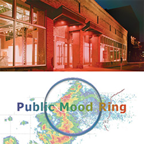
What is your Relationship to News?
Will Pappenheimer's Public Mood Ring opens at the Urban Institute for Contemporary Art, Grand Rapids, MI, USA :: December 8, 2006 18:00 EST - January 19, 2007.
Public Mood Ring is an installation/internet work inspired by the common wearable “mood ring.” The ring is believed to be capable of translating the bearer’s emotional condition into its changeable color hue. This project attempts to find the color mood of a current public issue represented by instant Internet news text. It does this at the request and questioning of remote viewers logged onto the artwork site and to a computer station within the installation room.
what is your relationship to news? Web participants can see the change and status of the installation space via web camera. The shared experience is both the gift of the remote participant, as well as a gauge or color representation of the current world events. Installation visitors are then immersed in the ambient light.
Posted by jo at 12:49 PM | Comments (0)
YOUR TUBE, YOUR IMAGINATION
Dancoyote_antonelli_and_skydancers
Online world as new artist's medium. I haven't had a chance to attend a performance designed by DanCoyote Antonelli, founder of a new school of metaverse-era art theory he calls hyperformalism, but Gary Hazlitt has. Hazlitt shot at a recent showing of Antonelli's ZeroG SkyDancers (evocative, though it's clear you need to attend the show in-person, to get its full power), then read his detailed and thought-provoking write-up of the event and interview with Antonelli here. [blogged by W. James Au on New World Notes]
Hyperformalism is an aesthetic philosphical construct that may be employed by to describe a late 20th century, early 21st century mass art phenomena consisting of scores of personal computer users generating abstract, often spacially unique artworks with software tools.
These spacial realities have no analog in the physical world, and instead of making reference to physical reality, create a unique continuum of reference; a rearrangement of photons to illuminate alternate worlds of form, shape, color and space.
The term Hyperformalism is derived from the combination of the words Hyper and Formalism (as described by WikiPedia) and is being used here to describe aesthetic self expression without anthropomorphic, or representative context. This seperates Hyperformalism from digital collage, aesthetic photo manipulation and other forms.
Hyperformalism is not anthropomorphic or representational. Often times hyperformal art may resemble natural formations or even employ naturalistic algorythms such as the work of Casey Reas which is described on the aforementioned website as "stringently defined yet wonderfully organic".
Other times hyperformal artwork takes a more industrial or unnatural form such as the work of Shirley Shor
Hyperformalism may be flat like Casey Reas or spacial like Shirley Shor but never contains recognizable elements like text, figures, landscapes, objects and concepts relating to humanity.
Hyperformalism, the product of a desktop computer, suffers from stigmatization of its association with computers and has yet to find a neutral delivery platform. This means that vast amounts of work is being created, at the pace of technological change, without the hope of display beyond a desktop computer screen.
Since most of the material viewers are accustomed to encountering on a desktop computer screen is commercial in nature, disposable consumer culture, it is a hard sell to suddenly invoke the weight of culturally important artifact on to such a homely delivery platform.
Guilt by association...
Posted by jo at 08:58 AM | Comments (0)
December 07, 2006
OPENSTUDIO

Interview with Amber Frid-Jimenez and Brent Fitzgerald
"While at SIGGRAPH this September, I had the chance to visit MIT Media Lab a couple of times and stick my head into the labs of the different groups. At the time, the people in John Maeda's Physical Language Workshop were developing something exciting about art and commerce called OPENSTUDIO. At the time it was still closed but since it has recently been opened to the public, it is high time to find out more. Two of the group's current researchers who also worked on the system, Amber Frid-Jimenez and Brent Fitzgerald, are happy to explain.
And – if you find this any interesting, you should also check out PLW-graduate Burak Arikan's (whose name will appear a few times more) latest project A Stock Market In Life as well!" More >> [blogged by Sascha on we-make-money-not-art] OPENSTUDIO AND SHIFTSPACE WILL BE PRESENTED AT UPGRADE! BOSTON ON JANUARY 11, 2007.
Posted by jo at 08:35 AM | Comments (0)
December 06, 2006
Garrett Lynch
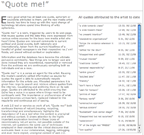
"Quote me!"
"Quote me!" by Garrett Lynch: (please be patient this may take a few moments to load) :: Every good artist has at least one quote, aphorism or soundbite attributed to them, yet the new media artist barely has time to keep up with the rapid change of technology let alone spend time thinking of witty aphorisms.
"Quote me!" is a work, triggered by users to its web page, that reuses quotes and the date they were expressed from various online sources for the busy new media artist who hasn't time. Quotes are relevant comments to current political and social events, both nationally and internationally, taken from the current headlines of a handful of global newspapers via their respective rss / xml feeds, yet placed without context or explanation.
Information and the database have become the ultimate pervasive commodity. New things are no longer said and done instead they are recombined, recompiled or remixed from the archives we are continuously compiling both as individuals and as a race.
"Quote me!" is in a sense an agent for the artist. Reusing the media's carefully edited information as source for quotes the agent is able to automatically recycle information for the artists use. Allocated parameters it is given free reign to search and retrieve others quotes from the internet, republishing and archiving them on its web page. Quotes are attributed to the artist ensuring that (s)he has a voice in a space where things need to be continually said. The importance or profoundness of what is said becomes unimportant, replaced instead by the regularity and continuous act of saying.
A web 2.0 tool or service as work of art, "Quote me!" both continues themes of net.art (reusing, recycling, transforming) and simultaneously highlights the redundancy of it as a tool when the content is unoriginal and without context. It draws attention to the highly important exploration involved in these types of recombinatory net.art works, not possible outside of the internet, yet questions the same use of techniques employed in their creation for the critical discourse that surrounds them in our collaborative, tagging, reblogging and ever more copied, unoriginal content of web 2.0.
a+
gar
Garrett[at]asquare.org
http://www.asquare.org/
Posted by jo at 04:03 PM | Comments (0)
December 05, 2006
Climate Commons:

A Networked Conversation About Climate Change, Sustainability, and the Arctic
Climate Commons: a networked conversation about climate change, sustainability, and the Arctic :: Developed by Jane D. Marsching with Matthew Shanley :: November 27 2006 - February 28, 2007. Please join the conversation by reading the posts and comments and then logging in to respond with your own comments.
Climate Commons is a conversation between thirteen people who focus on climate change, sustainability, and the Arctic in a wide range of disciplines including a glaciologist, an architect, a journalist, and a comedian. Each author contributes weekly posts about their work, inspirations, discoveries, or questions. Readers can join the conversation by clicking on the comments hex icon and choosing a hex cell to respond to any particular post. As an interdisciplinary collaborative hybrid art/research project, Climate Commons seeks to point to the multiplicity of voices behind the complex environmental concerns and to create connections/analogies/discussion across disciplines, economies, and ideologies.
Core participants:
Sally Bingham, Episcopal Priest
Jock Gill, Carbon Neutral by 2020
Mitchell Joachim, Architect
Jane D. Marsching, Artist
Larry Merculieff, Alaska Native Science Commission
Robert Newman, Comedian
Matt Nolan, Glaciologist
James Overland, Climatologist
Sarah Rich, WorldChanging
Russell Potter, Historian
Andrew Revkin, Environmental Journalist, New York Times
Matthew Shanley, Artist/Programmer
Juanita Urban-Rich, Windows Around the World
Climate Commons is part of a larger project, Arctic LIstening Post, a series of interdisciplinary, collaborative hybrid art research works in digital technologies by Jane D. Marsching. On exhibit at the Institute of Contemporary Art Boston, 12/10/06-3/11/07.
A project of Creative Capital with the generous support of the LEF Foundation Contemporary Work Fund.
Posted by jo at 03:01 PM | Comments (0)
November 27, 2006
Upgrade! International: A Day in the Life
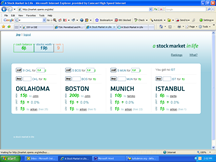
Stock Market
Upgrade! A Day in Life events take place in four cities simultaneously. Urban spaces in Oklahoma City, Boston, Munich, and Istanbul will be connected with each other via a streaming video server for the duration of the event. For each location, sensors mounted in the entrance register how many people are in the room at any one time and send this information to the Stock Market central server. The number of visitors define the fair value for each place.
The stock market uses this value generated by the immaterial labor of visitors. Each location has 100 shares and the shares gain or lose value depending on the speculations in the market and the number of people in the local rooms. You can contribute to the value either by just visiting the physical locations or by trading in the online stock market. Get your shares now!
The Upgrade! Stock Market is a project by Burak Arikan. Other Upgrade! Boston events >>
Posted by jo at 02:09 PM | Comments (0)
November 25, 2006
Nearness
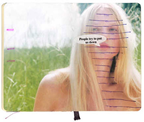
Information Artefacts
Katharina Birkenbach (aka Ponypink), an Amsterdam- and soon Berlin-based designer, has just launched a pretty fresh social networking website, it's called Nearness. Built on Mediamatic's anyMeta system, it allows you to feed it with various information about events, people, things, etc., all of which are equally treated as artefacts. This allows users to create rich interconnections between the individual entries, creating an ever more complex network of stuff.
I asked Katharina to briefly line out what the idea behind it is: "Nearness is an environment where people can store their information that is surrounding them in their daily life. It is not focused on one kind of media but is open for nearly any kind of information, doesn't matter how big or small, important or unimportant it is. Nearness can become an always present little companion, which is helping you to collect, to not forget, to organise the things you like. But organising not in the sense that you are somehow the administrator of a complex folder system, but by generating context for the data and embedding it in the data network. The context in which, for example, your favourite book is displayed is not only set up by the information you've entered, but all the users of Nearness. In this sense it can develop to some kind of stimulating treasure trove."
Trying to explain the potential of it, she also sent me a scan from her sketchbook which is pictured above, along with its history: a photo from i-D magazine, alluding to The Virgin Suicides. A sticker from Dazed and Confused which itself is a quote from The Who. Ten friends also made collages like this as part of something called Feed Me. So, Nearness in her vision could grow to become a tool for the same process. Something that today many creative people use notebooks for: collecting snippets of culture, ideas – in a way making mental collages but with the power of a networked system. [blogged by Sascha on we-make-money-not-art]
Posted by jo at 04:53 PM | Comments (0)
November 24, 2006
Franck Ancel
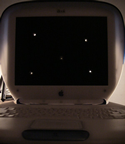
5G
5G :: While the sixth Guggenheim Museum was under construction in Mexico, in 2006, I captured data on the five existing Guggenheims. The traces of this very real course provide an echo of a possible virtual construction of a museum on a planetary scale, of which the Guggenheims are the symbol. The shift from a fluid architecture of the virtual to a reality of the constructed form takes shape in the final stage of my project in Paris, involving a 3D video animation created by Brian Bey, and a resin model, from 3D prototyping, in collaboration with the IDO company, that is based on the elements I brought together.
This 5G is composed of a photo, in conjunction with GPS coordinates showing the exact position of the images taken in front of the 5 Guggenheims in Berlin in June, Bilbao in July, New York and Las Vegas in August, and Venice in September. 5G thus defines itself as the outline for a performance-installation networking several sites on a global scale. A unique moment that is in symbiosis with the projected entity involving more than a hundred Guggenheims all over the world that is now being studied.
This project has already outlined the infinite scope for feasible artistic achievement in terms of the distribution and exchange of tomorrow's works of art, in the all-digital age. But it is also a tribute to the will of one woman, Peggy Guggenheim, that is directed towards artistic creation -- a woman who was cursed in the 20th century and is more than acknowledged today. For the transmutation of living forms involves an endless movement, and it is only this current epoch of ours that has established the bounds to be crossed.
Born in 1970, France, Franck Ancel lives in Paris. He has been exploring technology for more than fifteen years, tracing the development from the avant-gardes artists of the last century to the recent mutations of creation on a planetary scale. He has also organized and coordinated symposiums, expositions, and performances in cooperation with associations and institutions. The last one was a retrospective on Jacques Polieri, the creator of ”modern scenography,” at the BnF. Since the attacks of 9/11, Franck Ancel has set up an interactive triptych probing “architecture – image – technology” on 20th century heritage sites. In 2002, he put it in the Le Corbusier/Xenakis convent; in 2003 in a classified theater in Catalogne; and in 2004 on the screen of Montparnasse Tower in Paris. Franck Ancel challenges the viewer outside traditional frontiers, by projecting a setting of a network of information on screens. At the same time, he analyzes this technique on a more theoretical level in texts and talk. It encloses thus in 2005 a cycle of five communications for five continents with a world internet premiere from a plane flying from Shanghai to Munich. In 2006, he continues to open to the world with a digital capture in the world’s five Guggenheim museums and launches UFOs on this website remixarts.com
Posted by jo at 02:53 PM | Comments (0)
November 22, 2006
Cemetery 2.0
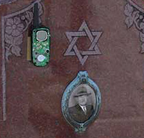
Physical/Virtual Memorial
Cemetery 2.0 is an interesting work wirelessly networking the grave of Hyman Victor (the great-grandfather of the artist) in Chicago with some online information about him and his life, photographs of his life, a copy of his entry into the largest genealogical database in the world, a link to the family tree of the Jewish People etc.
Cemetry 2.0 is very much a personal exploratory work for the artist [Elliott Malkin], getting to know his great-grandfather (and his family history) and it employs technology to that end. It documents his research but also creates a memory which can permeate and persist beyond any physical media (an actual photograph and it’s siting in say a family album), the memory of any single person (relatives), any physical location (the grave itself) and yet ensures that the grave, the physical memorial, is the place and link to the virtual memorial.
The work, while not using RFID technology, is a work of object hyperlinking. It employs radio frequencies and so shares many of the ideals and [dis]utopian visions we are currently seeing written about the coming, Internet of Things, the benefit of things becoming active in networks and the drawbacks of people being always on[line], always possibly to find and surveil. Comparable work to Cemetry 2.0 includes Semapedia, the object hyperlinking project based around wikipedia. However while this is an application of what is hoped will be a practical technology and raises questions (good and bad) depending on what (or who) is tagged and of course who on wikipedia documents it (amidst claims that wikipedia has accuracy issues and is monopolised), Cemetry 2.0 mangaes to sidestep many if not all of these concerns, in what is already a delicate subject, to truly create a sensitive and personalised new media.
Note: This work has very much the feel of Christian Boltanski’s work (interview on youtube - 1, 2, 3, 4, 5, 6) in the way it tackles memory and the ‘artifacts’ we associate with remembering.
Work reviewed at We Make Money Not Art. [bogged by Garrett on Networked Research] [Related]
Posted by jo at 04:16 PM | Comments (0)
November 20, 2006
Defining Lines:

Breaking Down Borders
[image: National Velvet by David Crawford] Defining Lines: Breaking Down Borders :: This exhibition will attempt to present a comprehensive survey of the work of artists who are breaking down the borders or boundaries that define artistic practise in the 21st century. From the computer DESKTOP, to DOWNLOADABLE COMPUTER VIRUSES, OPEN SOURCE AND CODE CRACKING SOFTWARE, and E-BOOKS, to ALTERNATIVE NETWORK BROWSERS, OPERATING SYSTEMS and SHAREWARE/FREEWARE, DOMAIN NAME SERVERS, to GAMING PATCHES, LISTSERVS, ONLINE THEATER (in the form of activism, or ELECTRONIC PROTEST) -- what constitutes "ART" is being re-defined as EMERGING TECHNOLOGIES and mediums are giving artists the "TOOLS" and a new means of expression. In addition, our notions or definitions of the tangible, physical "BORDER" "TERRITORY" or "OWNERSHIP / PROPERTY" is being transformed in the virtual realm of cyberspace. The idea of territory becomes one of "INTELLECTUAL PROPERTY" and "COPYRIGHT / LEFT". Geopolitical, and topographical territories are being replaced with domain of the Corporations and Governmental Agencies (ICANN) who control the "space" of the World Wide Web. Borders existing on the network, tracing the idea of "open" borders vs. "closed" borders, similarly we look at "firewalls", "encryption", "carnivore"; in contrast to "open source", "General Public License" (and therefore the ideas of "authorship") "sharing of files", "data transfer". The "SERVER" or "HARD DRIVE" as the new territory where "HACKING" and "ART" exchange fertile ground in the realm of the digital NETWORK we know as the Internet. Artists and Activists have their say in the wide open territory of the WWW, creating a hybrid art form called "PRACTIVISM" (Paul Garrin). Hackers and Activists merge and become "HACKTIVISTS" (Electronic Disturbance Theater). A new form of electronic theater or digital performance art is developing, that of the Online Protest, or "VIRTUAL SIT-IN".
At the beginning of the 21st century, we see that the words of Joseph Beuys has its corollary in the electronic realm:
"...Social Sculpture--how we mold and shape the world in which we live: SCULPTURE AS AN EVOLUTIONARY PROCESS; EVERYONE IS AN ARTIST...All around us the fundamentals of life are crying out to be shaped, or created." -Joseph Beuys
ARTISTS:
0100101110101101.ORG
Mark Amerika
Betty Beaumont
C5 Corp
David Crawford
Douglas Davis
Andy Deck
Electronic Disturbance Theater(EDT)
Epidemic-C / 0100101110101101.ORG
Fakeshop
Peter Fend
Joy Garnett
Paul Garrin
Marina Grzinic & Aina Smid
Wenda Gu
Ingo Gunther
Fran Ilich
I/O/D
Irational.org
Jodi.org
Eduardo Kac
Yael Kanarek
Knowbotic Research
Tina LaPorta
Jenny Marketou
Jennifer + Kevin McCoy
MEZ (aka Mary-Anne Breeze)
Mark Napier
Netochka Nezvanova
Marko Peljhan
RTMark
Scanner (aka Robin Rimbaud)
Linus Torvalds + others
Stephen Vitiello
Ade Ward
Posted by jo at 02:19 PM | Comments (0)
November 18, 2006
Franck Ancel
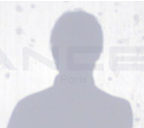
Tuut: Utopia of Theater
"Studying the terrain, the litterateurs believe they have established the existence of a major psycho-geographic crossroads — with Ledoux's Rotonde de la Villette at the centre – which can be described as a unity…" - the journal Les Lèvres nues, November 1956, Paris.
Mobile_Wireless_Digitale, for the bicentenary of the death of the utopian architect Claude Nicolas Ledoux in Paris, faced with the extension of the Cité des Sciences et de la Musique. I am no longer drafting a utopian performance which could have involved an immersive projection (cf. estimate drawn up with the UTRAM company) within Ledoux's Rotonde, and have been made possible by means of an inflatable dome (cf. study by another company), as conceived by me since 2001.
In contrast with some of the anticipated utilitarian hijackings aimed at establishing a modicum of social aesthetics on the square that is dedicated to the battle of Stalingrad in Paris, my idea involved a light and sound projection at the entrance to this capital: issues not only of physical fluidity but also fluidity of data. Thus, this space that traces the old boundaries closing in on the city, would be transformed by opening up the city, at a time when a dark globalisation is being prepared for us by some of the uses to which technology is being put.
I therefore propose an open-access 3gp stream broadcast from GPS co-ordinates N 48°53.365' E 002°22.555' to video receivers at this address: rtsp://217.71.210.164/ancel/19 , to other portables and on the Internet, on 19 November 2006 between 19:00 and 20:00 (Paris GMT). The 3D animation of this presentation has been created in association with Bryan Bey. It transfigures my Black Time epoch, for this action is primarily the echo of a manifesto for a Pari(s) lancé dans un lyrisme électronique (‘Paris (bet) cast in an electronic lyricism'), between active memory and the virtual future. - Franck Ancel
Posted by jo at 11:49 AM | Comments (0)
November 17, 2006
XpositionREVERSE
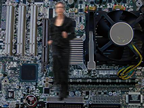
A Modern Gesamtkunstwerk
XpositionREVERSE :: Aarhus/Denmark – Gothenburg/Sweden :: Real-time streaming: web :: November 29 -December 2; 8 p.m.
XpositionREVERSE is a live digital chamber performance about position and identity on and with the Internet. Presented simultaneously in Aarhus and Gothenburg, and streamed on the Internet, XpositionREVERSE s a surrealistic and humorous montage of new text, dance, video, electro acoustic music and streamed bits. A modern Gesamtkunstwerk, placing itself somewhere between installation and the intimate chamber play. Inspired by cabaret, sitcoms and cosy evenings in the sofa.
XpositionREVERSE is a complex creation about being outside and excluded contra to be inside and included. About being in the centre of the events contra being in the periphery. The performance is about the modern man’s need to be "on" and wish for "15 minutes of fame". But do we only exist if we are seen, filmed and are placed in the focus point of the media lens? What defines centre and where is it placed? And what will happen, if focus is moved and periphery and centre is swapping place?
To be another place. Another position. Xposition.
To expose oneself. Exposure. Exposition.
PARTICIPANTS IN AARHUS
Staging, choreography and performer: Annika B. Lewis
Dramatist and performer: Gritt Uldall-Jessen
Interactive media and set design: Signe Klejs
Composer and live music: Anders Krøyer
Video technique and live music: Jens Mønsted
Internet architect and streaming: Jonas Smedegaard
For more information about live location in Aarhus and ticket reservations contact EntréScenen: phone: +45 86 190079 (10 – 16)
Produced by Kassandra Production in collaboration with Atalante in Gothenburg and EntréScenen in Aarhus, with others. Subsidized by The Municipality of Aarhus’ Kulturudviklingspulje, Koda, Dansk Skuespillerforbund and Tuborgfondet, with others.
Posted by jo at 12:34 PM | Comments (0)
November 14, 2006
NOTHING TO SEE
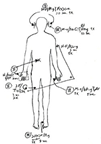
for the sense of touch
NewYorkRioTokyo e.V. :: NOTHING TO SEE: Piece touchee, No 1: a performance exclusively for the sense of touch. Being the interface: Touch is the most strictly codified sense in our society. This performance is an attempt at designing work to be perceived only through the sense of touch, beyond its usual connotations .
The piece will be performed on your body. (Duration 15 to 20 minutes). You will not be asked to be active. Please make an appointment either by email or by
phone in order to avoid waiting times: 0163-235-1869, piece.touchee[at]web.de
Performances possible every day, from 11.00 to 22.00 from Thursday November 16 to Sunday november 19, 2006.
Concept: Kenji Ouellet
Performance: Katharina Weinhuber, Kenji Ouellet
Kontrapunktus I, II: contrapuntal soundscapes (pieces for headphones)
Composition: Kenji Ouellet
Opening talk/discussion (and drinks) Thursday November 16, 19.00 (but performances possible before the discussion all day thursday).
NewYorkRioTokyo e.V.
Eberswalderstrasse 4, 10437 Berlin
www.nyrt.net
Posted by jo at 10:34 AM | Comments (0)
November 10, 2006
Interface and Society
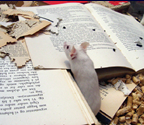
AbA Logic + Superconsumer
AbA Logic by Art by Accident (Kalle Grude, Jan Løchstøer) :: Six Muses of Randomness: Six white mice reside among books on logic subjects inside a laboratory cabinet. What are they doing there? Well, obviously they are nibbling on the books. Apparently they are nesting, as in quiet moments they cuddle up in a ball beneath snippets of logic. As they wander among the books they trigger a databank of words connected to electronic boards. The boards make up two sentences of three words each (so-called AbA-logic statements). Each time a mouse triggers a sensor, a new statement appears. The words (adjectives, adverbs and nouns) are common in logic terminology. The statements that appear are less common. This is why they are of interest to us.
In order to materialize this constant stream of statements, they are printed as they appear. On AbA’s desk piles of sketches and notes from the process accumulates. In addition to participate in a digital process, the mice -through their nibbling- are creating sculptural rephrasing of the books, and produce new combinations of the texts and illustrations from the pages of the books.
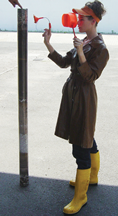
Superconsumer by Franz Alken and Karl Rueskaefer :: What happens when a computer programme starts buying and selling stuff on Internet auctions like ebay autonomously? That is the key question of superconsumers. The stuff the Bot has bought is exhibited for a short time. Thus digital values are translated into tangible goods. And vice versa, since the Bot sells them again after a while to buy new ones. In this way, commonplace products are temporarily translated into works of art.
The basic principle of superconsumers, is to make an amount of money available to a software (a so called “bot”). The software uses this money to buy goods autonomously at the online-auction-platform ebay, transfers these goods to an art-space, exhibits them and sells them again via ebay. The exhibition-module consists of a computer-interface displaying the softwares actions at ebay, 7 pedestals that show the current goods and a watchmann who executes the software’s instructions and arranges the goods on the pedestals. There are mainly 4 points that form a fascintation for this project: The relationship between humans and machines - the bot replaces exemplarily the role of humans in the ebay environment.
The ready-made principle: While transferring ordinary objects from the mass-market to an art space, the bot enhances the objects to pieces of art. This enhancement is temporarily, the bot takes away the “art aura” by selling these pieces again via ebay.
The installation gives a constantly updated overview on the mass-market. The programming of the process makes the items the bot will buy unpredictable - a search on the topic “football” can respond items like fan-articles, computer games, books or sportswear. Interaction is an important point on art-projects dealing with the internet. The interaction at superconsumers is quite hidden: Everyone dealing with the bot at ebay is arranging the exhibition without knowing it.
More about Interface and Society [PDF]
Posted by jo at 04:57 PM | Comments (0)
November 09, 2006
Ricardo Miranda Zúñiga
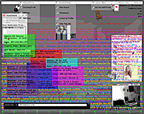
net.art as on-line activism
"Introduction: Over the last ten years, the Internet has embedded itself in the daily lives of a vast number of people. As a new telecommunication technology, it allows the common individual to engage in a cybernetic system that is globally networked. Today, however, a race goes on to establish the social dynamics of the Internet as a public arena. Will cyberspace become a highly monitored and regionalized control space or will the Internet retain its radical potential for independent endeavors and ideological exchange? The political implications of the Internet as a social network present rich issues for creative and critical cultural production.
The nature of the Internet as a network of connected computers to exchange information engenders a sense of liberty and freedom in the individual. Early in its development, mainframe teams established host-to-host protocols such as Telnet and File Transfer Protocol (FTP) that decentralized computer networking between independent users from the main frame.1 As the network grew it evolved into a new, democratic public sphere of communication via a globally expansive routing system and a vast array of on-line applications, amongst them electronic mail, and the world wide web.2 The individual was able to interface with an enlarged public, and a new dialogical space emerged.
Given the numerous forms of exchange possible via the Internet, on-line activity parallels Nancy Faser’s re-articulation of Jürgen Habermas’s public sphere as put forth in his 1962 book, The Structural Transformation of the Public Sphere. Habermas presents the public sphere as a bourgeois arena for exchange where citizens may discuss common affairs, a model based in the old town hall. In the essay, “Rethinking the Public Sphere” (1993), Nancy Fraser updates and expands the Habermasian public sphere beyond institutionalized public forums to include the market place and the domestic space (specifically in relation to domestic violence). Whereas, Habermas places market relations and domestic issues within the private sector, Fraser argues that, in doing so, these arenas of human interaction are restricted from “legitimate public contestation.”3 Fraser’s re-articulation expands the public sphere beyond the bourgeois domain to a space that is “open and accessible to all.” As the Internet becomes increasingly commonplace and interweaves itself into general daily life in such forms as list serves, chat rooms, gaming communities, a host of multi-user domains it springs to life a multiplicity of publics by Fraser’s definition.
Each public sphere is part of a civil domain that is governed by a set of laws and policies. Therefore, just as any civil, public space, the Internet must have its own set of policies that mirror those of our physical space. Amongst the on-line policies and regulations currently being established are decisions pertaining to appropriate policing and monitoring of cyber space, and determining the boundaries of privacy in a networked society.
The very nature of the Internet presents a highly efficient means of surveillance, as a networked electronic system that interfaces logical indexing machines, the computer. The ability to digitize nearly all types of records in conjunction with the computer’s indexing and networking efficiency has established the database as the most advanced archival utility.
Use of such emergent technologies has been a long time goal by policing authorities. In the essay “The Body and the Archive,” Allan Sekula traces in detail the use of photography to document, categorize and archive the human body by early criminology. As the body became a subject of the archive through photography, the fundamental problem of volume became apparent: “The early promise of photography had faded in the face of a massive and chaotic archive of images.” The electronic database’s vast storage capabilities solves the problem of volume. Hence, the photograph once used to document the body and help establish identity is replaced by data. And as various types of data such as our home address, our shopping patterns, our level of institutionalized education, our employment and income, for example, are monitored and stored data becomes a basis of identity. The electronic network used to transfer data becomes a tool of investigation due to its potential for surveillance. The questions then arises: how far will police, federal and even corporate monitoring of the electronic sphere extend? How will we ever know its parameters? Is it a matter of trust or open systems or regulatory institutions? Where and how will the lines of personal and civil rights be drawn in a networked society?
The questions surrounding on-line privacy are complex and encompass a wide number of issues such as ownership, which in itself introduces a chain of other questions. It is impossible to present an answer to these involved questions as they will continue to arise. However, I do contend that unless non-governing independent groups protect the Internet as a space for independent production, dissemination and open discourse, the radical potential of the Internet will be consumed, largely through its very nature. Therefore, if there exists today an artist avant-garde, looking to merge art with daily social life, it is the growing number of socially active artist engaged in cyber resistance as a critical practice in which the network and the database represent tools for engagement.
I will present two primary forms of resistance as executed through two artist projects. First, TO INFORM: Brooke Singer exposes her own electronic data to enlighten a general public of one’s freely available data. Second, TO SUBVERT: iSEE, a collaborative project between the Institute for Applied Autonomy and the Surveillance Camera Players makes use of the database structure to subvert the monitoring of the public sphere." Continue reading The Work of Artists in a Databased Society: net.art as on-line activism by Ricardo Miranda Zúñiga, NeMe.
Posted by jo at 04:00 PM | Comments (0)
November 08, 2006
Carlos Katastrofsky
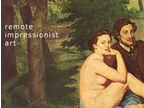
Two New Works
REMOTE IMPRESSIONIST ART: Remote Impressionist Art consists of a webpage with coloured squares in the center. Like a framed picture these colourfields are intended to transfer one principle of impressionism into the digital age: the emphasis on light in its changing qualities. Connected to different webcams in remote parts of the world the colours of the fields are determined by them. The automatic reload every 10 seconds lets you see always newly generated impressionist artworks. This is another free piece, accessible for everyone connected to the net.
CUMPUTER: Where is the art in the process of generating artificial images? Is it the programming of the algorithm generating the picture? Is it the algorithm "at work"? Or is it the result of this work? Is art in this context defined by the artist's choice for one or more of the results or by the interaction between the artist and the machine? All those conditions are possibilites to define the art in generated pictures. Are they art? [from netbehaviour]
Posted by jo at 11:26 AM | Comments (0)
November 07, 2006
Justin Hall's
Passively Multiplayer Online Games
Passively Multiplayer Online Games is a system for turning user data into ongoing play. Using computer and mobile phone surveillance, a user and their unique history. These resulting avatars can be viewed online, and they interact with other avatars online. Examples of data: web sites visited, email addresses, chat handles, contents of email or messaging, contents of word processed documents, digital images, digital video, video game moves. Examples of avatars: virtual pets, animals, virtual humans, virtual fantasy characters, secret agents, athletes, movie stars, famous people, gangsters, soldiers. Documentation (Quicktime). [via]
Posted by jo at 05:48 PM | Comments (0)
November 03, 2006
The Trinity Session
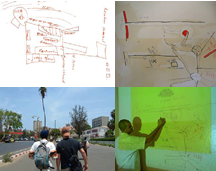
UrbaNET – Hillbrow / Dakar / Hillbrow
Inspired by encounters with francophone immigrants in Hillbrow (a neighbourhood of Johannesburg’s inner city, notorious today for its state of urban decay and influx of African immigrants) Stephen Hobbs and Marcus Neustetter (for their contribution to the Dak’Art Biennale ‘Off’ Programme) interviewed a group of Senegalese immigrants asking them to draw maps of Dakar, which Hobbs/Neustetter used to navigate the city during their two week residence in May 2006. The culminating exhibition at the Ker Thiossane residency space in Dakar presented a series of wall paintings and stills projections that reflected on the interactions and engagements resulting from navigating Dakar on foot and visiting colleagues and friends of the Senegalese immigrants.
Returning to Johannesburg, the project has been featured at the “Sightings / Site-ings of the African City” conference held at the Wits Institute of Social and Economic Research in June, and a project page has been commissioned for the September 2006 issue of Art South Africa. The project returned to the Senegalese Immigrants as an audio-visual presentation and action-reflection session (on the comparative findings between Johannesburg and Dakar) held at Chez Ntemba night-club in Hillbrow.
UrbaNET – Hillbrow / Dakar / Hillbrow will find its conclusion in a drawing, photography and video installation in Johannesburg in 2007. Download: project visuals.
Posted by jo at 03:53 PM | Comments (0)
Turbulence Commission:
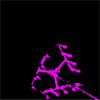
"Cell Tagging" by Brooke A. Knight
Turbulence Commission: Cell Tagging by Brooke A. Knight :: The mobile phone occupies a space that is both connecting and distancing. Seemingly ubiquitous, it has become an increasingly powerful tool, functioning as a phone, PDA, browser, and camera. With "Cell Tagging" it becomes a remote control that allows users to dial, draw, and speak. After dialing the number posted on the website, users are asked to enter a zip/city code that is significant to them. An aerial map of that place loads onto the screen. After choosing a color and brush size from the palette, users can use their cell phone keypads to draw directly onto the map. They are asked to speak into the phone and say why that place and drawing is meaningful to them. Users can save their drawings to the "Cell Tagging" database where others may view them. Cell phone users "graffiti" the sound-space around them, making every place their own. "Cell Tagging" literalizes this act of marking.
"Cell Tagging" is a 2006 commission of New Radio and Performing Arts, Inc., (aka Ether-Ore) for its Turbulence web site. It was made possible with funding from the LEF Foundation.
BIOGRAPHY
Brooke A. Knight is an artist and educator who has been working with digital media for over a dozen years. He has exhibited in over 40 international and regional venues, including Art Interactive, Photographic Resource Center, Mediaterra 2001, and Experimenta 02. His current areas of interest include webcams, the landscape, and text in all forms. Knight’s writings have been published in Art Journal and Sandbox. He is an Assistant Professor in the Department of Visual and Media Arts at Emerson College, where he teaches classes in interactive media.
Posted by jo at 10:20 AM | Comments (0)
November 01, 2006
1001 nights cast 501st Performance
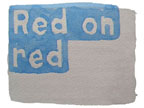
Call for Stories
1001 nights cast turns 501 this Friday 3 November. This is the half way milestone of the project. To celebrate the event I am calling upon newcomers everywhere to submit a story for that day. I will select the best to perform or I may even do a montage of several stories. So please spread the word to your writer friends.
If you want to tune in on Friday night, the live webcast will be at 7.25pm from Sydney. That is 4.25pm in Perth, Manila, Hong Kong and Singapore; 10:25am in Beirut, Jerusalem and Istanbul; 9:25am in Madrid, Paris and Berlin; 8:25am in London and Portugal; 3:25am in New York, Toronto and Bogota; 12:25am in Los Angeles.
You might like to listen to The Book Show on ABC Radio National on Thursday 2 November at 10am when I perform one of Anne Brennan's stories and she and I talk to one of the producers about the project. There will also be a piece in the arts pages of the Sydney Morning Herald on Friday 3 November (so I'm told).
Meanwhile, here are some statistics about the project to date: 133 writers have contributed since performance #0001 on June 21 2005. Together they have written about 425,000 words. At the average novel length of 80,000 that is more than 5 novels worth, all archived on the site for you to read. To this point, the site has had 23,780 visits. Currently, it is getting an average of 63 visits/day. Stories have been performed from Paris, Singapore, Sydney, Canberra, Brisbane, Melbourne, London, Madrid, Granada and a property outside of Dungog, New South Wales (thanks to a satellite dish).
On the sobering side, I have read reports every day covering contemporary events in the Middle East in order to give writers their writing prompt. To recap on some of the things that have been told to us by journalists working for western media outlets: The coalition forces in Iraq have found no weapons of mass destruction and Saddam Hussein is still on trial for genocide. Meanwhile more than 100 Iraqi civilians are killed every day - many more if the report in The Lancet is to be believed (and why should it be discounted - the investigators were shown death certificates after all). There are now wars within wars in Iraq with no clear "strategies" for resolution. Former prime minister of Lebanon, Rafic Hariri, was assassinated, his killers still at large and Syria's involvement pointed to and denied. Hamas won the January elections in Palestine and for their voting sins, the US and Israel continue to enforce an economic blockade. The new Kadima party won the Israeli elections in March without the intellectual presence of its figurehead Ariel Sharon who still lies in a coma. Before this, some of the Israeli settlements in the West Bank were evacuated and bulldozed. Mahmoud Ahmadinejad has come to power in Iran and has been denying any sinister nuclear intentions ever since, much to the frustration of Washington who still refuses to have direct talks with Tehran. Condoleeza Rice has been earning lots of frequent flyer points. And freshest in our minds is the five week Israeli/Hezbollah conflict with cluster bombs lying unexploded in the fields of southern Lebanon. In reading through all these reports, I have implemented my own kind of self-censorship. It may give you some comfort to know that I do not draw any writing prompts from straight reportage of beheadings, suicide-bombings or body counts. To quote from story #495, I would feel like a "lammergeyer in Tyre". --Barbara Campbell
Posted by jo at 09:42 AM | Comments (0)
October 31, 2006
Synthecology
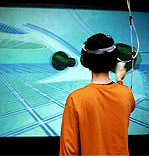
A Tele-Immersive Collaboration
Synthecology combines the possibilities of tele-immersive collaboration with a new architecture for virtual reality sound immersion to create a environment where musicians from all locations can interactively perform and create sonic environments.
Compose, sculpt, and improvise with other musicians and artists in an ephemeral garden of sonic lifeforms. Synthecology invites visitors in this digitally fertile space to create a musical sculpture of sythesized tones and sound samples provided by web inhabitants. Upon entering the garden, each participant can pluck contributed sounds from the air and plant them, wander the garden playing their own improvisation or collaborate with other participants to create/author a new composition.
As each new 'seed' is planted and grown, sculpted and played, this garden becomes both a musical instrument and a composition to be shared with the rest of the network. Every inhabitant creates, not just as an individual composer shaping their own themes, but as a collaborator in real time who is able to improvise new soundscapes in the garden by cooperating with other avatars from diverse geographical locations.
Virtual participants are fully immersed in the garden landscape through the use of passive stereoscopic technology and spatialized audio to create a networked tele-immersive environment where all inhabitants can collaborate, socialize and play. Guests from across the globe are similarly embodied as avatars through out this environment, each experiencing the audio and visual presence of the others.

Participants from the WWW use a browser interface to contribute sound elements to the garden environment for use as compositional items. All the while, this real-time composition is streamed through web broadcast of the virtual environment to illustrate the audio-visual transformation of the garden. Broadcast throughout the entirety of the festival, Synthecology will celebrate the possibilities of collaboration, improvisation, and distributed authorship that exist on the horizon of an increasingly interconnected world.
As current advances in networking become commonplace, the creation of collaborative environments connecting remote individuals will become less involved. By augmenting the possibilities for users to share sensory presence through tele-immersive interfaces, Applied Interactives intends to combine the possibilities of real-time collaboration and socialization with the dynamics of digital creation and manipulation. Synthecology is a speculative glance at how the technology of today may be utilized to create new autonomous zones for sampling & re-mixing culture.
COLLABORATORS
Synthecology is being created as a collaboration of students and faculty from the Electronic Visualization Laboratory at the University of Illinois at Chicago, The School of the Art Institute of Chicago, and Columbia College Chicago, and art(n) through the Applied Interactives organization.
ABOUT APPLIED INTERACTIVES
The purpose of Applied Interactives, NFP is to educate the art and science community about the medium of Virtual Reality as an interactive, computer-generated, immersive computer graphics environment. Applied Interactives, NFP plans to advance the medium through research and experimentation as well as provide a bridge to bring the technology out of institutional labs and into more publicly accessible arenas. Applied Interactives, NFP intends to propagate the medium by providing support and direct access to the resources necessary for artists and scientists to exhibit and develop works in the medium.
Posted by jo at 03:44 PM | Comments (0)
Christophe Bruno (2004-2006)
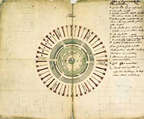
The Web before the Web
The Web before the Web :: Christophe Bruno (2004-2006) :: James Joyce, Jeremy Bentham, Edgar Allan Poe, Stéphane Mallarmé, Alan Turing, Georges Perec & Marcel Bénabou, Stanley Milgram, Frederick Taylor, The Great Chain of Being, The Web after the Web.
In September 2004 Bruno was a guest-blogger for the French online magazine fluctuat.net. He wrote a series of short posts about what could be called "the precursors of the Web"... or "the Web minus the technology". (the posts in french are here.)
Here is an augmented and updated version in English.
To be published in the magazine for art and new media Aminima N°20.
Posted by jo at 10:54 AM | Comments (0)
November

An Online Networked Performance TONIGHT!
November: An online Networked Performance :: Join us as we cast out the stale air of the fading summer and move together into winter. Celebrating Halloween and the changing of the season, we come together online to exchange our collected thoughts across the Internet whilst each eating garlic cloves.
This networked performance by Patrick Simons and Kate Southworth (glorious ninth) in collaboration with Ruth Catlow and Marc Garrett (Furtherfield.org) will be launched at: - Time: 9 minutes and 41 seconds before midnight (GMT) :: Date: 31st October 2006 :: Location: http://november.gloriousninth.net
NOVEMBER is a performance that utilises peer-to-peer instant messaging technology, and the participants were able to see and hear each other on their computers throughout. Working with their own pre-chosen texts, each participant alternated between reading aloud and listening, amending and improvising their performances in response to each other. At times a cacophony of competing voices, the performance was a spontaneous and unrehearsed encounter, exposing moments of vulnerability, intimacy, connection and rhythm.
Posted by jo at 08:57 AM | Comments (0)
October 30, 2006
net.tv

An Art Browser (browser as art work)
Net.tv, by Garrett Lynch, is a cross between a browser and a streaming media player designed to view the internet as it really is, code or more specifically markup, not a series of web pages designed under a print metaphor. It makes no attempt to interpret the code into an organised layout as do conventional browsers, instead it displays the code as an audio-visual stream of indeterminate length.
Why reduce the internet to an audio-visual stream? Simply to provoke thought around our use and consumption of different media, linear push media such as television and non-linear interactive pull media such as websites, which have been converging for sometime now. Net.tv's purpose is to highlight the way we as users continually construct self made narratives when we use the internet through choices based on an interact / react model. It does this by removing our ability to chose and act on those choices. Users enter a chosen url, click go and from there on the experience of 'surfing' is automated and dictated by a preprogrammed rule:
On start
{
retrieve webpage url entered.
Visualise webpage as an audio-visual stream.
Spider to first webpage url available on current webpage url.
Repeat while new url available.
}
When we use a browser to surf the internet what we view and how we view it is controlled by the browser. It functions as a framing mechanism and for net.art this can be considered a problem or challenge depending on your point of view. The creation of a browser as a work of net.art allows an artist to not alone create an artwork but control how and under what conditions it will be viewed.
"After the first experiments with web sites, the browser rapidly became the unavoidable framework for Net art [sic] in the eyes of the artists. Webstalker, created by the London-based art group I/O/D and introduced in the first part of net.art, was the first 'art browser' to call into question the conventions of representation on the internet on a much more fundamental level than any work on the web was able to. After Webstalker, a whole series of art browsers appeared...they show precisely what 'normaly' browsers try to hide. Instead of Web sites with pretty designs, one sees what lies beneth the surface: the code the pages have been written in and the structure of the Web sites appearing on the screen as complex diagrams which most definitely have their own aesthetic appeal." (Baumgärtel, T. 2001)
By denying the user any possibility of interaction with or control over browsing content when using net.tv, the possibility to surf the internet, the user is in fact denied the status of user and becomes simply a spectator of a broadcast medium much like television. Web pages, net.art works themselves (including the artists own) become input, the equivalent of a signal for the browser, suppling a constant feed of content which controls the browser and the path it takes through the internet. Linking from page to page or site to site is no longer a controlled or chosen decision by the user. Instead the application decides constantly spiraling off onto new pages as soon as it finds a link.
Unlike most browsers which exist and are defined by the content they depict, their message, the internet as viewed / interpreted through net.tv is no longer a source of information. It is a browser which is viewed solely for its aesthetic form, an abstracted composition of sounds and images.
Net.tv is available to download for Mac OSX 10.2+, Mac OS 8/9 and Windows 98 / Millennium Edition / NT 4.0 / 2000, or XP from the artists website.
a+
gar
Garrett[at]asquare.org
http://www.asquare.org/
Posted by jo at 03:59 PM | Comments (0)
October 26, 2006
Noah Wardrip-Fruin
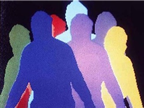
e and eyeToy
Noah Wardrip-Fruin's contribution to the Tate’s e and eye project has just gone live: “e and eyeToy.” Where else can you get Myron Krueger, Camille Utterback, Rafael Lozano-Hemmer, EyeToy: Play and much more all bundled into one short essay?
"The Tate's "material gestures" hang cuts across time, but I find my mind settles, first, on the moment of abstract expressionism in the U.S. This work brings the artist's gesture into a particular relationship with artworks shown in museums.
This might be contrasted with the nearby moment of the Happening - the attempt to incorporate the live gesture, including the audience gesture, into artwork that was self-consciously unshowable. The blurring of art and everyday life, as a book title of the Happening's most famous proponent would have it later.
Now we enter a moment in which, through interaction, we see the gesture of the audience being incorporated into showable art. This work moves beyond video art, which included the audience as an image of itself. Now the audience, while perhaps also visible as an image within the work, becomes data - one of the fundamental components of digital media. In work such as that selected by Camille Utterback for the "New Materiality" installment of "e and eye" the audience's gesture is seen to drive the work, to fundamentally produce what we see. The audience's gesture can drive the work by providing data because the artist has begun to work with a particular material: digital computation." Continue reading e and eyeToy by Noah Wardrip-Fruin. [via]
Posted by jo at 03:42 PM | Comments (0)
October 24, 2006
Turbulence Artist’s Studio:
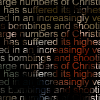
"Headlines" by Michael Takeo Magruder
Turbulence Artists' Studios: Headlines by Michael Takeo Magruder [Needs Flash Player 7] :: Headlines examines the mediated histories generated by today’s news corporations and reflects upon our collective preoccupation with real-time information generation, distribution and access. Given the developed world’s countless network structures and our current state of data saturation, has news media evolved beyond mere information source and become a new form of cultural stimulant?
Headlines was created for OOG, a commentary and opinion platform for the online edition of De Volkskrant a major Dutch daily national newspaper. "OOG" began in September 2005 as a platform in which every week a different artist working in sound and image is asked to respond to news and current affairs. The selection of artists participating has grown into a varied group of national and international artists working with very different forms of expertise and approaches. In this way, artists are using their skills to become commentators on events in a news environment. After each week, the work is placed in the archive.
The artists participating in "OOG" are a diverse and renowned group of applied and autonomous artists both from inside and outside The Netherlands. "OOG" is one of the most visited pages within the Volkskrant website with weekly visits of 3,000-5,000.
BIOGRAPHY
Michael Takeo Magruder is an American artist based in the UK deploying New and Technological Media within Fine Art contexts. He graduated from the University of Virginia in 1996 receiving a BA (Hons) in Biological Science. He is a long-standing member of King's Visualization Lab in the Centre for Computing in Humanities, King's College London. Through this organization he undertakes research, development and implementation of emerging technologies; including motion capture, immersive space and virtual environments, for use in contemporary creative and academic practice.
Takeo’s artworks have been showcased in over 150 exhibitions and 25 countries, including venues such as the Courtauld Institute of Art, London, EAST International 2005, Tokyo Metropolitan Museum of Photography and Trans-Media-Akademie Hellerau. His works are regular inclusions in international New Media festivals, such as Cybersonica, CYNETart, FILE, Filmwinter, SeNef, Siggraph and Split. His artistic practice has been funded directly by Arts Council England, The National Endowment for the Arts, USA and numerous public galleries both within the UK and abroad. He is also recognized for his on-line arts practice and has been commissioned by leading portals for Internet Art such as Turbulence.org and Soundtoys.net. As artist/curator, he has been responsible for the internationally-renowned touring exhibitions, Net:Reality, the Cyber-Kitchen and Spectrum.
Artistically, his current interests concern the simultaneous utilization and dissection of new technology as a means to explore the formal structures and conceptual paradigms of the digital realm. He seeks to create artworks in which there are no divisions between technologies, aesthetics, and concepts.
Posted by jo at 11:16 AM | Comments (0)
Katy Shepherd's
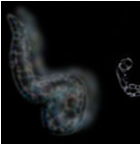
Vitreous Humour Project
In this age of "high definition" I have taken a contrary interest in technology's failings, for example the way certain camera film has colour biases, scratches and glitches on the surface / distortions of brightness and contrast / flickering / dropped frames when a computer plays back. Consequently I have developed a fascination in the parallel limitations of an artist as a fallible mortal, in particular the inadequacies of memory and eyesight.
Is it a common held belief that an artist is born with the talent to see the world differently to others? - more vividly perhaps, a heightened experience? - with more insight? - they are more visually aware? - they are gifted? They are able to see beauty and design where others see the everyday? An onerous responsibility I think. What are the public's expectations of an artist?
The Vitreous Humour project will allow people to explore these beliefs (myths?) by enabling them to view their own images through the eyes of an artist - my eyes.
I have particles in my eyes called floaters that move around in the fluid of my eyes - the vitreous humour. They are very common, many people have them but of course each person's are individual to themselves. "Floaters" are the shadows cast on the retina of the microscopic structures in the vitreous humour. Some of these may be due to condensations of vitreous collagen which degenerates with age - creating increasing numbers of floaters. These may look like specks, worms, single or clumped, hair - like, forms. Others may be remnants of debris from the hyaloid artery that nourishes the eye of the foetus but starts to disintegrate by the seventh month of development. It disappears by birth bar a small amount of debris inside the eye.
Floaters are easier to see if you lie on a bed and look at a diffusely illuminated ceiling or a bright sky. However they are constantly falling away from the centre of the eye so can only be seen clearly for a brief moment. If your eyes move more quickly the floaters will flick around your eye, rushing to keep up with the movement but always slightly behind or overshooting it. This flickering movement gave rise to the latin name - muscae volitantes - fluttering flies.
I have attempted to create my own elusive shadows as digital entities. "Vitreous Humour" the film is an animation of my eyes examining , in close up, a family snap of myself as a new born baby (taken 1961). The photo appears as if seen through my eyes. It is a self portrait - of sorts.
Secondly there is a program to download that enables you to view your own images as if through my eyes. It will certainly be a unique vision but whether this will enhance or degrade the image I couldn't say.
Posted by jo at 10:02 AM | Comments (0)
October 20, 2006
Ah-ha: Narrative Structures in Reactive and Interactive Video Art

Connecting the Physical and the Digital
[Image left: "Guillotine" by Steve Shoffner) "Performance is so many things: the synchronized sounds of a symphony; actions with words in a play; steps and turns in a dance; words from a pulpit. Performance art, too, is variable, perhaps too multifarious to define, even with semicolons. At traditional performances with traditional support materials, from symphonies with program notes to theatre productions with playbills, performance acts as replay, a repeat of an event, a memorization of a string of notes or a set of lines, a reformulation of a tested formula. Then there are those performances that vary, that respond to the moment, that unfold through the implementation of chance or improvisation or, more and more, digitization. With the insertion of new technologies into performance, the question arises – do actions result from numbers? What indeed is the connection between the physical and the digital? Does the digital component determine the performance, or do actions generate a numeric pattern, which then underlies the piece's structure?
The aesthetic and conceptual import of digital performance pieces is linked to the ordering of a piece's technological components. Random sequencing is one form of structuring immersive environments or data-triggered scenes. Fixed sequencing of scenes, with a predetermined index of performed actions and triggered events, follows a preset score. Alternately, sensory responsive improvisation is flexible and often produces variations in structure. In each case, the piece's content is the result of a digital system: programming or computer responses to external stimuli determine how the performance plays out. Even interactive improvisation, in which a human action triggers a computerized event, is a digital system, albeit one that emphasizes the human element, or input, in that system. The content of an interactive piece is closely related to its structure – the interaction between trigger, whether generated by the viewer or performer, and event. Interesting variations in content emerge when the structure becomes the art.
Below, by electronic interview, four new media artists describe their modes of working with interactive technologies and probe the relationship between order and content in their work. Johannes Birringer makes telematic connections in performance, installation, and video. Mark Coniglio co-directs the interactive dance company, Troika Ranch, with Dawn Stoppiello; he both designed and implements the interactive software, Isadora. Cat Jones' alternate persona catgURL interacts with viewers while performing live on and off the screen. Steve Shoffner instigates interactions with viewers while performing simultaneously on video and within his installations." From Ah-ha: Narrative Structures in Reactive and Interactive Video Art by L. Hermes Griesbach, VJ Theory: ART, 12/10/06.
Posted by jo at 02:29 PM | Comments (0)
Andy Deck
Archived Performance at VisitorsStudio

Every now and then somemof the Furtherfield crew review some of the
archived content on the VisitorsStudio. Some times by projecting it up
on as wall whilst consuming coffee or alcohol in the studio at Furtherfield.
Earlier today we came across an archived performance by Andy Deck in the
VisitorsStudio - and thought, this is pretty decent work.
- Turn the volume up and give it a few seconds to load, and then just
sit back and enjoy... [Marc Garrett]
Posted by jo at 08:50 AM | Comments (0)
October 19, 2006
From The Great Beyond
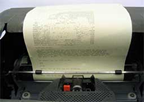
Talking with the Internet
Is the Internet becoming an entity? If the answer is positive, what are the characteristics of this being?, wonders Fang-Yu Lin. Inspired by the Turing Test, he designed From The Great Beyond, a typerwriter that has (seemingly) a life of its own.
By typing on the keyboard of the custom robotic typewriter, you are able to "chat" with the Internet while the background application searches online resources for response. There's not screen, the typewriter automatically prints out the resulting text or ASCII art on a paper roll for you to view or keep. Be it whimsical, intelligent or simply irrelevant, the typed words of the Internet reveal a fragment of truth regarding itself.
The existence of an invisible entity is suggested by the noise of the typing and flowing responses spit out from the typewriter. Video. Via exibart.
More typewriter: TTSM (Typewriter Tracklog Sewing Machine), by Alejandro Duque, uses a GPS device to track and save the data of a journey without destination; 22POP is a typewriter that sends typed letters as emails to your destinary; Life Writer turns the letters typed into artificial life creatures that appear to float on the paper of the machine. Also: The Universal Digest Machine features a web spider that crawls the net, digesting web pages, outputting a brief analysis of their contents and printing it on a receipt. [blogged by Regine on we-make-money-not-art]
Posted by jo at 08:25 AM | Comments (0)
October 18, 2006
Coke Is It
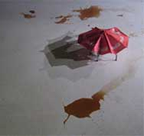
Suicidal Robot
Coke Is It, by SWAMP, is a robotic performance, a comment on the marketing strategies deployed by companies such as Coca Cola. They infuse our culture with a sense of well being and elevated self worth that contradicts the actual benefits of the consumable product.
C3 is a hex-crawler robot, outfitted with a CMUcam and sensors, enabling it with the ability to search and find puddles of Coca Cola placed on the gallery floor. When C3 finds a puddle of coke, it sucks the beverage up through an electrical pump, and then sprays it across itself. After several feedings, the acidic nature of the coke eventually eats through the robots skin. Eventually this "digestive" process finds its way to the circuitry, causing it to break down.
The performance concludes when the robot is consumed to the point where it has killed itself. Video. Suicide in media art: Kurt Cobain's Suicide letter meets google adsense; Suicide Solution, a DVD documentation collected over a year of committing suicide in over 50 first and third person shooter games; and The Lovers, two networked machines, one infected with a virus, slowly infecting the other through the interface of classic romantic poetry. [blogged by Regine on we-make-money-not-art]
Posted by jo at 11:37 AM | Comments (0)
October 16, 2006
Oppera Internettikka - Protection et Sécurité
![]()
FearingS
What is fear? Why should you be afraid? What, who is to fear? Where does your fear come from? Participate in creating a collective voice about "fear". Help reveal its actual tendencies.
FearingS is a part of the project Oppera Internettikka - Protection et Sécurité by Annie Abrahams & Igor Stromajer.
Oppera Internettikka - Protection et Sécurité explores the poetics of a contemporary sound form -- live opera as a sound event for the audience in the form of a live internet audio broadcasting. In that way it combines the notion of the world wide web communication protocols and classical artspace -- an opera house. Opera is a very strictly coded form of art with a lot of passion, and internet is a lonely place of solitude and intimate communication which is becoming more and more fragile, dangerous and suspicious.
The theme of the project is security and protection, which refers both to private and personal safety issues in the present post-WTC world of high and intense but questionable security measures and to the internet as a global and therefore extremely vulnerable and unstable communication tool.
Three artists with specific roles (artist Annie Abrahams as mutter courage, intimate mobile communication artist Igor Stromajer as bigbrother and professional opera singer as French secret service agent) are performing a complex structure combined of sounds, voices, noises, internet audio files and sound-manipulating machines and are using these sounds to perform/sing/reproduce a story for the audience present in the opera house, and for those following the audio part of the project live on the internet worldwide.
The libretto for the opera is composed out of three sources -- mutter courage is using the texts written and proposed in advance by the online visitors, bigbrother's only lyrics comes from a web search engine which he is manipulating in realtime, and the secret service agent is singing the HTML source code (Hypertext Markup Language - the authoring software language used on the internet's world wide web for creating world wide web pages) and Java scripts (JavaScript is a script language - a system of programming codes that can be embedded into the HTML of a web page to add functionality) from specifically selected French secret service web sites, openly available on the internet.
It is a new media project filled with abstract emotions, created in a valuable tradition of Bauhaus musical theater mixed with Dada, sound poetry and contemporary digital means of expression. Therefore the location of L'Opéra National de Montpellier has been selected to emphasize our efforts of introducing new artistic forms and production processes to the audience.
Project supported by The Ministry of Culture of the Republic of Slovenia, The Ministry of Culture of the Republic of France, The Municipality of Montpellier, The Council of the Languedoc-Roussillon region and Rhizome.org 2006-2007 Commissions. Co-produced by Intima Virtual Base (Slovenia), Panoplie.org & bram.org (France)
Posted by jo at 06:15 PM | Comments (0)
October 15, 2006
Turbulence Commission:
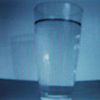
"Nothing Happens - a performance in three acts"
Turbulence Commission: Nothing Happens by Nurit Bar-Shai, Zachary Lieberman and Rich Miller :: Nothing Happens is a networked online performance in which the viewers work together to make a series of objects tip over. The performance consists of three acts, which are centered on staged environments – a high shelf, a cluttered tabletop, and a deserted corner. Each scene contains a central protagonist, respectively: a cardboard box, a clear pint glass full of water, and a wooden chair. In all three acts, web-enabled physical devices controlled by the viewer’s clicks will make these objects tip over.
The three acts will be presented on October 15th, 22nd and 29th at 3rd Ward gallery Brooklyn. Please join the artists for an opening reception Sunday, October 15, 2006 6-8 p.m.
"Nothing Happens" is a 2005 commission of New Radio and Performing Arts, Inc., (aka Ether-Ore) for its Turbulence web site. It was made possible with funding from The Greenwall Foundation. Additional support from 3rd Ward Gallery.
BIOGRAPHIES
NURIT BAR-SHAI'S main interest lies in exploring tensions between the mundane and the uncanny in everyday life. Emanating from her creative roots in fine arts, Bar-Shai employs video and new technologies to explore fundamental questions of presentation and representation, to reframe the familiar and turn audiences into foreigners in their own ontological domains.
ZACHARY LIEBERMAN'S work uses technology in a playful and enigmatic way to explore the nature of communication and the delicate boundary between the visible and the invisible. He creates performances, installations, and on-line works that investigate gestural input, augmentation of the body, and kinetic response.
RICH MILLER is a sculptor and a recent graduate of the Interactive Telecommunications Program at NYU. His creative energies are focused on making electro-mechanical pieces that humor him, as well as designing and fabricating innovative and dynamic children’s museum interactives and furniture. He lives and works in Astoria, NY.
Posted by jo at 02:15 PM | Comments (0)
October 14, 2006
Riot Gear for Rollartista
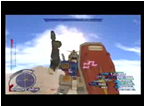
An Action Dedicated to African/Muslim Immigrants
Riot Gear for Rollartista: a blog and mobile gaming performance project by Anne-Marie Schleiner and Talice Lee. This blog is for posting information about a performance action we are doing in Castellon Spain on Saturday October 21, 2006 as part of an exhibition at EACC Espai d'Art Contemporani de Castell from October-January 2007. It will involve three short Machinima (stories told with video game footage) videos that will be beamed from an ultra-light projector stapped to one of our head helmets. (The videos are now linked from the blog to YouTube.) We sampled the two Playstation games Narc and MechWarrior. It sort of evolved into a violent (break) dance musical and each video is dedicated to an African or Muslim immigrant who was seriously abused by police in Spain or France. We, two American women in padded anime/riot gear/something else inspired moda, will be holding Playstation controllers and rollerskating at the same time, (and sometimes dancing), while we coast around projecting onto surfaces of the city.
After the performance/action we will also post documentation videos and photos on the blog.
Posted by jo at 01:01 PM | Comments (0)
October 09, 2006
Turbulence Commission:

"Self-Portrait" by Ethan Ham
Self-Portrait is a software search for the artist's face among the millions contained in the photos uploaded to www.flickr.com. The project's site displays three photos: 1) an ever-changing photo that depicts what is currently being evaluated by "Self-Portrait's" facial recognition software; 2) the most recent photo that was identified as containing a face. (The software often misses seeing faces and occasionally misidentifies an inanimate object as a face.); and 3) the most recent photo that has a high probability of depicting Ethan Ham (the artist). Clicking on this photo allows viewing earlier photos that were found to contain Ethan.
"Self-Portrait" is a 2006 commission of New Radio and Performing Arts, Inc., (aka Ether-Ore) for its Turbulence web site. It was made possible with funding from the Jerome Foundation.
Ethan Ham is a kinetic and new media artist who has recently moved to New York from Portland, Oregon. His projects often involve art generated by viewer participation, seemingly random events, and/or automated means. He is Assistant Professor of New Media at City College of New York, CUNY.
Posted by jo at 06:54 PM | Comments (0)
September 29, 2006
Kostas Daflos

Bodysmaze/Cibo _05
In Kostas Daflos' last visual art work Bodysmaze/ Cibo _05 which consists a performance machine for the production of virtual spaces, the specific site of the interactive installation reinforces the tangible urban public space. The human action is being captured by a web camera, which activates a programmed robot -unit and produces a thermoelectric, -liquid nebula environment, as an interface, which is the medium for the projection and the intermediary in the communication of our visual experience with the technological platform of the personal computer. In his former visual artworks as in Cipo _03 (and here), and its genuine descendant muscle- skeleton Cipo _04, he focused his research on visual plasticity, video-installations and interactive real environments, co-existing automatic intelligence' robotic objects with human beings and communicating via web cameras . His artworks expand the real space in the World Wide Web.
Architect - National Technical University of Athens (N.T.U.A.), School of Architecture, Sculptor -National Athens School of Fine Arts (A.S.F.A). Postgraduate Degree in «Digital Forms of Art», National Athens School of Fine Arts (A.S.F.A.), in collaboration with the Department of Computer & Information Science, Polytechnic School of Patras University.
He is a PHD Candidate at the N.T.U.A., School of Architecture. He focused his research on visual plasticity, video-installations and interactive real environments, where automatic intelligence’ robotic objects co-exist with human beings and communicate via web cameras. His artworks expand the real space in the World Wide Web.
Since 1997 he has participated: in several research programs, in conferences, in national and international architectural competitions with awards, national and international exhibitions. The areas of expertise include human computer interaction, computer mediated environments, new media, and interactive multimedia installations. His interest is to create a new class of “connected objects”. He is an author of a number of essays on contemporary architecture, arts and communications. He curates and participates in web sites with a personal theoretical and visual art work www.transitionalathens.com, www.apothecae.com. He teaches Visual Arts and Digital
Representations at the Polytechnic School of Patras University, Department of Architecture.
Posted by jo at 01:06 PM | Comments (0)
The Copy and Paste Show
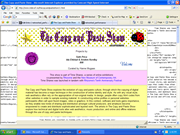
A Virtual Gallery in Brooklyn
Projects by Seth Price, Ida Ekblad & Anders Nordby and 808 :: Curated by Hanne Mugaas :: The Copy and Paste Show explores the evolution of copy-and-paste culture, through which the copying of digital material has become a major technique in the construction of online identity and style. As with any visual style, web aesthetics often rely on the appropriation of non-original media. In design, people often copy html codes from other websites in order to sample existing material. In constructing online profiles or personal websites, participants often call upon found images, video or graphics. In this context, software and tools gains importance, as they enable new kinds of sharing and distribution amongst cultural producers, and amateurs become empowered to create and distribute sophisticated and layered work. The artists in The Copy and Paste Show explore how technical and digital tools alter web aesthetics, music production, and online and offline relations through the use of copy and paste techniques.
This show is part of Time Shares, a series of online exhibitions co-presented by Rhizome and the New Museum of Contemporary Art. Time Shares was launched in tandem with Rhizome's Tenth Anniversary Festival.
Posted by jo at 12:43 PM | Comments (0)
September 27, 2006
New Media Poetics
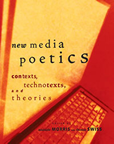
Poetry Composed, Disseminated, and Read on Computers
New Media Poetics edited by Adalaide Morris and Thomas Swiss :: New media poetry--poetry composed, disseminated, and read on computers--exists in various configurations, from electronic documents that can be navigated and/or rearranged by their "users" to kinetic, visual, and sound materials through online journals and archives like UbuWeb, PennSound, and the Electronic Poetry Center. Unlike mainstream print poetry, which assumes a bounded, coherent, and self-conscious speaker, new media poetry assumes a synergy between human beings and intelligent machines. The essays and artist statements in this volume explore this synergy's continuities and breaks with past poetic practices and its profound implications for the future.
By adding new media poetry to the study of hypertext narrative, interactive fiction, computer games, and other digital art forms, New Media Poetics extends our understanding of the computer as an expressive medium, showcases works that are visually arresting, aurally charged, and dynamic, and traces the lineage of new media poetry through print and sound poetics, procedural writing, gestural abstraction and conceptual art, and activist communities formed by emergent poetics.
Contributors:: Giselle Beiguelman, John Cayley, Alan Filreis, Loss Pequeño Glazier, Alan Golding, Kenneth Goldsmith, N. Katherine Hayles, Cynthia Lawson, Jennifer Ley, Talan Memmott, Adalaide Morris, Carrie Noland, Marjorie Perloff, William Poundstone, Martin Spinelli, Stephanie Strickland, Brian Kim Stefans, Barrett Watten, Darren Wershler-Henry
Adalaide Morris is John C. Gerber Professor of English at the University of Iowa, where Thomas Swiss is Professor of English and Rhetoric of Inquiry.
Thomas Swiss is Professor of English and Rhetoric of Inquiry at the University of Iowa.
June 2006
The MIT Press
A Leonardo Book
ISBN 0-262-13463-2. 416 pp., 92 illus.
Posted by jo at 11:49 AM | Comments (0)
September 26, 2006
Marco Villani
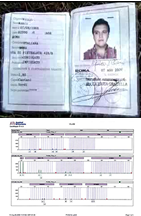
This is a net.art operation
Marco Villani's DNA has been analysed by the Forensic Science Laboratory of the University of Genova for identification purposes. Today, Villani will conduct a Net.art operation: he will put the results of his DNA profile online for people to download together with a text. Please e-mail him at info[at]marcovillani.net with your response; use "Dna on the net" in the subject line. Your comments will be posted on the site.
Also on the site is a video about the analysis of Villani's DNA with an interview to Doctor Simonetta Verdiani (on the site will be a little trailer).
This is an investigation into the concept of “Biopolitics” coined by the French philosopher Michel Foucault. It is a category which analyses the profound relationships that link the individual to power. This kind of link is based on a system of permanent reading of the subject in which science and technology converge. Every subject is a never-ending source of data which makes up an archive of knowledge through which it is possible to organise social behaviours. The topics range from demographics to psychology, psycho-attitudinal tests and medical tests.
HANGING ON A THREAD OF REALITY
Identity is the essence of a relationship, in which symbolic and biological systems and existential orbits tackling life’s complexities converge. The attractive pole around which these systems rotate is the subject, the termination declined according to the group of social-linguistic practices that form his or her ecological niche and take possession of the inner system. This process of appropriation is the place in which an individual is formed, in keeping with a social image. The desires that pulse in the body and the sadness that flows through it reside in the linguistic flows that are rooted within in his or her experience.
There’s no escape route towards an authenticity which isn’t an expression of the ability to decide, decided within the form of language. Strength works directly at primitive and unconscious level so that man perceives his inner qualities as natural as opposed to derived. But Self is a relationship. And it is from this characteristic that the possibility to communicate and receive communication germinates in bios, along with the possibility to be organised and dominated in keeping with the political ideas that man has expressed in the ages that have succeeded one another on the earth.
Biopolitics is the term used by Michel Foucault to describe this relationship. It indicates the dynamics through which the subject is possessed by the codes he or she has learned in order to observe the silence of things. These codes, added to the technical apparatus with which men surround themselves, are the shape taken on by collective behaviour.
The filing of the body and the analysis of the attitudes imprinted permanently on the individual by science, technique and jurisprudence, make up a technological device which allows the objectification of the subject in a complex combination of information, making social use possible.
This is possible because language acts as a code for the programming of behaviour and perception and its use by the subject as a model of cosmos does not fall within the scope of choice. It precedes choice in the same way that the fact that we are born with a body, two eyes, our own DNA and everything else precede choice. It isn’t possible to make a clear division between the biological level and linguistic level. There are numerous nuances that highlight how the linguistic aspect contains a biological residue and how the biological aspect contains a linguistic form. The Hopi tribes of New Mexico use a single term to describe blue and green together. This implies that their nervous perception identifies a single linguistic phenomenon, while our culture identifies two. In the same way, the Eskimos use twenty different words to say “white”.
Both of these dimensions are certain elements.
So is there a point of escape towards freedom? Towards choice?
This place is still the subject. The dimension of subjection to language and to the body as certain is realised within it, along with the possibility for criticism, which is born of the conjuncture with experience. It is here that language is exposed to the heterogeneous influence. And it is here that particles of entropy and desires collide with it, envelop it and cross it.
The inner dynamics of this process remain bio-linguistic, as there is no linguistic nudity. The reality we take possession of and which takes possession of us is, in any case, the result of a process of mediation implemented by a nervous system, whether it is linguistic, organic or both.
The profound structure that makes this kind of system possible is the fact that all things are part of a relationship. And this is the relationship between the already experienced aspect of language and the live experience of self, the original condition of the individual. A perpetual condition of crossing, of moving beyond, which is simply another way of staying put.
In this being constantly on the edge humanity becomes aware that it doesn’t have to realise any essence or substance or historical destiny. The apparatus that captivate it are always the ideological result of an historical conjuncture that carries individual and collective destinies within.
But destiny, seen from here, is a union of particles and, as such, has a place, a time and a body, which make it constantly up to date compared with all the magnetic flows which exercise their attraction upon it. This being up to date is the gap that blends the possibility of criticism and ethic experience.
Marco Villani, 2006
Posted by jo at 08:09 AM | Comments (0)
September 25, 2006
WJ-s

Web Performances in Real Space
WJ-s web performances in real space in Maribor and Ljubljana, Slovenia :: September 26th - 30th 2006.
Satellite Night Fever :: live WJ-s performance by Davide Grassi, Aksioma: Traveling around the world does not start and does not end at home. In between there is a planet which is a window into the world. In 365 megabytes with software around the world.
RoboMarseillaise :: live WJ-s performance by Igor Stromajer, Intima Virtual Base: Historical facts are constructed fiction and fictive construction. History is written by winners, facts are written by artists.
# performances: Maribor: Gallery KiBela, Tuesday September 26th 2006 at 9 PM; Ljubljana: Cyberpipe, Friday, September 29th 2006 at 9 PM Admission free.
# open workshops: Maribor: Gallery KiBela, Wednesday, September 27th 2006 from 11 AM until 2 PM, Ljubljana: Cyberpipe, Saturday, September 30th 2006 from 11 AM until 2 PM, Practical artistic workshop on WJ-s software, lead by Anne Roquigny in collaboration with Stéphane Kyles. Admission free.
Concept: Anne Roquigny, new media curator, France
Programming WJ-s/oftware: Stéphane Kyles, artist / programmer, France Web performers in real space: Davide Grassi (Satellite Night Fever) and Igor Stromajer (RoboMarseillaise), Slovenia
Co-produced by Intima Virtual Base - Institute for Contemporary Arts Multimedia Center KIBLA, MAribor Aksioma - Institute for Contemporary Arts, Ljubljana.
Partner: Multimedia Center Cyberpipe / Kiberpipa, Ljubljana
Co-financed by The Ministry of Culture of the Republic of Slovenia, Municipality of Ljubljana and Institut Français Charles Nodier, Ljubljana.
# information in Slovenian language: http://www.wj-s.org/Maribor-Ljubljana
# information in English and French: http://www.wj-s.org
"WJ-s" is a software and a flexible, high speed connexion public device for web performances which allows actors of the Internet, webjockeys, sound and image artists, netartists, bloggers, graphic designers, flashers, programmers, curators, hacktivists, new media theorists, pioneers and web mutants... to play live with the full scope of contents available in the wideness of the web.
About the authors:
Davide Grassi is a media artist, performer and producer of Italian origins working and living in Ljubljana since 1995. His artistic work has a strong social connotation and is characterized by an inter-media approach. Grassi is the author of numerous videos, performances, installations, documentaries and media projects. Among them I Need Money to Be an Artist, Brainscore (with Darij Kreuh), Problemarket - the Problem Stock Exchange (with Igor Stromajer), machinaZOIS and DemoKino.
Igor Stromajer is an intimate mobile communicator. He researches tactical emotional states and traumatic low-tech strategies. He has shown his work at more than a hundred exhibitions in forty-two countries and received a number of awards. His works are included in the permanent collections of the Centre Georges Pompidou, Paris; the Museo Nacional Centro de Arte Reina Sofía, Madrid; Moderna galerija Ljubljana, Slovenia; Computerfinearts Gallery, New York and others.
Posted by jo at 05:44 PM | Comments (0)
BLACK TIME is not a BLACK BOX modernising a WHITE CUBE
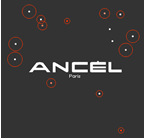
perfinstallation
Abstract preview: BLACK TIME is not a BLACK BOX modernising a WHITE CUBE :: Following the completion of a cycle of 5 communications for 5 continents at the end of 2005, "from Scenography to Planetary Network", via a wi-fi internet link from an aeroplane in flight between Shanghai and Munich, and on being invited by criticalsecret, we are now proposing a ‘perfinstallation’ during the inauguration of the 2006 Salon de la Revue in Paris. This show's name gives a nod to a contemporary play, but does not permit communication with the other. It simply tries to transform a mobile into a sort of awareness machine with an editorial line that is set where the Dream Machine stops. This show is made up of images gathered from the internet and a sound track, as a first revue for mobiles (as a 3gp file) transmitted only between 21:00 hrs and 22:00 hrs via the number ‘+33677804966’ (via Mms) from my mobile (Nokia 6233).
Thus, this creation-action is actually giving real expression to another ‘sound-image’ which the artist Laszlo Moholy-Nagy had already thought up in the last century. Nevertheless, from then on, technological performances set up an empty space in a post-mediatic universe that was not emerging but converging, which can still be freed of meaning simply by linking up with our lives, as experienced in plays by Dan Graham X or John Knight "Site displacement" 1969 during the mass media age. As part of setting up the transmission of a "Theater of Utopia" digitised animation, which will take place in honour of Claude-Nicolas Ledoux on the bicentenary of his death, on 19 November, we are going to test it on Friday 13 October, using a wi-fi link for a live streaming, from zero convergence, via the Internet and viewable on Internet-enabled mobiles, at this address rtsp://qts.zonepro.com/ancel/X (on your video player) before announcing the forthcoming "Black Time" in a podcast version for criticast.net. Contact Franck Ancel info[at]franck-ancel.com.
Posted by jo at 09:33 AM | Comments (0)
September 21, 2006
Google-ad hacks
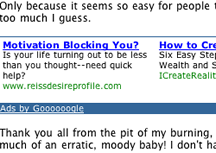
Kurt Cobain's Suicide Letter vs. Google AdSense
A few years ago, French artist Christophe Bruno created the Google AdWords Happening, in which he utilized the AdWords program to publish abstract poetry instead of ads. Google didn't find the happening appropriate hence, he got banned.
Last year Bruno's happening was followed up by GWEI - Google Will Eat Itself, an artistic click-fraud scheme developed by Hans Bernhard & Alessandro Ludovico. GWEI turned Google's ubiquitous AdSense program against Google itself in order to draw public attention to the fact that Google's immense popularity constitutes a democratic paradox. The operation was quickly discovered and stopped by Google.
Now, US artist Cory Arcangel has added to the list of conceptual Google-ad hacks. Arcangel recently put up a webpage containing the entire text from Kurt Cobain's suicide note and paired it with Google AdSense.
Naturally, the text-ads generated by Cobain's suicide note are totally absurd and so, the site demonstrates just how clueless AdSense is despite Google's claim that 'AdSense can deliver relevant ads because Google understand the meaning of a webpage'. [blogged on Guerrilla Innovation]
Posted by jo at 07:06 PM | Comments (0)
[iDC] Some things about things
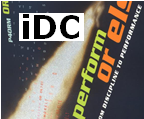
"Performance" and Situated Technologies.
I thought I might introduce a paradigm, that of "performance", into the discussion of situated technologies. This could provide a way to talk about people and things in networked milieus without fetishizing the object or exceptionalizing the human.
Trebor writes: "Sociality between networked objects and humans is a core question. Who is served by such mythologizing rhetoric with terms like "co-inhabiting"? These, ___ (fill in the blank) are just pieces of metal and silicon... They are around and they make some things easier and they (will) join our conversations by contributing data."
And Anne also points out: "I also wonder about a current fetishising of 'things'. Or how can we 'return to the object' without privileging objectivity? I really disliked the phrase 'the internet of things' when I first heard it, but I've since embraced it as a rather lovely manifestation of a type of contemporary commodity fetishism."
Firstly, as a designer I can't help but like things. Sometimes they are buildings but mostly they are just things. I don't design them in and for themselves but to be used by a variety of actors: people (gender age and race a clear consideration) but also for institutions (and here I use it in Agre's terminology: http://polaris.gseis.ucla.edu/pagre/hci.html) like festivals and cities. Although I agree with Anne's warning of fetishizing, I don't think it will be of the object. Their will be nostalgia for the material object, but it will be difficult in light of networked technologies, virtual/real hybrids to essentialise and fetishize the object in the same way again. What I do think will be become fetishized if it hasn't already is "performance".
Jon McKenzie in his book _Perform or Else: From Discipline to Performance_ attempts to formulate a general theory of performance by drawing on three strands of concurrent but fundamentally independent researches: "Performance Studies", "Management Performance" and "Techno-Performance". All three are products of the post-war: Performance Studies taking its germination from theater studies and anthropology, Management Performance developing in opposition to Taylor's Scientific Management and Techno-Performance Research tied to computer science and engineering. What McKenzie tries to do is demonstrate the "normativity" of performance. Performance has become a mode of measuring, evaluating and ultimately reifying forms of knowledge and power. The nature of these measures/values differs from one activity to another and McKenzie distills three to coincide with his three research areas: "efficacy" for cultural performances, "efficiency" for organizational performance and "effectiveness" for technological performance. These valuations are instrumental in maintaining "high standards" (normative) while also issuing a challenge (operational) to all those that wish to participate. It is in the relationship between challenging and performance that McKenzie finds "the power of performance":
"At the crack of millennia, performativity guides innumerable processes ranging from the intricacies of class, race, ethnic, gender, and sexual identification to the large-scale installations of technologies, organizations and cultures. "Perform- or else" is a challenge made in the USA and now restoring itself worldwide through innumerable circuits... Challenging is the fundamental tonality of this transformation without foundation; it is the affective dimension of the performance stratum, the shifting element of its "perform_ or else." Accordingly, the age of global performance is not only populated by high performers, peak performers, star performers, performers who challenge forth themselves and others, but also by the performatively challenged, those who cannot perform up to spec: the mentally challenged, the physically challenged, the economically challenged, the digitally challenged, the stylistically challenged and even the liminally challenged. Perform- or else: there is no performance without challenge, without claims and contestations, demands and accusations, field tests and identity checks, as well as the occasional untimely dare (p.188)"
In light of the performance paradigm Sterling's spimes are interesting. They rise to the challenge of techo-effectiveness as they as incredibly sophisticated compositions of cutting edge technologies: rfid, gps, the internet, CAD, rapid prototyping and recycling. They rise culturally to the environmental challenge because as they transform materially and informationally over their lifetime they develop a history with their environment (people and other things). And when their use is up they forfeit their material existence for the benefit of other spimes and the planet. Organizationally they would be an efficient version of my verizon mobile phone service or my fav software, both organizations of "convenience", quick fixes, and upgrades every n years. Also spimes carry lifetime warranties, which tie me to a contract that probably carries heavy penalties, social and financial, if I want to opt out. The spime program appeals to designers and why shouldn't it? It has great technical challenges tied to social responsibility. This is innovation with conscience. In conflict resolution parlance it is a win-win.
McKenzie again:
"The most striking aspect of performative power is that it actually encourages transformation, innovation, even transgression and perversion. No longer objects of discipline, we now perform, multitask, do our own thing. This last aspect of performance is especially troubling, for it reveals the libidinal infrastructure of contemporary domination. Deleuze, reading Foucault, writes that strata coalesce around relatively rare perfomative statements or "order-words." The order word of the performance stratum? Perform- or else."
This is the paradox of performance, it is "normative" but also "mutational". The disaffection that I sense from Trebor and Anne's posts seem to be directed at performance's normative tendencies: techno-effectiveness with its concerns for "optimizing" and organizational-efficiency with its needs on "streamlining". Perhaps it is easy for us on this list to rally around cultural performances, theater, dance, performance art, aesthetic practices, political demonstrations and "free cooperation", whose aims are social efficacy. But I am suspicious that it won't be so easy to decouple one type of performance from another. As McKenzie also points out "the paradigms are coming into contact more and more, and as their citational networks become hyperlinked, their respective performatives and performances break apart and recombine in a highly charged, highly pressurized milieu."
This brings me to Architecture and Situated Technologies. I think architecture in architecture in particular is a good example of the "perform-or else" challenge. It requires efficient organizational management to handle the considerable capital that it uses, it provides lots of work making it one of the engines of the global economy, its practitioners are concerned with the aesthetic, social and environmental effects of their project (mostly) and technical innovation is a hallmark of its quality. The role of situated technologies in this mix can be twofold. They can contribute to achieving the prime directive ("perform-or else") or they can open the performance of architecture up to unscripted performances which would allow for other socialities: alterity, participation, learning, cooperation. It all depends on "which" situated technologies we are talking about and not "what" situated technology.
In my last post I evoked the specter of Gordon Pask, "mister cybernetics" to suggest some antecedents for this symposium. In addition to his contributions to the subject of cybernetics and human-machine interaction he was a performer and "dramaturg" http://www.pangaro.com/published/Pask-as-Dramaturg.html. In July, 1968 Gregory Bateson organized a conference in Burg Wartenstein, Austria entitled "Effects of Conscious Purpose on Human Adaptation." Its proceedings were published in the form of a personal account by Mary Catherine Bateson entitled "Our own Metaphor." The conference has extended conversations on cybernetics with the metaphor of the machine being a contentious point. Here is Pask laying out an argument for "things":
"'You have all talked as though there was a fixed heritage of machines that dated from the Industrial Revolution or somewhat earlier,' Gordon said. "It seems to me that the notion of machine that was current in the course of the Industrial Revolution- and which we might have inherited- is a notion, essentially, of a machine without goal, it had no goal "of", it had a goal "for". And this gradually developed into the notion of machines with goals "of", like thermostats, which I might begin to object to because they might compete with me. Now we've got the notion of a machine with an underspecified goal, the system that evolves. This is a new notion, nothing like the notion of machines that was current in the Industrial Revolution, absolutely nothing like it. It is, if you like, a much more biological notion, maybe I'm wrong to call such a thing a machine; I gave that label to it because I like to realize things as artifacts, but you might not call the system a machine, you might call it something else.'"
Pask's "biological" observation is performative not ontological. These "things" will perform biologically, evolutionarily, iteratively. The agency that he gives them should not be confused with the idea of human agency which is tied to intentionality and hence consciousness. I think material things with underspecified goals can have agency in the way Pask describes them, where "intentionality" doesn't exist a priori but is an emergent quality apprehended only recursively.
If we are to understand the "internet of things", "networked things" or "situated technologies" from the position of performance then I think we may be able to interrogate them critically and constructively. We have to be careful of terms like "co-habitation" because to inhabit or dwell may suggest too much human intentionality. "Co-perform" may be better? To do this we would ask which situations? and what technologies? so as not to objectify the "thing' but elaborate on its performativity.
Omar Khan
Below is an excerpt from Pask's The Architectural Relevance of Cybernetics, Architectural Design 1969
A simple cybernetic design paradigm
In the context of a reactive and adaptive environment, architectural design takes place in several interdependent stages:
i) Specification of the purpose or goal of the system(with respect to human inhabitants). It should be emphasized that the goal may be and nearly always will be underspecified, ie. The architect will no more know the purpose of the system than he really knows the pupose of a conventional house. His aim is to provide a set of constraints that allow for certain, presumably desirable, modes of evolution.
ii) Choice of the basic environmental materials.
iii) Selection of the invariants which are to be programmed into the system. Partly at this stage and partly at ii above, the architect determines what properties will be relevant in the man environment dialogue.
iv) Specification of what the environment will learn about and how it will adapt
v) Choice of plan for adaptation and development. In case the goal
of the system is underspecified (as in i) the plan will chiefly consist in a number of evolutionary principles.
_________________________________________________________________
Like a sleeping dog whose ears prick up when he hears himself being called, I glimpsed my name in Sergio's post, and, flattered as I am by the mention, just want to nuance what I said about Performance. I was trying to suggest that Performance was both a product of and a resistence to burgeoning digital culture. This is the quote from the book
...whatever their individual content or treatments performance works are united by a shared consideration of context and methods. Central to any performance is the question of the space in which it takes place and the means by which it is articulated, often centred on the artist's body as both location and means. Such work concerns the media, in the sense of that which mediates a communication, and how that mediation affects the message. It is no coincidence that modern Performance Art emerged at a time when electronic media were initiating what the Italian philosopher Gianni Vattimo describes as an 'society of generalized communication'. To some extent Performance can be understood as a pre-emptive defensive reaction, emphasizing the corporeal and embodied as well as the ephemeral and the physically located, as a form of resistance to the immateriality, ubiquity and virtuality of mass media and communications, which had taken over so much of art's role as the provider of aesthetic solace and meaning. But Performance can also be seen as rehearsing many issues that later become relevant to electronic and, in particular, digital media. These included questions of interaction, response, feedback, the relationship between the audience and the performance, the methods for combining different media elements and so on. Much of the visual and interactive grammar of modern electronic media, such as television and digital multimedia of various sorts derives from the work of those involved with performance and other, similar areas. Those working in these areas were among the first to explore the possibilities offered by electronic media, first in video and then in digital technology. Many of those involved in developing Performance as an artistic practice are currently involved in media art practice. But, even before the widespread use of technology these practices offered a framework for thinking about multimedia, interactivity and other issues, as well as offering an artistic and poetic matrix through which to think about their use.
Charlie
Charlie Gere
Reader in New Media Research
Director of Research
Institute for Cultural Research
Lancaster University Lancaster LA1 4YL UK
Tel: +44 (0) 1524 594446
E-mail: c.gere[at]lancaster.ac.uk
http://www.lancs.ac.uk/fss/cultres/staff/gere.php
iDC -- mailing list of the Institute for Distributed Creativity:: iDC[at]bbs.thing.net :: http://mailman.thing.net/cgi-bin/mailman/listinfo/idc
List Archive: http://mailman.thing.net/pipermail/idc/
Posted by jo at 05:34 PM | Comments (0)
Blog? Project
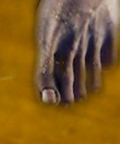
Blog as Platform for Creating Art
Blog? - exhibition at no-org.net is launched! :: Participant Artists: Cyrill Duneau, DVBlog, Mez, Eduardo Navas, Coyoteyip, Jhave, Confettis, Gustavo Romano, Bridgegirl.
Blog, one of the most spread forms of expression on the web -varying from personal diaries to community weblogs, professional knowledge exchange resources, political campaigns and more. In their different manifestations, blogs (moblogs, videoblogs, photoblogs, etc.), became a phenomenon influencing in many cases upon social and cultural areas: journalism, politics, alternative knowledge sources, literature, art, etc.
The blogs? project takes blog as art and as a stage for net artworks investigating the language, the aesthetics, the impacts and the practices of blogs, blogging and the blogoesphere. Blog? presents works utilizing the blog platform for creation of artwork. Works that break the conventional purpose of the platform, conveying a message or delivering data, by emphasizing poetical and aesthetic manifestations of blog, and by exposing capabilities of the blog as a platform for creating art. Blog-specific works.
Posted by jo at 08:21 AM | Comments (0)
September 20, 2006
Annie Abrahams
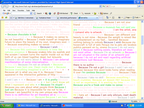
Am I an artwork? Performance
Am I an artwork? Yes, no, maybe. Suis-je une oeuvre d'art? Oui, non, peut-être.
Am I an artwork? was commissioned by the FRACLR in 2002. The piece (in perl) collected visitor reactions and traced them by IP to influence the colours of the page layout. This was a way to point to the fact that the visitor wasn't anonymous, something a lot of visitors weren't aware of in 2002. More important, and still actual, the piece permitted to openly ask if a piece of "net art" could be "art" on the site of an official French art institution.
On the 24th of September all the French entries of the piece will be read in public during a performance in the show called "Chauffe Marcel !" organised by the same art institution. Two microphones will be placed about 10 meters one from another. One will be used to amplify the "yes" phrases the other the "no" phrases.
Performance: lecture/combat :: 24 September 2006 11.00h, la Panacée, 14 rue de l'école de pharmacie, Montpellier, France. in the show "Chauffe Marcel ! " subtitle "L'imitation de Marcel Duchamp". Curator : Emmanuel Latreille, director of the FRAC Languedoc Roussillon. The performance will be followed by a special guided visit of the show by Emmanuel Latreille its curator.
Posted by jo at 11:19 AM | Comments (0)
FURTHER PROCESSING
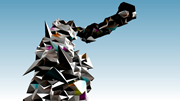
Generative Art, Open Systems
FURTHER PROCESSING: Generative Art, Open Systems :: Pablo Miranda Carranza (ES), Fabio Franchino (IT), Ben Fry (USA), Golan Levin (USA), Lia (AT), Mark Napier (USA), C.E.B. Reas (USA), Martin Wattenberg (USA), Marius Watz (NOR)
Opening: Sat 23.09.2006, 1.15 p.m. :: Duration: 23.09.-25.11.2006, Tue-Fri 2-6 p.m., Sat 11 a.m.-6 p.m. :: Venue: Kunstverein Medienturm, Josefigasse 1, A-8020 Graz :: Curators: Sandro Droschl, Marius Watz.
FURTHER PROCESSING uses the Open Source software "Processing" as a departure point to examine current positions in software-based art. Code is becoming an aesthetic material, with software as the new art object. The exhibition can be grouped into two loose positions: Generative Art and Data Art. The former sees the software system itself as an object of investigation, with algorithms and code structures becoming the framework and material for the work itself. The generative works present an aesthetic of complexity, concerned with formal explorations of spatial and temporal parameters. Ranging from the opulent to the minimalist, these pieces comfortably bridge the gap between an electronic image culture and traditions in drawing and painting.
Data Art positions the computer as mediator between humans and the increasingly complex information networks that surround us, using computational processes to make visible structures and patterns that go unseen by our natural senses. Data visualization thus becomes a pure art of the database, a new cultural artefact in a world of information.
Beside works of nine well known international media artists the software "Processing" will also be on display, so that visitors can try the tool and perhaps get a taste of code for themselves. After all, FURTHER PROCESSING is based on a continuous artistic discourse, of which the effects are reflected on an aesthetic, technological and discursive level.
Posted by jo at 10:55 AM | Comments (0)
September 19, 2006
The Department of Network Performance
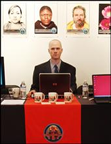
Arts 404.JO
Open Enrollment 9.19.2006 :: The Department of Network Performance :: Network Performance - Arts 404.JO :: Times: Ongoing, Always, 24-7 :: Professor: C. Peppermint, Dept. of Network Performance :: Fall 2006 - current.
Course Outline: This is not MySpace. This is Arts 404.JO, simultaneously a networked course and performance intended to assist students in the conceptualization, development, and implementation of online instances of networked performance-art practices.
PLEASE NOTE: This course is intended as a restless, evolving, active-media template for researching, exhibiting, coding, creating, and building network performances. Arts 404.JO is NOT a vehicle for commercial, corporate, individual, or self-promotion. Arts 404.JO is not a course for simply displaying one's works. This course is a network performance unto itself. Unexpected solutions are encouraged, i.e. works that follow the exercises provided in the syllabus but attempt to push that structure into realms of creative play.
Course Requirements and Objectives: (1) Arts 404.JO is an information-arts course titled "Network Performance Art - Arts 404.JO" Arts 404.JO is intended for: Artists, Hackers, Cultural Purveyors, Imaginative Housewives, Creative Construction Workers, Creative Workers, Creative Chocolatiers, Urban Homesteaders and Back to the Land Types, Special Teachers, Special Education Teachers Who are Fighting Corporate / State Mandates, Cosmopolitan Farmers, Innovative People and Animals, Eco-minded Global Citizens, Cultural Readers, Whole Food Eaters, Savvy Art Critics, Curators, and Art Historians Who Aren't Afraid to Ride In The Back of Pick-up Trucks, Cyborg Mycologists, AIs Masquerading As Musicians, Information DJs, Print-makers, Painters and Ceramicists Who Set Information Free, etc.
Posted by jo at 10:03 AM | Comments (0)
September 18, 2006
Marcel.lí Antúnez Roca
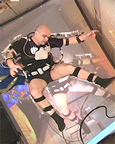
Transpermia
Performance calendar :: A mechatronic conference presenting the Dedalus project and its micro performances at zero gravity as well as the Transpermia theory.
Using the Space Station as a metaphor, Marcel.lÌ Ant·nez Roca has developed a hybrid show alternating performance, concert and lecture. It is structured in different modules. During the show Ant·nez wears his Dreskeleton (an exoskeletal body interface) and with it he samples, activates and modulates sounds as well as controlling the films projected on two screens. In the first module he presents some of the mechanical aspects characteristic of his work such as the Fleshbots, the Dreskeletons, the Biometries and the Systematurgy. The second module takes us through recurrent images in his work. The third module reveals the end result of the process of preparation for the Dedalus project in Star City in the Russian Federation as well as the micro performances that were carried out during periods of microgravity provided by the parabolas.
In these micro performances we witness the Requiem bodybot experiment and the interaction between the dreskeleton, the softbot and the interactive films. The last module presents the Transpermia theory and at this point the performance becomes more like a conference. Ant·nez proposes a new landscape for a Utopia called Transpermia. He describes some of his prototypes organized in 4 sections:
1 Interface: new devices with which to perceive the world and take part in it
2 Robots: machines as metaphors for life
3 Fleeting Identities: transitory states of personality as a setting for new experiences and knowledge
4 New Creations: models of activity in the Transpermia Utopia.
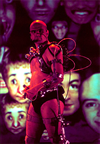
Marcel.lí Antúnez Roca (Moià, 1959) is well-known in the international art scene for his mechanotronic performances and robotic installations. In the nineties his avantguard mechatronic performances combined such elements as Bodybots (body-controlled robots), Systematugy (interactive narration with computers) and dresskeleton (the exoskeleton body interface). The themes explored in his work include: the use of biological materials in robotics, as in JoAn? l’home de carn (1992); telematic control on the part of a spectator of an alien body in the performance EPIZOO (1994); the expansion of body movements with dresskeletons (exoskeletical interfaces) sed in the performances AFASIA (1998) and POL (2002); involuntary choreography with the bodybot REQUIEM (1999); and microbiological ansformations in the installations RINODIGESTIO (1987) and AGAR (1999). He is currently working on the spatial and utopian artwork TRANSPERMIA.
In the early nineties his performance EPIZOO caused a commotion in the international art scene. For the first time a performer’s body movements could be controlled by the audience. By operating a videogame, a spectator interacts with the bodybot worn by Antúnez, moving his buttocks, pectoral muscles, mouth, nose and ears. This performance stresses the ironical, and even cruel, paradox rising from the coexistence between virtual digital iniquity and the performer’s physical vulnerability.
Since the eighties, Antúnez’s work has been based on a continuous observation of how human desires are expressed and in what specific situations they appear. First in the tribal performances of La Fura del Baus and later, on his own, he expressed this interest by creating complex, in many cases hybrid, systems hard to classify. Antúnez’ works belong to the fields of both visual and scenic arts.
From the early nineties, the incorporation and transgression of scientific and technological elements in Antúnez’ work, and their interpretation by means of unique and specific devises, have produced a new cosmogony - warm, raw and ironic - of traditional themes such as affection, identity, or death. In his works these elements take on an extremely human dimension that causes a spontaneous reaction in the audience. He was also founding member of La Fura dels Baus, he worked in this company as art co-ordinator, musician and performer from 1979 to 1989, and presented the group’s macro-performances ACCIONS (1984), SUZ/O/SUZ (1985) and TIER MON (1988).
Posted by jo at 04:51 PM | Comments (0)
September 15, 2006
Mark Wallace

LonelyGeeks, LifeLogs and Four Eyed Monsters
A few of us from the Brooklyn metaverse crowd went to see Four-Eyed Monsters last night, a very interesting feature film about a young New York couple who end up documenting their every move via videotape and handwritten notes, only because they’ve decided not to actually speak to each other. While the film is not a documentary, it was made by the couple who it’s about, and their real lives and dramatized lives do begin to converge toward the end of the film. While it’s a movie about relationships (you know, the kind where two people “slowly start to meld into one beast that has 2 mouths, 4 eyes and 8 limbs and takes up 2 seats on the subway!!!”), it’s in greater measure a movie about the act of recording itself, and what it means at a moment in history when you can store, play back and share as much of your life as you like, with as many people as are willing to pay attention. In this case, Susan and Arin have created a virtual version of their real life together, and it’s interesting to ask what the differences between the two may be, if any — especially in light of similar trends in things like lifelogging, and in the fictionalization of a life like lonelygirl15’s. And if you stay with this long-winded post all the way to the end, you get to think about how this kind of logging of our lives might help enhance them in some future 3pointD world.
“How long can their relationship survive as an art project???” asks the Four Eyed Monsters Web site. But that doesn’t describe everything that’s going on here. There’s an art project unfolding, but there’s a relationship too. Are they the same thing? Does the art project follow the course of the relationship, or is the relationship subservient to the art project? The truth is probably somewhere in between: you can’t separate the relationship from the art project; at some level, the relationship is the act of documenting itself. A more interesting question might be, “How long could their relationship survive if it stopped being an art project?”
The documented life got some attention recently with the stellar rise of lonelygirl15, who appeared to be recording her days via a video diary on YouTube. Except that lonelygirl15, who’d garnered millions of fans in the four months she’d been videoblogging herself, turns out to be the construct of a couple of young California filmmakers. “Bree” was a totally fictional character, but it’s interesting to ask how the fictional Bree differs from the fictionalized Susan and Arin. Four Eyed Monsters is composed for the most part not of documentary footage but of re-enactments. (And in any case, what does it mean to re-enact what was in part acted out in the first place?) Are the characters of “Susan” and “Arin” that appear on the screen somehow qualitatively different from the character of “Bree” that appears in the YouTube videos? Are they all virtual people, or do Susan and Arin have some deeper gravitas for being based on their actual counterparts? And isn’t Bree, the lonely teenager, based on an actual archetype? Does that make her any “more fictional” than the characters in the film? Or is that like being “more pregnant”?
One of my favorite ideas is the impossibility of autobiography: you can’t ever really give an accurate account of yourself and your history; there are just too many intangibles of memory, bias and emotion that get in the way. Four Eyed Monsters is only one version of the lives of Arin and Susan. Cut together differently, the film could have given a very different impression, or examined some other aspect of what it’s like to come together in the way they have. You can’t present all views at once, and any one view leaves out some amount of information. (There’s a 3pointD uncertainty principle here that I’ll post about at some point in the future.)
Lately, though, some people have been looking for ways to capture their lives in as much detail as possible, using the tools of the information age. While the Internet and digital media make recording the scenes of one’s days far easier than it has been before, they also make possible, at least in theory, a detailed quantification of one’s life that could potentially be very useful in a future metaversal age.
One failed version of this is the now-discontinued LifeLog program of the Department of Defense. “The LifeLog capability would provide an electronic diary to help the individual more accurately recall and use his or her past experiences to be more effective in current or future tasks,” according to DARPA’s description. “The goal of the LifeLog is to turn the notebook computers or personal digital assistants used today into much more powerful tools for the warfighter.”
That program is no more, but into the breach has stepped ur-blogger Justin Hall, who’s been looking at “Passively Multiplayer Online Games” in recent months. (We first blogged about this back in June.) Basically, a PMOG, in Justin’s early conception, logs all your Internet activity and assigns scores based on various factors such as which and what kind of sites you visit, for how long, and what you do there, etc. It’s not very far advanced beyond an idea, but a kind of proof-of-concept version of Justin’s game is online, where you can see how surfing various sites might raise or lower various attributes that are used to describe your avatar in the game.
It’s interesting to contemplate what it might be like to compare the fictionalized self created by such a game to the real person who plays it. But this kind of lifelogging can be taken a giant step further and allowed to bleed out into the real world, where it could become really useful (or really scary, depending on who’s doing the logging).
It already happens on the Web all the time: the recommendations you get from Amazon or NetFlix and the targeted ads in your Gmail sidebar all work off subsets of the lifelogging idea. Amazon, NetFlix and Google log your activity on their sites, and use that information to point you toward things that are in line with the preferences you’ve shown in the past.
Now extend that idea to all areas of your life. Imagine if, after you’d used FreshDirect for a while, it started automatically ordering and delivering your food for you, based on the orders you’d placed in the past. Now knock down the walls between FreshDirect’s information and the information gathered by NetFlix, and it might even tweak your delivery based on what kind of movies you’d ordered that week. (Popcorn and chocolate for the chick flicks, Red Bull for the slasher movies?) Now imagine you’re sharing all this information — travel itineraries, iTunes playlists, anything else you care to name — with a whole bunch of other people, much as Susan and Arin shared the moments of their lives.
I’ll let Jerry contemplate the ramifications of videologging (no “b” here) one’s life for all to see. Logging the data of your every move, though, could get interesting. Vernor Vinge mentioned the potential opportunities that are opened by this in his keynote speech at the end of the recent Austin Game Conference. Vinge envisioned “lifestyle cults” that gather and share their information in order to garner favorable terms in whatever context. If 1,600 other people in your neighborhood all order Red Bull on the weekends, for instance, you ought to be able to leverage that into a discount. Things like that seem to be the gist of Vinge’s thinking here.
If it sounds outlandish to be sharing so much information with so many other people, consider the fact that Web 2.0 has pushed us much further in that direction than almost anyone thought we would head. On Flickr, YouTube, Blogger and so many other sites, we offer up personal information about our habits, thoughts, purchases and selves every day — many times a day, in fact. One of the ideas behind lifelogging is simply that you as an individual would be able to aggregate all that information in a single place. Without revealing anything more than you’re already putting out there, you’d immediately have a powerful resource for doing things like making decisions, making friends, making new discoveries, you name it.
Me, I’ve shared enough in this post already. (1,400 words!) See you — or some version of you, at least — at the movies. [blogged by Mark Wallace on 3pointD]
Posted by jo at 04:55 PM | Comments (0)
September 14, 2006
Jane McGonigal

Please feed (but don't fetishize) the participation
I'm feeling a bit squeamish about a lot of the lonelygirl discussion going on this week, in the wake of the previously secret puppet masters' curtain call. As someone who designs participatory experiences, often games with a serial narrative component, I think it's really important that we stop and look at the kind of participation and engagement actually engendered by projects that purport to solicit the collaboration of the audience.
In the LA Times, the producers of the You Tube serial drama describe their goals for engaging the audience:
The intent was to allow fan response posted in the comment section of lonelygirl15's YouTube and MySpace pages to determine the direction of each subsequent episode.As an example of the fans' influence over the story line, what the team calls "collaborative storytelling," they pointed to an episode in which Daniel reveals his romantic feelings to Bree. "In the 'Hiking' video," Beckett said, "where Daniel filmed her, there were a ton of comments saying, 'Daniel likes you. It's obvious that the cameraman was completely in love with you.' We saw the comments and said this is the perfect opportunity to address this."
Okay, fair enough. I'm all for collaborative storytelling. But I don't think it's right to accept this account of the kind of participation that happened during the lonelygirl project at face value. Today and yesterday I spent a lot of time reading through pretty much every single comment left on the lonelygirl videos, the space where the audience was purportedly invited to help decide and direct the course of the narrative. I would encourage anyone else interested in the currently much praised and hyped lonelygirl "community" to do the same. A great hub for doing this is here.
As the statistics on this traffic counter show, each lonelygirl video has roughly 1000-4000 comments, nearly all of them left before the puppet masters were unmasked. And I have to say this: the level of hate, mean-spiritendess, crudeness and often downright misogeny of the majority of them is impossible to ignore.
As we talk about the “new art form” or “participatory culture” aspects of this project, I want to be very careful that we don’t fetishize the participation aspects of this experience that was had by a very few who may have intelligently, passionately and seriously investigated and responded to the texts and the media objects. I want instead to think about the mainstream experience of and participation in this project and the success of the platform provided for engagement.
To give you an idea, here is a sample of comments that I would characterize as representative of at least 33% if not more of comments to the lonelygirl videos:
You are pretty boring. Get a psychologist.
Ok. Why don’t you just keep your personal problems to yourself and stop making a scene
show us your tits
you are really ugly i hope you know that
Your eyebrows are too far apart. But, you’re still pretty.
Fuck you. Welcome to the new world we Don’t Have to Respect what you think. get over it
I hope Daniel rapes you. No hard feelings.
WHORE lol
HHHmmmmm,your caucasian,live in a decent to luxurious house, are well taken care of,and it looks like you are one of those spoiled girls that kiss ass to thier daddy.Think you have it rough?Why dont you come live in East Los Angeles,whee you cant go anywhere without being shot at,you fuckin spoiled brat.
Cry me a river bitch, your a teenager, do what your parents say bitch.
(Most discussion in the comments is not about whether lonelygirl is real or not-- they appear to accept the videos at face value, or otherwise not to care whether they are insulting a "real" girl or an actress.)
So: Is this really the birth of a new art form? Is this a kind of social participation that we like or find interesting? I'm all for participatory entertainment. But let's carefully design platforms, vehicles, and contexts for participation that really work to engage audiences, players, makers, collaborators in meaningful ways.
One more point I want to make: I think this question of "is she real or not" and how does the audience feel about being hoaxed or played with is a really important one. Although many, many viewers were openly skeptical or cynical about the verity of lonelygirl's professed identity, from what I can tell, far more took it close enough to real to play along.
Now I've written a lot about, and worked on quite a few, projects that ask players to perform belief in the story and game experiences, but--and here's the key distinction--without presenting actually credible fictons. (Stories set 500 years in the future, for instance, or involving poker rooms full of ghosts). The media itself never clearly said "I'm not real", but the content absolutely had no chance of fooling anyone. So I'll come out and say it: I don't personally like entertainment in the form of credible hoaxes. Not necessarily from a moral position, but rather because I believe that "real or not" distracts from the more important question: How can I meaningfully engage?
I agree that serial drama on You Tube is a great art form (so are traditional ARGs, the more elaborate art form that lonelygirl represents a pared back style of, in my opinion), but the real conversation should be not about the realness, but rather: How do people want to participate in it? Do they want to be the makers of their own videos? To have role-playing style conversations in the comments? Do they want to directly influence the narrative or to just speculate and gossip about it so they can be proven right by what happens next? And most importantly how do we inspire participation that is more than hostile juvenile comments? How do we create a real participatory community around an entertainment property, and what forms of participation are possible... and desirable? [posted by Jane on Avant Game] [Related post]
Posted by jo at 06:18 PM | Comments (0)
[iDC] Architecture and Situated Technologies - September Overture
![]()
Anne Galloway
Thanks Mark for your thoughtful introduction to the September discussions. I've been following with great interest since I introduced myself in July, and now I'd like to share and begin to explore some things that have particularly resonated with me.
You mention the "current status of the material object [and] forms of embodied interaction" and I've often thought about this 'return' to the body and the physical after the (failed?) promises of cyberspace disembodiment. In other words, I see a kind of re-embodiment ethos at work right now in research, art and design practice, and a re-newed commitment to the material. In some ways, then, it seems that the pendulum of technological desire has merely swung to the other side.
Since my first two degrees are in anthropology and archaeology I also have a special interest in material culture. Coupled with my doctoral work in social studies of science and technology, I find this question of materiality to be rather persistent in my research. If you'll forgive my self-referencing, Matt Ward and I wrote a paper recently about some intersections we saw between archaeology and locative media design:
http://leoalmanac.org/journal/Vol_14/lea_v14_n03-04/gallowayward.asp
and I continue to imagine a possible future where complex legal battles are being fought over the cultural repatriation of digital artefacts
I mean, I sometimes wonder if our pervasive computing collections (we _are_ still talking databases) will more closely resemble the British Museum (http://www.thebritishmuseum.ac.uk/) or the City Reliquary (http://www.cityreliquary.org/)?
I also wonder about a current fetishising of 'things'. Or how can we 'return to the object' without privileging objectivity? I really disliked the phrase 'the internet of things' when I first heard it, but I've since embraced it as a rather lovely manifestation of a type of contemporary commodity fetishism. Earlier this year I gathered links on the historical development and use of the phrase, and it's not difficult to trace its movements--its inscription devices--from academic-industry research partnerships to popular business and technology publications to popular blogs and back to academic-industry research partnerships.
http://www.purselipsquarejaw.org/2006/03/internet-of-things-working.php
http://www.purselipsquarejaw.org/2006/09/bibliography-of-things.php
You may note in that cycle I just described there was no mention of particular technologies, or rather no mention of pervasive computing devices. I think that the material status of 'pervasive computing' today can be profitably distinguished from the material dreams of 'the internet of things'. (The _things_ we're talking about are different in each case.) In actuality, most embedded computing today is used for surveillance/monitoring or 'consumer convenience' and _not_ for participatory media production. I guess my point is that pervasive computing in its most banal and mundane expressions is by definition dull and boring. It's the Oyster card used on the Tube every day, the fingerprint scan to get into the office, the rfid tag stuck on the broom. But that's also _everyday life_ and sometimes boredom is just what people want and need. Plus, I try to never underestimate how inventive people are when it comes to finding hope and joy in small things.
I think that David Lyon got it right when he described surveillance as 'social sorting,' even if his sense of the social was too humanist for my taste. The sorts of structured and stored monitoring necessary for context-aware computing are also matters of spatial and cultural sorting (inclusion and exclusion). I find that we're still not very clear on these notions of 'publics' or 'communities' either, or rather that people are working with a multitude of different understandings that are often glossed over in conversation. Add to this the matter of matter--or things--and we're in a downright voluptuous state, where _things_ often don't co-operate.
So we induce, we create, places where it's easy to associate only with those who share our interests and values, where it's easy to avoid being accountable to, and for, precisely those interests and values that we do not share. And all despite the fact that we pass different others--move through spaces together--every day! (I guess that does trouble me.) At the same time, I'm not sure it's productive to essentially reframe this social and cultural discussion in terms of public and private. I'm not sure that dichotomy is either reliable or useful beyond helping me understand the everyday movements in-between...
In any case, I do continue to focus my work on how we are (re?)imagining our being-together in mobility--and I'm looking forward to our continuing discussions and to meeting some of you at the symposium.
Kind regards,
Anne
--
Anne Galloway
Dept. of Sociology & Anthropology
7th Floor, Loeb Building
Carleton University
1125 Colonel By Drive
Ottawa, Ontario
Canada K1S 5B6
www.purselipsquarejaw.org
www.spaceandculture.org
From Mark Shepard, September 20, 2006:
Anne wrote:
> I also wonder about a current fetishising of 'things'. Or how can
> we 'return to the object' without privileging objectivity?
I think this is a key question. As Sterling noted at the talk he gave for the Lift conference[1] last March, the phrase "Internet of Things" is a useful one if you are looking for venture capital in southern California. And indeed, the discourse surrounding the convergence of ubiquitous / embedded / context-aware / geospatial / locative technologies finds its (fundable) applications predominately in the commodity object or "objective" control systems for the military- industrial-light-and-magic complex. So it's not surprising that given the circuit running from "academic-industry research partnerships to popular business and technology publications to popular blogs and back to academic-industry research partnerships" produces ideas that feed this fetish for the object and objectivity.
Trebor asks:
> So, why talk of "things" instead of objects?
Well, for one thing, calling them objects doesn't account for meanings such as "That's another thing entirely", "She knows how to handle things", or "We're just doing our thing." Things are "actions, events and affairs" as much as they are "artifacts." Networked _things_ are not at all the same as networked objects (but they may include them). When we reduce _things_ to objects, however, we limit our ability to consider how _things_ are embedded within everyday life, their meaning contingent upon their use (or mis-use), and the relations they enact or perform.
Take Heidegger's "jug", for example:
> "No representation of what is present, in the sense of what stands
> forth and of what stands over against as an object, ever reaches to
> the thing qua thing. The jug's thingness resides in its being a qua
> vessel. We become aware of the vessel's holding nature when we fill
> the jug... the pouring that fills it flows into the empty jug. The
> empty space, this nothing of the jug, is what the jug is as the
> holding vessel... But if the holding is done by the jug's void,
> then the potter who forms sides and bottom on his wheel does not,
> strictly speaking, make the jug... The vessel's thingness does not
> lie at all in the material of which it consists, but in the void
> that holds." [2]
Heidegger's understanding of the thing stands in contradistinction to the object. While I find the larger argument he's making in this essay problematic, I do find useful the idea that the "thingness" of the thing doesn't reside in its being a representable object, but rather in the way _things_ bring human practices together and make them intelligible.
Recently I screened Tati's "Play Time" for a group of graduate students. I am always fasinated by the way _things_ for Tati - modernist chairs, glass plane doors (or at least their handles) - carry with them an excess beyond their role as functional objects. With the chairs, for example, that excess is the sound they produce when sitting on them, how the body engages with the acoustic properties of the material, and the (hilarious) social implications of this... This excess often lies in the difference between how things are designed and how they are used, or how they perform in ways not anticipated by their designers.
Dunne and Raby's "post-optimal" electronic objects would appear to take this excess as an opportunity for a reflexive, critical design practice, one that doesn't so much reject the optimizations and efficiencies of Taylorism as it considers them moot: already achieved, and therefore not much of a design challenge. If anything, contrary to Trebor's suggestion, I'd say critical design can play a key role in shaping a future of things that are not invested in "intentionally restricting the way the user can behave, or enforce certain modes of behavior."
Ulises wrote:
> I fear that our technophilia is obscuring the politics of these
> virtual-actual assemblages, obstructing the need to critically
> assess how agency is distributed amongst things connected through
> the internet.
The question of agency here is crucial. But I think it's useful to distinguish between humans and things in actor networks. This might help abate some of the hysteria surrounding the current discussion. That we can see networked things as systems doesn't necessarily mean that these systems can think, act, or exercise power in any subjective way.
Still, subjective human agency is but one form of "being in action or exerting power", and its important to consider how representative democracies, for example, can be influenced by _things_ that are capable of asserting themselves within networked societies.
Take Bruno Latour's Parliament of Things, for example:
> Let one of the representatives talk, for instance, about the ozone
> hole, another represent the Monsanto chemical industry, a third the
> workers of the same chemical industry, another the voters of New
> Hampshire, a fifth the meteorology of the polar regions; let still
> another speak in the name of the State; what does it matter, so
> long as they are all talking about the same thing, about a quasi-
> object they have all created, the object-discourse-nature-society
> whose new properties astound us all and whose network extends from
> my refrigerator to the Antarctic by way of chemistry, law, the
> State, the economy and satellites. [3]
Or Julian Bleecker's description of Blogject agency:
> Agency as I am using it here does not just mean a local “artificial
> intelligence” that makes a Blogject able to make autonomous, human-
> like decision or fashion croaky human-speech from text. Blogjects
> have no truck with the syntax of human thought. Things could not
> care any less about their Turing Test report card. Blogject
> intellect is their ability to effect change. Their agency attains
> through the consequence of their assertions, and through the
> significant perspective they deliver to meaningful conversations.
> Blogjects bring something heavy to the table. Or, they are brought
> to the table because they have semantic weight. Agency is
> literally imbued in Blogjects. Things that matter completely sully
> the previously starched white relationship between subject and
> object, human and nonhuman. Things that matter inflect the course
> of social debate and discussion, and cannot help inflicting local
> and global change. Witness the Spotted Owl. Witness the Pacific
> Northwest Salmon. Witness all the non-human, non-subject "things"
> that became fully imbued with the status of first-class citizens.
> Heck, most humans don't have the capacity to effect the kind of
> worldly change and receive the same order of protection, status and
> economic resources as a fish.
These networked things are obviously far more than "just pieces of metal and silicon... " and at the same time far less than the hype and hysteria currently surrounding them might suggest.
Best,
Mark
+++
[1] http://video.google.com/videoplay?docid=-8575858411965484751&q=bruce+sterling&hl=en
[2] Heidegger, "The Thing," in Poetry, Language, Thought, A. Hofstadter, trans. (New York: Harper & Row, 1971)
[3] Latour, Bruno. We Have Never Been Modern, trans. by C. Porter. Cambridge, MA: Harvard University Press. 1993. p. 144
[4] Bleecker, Julian. Why Things Matter. 2006. http://research.techkwondo.com/files/WhyThingsMatter.pdf
+
mark shepard
+
http://www.andinc.org
iDC -- mailing list of the Institute for Distributed Creativity:: iDC[at]bbs.thing.net :: http://mailman.thing.net/cgi-bin/mailman/listinfo/idc
List Archive: http://mailman.thing.net/pipermail/idc/
Posted by jo at 04:17 PM | Comments (0)
September 11, 2006
Google Will Eat Itself - No. 5

202.345.126 Years until GWEI fully owns Google
Dear GWEI Subscribers,
The current stats: Google Shares owned by GWEI: 123 Amount of USD: 47.276,28 Adsense-Clicks: 126.336 Adsense-Page Impressions: 5.448.926 Adsense-CTR: 2,31% Counter: 202.345.126 Years until GWEI fully owns Google Current Google Share Price: 384.36 USD, Symbol: "GOOG".
Google's Legal Department has contacted us with a very nice and open letter signed by Dr. Arnd Haller, Legal Rep. He stated that Google thinks we are doing great work but somehow something illegal, that they are fully aware that this is an art piece but still we should kindly stop with our assumed illegal activity.
Letter in German.
Our next exhibition will be at the ICC NTT Museum, Tokyo (JP). The "Connecting Worlds" Exhibition curated by Yukiko Shikata, with artists such as Peter Fischli and David Weiss, Dennis Oppenheim, Ambient.tv, Wayne Clements. We will show a digital Slideshow next to a terminal with the web-site:
http://www.gwei.org/pages/exhibitions/slideshow_ICC_tokyo
Media Coverage was very good during the last months, GWEI was featured in BBC World (Radio), Kulturzeit (3Sat TV), Telepolis, Artforum News
and in a lengthy article in Spiegel Online (Deutsch): and "die Presse" (Deutsch) and Sueddeutsche Zeitung (SZ) (Deutsch) and Heise Online, attacking our future project called Amazon Noir.
Additionally, on July 12, 2006 we have frozen a copy of GWEI and added it to the Rhizome Artbase for conservation. And.. we will present GWEI on October 24th at the New Museum New York for the Rhizome 10 years anniversary.
best regards and lovely hugs from the team
UBERMORGEN.COM feat. Alessandro Ludovico vs. Paolo Cirio
Hans Bernhard
UBERMORGEN.COM / etoy.holding
Skype Hans_Bernhard
Studio +43 1 236 19 85
Mobile +43 650 930 00 61
Email hans[at]ubermorgen.com
http://www.ubermorgen.com
Posted by jo at 06:30 PM | Comments (0)
September 08, 2006
DANCEPOD 2006

A Sculpture Composed of Simultaneous, Web-Connected Dance Parties
DANCEPOD 2006: On September 9th at 11pm in Portland, 12 am in Guadalajara, 2am in New York City, 3am in Mexico City and 7am in Berlin, dancepod will present an entirely new kind of sculpture. A sculpture composed of simultaneous, web-connected dance parties. The parties, coordinated and developed in conjunction with artists and presenters from each city, will utilize identical dancepod installations. The installations will become the core of a shared physical and virtual experience, supporting streaming video and music as well as live DJ’s, VJ’s, and surprising guest artists. Moving bodies of dancing participants will complete the sculpture.
As part of the Portland Institute of Contemporary Art's (PICA) Time-Based Art (TBA) Festival, in conjunction with PS122, Scene Downtown (Earl Dax), Harkness A/V (Nick Hallett), and technical directors Kraft + Purver, these 4 DANCEPOD sites will be linked by live video starting at 2:00 AM Eastern Standard Time.
NYC DANCEPOD features an eclectic array of New York artists. Join DJs Kevin Graves (Brite Bar) and Van Scott (Patricia Field's Party at element) and dance to visuals artists assembled by Nick Hallett and Harkness A/V, including Chika and Boris. Live performances by John Moran and Saori Tsukada, Sxip Shirey, and Glenn Marla.
Chez Bushwick will be hosting "The Changing of the Garde" starting at 8:00 PM on Saturday. Come early for DANCEPOD and enjoy performances by:
Wanjiru Kamuyu – Spiral
Jim Staley – Solo Trombone
Bruce Nauman - “Abstracting A Shoe (1966)” – Video Art
David Vaughan, Michael Cole, Jonah Bokaer – A John Cage Birthday Reading
Elke Rindfleisch - Untitled
Also... TECHNOPIA Interviews Carla Peterson, Newly-Appointed Artistic Director of DTW.
All this for $5. Come to both the Chez Bushwick and DANCEPOD events for just $10! That's like seeing the early show for FREE! (Regular DANCEPOD admission is $10).
Hosted By
3rd Ward Brooklyn
195 Morgan Ave.
Bushwick, Brooklyn, NY 11206
718.715.4961
www.3rdwardbrooklyn.org
Posted by jo at 05:46 PM | Comments (0)
September 06, 2006
See You in Walhalla
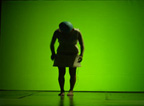
World Premiere of Live Computer Game
[Posted by Yukihiko YOSHIDA] World Premiere of new Live Computer Game "See You in Walhalla" :: September 14, 2006 :: IME Industrial Performing Arts Complex - Athens (Greece) and two other European cities (Sofia and Amsterdam) connected live through the Internet.
The Athens based performance group amorphy.org, with support of the Cultural Center of Kifissia and the EU Culture 2000 Funding Scheme, is proud to present the world premiere of "See you in Walhalla," a distributed live performance game connecting three cities – Amsterdam, Athens and Sofia. This multi-media dance/theatre project, collaboratively created by artists and designers from four different European partner sites in Greece, The Netherlands, Germany and Bulgaria, presents the unusual journey of a video game “avatar” through a haunted urban industrial landscape composed of digital fragments from the spectacle of Europe.
The audience in Athens is invited to witness the exciting premiere of the first live 3D computer game enacted by three dis/located performers simultaneously, with Ermira Goro playing the “avatar” on location in Athens, while Nancy Mauro-Flude and Ivaylo Dimitrov are streamed via web-cams into the game but are located in Amsterdam and Sofia respectively, and watched by local audiences in those cities. At the same time, “See you in Walhalla” can be witnessed live on the Internet, where online players can log on to offer their comments and reactions to the performance/game. The Athens premiere represents the first leg of a European tour scheduled for 2006-2007 seasons.
Description of the new work:
An average man. Slightly obsessive, familiarly lonely. He eats his green apples, rendered phosphorescent in the glow of his computer screen. A new video game, See You in Walhalla – “in this place everyone who is not in jail works for the police.” He creates his avatar. The game’s purpose - to guide this avatar, born as an “empty” shell, through various journeys taking place in an imaginary city-scape morphed out of Amsterdam, Athens and Sofia, with the final goal of rendering the avatar into a more “human being”, capable of surviving the density, danger and psychosis of urban existence, at a time when Europe is undergoing its own nightmares of economic and political integration. Paradoxically, integration in this haunted and visually disturbing game is experienced as a series of physical and psychic dis-sociations. The Player gets more involved with the game, losing a sense of reality and becoming more socially autistic, while his avatar slowly recovers a sensibility for human inter-action which is punished by the pressures and regulations, as well as the hyper-euphoric spectacular image-scapes, of which the urban rhythms of existence are determined.
I am Amalia, if you hurry me I will say I am Molly, I am her, locked up in the big house, desperate, pursued by Rosas’s mazorca, I am Irish, I will say then, I am her and I am also the others, I was the others, I am Hipolita, the gimp, the little cripple, I tottered slightly when I walked, Hipolita, I say to him, and he smiles, Hipolita, with “the gloves on her small hands”, she ran away with the psychopath, the big castrated psychopath who could tell the future on Tarot cards, he had a scar on his groin from here to here.
Three performers inter-connected, a complex web of fantastical events seen from pre-recorded film, live-web cam and audio streams from Amsterdam and Sofia, interactively controlled sound and video based determined by movements of the performer in Athens, and unpredictable site-specific performances in Sofia and Amsterdam – these components compose the 3D live game environment which promises Player and Avatar a life after death (Walhalla).
The protagonist of this game is not an ego-shooter, but a flâneur, a cyber wo-man who discovers herself as an anonymous face in the multitude, but who is free to probe her surroundings for clues and hints that may go unnoticed by the others. The Avatar-wanderer does not abandon herself/himself in the crowd, but actively participates, observes, revolts, and intervenes in her surroundings, and just as she experience her “unbearable lightness of being”, she is nearly killed in an accident.
This theatrical computer game explores the “system” of deadly possibilities that lurk in the entropic cities of late capitalism, amongst the facades of glamour, heroic icons and consumer fetishes which, like a dream, do not exist in reality or can fall apart in a moment, setting fire to the outskirts of our imagination or flooding our delusional consciousness.
* * *
Initial Concept by: Tzeni Argyriou, Ioanna Tsinividi, and Ash Bulayev
Tzeni Argyriou (Concept and Direction); Zoe Chatziantoniou, Ioanna Tsinividi, and Ash Bulayev (Creative Team); Tzeni Argyriou, Zoe Chatziantoniou, Ermira Goro, and Ash Bulayev (Choreography); Ioanna Tsinividi (Video Direction/Editing); Zoe Chatziantoniou and Ash Bulayev (Dramaturgy/Text Composition); Stavros Gasparatos (Music Composition); Arjen Keesmaat and Stoycho Stanchev (System Design/Programming); Paul Verity Smith (Sensor Development); Kostantinos Kipriotakis (Stage Design); Sakis Birbillis (Lighting Design); Despina Makarouni (Costume Design); Nikos Makris (3D Animation); Christopher Brellis (Designer); Lena Kitsopoulou and Ash Bulayev (Voiceovers)
Web interaction design and logistics by: Sher Doruff (Waag/Holland), Johannes Birringer (InteraktionsLabor/Germany), and Galia Dimitrova (InterSpace/Bulgaria)
Performed by: Ermira Goro (Athens), Nancy Mauro-Flude (Amsterdam), and Ivaylo Dimitrov (Sofia)
Production Crew:
Maria Kerasioti (Lead Project Facilitator/ C.C. of Kifissia), Maria Ladaki (Project Coordinator/C.C. of Kifissia), Eleni Katsarou (Project Coordinator & Production Manager/amorphy.org), Galia Dimitrova (Project Coordinator/InterSpace), Johannes Birringer (Project Coordinator/InteraktionsLabor), Floor Van Spaendonck (Project Coordinator/de Waag), Dyonisis Petrouchopoulos (Director of Photography), Katerina Stasinopoulou (Co-Video Editor), Christopher Brellis/antidot (Web-Design/Poster Design), Guy Stefanou (Technical Director)
Logistics:
Date: September 14th, 2006
Time: 21:00 (Athens/Sofia) & 20:00 (Amsterdam)
Locations:
Athens/Greece (IME Industrial Complex, Building 5)
Amsterdam/Netherlands
(Waag Society, Nieuwmarkt Square)
Sofia, Bulgaria
(Red House for Culture & Debate,
15 Ljuben Karavelov Street)
Info: www.amorphy.org/imap
* For press photographs or any other information regarding the show or project, please contact: info[at]amorphy.org
Development History
With funding support of the European Culture 2000 Framework Program, the project development of “See you in Walhalla” began in September 2005, and after extensive filming on location and digital choreography and computer programming workshops in the various partner sites , the new work will be shown as a live networked performance on September 14th, 2006 in Amsterdam, Athens, and Sofia. The collaborative project, implemented through a trans-European network of four participating media art organizations, is dedicated to fostering new and innovative works of art through effective integration of interactive technologies and live performance practices.
Collaborative Network of Co-Organizers
· amorphy.org (Athens, Greece) - www.amorphy.org
amorphy.org is a non-for-profit organization devoted to production of original works of live performance and installation, through constant pursuit of practical investigation fusing media art technologies and live performance practices.
· InteraktionsLabor (Göttelborn, Germany) – www.interaktionslabor.de
InteraktionsLabor, under the direction of Johannes Birringer, is an organization which focuses on research in communications technologies, interactive media, performance and virtual environments.
· InterSpace (Sofia, Bulgaria) – www.i-space.org
InterSpace is a New Media Art Center that works for the establishment of a social attitude to new media art forms, through the development of alternative means and possibilities of artistic expression in new media technologies.
· De Waag (Amsterdam, Holland) – www.waag.org
Waag Society for Old and New Media is a knowledge institute operating on the cutting edge of culture and technology in relation to society, education, government and industry, established in 1994.
· Cultural Center of Kifissia (Athens, Greece) - www.kifissia.gr
C.C. of Kifissia various courses for painting, Greek traditional dancing, theatre, jewelry , photography, batik, mosaic and so on. The municipal cultural centre highly supports and promotes cultural creativity.
Associated Partners
PACT Zollverein - Essen, Goethe Institute, Red House For Culture and Debate, IKS, IME Research Facility, Ipsilon Production Company, Brunel University, i-DAT/University of Plymouth.
ash bulayev/amorphy.org
artistic director
Address:
Alopis 58, Kato Petralona
11853 Athens Greece
email: ash[at]amorphy.org
web: www.amorphy.org
mobile: + 30 6937 20 33 00
work: + 30 210 34 56 341
Posted by jo at 08:18 AM | Comments (0)
IMPLANT
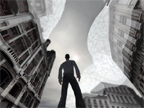
Transmittable Architecture
International premiere of IMPLANT :: A networked virtual world and installation created by Thomas Soetens and Kora Van den Bulcke, Workspace Unlimited :: IMPLANT will take place at the Vooruit Kunstencentrum in Ghent, Belgium, inside the Domzaal and outside on the gallery street window. Simultaneously IMPLANT will be networked with the project EXTENSION a virtual world installation at the Society for Art & Technology in Montreal and DEVMAP a virtual world installation at V2_Institute for the Unstable Media in Rotterdam. The opening event will be live streamed from the Vooruit and can be followed at the SAT and V2_Institute in the networked virtual world installations!
About the work: Text by Wayne Ashley, Independant Curator, New York :: Workspace Unlimited's new work IMPLANT is both an electronically networked interactive virtual world and an installation physically situated in the magnificent Art Nouveau building of Vooruit, a performance venue in the center of Ghent. Founding members artist Thomas Soetens and architect Kora Van den Bulcke create a digital 3D version of the entire building and its surrounding environs which users can access and navigate on computers from inside Vooruit and simultaneously from the Society for Art and Technology in Montreal, and V2_ Institute for the Unstable Media in Rotterdam. In this way Soetens and Van den Bulcke exercise their most compelling gesture: re-imagining Vooruit as transmittable architecture, an ongoing and revisable place that does not adhere to our ordinary understanding of physics, nor to the continuities of space and time.
Once logged into IMPLANT, visitors navigate through two co-existing architectures: a sumptuous simulation of the real Vooruit, a large complex maze of theater spaces, cafes, meeting rooms, and offices which can be traversed in much the same way we move through physical space--walking upstairs, through doors, down corridors, around corners, inside and out. And a hidden hyperlinked architecture that emerges as users interact with the simulation's various walls and ceilings. This secondary architecture is a malleable, almost liquid space that is contingent and constantly in flux-portals that transport us immediately to continuously shifting destinations within Vooruit according to the position of the visitor; virtual cameras that allow us to secretly follow other visitors and project their journeys and activities onto walls in front of us; the ability to walk through the projection and find ourselves together with them in the same space.
Outside on the real street, passersby will peer into Vooruit's glass lobby only to see a projected simulation of the same lobby seamlessly integrated within Vooruit's facade. Instead of seeing the usual theatergoers purchasing tickets and socializing with friends, viewers will observe the goings-on of avatars, graphical representations of actual people in Vooruit co-mingling and exploring the same simulated space with their counterparts from Montreal and Rotterdam. A web cam outside Vooruit captures the scene on the street, projecting the performances of everyday life back into the virtual world for those inside Vooruit, V2_ and SAT to witness. The effect is dizzying as the borders between inside and outside the virtual world become unclear, and who is performing for whom confused.
The longer visitors explore IMPLANT, the more layers they encounter. Embedded throughout the virtual world and triggered at various moments users encounter video and sound documentation from a recent online symposium called Breaking the Game. The symposium brought together an international group of competing theorists and practitioners to build, debate and reflect on virtual worlds, computer gaming, immersive technologies, and new possibilities for artistic practice and experience.
Workspace Unlimited is interested in breaking down oppositions between practice and theory, interior and exterior, imagination and perception, seeing and being. Soetens and Van den Bulcke seek to explore creative ways of making virtual worlds that are simultaneously intellectual, poetic, and hallucinatory.
Events:
V2_Institute, Eendrachtsstraat 12, Rotterdam, the Netherlands :: Sept. 15 at 17:00 V2_ Ground floor: Lecture by Thomas Soetens and Kora Van den Bulcke streamed in the virtual world installation.
Society for Art & Technology, 1195 Saint-Laurent, Montreal, Canada ::
Sept. 15 at 11:00 am (local time Montreal) Ground floor: Lecture by Thomas Soetens and Kora Van den Bulcke streamed the virtual world installation. :: Sept. 15 - 16 - 17 Ground floor: Exhibition of the interactive virtual world installation.
Workspace Unlimited website: www.workspace-unlimited.org
IMPLANT credits: Artistic direction and creation: Thomas Soetens and Kora Van den Bulcke; OpenGL programming: Patrick Bergeron; Quake 3 programming: Matt McChesney; Modeling and character design: Jason Dovey; Network setup: Simon Piette, Brecht Vermeulen (IBBT), Thomas Bouve; Modeling and character design: Jason Dovey; Communications: Stoffel Debuysere; Copywriting: Wayne Ashley, independant Curator.
Posted by jo at 08:05 AM | Comments (0)
September 01, 2006
Turbulence Commission:

THE ESSENCE OF A NATION: CHINESE VIRTUAL PERSONS ON THE NET
THE ESSENCE OF A NATION: CHINESE VIRTUAL PERSONS ON THE NET by XiaoQian [needs Macromedia Flash Player plugin; Internet Explorer 5+, Mozilla Firefox 1.5.0+, or Safari 1.0+]
My name is XiaoQian, I am an artist and I create virtual persons online. For this website I created 6 chinese virtual persons: Mu Yuming a painter, Shaxpir a hip-hop singer, Wang Shy a ghost in a traditional garden, He Zhengjun a carpenter working with wood and text, Yi Zhe a guest in a wedding and myself XiaoQian. My e-mail is xiaoqian at virtualperson.net
"THE ESSENCE OF A NATION: CHINESE VIRTUAL PERSONS ON THE NET" is a 2005 commission of New Radio and Performing Arts, Inc., (aka Ether-Ore) for its Turbulence web site. It was made possible with funding from the Andy Warhol Foundation for the Visual Arts.
BIOGRAPHY: XiaoQian is a Chinese artist. Her art is to create virtual persons online. She has also designed herself as a virtual person. Her real life identity may never be disclosed.
Posted by jo at 01:58 PM | Comments (0)
OPERA.tion LIFE NEXUS
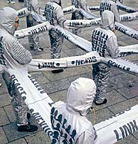
An Evolving Opera
OPERA.tion LIFE NEXUS: Jorge Orta began this mixed media work in 1996 and it will evolve and grow in length until 2006. Based on interdiciplinary collaborations, 3 generations of artists are invited to create a module for the open-ended composition: music scores, dance sequences, sculpture, light and video projections. The federating theme is the heart = Life, the creative idiom from both a symbolic and Human perspective. Its complex mythology renders the symbol poetic.
The Babylonians designated the heart the center of intelligence and memory. For the Egyptians it represented the terrestrial support for the soul. Hypocrite refer to the heart as the intelligence organ. Plato believed the heart was the center of feelings and passion. For Aristotle the heart transformed food into blood and was the emotional centre. Its universal nature helps to converge cultural, social, religious differences and from a scientific angle it exposes a new vision of a medical problem.
OPERA.tion is a locus for debate to address the sensitive subject of life saving organ donation; thousands of people are on a waiting list for organ donations... [F]renzied individualism has left society without hearts and heart !
The opera comes in a kit format and adapts to all venues. Crate sculptures facilitate the transport, preserve the archive of resulting collaborations: objects, music scores, video and photographic works, CD Roms, silkscreen prints, visual poetry, paintings, Body Architectures…, are stored in the wooden crates, which in turn are labeled and stamped with the origin of the multiple actions throughout the world.
Jorge Orta (Rosario, Argentina 1953) lives in Paris Artist and architect, Jorge Orta has been working on large scale ephemeral works since 1973. Protagonist of an urban and social poetic language, he has developed many new and alternative forms to communicate : using mail art, video installations and performance in the early 70's, to large scale projections in the 80's. Over the last 20 years he has devised a polysemic alphabet of signs and symbols which allow him to address very diverse publics, and more recently he has been exploring the symbol "Heart" to consolidate art, mythology and science. Jorge's light projection work took on its veritable dimension in 1992 when he projected giant mobile images inside the Pompidou Centre in Paris and when he embarked on a human experience to project his signs on Machu Picchu mountain in Peru. Since, he has covered the facades of the Venitian palaces at the 1995 Venice Biennale, and more obsolete places such as Capadoccia in Turkey, Cuenca in Spain, Aso volcano in Japan, Chartres and Evry cathedrales and many more.
Posted by jo at 12:09 PM | Comments (0)
August 30, 2006
NETWORKED_PERFORMANCE
![]()
Joburg-Derby-London & You
The Premises Gallery at The Johannesburg Civic Theatre invites you to join us for a Red Bull and some live online performance: NETWORKED_PERFORMANCE VisitorsStudio performance Joburg-Derby-London live at The Premises and online at http://www.visitorsstudio.org.
A live-online collaborative performance by Nathaniel Stern, Marc Garrett and Ruth Catlow. And open laptop mixing by audiences and invited local artists at the Premises Gallery (Johannesburg), HTTP (London) and Q Arts (Derby).
EVENT: Saturday 2nd September, 16:30 – 19:00 (SA time)
Getting started and uploading at The Premises: 16h00 (SA time)
Live scheduled performance: 17h00- 17h30 (SA time) and 16h00 - 16h30 (UK time) by Nathaniel Stern, Marc Garrett and Ruth Catlow
Open collaborative mix: 17h30 (SA time) and 16h30 (UK time) Everyone welcome to join!
![]()
About VisitorsStudio: an online place for real-time, multi-user mixing, collaborative creation, many to many dialogue and networked performance and play. VisitorsStudio is a Furtherfield project @ http://www.visitorsstudio.org. VisitorsStudio is included in the Game/Play networked touring exhibition. A collaboration between Q-Arts, Derby and HTTP, London. Please see www.game-play.org.uk for further information.
How to PARTICIPATE
First, get the latest flash player on your computer. South Africans wishing to participate can bring their laptops (with ethernet cables) or content to The Premises a bit early, and upload content on our open network via their own machine or one of ours. Or, upload anywhere, anytime - you can even mix with us from Cape Town. If you want to be part of the VS performance by nathaniel, be sure to name your files beginning with SA_, and then an idea of what it is he would be including in the mix. If you want to play on your own, supply names for your files that you will remember. File types supported are jpg, png, mp3, flv and swf files, as long as they are under 200k.
More info, and to play: http://www.visitorsstudio.org
SPONSORED BY:
http://furtherfield.org
Art & Technology, Johannesburg, Co-directed by nathaniel stern and Prof Christo Doherty
Red Bull South Africa
the trinity session
The Premises at the Johannesburg Civic Theatre
The Premises at the Johannesburg Civic Theatre
Loveday Street, Braamfontein, Johannesburg, South Africa
+27 (0) 11 877 6859
thepremises[at]onair.co.za
Gallery Hours -
Tuesday - Saturday
10h00 - 17h00
office[at]onair.co.za
Directors -
Stephen Hobbs
+27 (0) 11 403 8358
sh[at]onair.co.za
Marcus Neustetter
+27 (0) 11 339 2785
mn[at]onair.co.za
Posted by jo at 01:25 PM | Comments (0)
August 28, 2006
SHIRLEY BASSEY GETS MIXED UP
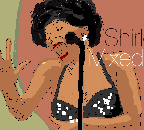
A Collaborative Biography
Shirley Bassey Mixed Up is a collaborative biography: an illustrated biography of the legendary diva, where the reader helps to 'mix' the illustrations online, using Internet searches. The biography was inspired by an incident on a TV awards show last year, where Bassey was publically humiliated. I felt sad to see this happen, and wanted to know more about what led up to this. All illustrations are built on-the-fly from live Yahoo searches. By specifying different searches and playing with the customisation options, the reader creates the illustrations themselves. This is a traditional (linear) 14-page story built on top of a generative composition tool, that uses Internet search data as its input.
The work can be described as a networked narrative, as a story partly created by networked data. Adding unexpected and uncontrolled elements to the story influences and changes the presentation, how it's experienced and what we take away from it. This shapes the story, changing fact into fiction, sometimes disrupting the story. As the networked elements are dynamic and largely unpredictable, every version of the biography is unique. Your version of the story is packaged into booklet form, for you to print and keep.
About Dave Miller: Dave Miller experiments with illustrated stories and networked media. More of his work can be seen here. [Related]
Posted by jo at 09:16 AM | Comments (0)
August 25, 2006
Interactive Architecture dot Org X 4

Robotic Art
You Move Me (Work in Progress) by Lara Greene [cable tests movie 58MB - requires QuickTime] :: The figure is a fully articulated machine that moves via cables extending out from within the body to multifunctioning levers that can be pushed pulled and twisted to create various movements and affect it's position in space. A group of up to 6 people will be required to operate the piece, these being visiting members of the public. The figure has the capacity for elegance or awkwardness, dependent upon the level of people's control and ability or desire to co-operate with each other. People will struggle with or surmount this challenge, as she responds and embodies these conditions the character will come to life allowing people to empathise and respond in return. You move me is a tool for expression that draws people together in a web of interdependency provoking many forms of communication. [via Interactive Architecture dot Org]
Hysterical Machines - Bill Vorn
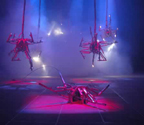
Bill Vorn is working in the field of Robotic Art since 1992. His installation projects involve robotics and motion control, sound, lighting, video and cybernetic processes. He pursues research on Artificial Life (and Death) and Agent Technologies through artistic work based on the Aesthetics of Artificial Behaviors.
Each Hysterical Machines has a spherical body and eight arms made of aluminum tubing. It has a sensing system, a motor system and a control system that functions as an autonomous nervous system (entirely reactive). Some machines are suspended from the ceiling and their arms are actuated by pneumatic valves and cylinders. Pyroelectric sensors allow the robots to detect the presence of viewers in the nearby environment. They react to the viewers according to the amount of stimuli they receive. The perceived emergent behaviors of these machines engender a multiplicity of interpretations based on single dynamic pattern of events.
The aim of this project is to induce empathy of the viewer towards characters which are nothing more than articulated metal structures. The strength of the simulacra is emphasized by perverting the perception of the creatures, which are neither animals nor humans, carried through the inevitable instinct of anthropomorphism and projection of our internal sensations, a reflex triggered by any phenomenon that challenges our senses.
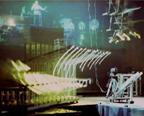
The Mechanized Eccentric Performance Series
Louis-Philippe Demers is a multidisciplinary artist using machines as media. He has worked on the conception and production of several large-scale interactive robotic installations, so far realizing more than 225 machines. 'In a more pronounced way than traditional theatre, mechanical theatre becomes a space for a collective consensus of the acceptation of simulacrum (even more surreal). The level of abstraction of the mechanical theatre enables a multiplicity of interpretation, it is an open ended work where each person sees a reflection of its own feelings.' (See Video)
The Mechanized Eccentric Series is a collection of several installations and performances united together in a large spectacle.
The Series regroups:
L'Assemblee, 48 robots layed out on an arena;
Colony 001, 8 robots and 1 central robots, a comment on nanotechnology;
Colony 002, 8 robots caught in cages;
The robotic characters of Armageddon (an operetta for robots) and a choir of 12 members;
and the two main robots of Le Proces.
Each robot is equipped with speaker(s), light(s) and motion(s) enabling the whole environment to become a vast surround soundscape. Namely, the performances include 6 voices of ambient sound plus a range (8 to 32) of independent robot sounds.
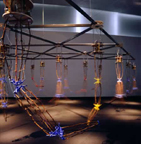
I thought after a week mainly showing some robotics based projects, I'd post a little about one of my favourite pieces of work by one of my favourite artists, Ken Rinaldo. Video
Ken Rinaldo is an artist and theorist who creates interactive multimedia installations that blur the boundaries between the organic and inorganic. He has been working at the intersection of art and biology for over two decades working in the catagories of interactive robotics, biological art, artificial life, interspecies communication, rapid prototyping and digital imaging. Rinaldo teaches interactive robotic sculpture, digital imaging, multimedia and Directs the Art and Technology program in the Department of Art at The Ohio State University in Columbus Ohio.
It consists of fifteen robotic sound sculptures that interact with the public and modify their behaviors over time. These behaviors change based on feedback from infrared sensors, the presence of the participant/viewers in the exhibition and the communication between each separate sculpture. This series of robotic sculptures talk with each other through a computer network and audible telephone tones, which are a musical language for the group. Autopoiesis is "self making", a characteristic of all living systems which was defined and refined by Francisco Varella and Humberto Maturana. The interactivity engages the viewer/participant who in turn, effects the system's evolution and emergence. This creates a system evolution as well as an overall group sculptural aesthetic.
In Autopoiesis the robotic sensors compare their sensor data through a central-state controller, so the viewer is able to walk through the sculptural installation and have the arms interact both individually and as a group. Because each arm has its own on-board computer control, the overall speed of reaction is rapid and therefore, life-like. Local control always supercedes group control when a local sensor is aware of a human nearby. This also allows individual arms to show accuracy and delicacy of approach and avoidance when encountering the viewer/participant. At the tip of two of the arms, lipstick cameras project what they see onto the walls of the space. This gives the viewer/participant a sense of being observed by this artificial life robotic sculpture.
Also see Regine from wmmna's recent interview with Ken Rinaldo.
Posted by jo at 09:00 AM | Comments (0)
August 23, 2006
Seven Maps
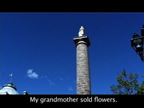
Call and Response
When filmmake /videoblogger Daniel Liss challenged himself to make 7 videos in 7 days, he also challenged his online audience to collaborate with him in the process. His daily assignments came from viewers of his videoblog who determined where, about what and how he should make each video.
Each day, they posted an assignment and each day Daniel posted a video in response. Then came praise and criticism in the comments of each day's videoblog post. The process took him miles from home, he told personal stories, invented new narratives, and played more than a few tricks on his guiding/goading audience.
For this video he was given the assignment, 'oday, you are a local. Trick us into believing that you are a local. Tell us a story about your history.' The entire Seven Maps series can be seen here : http://pouringdown.tv/sevenmaps [blogged by mica scalin on DVblog]
Posted by jo at 08:47 AM | Comments (0)
August 18, 2006
MPG: Mobile Performance Group
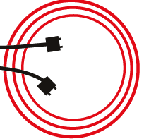
Art to Go
Founded by Matt Roberts, the MPG: Mobile Performance Group is a collective of new media artists interested in finding new ways to present art outside of traditional venues. MPG disseminates their work by using automobiles, video projection, cell phones, FM transmission, wireless hotspots, and any other technologies that allow artist to engage the public.
Parking Spaces investigates one of the most ubiquitous spaces in the United States, the parking lot. MPG moves through the city looking for empty parking lots to collect sounds and images. Using the collected material MPG creates an improvised performance in the space. Images from ZeroOne ISEA2006. Multi media feature from Mercury News. Flickr.
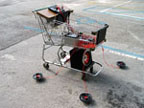
Shopping Carts: Using recycled cardboard, solar power, batteries and multimedia equipment, MPG converts shopping carts into modular performance units. During the day the carts are used to collect energy, sounds and images. Each cart is equipped with solar panels and batteries for energy collection. They are also equipped with audio/video recording equipment for sound and image collection. During the night carts carry panels, made of recycled cardboard, that allow several carts to connect and provide table space for the performers. The three basic carts are audio, video, and power. The audio module carries speakers, amps and mixing board. The video module carries video projectors, cameras, and lcd screens. The power module carries batteries, inverters and power strips to provide power for the performers.

Inflatables: A series of inflatables that can be used as performance space and projection screens. MPG is working with designer Gerry Christensen and a group of his students to create a series of apparatus for mobile performance. These apparatus include a bike trailer with a hybrid power source and wearables for performance space. The bicycle trailer is equipped with solar panels for energy collection and storage, and has the ability to tap into public power outlets. The trailers can cary multimedia equipment, local wireless network, and provide portable power. The wearable are portable devices that performers can wear to carry equipment and also convert into seating/table space for performance.
More information here. [thanks Craig]
Posted by jo at 10:29 AM | Comments (0)
August 17, 2006
Full Contact Concert

Let's Get Physical
Vollkontaktkonzert - Full Contact Concert, by Stefan Brunner and Michael Wilhelm, arranges a musical composition out of a boxing match. Two performers are equipped with microphones. One microphone, connected to a stethoscope underneath the scapula of the performer’s back, records the repercussion of the beats hitting his chest. The other microphone, glued to the performer’s chin, records his breath.
The sounds are post-processed on the laptop controlled by a third person. The whole piece of music unfolds: the introduction is the warm up. Then the performers put on the boxing gloves and a beat-part begins: performers start beating each other in turns. Two punches to the stomach then one to the chest, two to the stomach, one to the chest, etc. It goes faster and faster until the break, all you can hear is the performers' breath and sounds from the laptop. After they have recoverd from the exhaustion, the boxers start to treat each other with more punches to their chests and stomachs.
The video isn't particularly spectacular but i still like the concept. More images. Via Vvork.

There's a few boxing performances and installations around: Videoboxing, a video performance in which Thomas Heijmans and Eliane Roest merge video, new media, music, fashion, choreography and physical violence on stage; Telephoneboxing (left), by Allard Roeterink, turns the phone call into a hard-work physical process; Soundslam, a highly sensitive punching bag with built-in trainer; Cyclone Uppercut, a boxing game that runs in Virtual Reality Simulators. [blogged by Régine on we-make-money-not-art]
Posted by jo at 07:28 PM | Comments (0)
August 10, 2006
INTERVIEW: Local: 0, Global: 1.

Igor Stromajer by Ignacio Nieto
INTERVIEW: Local: 0, Global: 1. Igor Stromajer / Entrevista a Igor Stromajer by Ignacio Nieto :: This interview is published in Spanish and English ::
Ignacio Nieto: In an interview for the 24th issue of Neural, you said that you prefer low-tech software for use by the public; do you think that a big part of technology that has been commercialized since the ‘90s no longer has any relevance today? And if it is so; which and why, would be for you, the models and/or protocols that are out of this marketing logic?
Igor Stromajer: Today nothing is outside the marketing logic, not even free software. Nowadays also the basic democracy is expensive and is a part of the logic of the capital. You have to pay for nature, for water and for intimacy; therefore it’s normal that there is no such thing as non-marketable protocol or software. But since we can’t do bigger revolutionary steps anymore, small steps are of an extreme importance. We have to be very flexible, dynamic, inventive and resourceful, learning how to use time-limited free software, freeware and shareware programs, beta versions and demos. By actively and constantly following this development on the Internet market, we’re able to do almost everything with our computers, without paying anything. That includes guerrilla tactics, of course, and learning modern marketing strategies. [continue reading at newmediaFIX]
Posted by jo at 06:53 PM | Comments (0)
Regrets
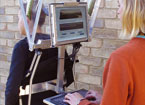
Collective Remorse
Ars Electronica, Hauptplatz :: September 1-5 2006 :: 10:00 am - 8:00 pm :: Regrets--by Graham Budgett and Jane Mulfinger (US)-- are often the conceptual vehicle of self-improving tendencies, but they are rarely communally active in any meaningful way. The Regrets team seeks to intervene and enable such interaction. In particular, remorse is posited here as a positive entity, incorporating recall, reflection, and learning.
Five custom mobile computer units roaming public space in and around a chosen city, community, or event, collect anonymously submitted regrets from the public, gathering and comparing them to comprise a sociological database of contemporary regret. Instant feedback to the individual user based on other contributors' similar concerns is algorithmically generated to 'share the burden'. Random selections of the regrets are made public via locally negotiated sites and existing signage, network, and broadcast facilities. The archive represents a glimpse of a given community at a particular time through the rubric of regret; its results available for future studies.
Posted by jo at 04:30 PM | Comments (0)
August 08, 2006
Chit Chat Club

A Teatime Telepresence
Chit Chat Club is an experiment in bringing together the cafe and the online world. Chit Chat Club is now live. In a cafe in downtown San Jose, three inhabitable sculptures sit at tables, waiting to be brought to life. One is an undulating form, another a chair just starting its metamorphosis into human form, and the third is a giant spoon. Be one.
WHEN: August 7-13 :: 8am to 10pm Pacific Time :: WHERE: ISEA Interactive Cafe, San Jose Museum of Art, San Jose, CA and/or http://chitchatclub.org
Cafes are social spaces - they are places where people come to converse, to meet friends, to people watch. It is a physical space, rich with the smell of coffee and the sound of chatter, a navigable place that people must negotiate to find good seats, to see and be seen. The cafe is local, fixed in space and reflecting and defining the social structure of the neighborhood.
The online world is also social, but far less physical. Its inhabitants have no bodies, its borders are porous. It is global rather than local. Yet there is a different kind of depth that exists in the online world, a depth of persistence, of vast collections of data, of conversations that remain permanently archived, unlike the ephemera of the spoken word.
Conversing online while in a cafe is not of course a novel idea. Many cafes today feature wireless access, and patrons read blogs, write email, instant message, etc. Yet this arrangement moves the patron's attention from the public and physical space of the cafe to the private world of these typed interactions.
Chit Chat Club brings the online visitors into the public physical space of the cafe. It does this by both providing them with a view of the cafe and by giving them a physical presence with it.
Posted by jo at 02:55 PM | Comments (0)
July 31, 2006
Freq2
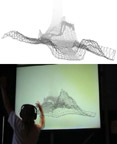
Body as Audible Instrument within Sonic Composition
Freq2, by Squidsoup, uses your whole body to control the precise nature of a sound – a form of musical instrument. The mechanism used is to trace the outline of a person’s shadow, using a webcam, and transform this line into an audible sound. Any sound can be described as a waveform – essentially a line – and so these lines can be derived from one’s shadow. What you see is literally what you hear, as the drawn wave is immediately audible as a realtime dynamic drone.
Freq2 adds to this experience by adding a temporal component to the mix; a sonic composition in which to frame the instrument. The visuals, an abstract 3-dimensional landscape, extrudes in realtime into the distance, leaving a trail of the interactions that have occurred. This ‘memory’ of what has gone before is reflected in the sounds, with long loops echoing passed interactions. The sounds, all generated in realtime from the live waveform, have also been built into more of a compositional soundscape, with the waveform being played at a range of pitches and with a rhythmic component.
Watch video. Freq2 was commissioned for Cybersonica 06 and shown, as part of Cybersonica 06, at various venues across the UK including Tate Britain, Dana Centre, Phonica and b-tween (National Museum of Photography, Film and Television). More from Squidsoup: Altzero, Come Closer, Doodle. More from Cybersonica 06. [blogged by Chris on Pixelsumo]
Posted by jo at 05:51 PM | Comments (0)
July 21, 2006
BUMP…
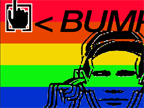
Reinstates the Virtual World with an Offline Voice
Artist Jaygo Bloom has been commissioned by folly, a media arts organisation based in Lancaster, to develop the sound work BUMP… for this year’s Futuresonic festival, in partnership with Manchester based digital signage organisation Pixel Inspiration. Futuresonic is the UK’s leading electronic and media arts festival, and takes place in Manchester in July 2006. According to Jaygo Bloom, the commissioned artist, "As computer technology becomes more sophisticated, the technology itself will fade into the background of human activities, becoming far less intrusive than is the case today."
Jaygo Bloom suspects the invisible, therefore he seeks to reverse the need for this technological transparency. BUMP… reinstates the virtual world with an offline voice. BUMP… is an online project that translates an online keystroke into an actual real time and physical event. BUMP… will reinstate the presence of this technological intervention over its environment via the quick shot, rapidfire, 8bit sounds emanating out of its location based folly sound modules located throughout participating venues of Futuresonic 2006. BUMP… presents an interesting view of networked interaction and social performance.
Jaygo Bloom concludes, "By attaching a physical connection to things we perceive as virtual, we can begin to make the intangible tangible."
Jaygo Bloom is a UK based multimedia artist whose practice includes audio visual installation, game hacking, film making and physical computing. Over the past year he has been developing a wide variety of new online and offline projects ranging from his globally aware interactive games console ‘Tao Joystick’ to his 8bit latino percussion interface ‘Marrackattack’. Working independently and also as part of the Glasgow based audio visual team 'Pointless Creations'. Popular for his public interventions, blue screens and old sports car, other successful projects have included Glasgow International05, Pixelache05, Recontres Paris/Berlin, and Pong.Mythos.
Posted by jo at 04:27 PM | Comments (0)
July 19, 2006
Intimacy and In.yer.face
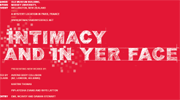
Blurring Online and Physical Performative Space
Intimacy and In.yer.face (July 20th, 8 p.m. (NZ time)) is a live performance / installation event and remix project, featuring an interdisciplinary selection of local and international artists, operating in the nexus between art and technology. Our conception of site is fragmented when agents participate from spatially dispersed locations, and when the boundaries between online and physical performative space are blurred. Intimacy and In.yer.face explores this fragmentation, the endless and cyclical encoding and decoding of information that occurs in the interface between humans and machines.
Curated by Daniel Agnihotri-Clark, Intimacy and In.yer.face commences with a one-night event featuring simultaneous live performances and interactive installations, linked by real-time streaming of audio and video signals which will be broadcast over the internet. The event will feature new works by the globally dispersed cyberformance troupe Avatar Body Collision (New Zealand, London, Helsinki), the interdisciplinary artist Kartini Thomas (Wellington), aerialists / actors Pipi-Ayesha Evans and Rhys Latton (Wellington), and audio / video artists Emil McAvoy and Damian Stewart (Wellington).
The performance/installation event will take place on July 20th in the former Dominion Museum Building, Wellington (8 p.m. NZ time), at a mystery location in Paris (10 a.m. FR time), and everywhere else via http://www.intimacyandinyerface.net. Intimacy and In.yer.face is truly a simultaneously local and global event, pushing the understandings of site and indeterminate modes of performance practice in the interface with technology. Intimacy and In.Yer.Face follows last year's Indeterminacy and Interface - the first of performance event curated by Daniel. These projects form a significant component of his on-going doctoral research at the Massey University School of Fine Arts.
Following the performance / installation event, an open call for remix will expand the role of the audience, facilitating active participation and dialogue. Audio and video files will be available for download from the website. This remixed material will then be collated into a limited edition DVD release.
For full information about the project and the artists involved please see
http://www.intimacyandinyerface.net
Intimacy and In.yer.face
July 20th, 8 p.m. (NZ time)
Old Museum Building, Buckle St, Wellington, New Zealand
and Mystery Location, Paris
and http://www.intimacyandinyerface.net
Online Soiree
http://www.intimacyandinyerface.net
10 a.m. - 12 noon NZ time/ 10 p.m. - 12 a.m. FR time
Artist/Curator talk
School of Fine Arts seminar room, Block 2, Level C, via Gate C, Wallace St.
12.15 p.m.
For further information, images or to arrange an interview with the participants please contact: Louise Menzies, on tel: 04 801 2794 x6197, email: L.C.Menzies[at]massey.ac.nz. or Aaron Kreilser on tel: 04 8012794 x6341, email: A.P.Kreisler[at]massey.ac.nz.
Posted by jo at 02:33 PM | Comments (0)
July 18, 2006
Turbulence Commission:
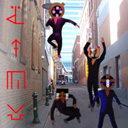
SWM05: Distributed Bodies of Musical-Visual Form
SWM05: Distributed Bodies of Musical-Visual Form [SWM05] -- by Troy Innocent and Ollie Olsen with the Shaolin Wooden Men and Harry Lee -- features the distributed bodies of musical-visual form that are inhabited by the Shaolin Wooden Men (SWM), a virtual band, a 'gang of numbers' -- me(a)tacodeflesh. SWM require your assistance to manifest as media creatures. They invite you to send them images of your local environment in which they can appear. Sending images unlocks access to the SWM05 mobile site which consists of downloadable micromusic ringtones and small screen machinima performances. The SWM are everywhere. In a meshwork of wireless entities, they are media creatures seeking a fragmented existence to be consumed in the nanoseconds of play-time in the emerging wireless net. SWM05 will transfigure the SWM by embodying them in a new materiality.
SWM05: Distributed Bodies of Musical-Visual Form is a 2005 commission of New Radio and Performing Arts, Inc., (aka Ether-Ore) for its Turbulence web site. It was made possible with funding from the Andy Warhol Foundation for the Visual Arts.
BIOGRAPIES
The SHAOLIN WOODEN MEN are a 'gang of numbers' whose bodies are 'made of sound'. In their various manifestations they have released three full-length recordings - "S.W.M. " (1992), "The Hungry Forest" (1994) and "Supermindway" (2001) - and a collection of singles and remixed released on the Psy-Harmonics label. The S.W.M. work across image, sound and interactivity and have performed at DEAF96 and exhibited at ISEA96. Typically, they require the assistance of creative humans to manifest as media creatures to be distributed across the net.
TROY INNOCENT has been exploring the 'language of computers' and the new aesthetics of digital space since 1989. In recognition of this work, Innocent has been described as "the first philologist of virtual reality". His artificial worlds – Iconica (SIGGRAPH 98, USA), Semiomorph (ISEA02, Japan), and lifeSigns (Ars Electronica 2004, Austria) and Ludea (SIGGRAPH2006, USA) – explore the dynamic between the iconic ideal and the personal specific, the real and the simulated, and the way in which our identity is shaped by language and communication. He is currently Senior Lecturer, Department of Multimedia and Digital Arts, Monash University, Melbourne.
OLLIE OLSEN is an Australian composer, synthesist and sound designer who has been producing and performing rock, electronic and experimental music for the past thirty years. Projects include "Max Q," "NO," "Third Eye," "Orchestra of Skin and Bone," "Shaolin Wooden Men," and "I am the Server." Some recent collaborations and projects include performing with Negativland (from USA-2001); guest soloist with the Australian Art Orchestra (2002); and recording with Japanese bands, BOREDOMS and AOA (2001-2002.
HARRY LEE is a web developer working with Macromedia Flash, SQL, PHP and related technologies. Recent projects include database development for lifeSigns, exhibited at the Australian Centre for the Moving Image (ACMI) in 2004, in addition to numerous corporate and education projects. He lectures in multimedia and digital arts in the Faculty of Art & Design at Monash University.
Posted by jo at 01:06 PM | Comments (0)
July 12, 2006
Guerrilla Net Ballet Performance: Ballettikka Internettikka:
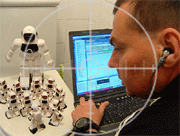
VolksNetBallet
Guerrilla Net Ballet Performance: Ballettikka Internettikka: VolksNetBallet by Igor Stromajer & Brane Zorman :: People's Internet Ballet furtively performed at -- and secretly broadcasted (as six one-minute live streaming videos) from -- the Basement Toilet in Volksbühne at Rosa-Luxemburg Square in Berlin, Germany; # Latitude: 52.31.36.84 N, Longitude: 13.24.43.02 E, Terrain Elevation: 41 m on Sunday, July 9th 2006 at 9 PM GMT+1 (Berlin/Paris local time). "Stromajer and Zorman manipulated a semi-automatic flying cow and eleven robots dancing an internet ballet, MC Brane conducted an MP3 orchestra!"
VolksNetBallet was broadcast in the form of six one-minute streaming videos, almost live, with only two minutes delay. It means that the visitors could see and hear in six steps what had just happened only two minutes earlier during the VolksNetBallet in Volksbühne Basement Toilet. All six videos were edited live in-camera, using only STOP and REC functions, then immediately converted to Real Media files using Real Producer, and finally, transferred to the server for viewing.
Ballettikka Internettikka is an ongoing artistic study of the internet guerrilla performance. After invading The Bolsh.oi Theatre in Moscow (March 2002), La S.cala in Milan (November 2004) and The National Theatre in Belgrade (October 2005), Stromajer and Zorman performed a new guerrilla net ballet, this time in the men's toilet in the basement of Volksbühne Berlin. The artists utilized low-tech mobile and wireless equipment for the invasion and live broadcast: a public unprotected wireless internet connection point (wLAN), available for free at the Rosa-Luxemburg Square in Berlin (ID: Helmut22; signal strength in the basement of Volksbühne: 2/5), free RealProducer (version 11.0) and Live LE software for streaming video and audio live manipulation. Ballettikka Internettikka: VolksNetBallet took place on the very same evening and at the very same time as another huge people's festivity -- the final match of the World Soccer Cup 2006, which also took place in Germany.
Dancing a wireless people's internet ballet in Volksbühne Berlin represented a big conceptual and strategic challenge to the Intima Virtual Base and all the collaborators, therefore, the preparations were taken seriously, safety measures were calculated, and the previous experiences from the Bolsh.oi Theatre in Moscow, La S.cala in Milan and The National Theatre in Belgrade were very welcome.
Note: Volksbühne Berlin did not voluntarily co-operate in the project, but was selected based on the conceptual strategy of the project. The management of the Volksbühne Berlin was not a co-producer of this project and did not co-operate in the process of its realization.
Posted by jo at 06:13 PM | Comments (0)
July 10, 2006
Chasing Pools and Sampling Ghats

HIDRAZONE ISSUE 002 X 2
Chasing the Pools is an immersive performance/installation working with integra-ting the live presence of dancers into the landscape of a multi-channel live-mix video installation. Often the two present very different viewing circumstances that remain independent of one another.
Through live-feed cameras the movement of dancers was mixed into the alpha channel of 3 video mixes. Their lit bodies became one moving image, dematerializing or re-materializing the body, while the background remained another. The dancers were able to monitor how they were affecting the composited image, essentially dancing with the image.
These channels were projected onto numerous scrims in a large tree grove. Twelve channels of sound by live musicians were mixed and spatialized throughout the site. The architecture of a tree grove naturally imposed a de-centralized structure upon the viewer where one’s experience was shaped by the act of meandering through, never being allowed a view of the whole.

Samples of the Ghats is a responsive installation that invites the audience to explore the ghats of Haridwar, India by composing themselves its audio-visual atmosphere.
A 5 metre long structure featuring a panorama of the ancient and holy city of Haridwar framed with technology is a stimulus to curiosity, an appeal to exploration. Cruising along the panel visitors soon discover that they can "play it." With the simple move of his hands he launches media sequences. They are audio and visual samples, pieces of Haridwar, collected and edited in a way to generate an atmospheric feel of the ghats.
In a collective experience, the panorama comes to life and the adventure begins.
More Hidrazone Issue 002: Performativity
Posted by jo at 07:26 PM | Comments (0)
July 07, 2006
INTIMATE TRANSACTIONS

Sensing Place Through a Complex Web of Relations
Presented by the Brisbane Festival 2006, and Centre Of Contemporary Art, Cairns and conceived and developed by Transmute Collective, Intimate Transactions is a new type of interactive installation that allows two people, located in geographically separate spaces, to interact simultaneously using only their bodies. As this highly immersive experience evolves through digital image, sound and tactile feedback, each person begins to sense their place in a complex web of relations that connects them and everything else within the work.
VENUES: The Block, QUT Creative Industries Precinct, Musk Ave, kelvin Grove & Centre of Contemporary Arts Cairns. DATE & TIME: Sat 15 - Sat 22 Jul; 11am - 2pm & 3pm - 6pm daily; Individual sessions every half hour. DURATION: 30 minutes per session. TICKETS: FREE event. BOOKINGS: Brisbane: 07 3864 5495; Cairns: 07 4050 9493.
Intimate Transactions has been shown extensively in Europe and Australia. It was awarded an Honorary Mention in the Prix Ars Electronica Interactive Arts category, 2005.
Transmute Collective are Keith Armstrong (Director), Lisa O’Neill and Guy Webster, and numerous key collaborators.
Posted by jo at 01:15 PM | Comments (0)
July 06, 2006
Always ON
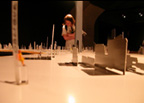
New Augmented Space and its Memory
The concepts of place, proximity and distance are going to be substantially rewritten by the locative media evolutions. The origins of this process are not only related to the abstract digitalization or to the latest hi-tech gadgets, but they are more significantly rooted in social changes induced by the overflowing of the net space. The social access and the subsequent construction of net space started in middle nineties, so the perceived 'space', as a public, collective and shared dimension was slowly literary doubled in the digital dimension. The next step is the actual ongoing process of joining back these two halves (real and virtual space) in an augmented reality that is a real experience. If the man on the moon broke the 'external' boundaries perception of that time, the net integrated in the urban space has definitively broken the actual inner spatial boundaries outdating the established physical perception as the only possible coordinates to sense the space.
The net is based on one hand on a subject (its IP) directly addressable from every (good or evil) point of view. On the other hand the same subject is able to add his own data and memory to his own space, building a digital environment piece by piece. These tough changes are investigated and enhanced in the impressive work made by the Sonarama 2006 curatorial team (José Luis de Vicente, óscar Abril Ascaso and Drew Hemment and Advanced Music). After Micronations (2004) and Randonnée (2005) the last part of this contemporary territory conceptual mapping has been accomplished through a selection that emphasize different "permutations of the mobile syntax" as de Vincente defines it. In the ground floor of the CCCB, the exhibited works were placed in dark corridors and rooms, that like a maze, was an ideal location.
The most awaited project was undoubtedly Blast Theory's premiere of 'The day of the figurines', a social multiplayer game played via sms, reflected in a fictitious world of real figurines. With more than three hundred players in three days (actually it can hosts up to one thousand players) it shaped a small world that was reflected in a physical update. In fact authors moved figurines and forms by hand every twenty minutes, updating the representation of the online latest developments. Here again the usual 'virtualization' of reality structures was inverted. The process was the opposite of webcams: instead of taking a glimpse of a real space, the mapping of the online process was a slow update of a plastic scenario, much more attractive and meaningful to our instincts than a real-time colorful graphic on a screen. In the locative media horizon, many are the shades of the distance.
Zexe.net was a project by The Golden Nica winner Antoni Abad with the same concept of giving mobile phone with cameras to special group of people and selecting their pictures/vision, focused on latin taxi drivers, gipsies and prostitutes. How far is their own landscape, represented through our shining technology? And changing perspective how far is our own home, if we can easily see it from a satellite view? Jeremy Wood's Meridians, a psychogeography text composed as a gps-draw on a very famous London area, remind us the shock of zooming on a photograph (not anymore an abstract color representation) of our own daily territory. This is impacting our neighborhood vision, temporary establishing a center where we live (or we are at the moment) and considering the world as a surrounding. It's a sort of ego-geography, able to stunningly visualize as real what we've already seen as a zoomed out draw.
Amongst the other showed (or performed) projects included Michelle Teran's classic Life's a User's Manual, Counts Media social platform Yellow Arrow, the last Transmediale software art award winner Socialfiction's .walk (article on Neural 23), another psychogeographical approach in Alejandro Duque's TTSM (Typewriter Tracklog sewing Machine), a new iPod version of the imaginative G-Player, the relationship between space and sensations in Christian Nold's Bio Mapping, the performance by accident, treasure hunt Geocaching practices and the RFID hacking of Preemptive media's Zapped! like the coackroach with an RFID on his back confusing a supermarket reader because of its unpredictable movements. The urban space is a collective memory mirror. And the memories of the last thirty years have been mediatised more than any previous period. The process of easily juxtaposing personal memories, histories and territories would enable another new level of consciousness of reality, stratified on our mediated identity. View the Sonar 2006 photo gallery. [posted on Neural]
Posted by jo at 12:27 PM | Comments (0)
July 05, 2006
Livecoding
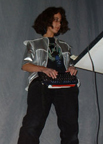
Kinetics of Performance
Watching programmers write code can be about as fun as watching paint dry, but a few pioneers are creating dynamic, musical performances based on programming languages such as Perl. Here are photos of a few of these artists at work. Check out our other photo galleries on our photo blog.
University of California, San Diego, art professor Amy Alexander performs sets using her own language, Thingee. Alexander says electronic music lacks the kinetic aspects of performance -- seeing a performer do something that has an audible reaction, so she shows crowds her code and enters script commands with guitar-like flourishes. Photo: Courtesy of Amy Alexander [via Wired's Livecoding blog]
Posted by jo at 08:20 AM | Comments (0)
July 04, 2006
Architecture and Situated Technologies
![]()
Pre-Symposium Discussion
A three-month long discussion will prepare the Architecture and Situated Technologies symposium in October 2006. Contribute or follow the discussion. This symposium is a coproduction between the Center for Virtual Architecture at the University at Buffalo, The Institute for Distributed Creativity, and the Architectural League of New York.
Introduction: The Architecture and Situated Technologies symposium, organized around the notion of an "encounter," will articulate new research vectors, sites of practice, and working methods for the confluence of architecture, art, and situated technologies.
What opportunities and dilemmas does a world of networked objects and spaces pose for architecture, art, and computing? How might this evolving relation between people and "things" alter the way we occupy, navigate, and inhabit the built environment? What is the status of the material object and the embodied human relationships in a world privileging networked relations between "things"? How do distinctions between space and place change within networked media ecologies? What post-optimal design strategies and tactics might we propose for an age of responsive environments, smart materials, embodied interaction, and participatory networks?
While there is an explosive growth of mobile devices, the social uses of technologies are not sufficiently studied in terms of architecture. What distinguishes the emerging urban sociality enabled by the Wireless Internet? How do these dynamics, including (non-)affective giving destabilize rationalized 'use case scenarios'?
These are just a few urgent questions that the symposium will raise.
Through a combination of public and closed segments (workshops, presentations, and panel discussions), the symposium will stage a set of encounters between invited participants, an audience encouraged to participate, and the City of New York.
List facilitators:
July: Trebor Scholz
Topics: Networked Public Sphere, Autonomous Uses of Situated Sociable Media
August: Omar Khan
Topics: Performance Paradigms, Responsive Architecture and Artificial Ecologies
September: Mark Shepard
Topics: Locative Media, Tactical Urbanism, Situated Aesthetics
Posted by jo at 11:39 AM | Comments (0)
July 03, 2006
Turbulence Commission
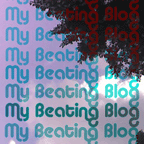
My Beating Blog by Yury Gitman
My Beating Blog is an attempt to take the journaling aspect of blogging into a surrealistic future in which the author literally and metaphorically bares his heart. For three weeks, a series of posts contextualizing heart-rate visualizations, GPS-maps, and personal journal entries will give online users a rare entrance into personal medical-grade statistics, stalker-level location tracking, and the private thoughts of the blogger. Inevitably, issues regarding privacy, exhibitionism, and voyeurism playfully emerge as the blogosphere is infused with biofeedback and location technology. Rather than play into a dystopian or Orwellian future, blogs and biofeedback are given poetic license, reframing our awareness of our own and each others' beating hearts.
My Beating Blog is a 2005 commission of New Radio and Performing Arts, Inc. for its Turbulence web site. It is supported by the Jerome Foundation in celebration of the Jerome Hill Centennial and in recognition of the valuable contributions of artists to society.
Yury Gitman is a designer, inventor, and award-winning artist. He has exhibited at the Biennale of Electronic Arts, Perth, Australia; Isle de France, Paris; Ars Electronics, Austria; and Eyebeam, among others, New York City. Gitman was one of the first people to use the Internet from inside the New York subway. He did this by employing a network of his "Magicbikes" ("wireless bicycle hotspots"). He was awarded the Ars Electronica Golden Nica for Net Vision in 2003. In 2005 he opened Banana Design Lab, a product design company focusing on lifestyle designs to entertain the soul.
Gitman has worked with non-profits such as NYCWireless, the Lower Manhattan Cultural Council, and the Downtown Alliance to promote open Internet policy and New Media Art practice in New York. He teaches an Electronic Toy Design class in the Design Technology MFA program at the Parsons School of Design. He received a Masters degree from New York University's Interactive Telecommunication Program and a Bachelor of Science in Science, Technology, and Culture from the Georgia Institute of Technology. Gitman's work has featured in local, national, and international media including BBC, The New York Times, Newsweek, NPR, New York 1 TV, Tech TV, CNET, ID Magazine, Readymade, Village Voice, Adbusters, and Utne Reader. [Related networked_performance posts 1, 2, 3, 4, 5, 6]
Posted by jo at 01:35 PM | Comments (0)
June 24, 2006
Nathaniel Stern: Creative Commons Artist in Residence
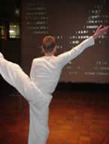
Shares [odys]elicit Under CC/GPL
Friday 23 June 2006, live from the iCommons iSummit:
[odys] elicit - a full-body, interactive art installation circa 2001 - is now available under a Creative Commons By Attribution Non-Commercial Share-Alike license, and the source code is available under GPL. It works with almost any standard webcam (requiring a few drivers on PC)!
[odys]elicit is a large scale, interactive installation where every movement of the viewer, small or sweeping, births stuttering text onscreen. The viewer’s motion elicits, character by character, passages from odys’ text. The piece responds to small movements, writing the text onscreen slowly for the viewer to read, or to rapid passersby, whose full bodies birth hundreds of flying characters, impossible to decode.
In odys’ work, viewers are forced to look at the spaces between language and meaning, the luxuries of stuttering and silence as communication, and the effects of accelerated and decelerated time. [odys]elicit physically places viewers at the center of co-invented noise, forced to perform - willingly or not. odys’ text has been reduced down to where it no longer has meaning and is re-birthed, with possibly infinite meanings, or none at all.
Click here to see videos of the piece in action.
Downloading:
Please first check out the read_me file - the PC application requires some extra (free) installs, and you can very easily change video settings or sources, input new text, toggle between birthing letters or full words, adjust the motion tracking tolerance levels given different lighting, or change the direction the text will go on the fly! Send me error messages if you encounter any bugs, or have much success! I am yet to fully test the OS 9 or PC versions. Oh, and about any parties or exhibitions that this thing is a hit at, too ;)
read_me.rtf
OS X Application
OS 9 Application
PC Application (still testing)
Source Code (in Director/Lingo + TTC-Pro; demo versions of these will work)
@ Rio iSummit [posted by nathaniel on nathanielstern.com]
Posted by jo at 10:38 AM | Comments (0)
June 23, 2006
Smoke Signals

Writing Space and Memory Clouds
June 24, 2006 at 9:28 p.m. (GMT): Smoke Signals--by Minimaforms--is based on one of the oldest forms of communication in recorded history dating back over 5,000 years. The project works as a hybrid system that explores the dynamic and spatial capacities of smoke and light in relation to contemporary mobile SMS technologies of messaging today. Smoke Signals examines a dynamic real-time interaction that writes space. Smoke and light setup the condition for developing a typographic ambient / responsive environment.
Participants are invited to communicate with the project by sending SMS messages to one of two smoke signals located at the event. Remote participants can send messages through our Real-Time Virtual Interface located at memorycloud.com
Minimaforms was founded in 2002 by brothers Stephen and Theodore Spyropoulos as an experimental design practice that explores design that provokes and facilitates new means of communication. Also see www.fasterthansound.com.
Posted by jo at 03:17 PM | Comments (0)
June 13, 2006
BodyDaemon: A Bio-Responsive Internet Server
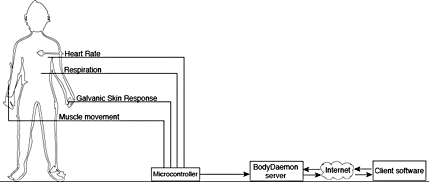
BodyDaemon, by Carlos Castellanos, is a bio-responsive Internet server. Readings taken from a participant's physical states, as measured by custom biofeedback sensors, are used to power and configure a fully-functional Internet server. For example, more or fewer socket connections are made available based on heart rate, changes in galvanic skin response (GSR) can abruptly close sockets, and muscle movements (EMG) can send data to the client. Other feature's such as logging can be turned on or off depending on a combination of factors.
BodyDaemon also includes a client application that makes requests to the BodyDaemon server. The client requests and server responses are sent over a "persistent" or open socket. The client can thus use the data to continuously visualize, sonify or otherwise render the live bio-data. This project is part of larger investigations focusing on the development of protocols for the transfer of live physiological and biological information across the Internet.
BodyDaemon represents the early stages of investigations into the viability of systems that alter their states based off of a person's changing physiological states and intentions - with the ultimate goal of accommodating the development of emergent states of mutual influence between human and machine in a networked ecosystem. [via Switch 22]
Two clients have been developed for BodyDaemon:
1. Combat by John Bruneau
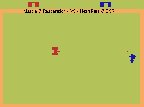
Combat is a game developed by Atari in 1977. It runs on the Atari 2600 home consol system. Two tanks, each controlled by a different player, battle it out in a single screen arena. The pixels are big and mighty and carry with then a good helping of nostalgia.
The task of controlling each tank in Combat is split between two body statistics. One controls steering and the other controls thrust and shooting. All actions are determined by the rise and fall of each stat. For example, if heart rate was in charge of steering then a drop in the user’s heart rate would cause that particular tank to turn right, and I raise in heart rate would cause that tank to turn left. Each round ends after 2 minutes, 16 seconds at which point the next round starts and new teams are formed.
The Combat Client was created with Max/MSP, Jitter, and Javascript. It utilizes two key externals, in order to function. The first of which is the OSC and UDP objects by Matt Wright which allow Max/MSP to communicate with the BodyDaemon server. The other external is jit.atari2600, an Atari 2600 emulator/manipulator object written by Kyle Buza. This external allows me to directly access the original Atari Combat game ROM.
2. Gravitons and Graviolis by Aaron Siegel

Gravitons and Graviolis is specifically designed to translate the signals from the bodydaemon server in a manner creating a simulated orbital system of particles. The signals are transposed in the corresponding manner:
EKG: speed of particles
GSR: range of hue of particles
Respiration: number of particles on the stage
EMG: disable background drawing to allow for "pixel painting"
Preliminary code sketching was done in anticipation of this project in the form of gravitons and graviolies.
For more information on this project visit the following web sites:
ccastellanos.com, wiki.ccastellanos.com
John Bruneau's client
Aaron Siegel's client
BodyDaemon will be exhibited at ZeroOne/ISEA2006 this summer.
Posted by jo at 10:00 AM | Comments (0)
June 12, 2006
We're Not Gonna Take It!

Protest Karaoke-Style
We're Not Gonna Take It, by Amos Latteier, is an interactive public art project that allows you to record your own protest songs using the telephone. You can create a song about issues you wish to protest (such as corporate globalism, your landlord's poor repair record, or bad produce at the supermarket). You record your song by using the telephone like a karaoke machine, singing along to rock music. Your personal protest song will then be delivered to the politicians of your choosing.
From Jonah Brucker-Cohen's Gizmodo interview with Amos Latteier: In the world of creative interventions into popular technology, projects that make us question how we consume and use digital devices are often those that maintain our attention. Using this credo as a starting point, Toronto, Ontario-based artist, Amos Latteier creates work that explores the lighter side of technology. Poking fun at everything from corporate software presentations with his PowerPoint performances to creating homebrew prosthetic limbs with the “Prosthetic Ass”, his work examines the subtleties of DIY culture and the potential “emotional” impact of simple devices.
Re-purposing consumer electronics in inventive ways, his project, “Calculator Haikus”, creates poetry from upside-down calculator displays to emphasize how a playful approach can often yield unexpected results. On the software side, his inquisitive PowerPoint lectures employ the bland presentation software to create absurd relationships between viewer and speaker. Gizmodo caught up with Latteier to discuss his artistic practice, creative philosophy, and aim to infuse mild absurdity into standardized teaching methodologies and mass-produced software and hardware. Interview and photos after the jump… [via Coin Operated]
Posted by jo at 04:59 PM | Comments (0)
June 05, 2006
When Ghosts Will Die
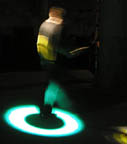
Stories Stitched Together "on the fly"
When Ghosts Will Die, a performance-installation that utilizes multi-sensory elements such as sound, video, light, and text controlled by motion-tracking technology, tells the story about the dangers of nuclear proliferation. Inspired by the play, "Copenhagen", by Michael Frayn, it explores the use of non-linguistic elements in the service of making poetry and telling stories. The artists and programmers involved on the project include Steve Gibson, Dene Grigar, Will Bauer, Jim Andrews, and John Barber.
"When Ghosts Will Die" involves one-two performers and envisions the space as a 3D grid simultaneously within a central computer and a physical performance space. The performers move through this environment and evoke the multi-sensory elements with hand-held tracking devices and in so doing interact with these elements through three potential phases of nuclear proliferation: 1) Disharmony, 2) Destruction, and 3) Disintegration. These three phases are intended to evoke the first nuclear explosion, the "Trinity" test in New Mexico on July 16, 1945, that took place just weeks before the nuclear bombs exploded over Hiroshima and Nagasaki, Japan.
Using the tracking device, the performers can move through the space choosing the element they wish to utilize for telling the story. In this way, the story takes on a rhapsodic quality: it is literally stitched together "on the fly" and changes wtih each telling. The mood of the space is designed to match the phase that the performers reach. Disharmony, for example, offers slightly discordant sounds that increasingly give way to cacophony, as well as video footage representing growing belligerence. Destruction sees the dropping of the bombs and corresponding sounds of buildings falling into rubble. The final phase, Disintegration, takes performers to the motif of the work: that the destruction derived from these weapons will be so complete that even "ghosts will die," an allusion to Michael Frayn's "Copenhagen" that sits at the heart of this project.
The story is meant to shock those participating into a deeper awareness of the horrors of nuclear warfare. Politically speaking, the work's message – that the development and deployment of weapons of mass destruction not only test a country's power but also its humanity – speaks to artists' "responsibility to envision alternative futures... and shape the way people think, live, and interact" (Edward Shanken). [via]
Posted by jo at 12:31 PM | Comments (0)
May 26, 2006
HTTP Gallery
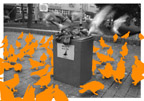
Urban Eyes
HTTP Gallery is pleased to present Urban Eyes, an intermedia project by Marcus Kirsch and Jussi Angesleva. Private View: 1st June 2006 7-9pm; Exhibition: 1st June - 9th July 2006, Friday- Sunday: 12 noon-5 pm; Unit A2, Arena Business Centre, 71 Ashfield Rd, London N4 1NY; tel: + 44 (0)20 8802 2827; info[at]http.uk.net
Urban Eyes uses wireless technology, birdseeds and city pigeons to reconnect urban dwellers with their surroundings. The Urban Eyes feeding-platform stands in one of London's public spaces. By landing on the platform, pigeons tagged with RFID chips send aerial photographs of their locality to surrounding Bluetooth-enabled devices. In this work pigeons become maverick messengers in the information super-highway, fusing feral and digital networks. HTTP Gallery provides an interface to the project, mixing live and documentary footage and offering visitors an opportunity to experiment with Bluetooth.
Being one of the last remaining signs of nature in a metropolis such as London, the urban pigeon population represents a network of ever-changing patterns more complex than anything ever produced by a machine. However pigeons' movements are based on a one-mile radius around their nest. Any pigeon you see everyday shares the same turf as you. Urban Eyes crosses and expands human mobility patterns offering to reconnect you with your neighbourhood.
In the 1960s, situationists Debord and Jorn composed psycho-geographic diagrams of Paris, which described navigational systems based on their drift through the city. For this, they used Blondel la Rougery's Plan de Paris a vol d'oiseau, a bird-eyes map of Paris. Inspired by this methodology, Urban Eyes enlists our feathered neighbours to establish a connection between the bird-eyes view of the city as now distributed by Google Earth and our terrestrial experience. [Related]
About Marcus Kirsch and Jussi Angesleva
Marcus Kirsch holds an MA in Interaction Design from Royal College of Art. He was invited to the 2004 Seoul Biennale and as exhibiting artist and to last year's Rotterdam International Film Festival and DEAF Festival. He was awarded a silver Art Directors Club NY and a fusedspace.com award in collaboration with Jussi for 'Urban Eyes'.
Jussi Angesleva holds MA in Audio Visual Media Culture from the University of Lapland in Finland, and MA in Interaction Design from the Royal College of Art and has shown at the Tokyo Metropolitan Museum of Photography, Siggraph, ZKM and Science Museum London. He has received awards from Royal Society of Arts, NESTA, from D&AD (together with Ross Cooper), Prix Ars Electronica and the Art Directors Club of Europe. He is currently working at ART+COM in Berlin, Germany and is a co-founder of new media agency Prosopon.
For more information and images, please contact Stephanie Delcroix
This project is supported by Arts Council England (London), V2 lab (Rotterdam, Netherlands) and Furtherfield.org.
Posted by jo at 05:36 PM | Comments (0)
Poker Club, Scotland
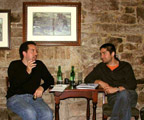
Haque + Bleecker
The Poker Club at the Beehive Inn in Edinburgh featured Usman Haque (artist / architect) and Julian Bleecker (technologist / artist / think tank leader) to discuss the "internet of things" and "open source architecture". Hosted by New Media Scotland.
Both presenters took us through a short run down of their work and then there was a lively exchange between everyone present. Hopefully there will be a podcast from New Media Scotland in the near future.
Haque's presentation was broken into three categories: Invisible Stuff, Collaborative Stuff (produced by non experts - or vernacular creativity) and Social Space. He talked about Architecture as an operating system for the collaborative production of space. He stressed the importance of the necessity of the system (whether an augmented object or space) to have the capacity to build 'its' own perceptual categories. Several examples of previous and current work were shown.
Bleecker started with the question 'Is life hackable?' He characterised the upsurge of activity as a renewed or second order humanism. The term 'change agents' was used and it was pointed out that these are no longer well positioned parties such as New York Times reporters. Several projects were shown which showed how digital networks can shape physical activities in a sort of network practice - social practice continuum. It was stressed that we're not just talking about data transactions.
Some interesting points that came up in the discussion:
:: We are surrounded by invisible information, how do we make this visible or legible?
:: Technology extends the zone of our perception/agency.
::Is the web of objects the end of subjectivity or a new beginning for subjectivity?
:: The role of human beings as filters.
The issues emerging for me are what do we mean by 'understanding' in relation to all the information we have access to and how do we have agency within it? One thing that came up over and over was the spatial or prepositional nature of our relationship to the digital networked public. As Bleeker points out in Why Things Matter are we 'on' or 'in' the network?
[posted by John Marshall on Designed Objects]
Posted by jo at 12:22 PM | Comments (0)
May 25, 2006
Mawhrin-Skel
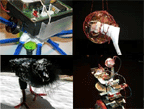
Autonomous Robots
Mawhrin-Skel--by Deanne Achong, Kate Armstrong, Joelle Ciona, David Floren, and Matt Smith, with help from Dina González Mascaró--brings together an eclectic group of local Vancouver artists, who work variously in new media, electronics, sculpture, installation and performance, to create autonmous robots that communicate with one another wirelessly via the internet.
The project--Sheryl [Crowbot] (DA), The Problem of Other Minds (KA), TangleBot (JC), Phono, Mono, and ChartBot (DF), RadBot (MS)--is based on a fictional character--"Mawhrin-Skel"--an intelligent drone that, having failed to meet the conditions of its original purpose, is decommissioned and left to wander aimlessly through a near utopian environment where it becomes a social nuisance and prankster. This character - invented by Ian M Banks in his 1989 novel "The Player of Games" - provides an interesting social and cultural entry point into the study of robots as both cultural artifacts and autonomous members of society.
Robots typically have industrial applications - wireless mines that can dig their way out of the earth and move to a "better" location, machines that cleanup radioactive waste or other hazardous material, surveillance equipment, toasters, coffee makers, etc. It is unusual to build a robot that doesn't have an overt industrial purpose - it may be decorative, dysfunctional, nailed to a tree and bleeping. It exists purely to raise questions about industrial and technological philosophies and ethics in our society. This project examines ideas of function, autonomy, artificial intelligence and purpose-driven technology.
These objects are intended to sit on window sills, desk corners, over doorways, nailed to a post on the back deck, in the gravel pit in the basement, etc. The wireless Internet connection allows the devices to talk to each other and mingle their conversations on the web. The "eyes" of one machine can influence the actions of another. Keywords can generate furious activity or silence. Following the series of workshops, the results of the artists' experiments with robots will be exhibited to the public through a number of events in May 2006 and January 2007.
The Mawhrin-Skel robots communicate with each other using the Scrambler - a message server that was developed in 2003 to connect electronic installation works around the world.
Posted by jo at 10:44 AM | Comments (0)
May 23, 2006
Paul DeMarinis

The Messenger Delivers a Golden Nica
The Messenger (1998) by Paul DeMarinis has been awarded the Golden Nica for Interactive Art by Prix Ars Electronica 2006. In The Messenger, email messages received over the internet are displayed letter by letter on three alphabetic telegraph receivers: a large array of 26 talking washbasins, each intoning a letter of the alphabet in Spanish; a chorus line of 26 dancing skeletons and a series of 26 electrolytic jars with metal electrodes in the form of the letters A to Z that oscillate and bubble when electricity is passed through them. Movie.
"The Messenger is an internet-driven installation based on early proposals for the electrical telegraph, in particular those made by the Catalan scientist Francisco Salvá. As in many of my works I examine the metaphors encoded within technology, especially lost or orphaned technologies and try to trace their origins, speculating on the way that mechanisms are the repositories of larger unspoken conceptions and dreams. In The Messenger I take the telegraph as a point of departure from which to examine the relationship between electricity and democracy, and how electrical telecommunication technologies have participated in our solidarity and in our isolation, in our equality and our oppression, in the richness of our experience and the uncertainty of our lives." -- Paul DeMarinis
Paul DeMarinis has been working as an electronic media artist since 1971 and has created numerous performance works, sound and computer installations and interactive electronic inventions. He has performed internationally, at The Kitchen, Festival d'Automne a Paris, Het Apollohuis in Holland and at Ars Electronica in Linz and created music for Merce Cunningham Dance Co. His interactive audio artworks have been shown at the I.C.C. in Tokyo, Bravin Post Lee Gallery in New York and The Museum of Modern Art in San Francisco. He has been an Artist-in-Residence at The Exploratorium and at Xerox PARC and has received major awards and fellowships in both Visual Arts and Music from The National Endowment for the Arts, N.Y.F.A., N.Y.S.C.A., the John Simon Guggenheim Foundation, the Rockefeller Foundation New Media Award and the D.A.A.D. Berlin Artist Fellowship.
Much of his work involves speech processed and synthesized by computers, available on the Lovely Music Ltd. compact disc "Music as a Second Language", and the Apollohuis CD "A Listener's Companion" Major installation works include "The Edison Effect" that uses optics and computers to make new sounds by scanning ancient phonograph records with lasers, "Gray Matter" that uses the interaction of body and electricity to make music, and "The Messenger" and "Firebirds" that examine the myths of electrical communication. Public artworks include large scale interactive installations at Park Tower Hall in Tokyo, at the 1996 Olympics in Atlanta and Expo 1998 in Lisbon and an interactive audio environment at the Ft. Lauderdale International Airport in 2003.
Posted by jo at 01:36 PM | Comments (0)
May 19, 2006
SOLAR RADIO STATION

Sounds of the Universe
SOLAR RADIO STATION, a project by RIXC, Center for New Media Culture, Riga (LV) and r a d i o q u a l i a (NZ / AUS / GB / NL); PHOENIX Halle Dortmund; May 20 - July 16, 2006; Opening: Friday, May 20, 2006, 18:00.
In this (live) installation one can listen to the sounds of the universe originating from various sources. They have been collected by the artists' group r a d i o q u a l i a (Honor Harger, Adam Hyde) in cooperation with RIXC, Center for New Media Culture, Riga. The recordings are coming from various radio telescopes. Additionally, during two days, there will be live feeds from the VIRAC radio astronomy telescope in Irbene (Latvia) which will be acoustically re-worked and interpreted live by the experimental musicians Clausthome (Latvia). VIRAC is the largest radio telescope worldwide (with a dish diameter of 32 meters) accessible for civilian use - thanks to RIXC's continued efforts. During the cold war the KGB used the radio telescope for tapping into NATO's and other military networks.
The installation “Solar Radio Station" consists of three parts. r a d i o q u a l i a's computer and sound installation “solar listening_station" is the first part. It contains recordings and live streams of radio waves from space, especially from the sun. The second part “Spectrosphere" also contains signals originating from the VIRAC radio telescope, this time modulated via electronic instruments and interpreted visually. Here, Clausthome and VJ Ratniks present the results of their live performance from May 20 + 21 at PHOENIX Halle until July 16, 2006. The third part consists of a comprehensive video documentation of the VIRAC telescope by RIXC. Additionally, on a large scale poster the existing frequency spectrum is visualized and its current use is explained.
LIVE INSTALLATION: Sat + Sun, May 20 + 21, 2006, 19:00 - 21:00; The Riga based group Clausthome and VJ Martins Ratniks (F5/RIXC) will perform live in the Solar Radio Station. The live audio stream from the VIRAC radio telescope in Irbene, carrying data from the sun and from space, will be electronically enhanced by Clausthome and interpreted visually by VJ Martins Ratniks.
LINKS
www.museumamostwall.dortmund.de
www.hmkv.de
www.rixc.lv
www.radio-astronomy.net
www.virac.lv
A project by RIXC, Center for New Media Culture, Riga (LV) and r a d i o q u a l i a (NZ / AUS / GB / NL).
RIXC (LV) - Raitis Smits, Rasa Smite, Martins Ratniks, Davis Bojars r a d i o q u a l i a (NZ/AUS/NL/GB) - Adam Hyde, Honor Harger Clausthome (LV) - Lauris Vorslavs, Girts Radzins
In the framework of the exhibition "mit allem rechnen. Medienkunst aus Estland, Lettland und Litauen / face the unexpected. Media art from Estonia, Latvia and Lithuania" - a cooperation between Hartware MedienKunstVerein and Museum am Ostwall, Dortmund/Germany.
SUPPORTED BY: Kulturbuero Stadt Dortmund, 38. internationale kulturtage der stadt dortmund / scene: estland lettland litauen in nrw, Kunststiftung NRW, Der Ministerpraesident des Landes Nordrhein-Westfalen, Kultusministerium der Republik Estland, Kultusministerium der Republik Lettland, Kultusministerium der Republik Litauen, Botschaft der Republik Litauen in der Bundesrepublik Deutschland, Lietuvos Institutas, dortmund-project, LEG, PHOENIX, Medion, Coolibri (Medienpartner).
VENUE: Hartware MedienKunstVerein at PHOENIX Halle Dortmund, Rombergstr. / Ecke Hochofenstr. (no postal address!) Dortmund-Hoerde, Germany.
ADMISSION: PHOENIX Halle: 4 Euro, reduced 2 Euro (incl. admission to the exhibition "Glamour and Globalization") Kombiticket Museum am Ostwall and PHOENIX Halle: 6 Euro, reduced 3 Euro (incl. admission to the exhibition "Glamour and Globalization")
HOW TO GET THERE http://www.hmkv.de/dyn/e_contact_roaddescription/
CONTACT
Hartware MedienKunstVerein
Guentherstraße 65
D - 44143 Dortmund
Germany
Tel: ++49 - 231 - 823 106
www.hmkv.de
Posted by jo at 10:51 AM | Comments (0)
May 18, 2006
PIPS:lab
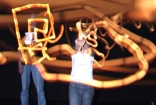
Luma2solator
PIPS:lab, Luma2solator, Interactive Performance; Sunday, 21 May, 10 a.m. - 6 p.m., Edith-Ruß-Haus für Medienkunst -- PiPS:lab is a collective of young Dutch artists specialised in different disciplines. With the computer as a mixer and music, theatre, film, text, photography and a significant dose of humour as ingredients, a PiPS:lab production never fits the expectations. From absurd media theatre to interactive installations, PiPS:lab produces every single element itself: the software, a great deal of the hardware, the music, the stories, the performance and visuals.
Create a piece or place your tag, write or paint with light. The Luma2solator has its own visual language. The technique designed by PiPS:lab enables every user to become the artist. The light tracks will directly become visible on the large screen. After 30 seconds the result gets stored and if the installation is connected to the Internet will be published under a unique number as well. This enables the artist to look up his or her works at home as well.
Posted by jo at 12:52 PM | Comments (0)
Régine Debatty's Interview with Marc Bohlen

"Machines are their own species"
Marc Bohlen's website has provided me with some amazing stories ever since i started blogging: from the Open Biometrics Project that i posted back in 2004, to the Universal Whistling Machine, first prize at Vida 7.0, and the cursing Amy and Klara.
Marc is trained in Stone Masonry (sic), Art History and Electrical Engineering and Robotics. He has been an invited speaker at Cornell University, Harvard University, The Ludwig-Maximilians-Universität München, the Banff New Media Institute and the Royal Institute of Technology in Stockholm, etc. Marc is currently directing the MediaRobotics Lab at the University of Buffalo (Department of Media Study).
Shoeveillance sounds like "souveillance." Is there a hint of activism behind the project?
Certainly! My approach overlaps to a strong degree with that of art-activisism. It is also different. If you leave the development of technology to market forces alone, the solutions leave out too many market-irrelevant, but important, interesting and pleasurable factors. Realtechsupport tries to cast engineering problems in a light that includes their social/cultural context, and tries to make this a design parameter that needs to be 'solved'(addressed, discussed, solved) with the same diligence as the isolated technical problem.
Shoeveillence is a good example of this approach. Shoeveillence is capable of monitoring the passage of people in to and out of a room (and by extension a building). It acknowledges the fact that, in this world, this might be necessary [There is a fire in a 100 story building – is there anyone on the 91^st floor?]. At the same time, it counters data-creep and prevents data that is not "needed" from being collected. [The camera sees only feet and legs up to knee height; the machine algorithm finds directionality of motion and objects that look like shoes only].
In this regard shoeveillence is related to previous work in biometrics. The Open Biometrics Project included the design of a fingerprint analysis system that made its probabilistic results apparent so one could watch the machine in action. Having complex machines make binary decisions about us is really a problem.
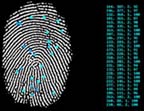
A friend of mine told me about an interaction designer who had devised a way for people living in a not very posh neighborhood of London to pass through the streets of their area and yet avoid the gaze of the CCTV network. But it turned out that people were not happy with the idea, they actually liked to be on surveillance camera. Do you think a system like Shoeveillance could make everyone happy: maximum data collection and minimum invasion?
Yes. Let's make everyone happy! Shoeveillence plays with the desire to be seen to some degree. Parading your shoes is a special kind of pleasure, an accepted form of exhibitionism. It is one I would like machines we share the world with to be fluent in. We will have to wait for compliments, though, the appreciation of good shoes is beyond AI today. In HCI (Human Computer Interaction) community, some people speak of 'shy sensors', sensors with low-bandwidth input (such as a button) from which you derive information based on the sensor's location. If you want to know if someone is sitting in a chair without watching them on a camera, for example, you put a button in the chair. Shoeveillence, however, takes in high-bandwidth data (streaming video). It is tamed physically (by its position on the ground and its lens system), disciplined programmatically (by its algorithm) not to notice anything but shoes and incapable of being invasive but geared to be persistently and maximally shoe centric. This is a new kind of problem solving, I think.
Shoeveillance has found a first application in 8-bit Architecture. Can you tell us something about that project? how does shoeveillance fit in 8-bit A?
8-bit Architecture is a concept for a new joint between lived spaces and synthetic systems in the widest sense. To date, our new technologies are add-ons to the buildings in which we live and they enforce a master-slave relationship. The "smart home" got it all wrong. We don't need more convenience in our lives.
8-bit A wants to find out if there can be new ways of bringing the separate entities of synthetic and controlling systems together with lived spaces. Think about Cory Arcangel's Mario Brother game hack where he removed from the game engine everything but the scrolling clouds to create a 'game' the technical staff never imagined. 8-bit Architecture will try to find solutions like that (but different) for built and lived systems. Home automation has got to deliver more than garage-door openers that can be activated from the armchair and lights that dim on command.

I like one of your older project: Advanced Perception. Are you still investigating the field of "animal machine interaction design"?
Yes! That project really set the path for my work. The Universal Whistling Machine project continues the thrust with the question of communication beyond species boundaries. And the Glass Bottom Boat will move from land to sea creatures. I think we should replace HCI (Human Computer Interaction) with HAMI (Human Animal Machine Interaction). Animal activism meets robotics. The new world must have space for all of us.
How affected were the chicken by the presence of the robot?
At first indifferent. Once the robot moved, they were very frightened. But having the robot 'announce' its motion prior to actually moving (by activating the motors for a fraction of a second as to make a noise) made the chickens accept the machine much more readily. The robot was then instructed to avoid the feeding corner, so the chickens had their reserved territory. That seemed to help as well.
The results of these robot-chicken experiments were presented to both the scientific as well as the art communities. did they react in a different manner?
I had a famous chef (Rudi Stanish) cook omelets from the eggs of the chickens. In the gallery we had a taste-the-interaction session. People enjoyed the omelets and, hopefully, thought about a future world where animals, humans and robots roam freely.
I presented parts of the work in two scientific venues. There the interest was on "robots in adverse environments" (you can't sell omelets to the scientists). They were keen in hearing about how to deal with the messy side of things (dirt, chicken droppings, reliability over time, control mechanisms). But, in the end, the discussion also went to the 'high end' topics of shared spaces for different species. But the technical diversion was necessary to get to that point.

You seem to mingle with the artisitc as well as with the scientific communities. What's your crowd? How open is the scientific community to art projects?
(left: Advanced Perception gourmet performance) My crowd: Mixed. I think people who are trying to (experimentally) find ways of living with the fallout from automation technologies respond to my work. I am not a visual artist. The science community is selectively appreciative of the work. I do solve problems and deal with the same kind of messy and complicated information processing issues the engineering sciences do. The criticism I get from the sciences is that I am weak on evaluating my "results". But I am really not into handing out questionnaires and doing factorial designs experiments. I understand the critique, and understand where it comes from, but limit myself in accepting it in order not to loose the thrust of the work.
On the other hand, one does have to really understand the questions the sciences are concerned about. You can not speak the dialect of art (and expect to be understood) when you play the science game. Else you are delegated to a beautifier (and your voice is not taken seriously beyond that task). This was an important insight into really getting discussions going across disciplines: you have to be in the disciplines. This is a huge problem with much of the current "art meets science" endeavors. It really takes more than talk to move between different domains of knowing.

(Left) Amy and Klara and The Universal Whistling Machine) Other recent projects on your website deal with the replication of human features in artificial systems as well. Do you feel that the quest for the machine that will look and sound exactly like we do is senseless?
Yes, the quest for the synthetic system that looks, feels, acts and sounds like us is a dead end, in my view. Synthetic systems designers (from literature, cybernetics, robotics, and AI) have always been attracted to the mimesis of human features. Mostly because humans see humans as the pinnacle of evolution. If you are going to make synthetic life, why not work off the 'best' example you can find, the human, so the argument goes. But there is a different argument I am more attracted to. What the machine affords (in the sense of what is is capable/incapable of) is fundamentally different from how we are.
Machines are their own species, they are aliens, in a way. Sensors can see and hear things outside of our human perceptual boundaries. We have no access to microseconds as a computer does. Entities that can access this kind of 'stuff' are different, in a similar way as a dog that can hear sounds I can not hear, is different from me because of that.
Thanks Marc!
More on the projects discussed here at Realtechsupport. [blogged by Regine on we-make-money-not-art]
Posted by jo at 10:11 AM | Comments (0)
May 17, 2006
Circuit #2 @ Eyebeam
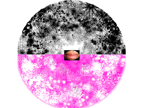
polymorphic [d(eoxyribo)n(ucleic) a(cid)]: a love story
polymorphic [d(eoxyribo)n(ucleic) a(cid)]: a love story--by Marta Lwin--is a networked performance installation of a DNA driven conversation between two people in love. Featuring actual personal DNA sequences mapped to generative language revealing the inner secrets of genetic compatibility. At Circuit #2, Eyebeam; Friday and Saturday, May 19-20 from 12-6pm. The artists will give public presentations and/or performances on May 20 at 4:00pm, followed by a reception at 5:30pm. These events are free and open to the public.
The DNA sequenced are derived from an collaboration between Lwin and scientists at NYU Medical Center, Study of Human Genomics, and the American Museum of Natural History, Center for Comparative Genomics. The are visualized by using two video monitors (with audio), and computers running custom software written in Java. A synergistic interaction exists between the DNA sequence and the custom software to trigger video. The video depicts lips speaking the DNA sequence a mapped to the Roman alphabet. The disembodied lips take turns speaking the code to one another, at times interrupting at other times remaining silent.
The DNA, while invisible is encased in visible plates which are laser etched with contemporary scientific iconography, creating a decorative surface polymorphic [d(eoxyribo)n(ucleic) a(cid)]: a love story looks at the contemporary methodology for encoding DNA, and it's application and ethical ambiguities. The web based documented process of creating the installation comprises the theoretical investigation of turning material DNA into binary information, with special attention to lab process.
Lwin is looking at the current scientific lab practice of extracting DNA, and treatment of human materiality as it moves into binary representation. With special attention to Norbert Wiener's cybernetic theory, Lily Kay's analysis of the inherent informatic bias in DNA science, and theoretical writings by Marx, Deleuze + Guattari, and contemporary thinkers such as Thacker, Massumi, and Agamben.
Posted by jo at 09:16 AM | Comments (0)
May 16, 2006
Interactive Telecommunications Program
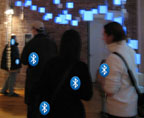
Spring Show 2006
Each ITP (Interactive Telecommunications Program) expo seems bigger, crazier, and more well-produced than the next. Last week's show was no exception with projects like the De-Painter, a machine that uses viewers' movements to generate paintings, and a Bluetooth person-tracking system called BlueWay... Robert Seward's trippy Consciousness Field Resonator ... takes the concept behind Princeton's Global Consciousness Project and integrates it into a personal device designed to resonate with users by alluding to uncanny correlations. If you really want to geek out, Seward's website has instructions for how to create your own True Random Number Generator. Other pieces were much more literal translations of much less metaphysical subjects, like Dimensional Cursive which transforms script into three dimensions and reminds of Fred Eerdekens' work. Look out for more, including a piece incorporating the algorithms of sunlight reflecting off of water and a zipper orchestra, in a Cool Hunting Video later this week.
Also on Cool Hunting: ITP Winter Show Videos, ITP Spring Show Review, Cellphedia. [blogged by ami kealoha on Cool Hunting]
Posted by jo at 01:01 PM | Comments (0)
May 03, 2006
Schwelle I: Bardo
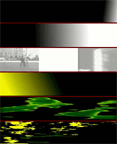
HDV Tryptic for Three Large Screens and Eight Channel Audio
At Elektra7, Thursday, May 11, 2006, 9:00 PM; Usine C, Montreal, Canada.
Schwelle I: Bardo--by Chris Salter--is a turbulent exploration of the experience undergone at the time of the dissolution of the body and consciousness. It is part I of a larger three part performance project currently under development that uses new sensing, electronic, material and computational technologies to tangibly explore the extreme physical and emotional states that might take place in the thresholds before and after death.
Part 1, Bardo, is an extended audio/visual composition/performance lasting approximately forty-five minutes. Partially shot in High Definition video, the work consists of three overlapped and synchronized 720 x 480 projections that form a 2160 x 480 widescreen resolution image with 8 channels of digital surround sound. Over the duration of forty minutes, the spectators undergo a powerful journey through a transforming landscape of abstract, Rothko-like image and dense, tsunami-like walls of sound that builds toward peak intensity, transporting the viewer through the threshold stages of dying and dissolution.
Posted by jo at 11:20 AM | Comments (0)
April 25, 2006
Blind Ditch
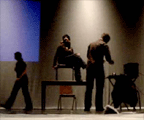
WHO WANTS TO BE A HERO NOW?
Blind Ditch invite you to state your opinions and ask some questions in our performance installation WHO WANTS TO BE A HERO NOW? showing as part of the Exeter Text Festival, UK, April 24th-14th May 2006.
Send us a mobile phone short or digital camera mpeg to +44 (0)7890 801203 or contact[at]blindditch.org and it will be downloaded onto our website. Your work will be continually screening online from April 24th and shown in the Exeter Phoenix Gallery as part of the tEXt Festival. Tell us what action should we make to change the world for the better. Please pass this on to anyone across the world you would like to participate, translate and disseminate. Respond in your mother tongue or English Please note that the word hero is being used to speak about both men and women.
Please be aware that by participating in this project you are agreeing for Blind Ditch to use your image and words in our work. Your statements will be curated with live performance work and available online and in the gallery throughout the duration of this project.
Posted by jo at 08:43 AM | Comments (0)
April 20, 2006
Petko Dourmana
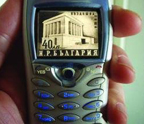
BT_GRAFFITI | Mausoleum_3
The interactive work--by Petko Dourmana--proposes to virtually rebuild the lost physical space of the Mausoleum of Georgi Dimitrov, that used to be the most remarkable public symbol during the Communistic period in Bulgaria, inside the visual and physical space of the entrance at 15 Nassau, New York.
Using Bluetooth technology, visitors are automatically invited to activate it and will receive a series of visual and audio fragments which recreate the space of the former Mausoleum. This newly common-used technology is highly open for communication and in this sense it can be likened to graffiti.
As graffiti in public space confronts passers-by with intentional messages, this work addresses notions of presentation space vs. private space and representations of time and space visually and virtually. [blogged by Emily on Textually]
BT_graffiti project is sponsored by CEC ArtsLink. Produced by InterSpace in association with the Harvestworks Benders and Coders concert series and the 2006 Bent Festival. Presented at 15 Nassau Street in New York City, a venue of the Lower Manhattan Cultural Council. Space donated by Silverstein properties.
Posted by jo at 08:00 AM | Comments (0)
April 19, 2006
4'04"
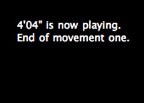
Sound NOT Found
4'04" is a tribute, made by Jon Meyer, to the famous piano musical piece 4'33" written in 1952 by John Cage in three movements. It was like a sonata of four minutes and thirty-three seconds during which no sound is produced intentionally. In this case the author shows us a blank and silent web page for a time range that is shorter than the Cage one. This time length, seen as a pure figure, assumes a very symbolic meaning in the Meyer concept, that relates to the web. In fact it is a simple and elegant joke: 404 is the code of the 'page not found' error, so in a way a 'silent' page. In either case there's a stronger aim than the mere representation of silence.
Cage once went through a new experience, entering an anechoic chamber. There he heard his heart pulsing and his blood flowing, proving that the strict silence doesn't exist. Consequently he turned the traditional concert in a happening when the sounds produced by the bystanders and by the surrounding environment become essential musical elements altogether unpredictable. It's the same aim pursued by Meyer, but, for practical reasons, he's not playing with a collective experience and its consequent emotional impact. He's, instead, referring to a listening invitation and to the daily meditative Zen practice (that was practiced by Cage also), contrasting it beside the non-human rhythms of internet working life. As Cage said: "(...) Art doesn't have to be different from life, but an action inside life. As everything in life, with its accidents and possibilities, and diversity and mess and only momentary beauty (...)". Francesca Colasante, NEURAL.
Posted by jo at 10:46 AM | Comments (0)
April 09, 2006
open, participatory platforms for audiovisual production

multi channel internet tv
mcult was established in 2000 to support production, research and development of new media culture by an active involvement in the practices, policies and structures of the field. Aiming at a sustainable development of media culture, m-cult works to create productive and critical, interdisciplinary encounters between actors in culture, technology and society.
m-cult focuses on social and cultural innovations in urban, wireless and participatory media, and on developing open infrastructures and transdisciplinary competences in new media culture. m-cult carries out research projects, consults on media culture and technology development, disseminates information and organises events in media research, arts and technology.
m-cult's project to establish a lab for urban media now has a concrete target. The plan is to launch a collaborative production environment at Kansatalo ('People's house', named after an extinct insurance company) located in Kurvi, Eastern Helsinki. The Kurvi space is aimed to support production of urban and media culture and to house a continuous series of workshops, seminars and debates. Negotiations about the project are now in their final phase, and results are expected in May 2006.
Posted by michelle at 02:25 AM | Comments (0)
Sankari Show
live talk karaoke

Sankari is an improv show offering people a fun way to perform in front of an audience. It is a combination of karaoke, drama and video game. It's a participatory interactive video show about Elias. Elias is quite a nice guy, but he is not able to speak. So he is a little bit helpless on his own. Actually, Elias is speaking, but we have taken away his voice. That is the genius of the show. People from the audience have to give Elias their own voice. What they say defines his future.
“Sankari” is the Finnish word for a hero. It also means the main character in a story. The format is based on interactive scenes where the participant improvises with virtual characters. The scenes consist of small video fragments. We listen to the improvisation and choose how other characters react by showing different video clips. The story can develop in many directions depending on the performance. A step-by-step guide.
Posted by michelle at 01:25 AM | Comments (0)
ambienttv.net
transmedia practice
ambienttv.net is a crucible for independent, interdisciplinary practice ranging from installation and performance, through documentary, dance, and gastronomy, to sound and video composition and real-time manipulation. We continue to develop social and technical infrastructure and promote network architectures that facilitate alternatives to current socio-political and economic formations. Techniques and effects of live data broadcasting and transmission provide theme, medium, and performative space for many of the works.
ambient.tv describe networked performances as linking geographically distant real spaces with networking technologies such as live streaming. Themes and narratives grow out of telematic feedback, and the interplay between real spaces and imaginary realms. ambientTV.NET's networked performances span the range from dance-theatre to poetry-gastronomy.
 AV DINNERS 1: EPIC EROSM is a live and online audio-visual gastronomic event. The first in a series of sensory networked cook-ins featuring collaborations between digital and performance artists and chefs.
AV DINNERS 1: EPIC EROSM is a live and online audio-visual gastronomic event. The first in a series of sensory networked cook-ins featuring collaborations between digital and performance artists and chefs.
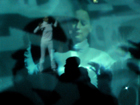 TELEJAM: MYRIORAMA is a telematic dance performance using GPS and sensor systems in collaboration with kondition pluriel. Texts written by roaming performers are tagged with location data and projected into a surround-audiovisual environment.
TELEJAM: MYRIORAMA is a telematic dance performance using GPS and sensor systems in collaboration with kondition pluriel. Texts written by roaming performers are tagged with location data and projected into a surround-audiovisual environment.
 tryptichon is a dance / sound / video performance within a live locative media environment.See video
tryptichon is a dance / sound / video performance within a live locative media environment.See video
CCTV filmmaking as performance or THE FILMMAKER AS SYMBIONT is a manifesto for the opportunistic infections of the surveillance apparatus.
Arist Manu writes on wearable computing, artistic possibilities in a broadband environment and other issues of networked existence.
Posted by michelle at 12:20 AM | Comments (0)
March 18, 2006
Turbulence Commission: "Ten-sided" by Francis Hwang, et al
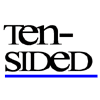
A Multi-Vocal, Improvisational Performance
Ten-sided--by Francis Hwang, with Johannes Gorannson, Jess Kilby, Tao Lin, Brendon Lloyd, Jessica Penrose, Glenis Stott, John Woods, Taren McCallan-Moore, and why the lucky stiff--is a textual performance in which ten authors collaboratively improvise on a single online narrative. For three months, each author will blog as a fictional character. All ten characters must somehow be connected, and all ten authors are responsible for ensuring that this connection is explored through the course of the story. However, authors are forbidden from coordinating the story beforehand. Instead, they can only take their cues from one another's public entries. The resulting improvisation resembles a jazz performance or a session of exquisite corpse, but in a new form of creative practice that comments on and employs the multi-vocal nature of blogging communities.
"Ten-sided" is a 2006 commission of New Radio and Performing Arts, Inc. (aka Ether-Ore) for its Turbulence web site. It was made possible with funding from The Greenwall Foundation.
BIOGRAPHIES
Francis Hwang is an artist, writer, and software engineer. His earlier artwork includes "The Unauthorized iPod U2 vs. Negativland Special Edition", in which he combined a U2 iPod Special Edition with Negativland's back catalog and auctioned the result online; and "firmament.to", which uses the Google Web API to turn any HTML page into a free-associated index for the rest of the web. His writing on technology and culture has appeared in Spin, Wired, ArtByte, and FEED Magazine. An active member of the Ruby community, he has spoken at the International Ruby Conference and currently serves as a technical lead on free software projects such as Ruby-DBI and the object-relational mapping library Lafcadio. He lives in Brooklyn with one roommate, two computers, and two cats.
Johannes Görannson was born and raised in southern Sweden. Together with his wife Joyelle McSweeney, he co-edits Action Books, a press for contemporary American poetry and poetry in translation. Together with Joyelle and John Woods, he co-edits the online quarterly Action,Yes. Action Books published his book of translations, Remainland: Selected Poems of Aase Berg last fall. Ugly Duckling Presse is publishing his translation of 1920s Russian-Finnish avant-gardist Henry Parland's Idealrealization next winter. He edited recent issues of the journals Fourteen Hills and Typo (online) devoted to Swedish-language poetry. He is a PhD candidate at the University of Georgia, but he currently lives in Tuscaloosa, AL, and teaches a class on the historical avant-garde at the University of Alabama.
Jess Kilby is a figment of your imagination. Last seen at the scene of the crime, she left no fingerprints and took your time. In her waking hours she impersonates an Eskimo and tries her best to stay out of trouble. Fails miserably. High crimes and misdemeanors documented here.
Tao Lin is the author of a collection of poetry, You are a little bit happier than I am (Action Books, October 2006), and a collection of stories, Bed (Melville House, Spring 2007).
Brendon Lloyd is a writer from Los Angeles, CA. When he's not writing about himself in the third person to give the appearance that someone else has taken the time to write about him, he hustles a TV pilot and a screenplay.
Jessica Penrose is a poet and short story writer. A former lawyer, she escaped just in time and now lives on the edge of the beautiful Yorkshire Dales in the north of England where she shares her house with a dog, a philosopher and lots of books. Jessica is in the final year of an MA in Writing at Sheffield Hallam University tutored by Sean O'Brien. Her poems have been published widely in anthologies and magazines including The Rialto, Staple and Orbis and her work has been featured in the Ilkley Literature Festival and Sheffield's Off the Shelf literary festival. She is drawn towards cross-art from collaborative projects, and recently worked with a visual artist and a dancer/choreographer to produce a short film of embedded poetry Outside-In Inside-Out. Future projects include a collaboration with a mosaic artist and interactive work with a fellow poet on the theme of dreams.
Glenis Stott lives in England with her husband and two black cats. She is in the final year of a part-time, online MA in Creative Writing. Glenis has never blogged before but has some experience in online collaborative writing, including taking part in Quickshift, a project where an international group of writers, working in shifts, wrote continuously online for 31 hours. Glenis has recently chosen to take a year long break from working in order to focus on her writing full time. Her hope is that she will find a market for her writing and be able to describe herself as a writer for the rest of her working life. However, while publication is her main goal, she also hopes she will continue to gain as much pleasure from writing as she does now. Glenis has recently completed a novel, And Some Caught on Stones, as part of her course requirement. It covers four months in the life of a woman whose 17 year old daughter died unexpectedly. It isn't her own story but is based on her experience of losing a daughter. She also has an almost-complete novel, Brother 'Lijah Built the Ark, which looks at life in a religious cult. Glenis has recently developed an interest in genealogy and feels that several of the characters in her family tree are ripe for development into novels. Glenis is very pleased to have been chosen to take part in Ten-sided and is looking forward to developing a character in real time.
John Dermot Woods lives in Tokyo, where he teaches in the English and Intellectual Heritage departments at Temple University Japan. He is an editor of the international arts quarterly Action,_Yes. His fiction and comics have been published in the Indiana_Review, 3rd_Bed, Salt_Hill and other journals.
Taren Phillip Churchill McCallan-Moore lives in Cambridge with his two dead cats and a cellar packed with stuff that he doesn't want but can't get rid of. He shares a studio with himself in which he draws, paints and entertains. He is soon to appear nude in an exhibition of photography presented by a friend in London who has asked him to write a short and irreverent tale about taking photographs of people without any clothes. He doesn't wake up screaming anymore, he goes for a bike ride across meadow land each night, always wipes the toilet seat and wishes that he'd been closer to his father.
Posted by jo at 12:48 PM | Comments (0)
March 17, 2006
Bureau of Workplace Interruptions

A Time-Stealing Agency
We harness interruptive technology to expose the secret possibilities of the workday. As a time-stealing agency, the Bureau of Workplace Interruptions works directly with employees to invisibly insert intimate exchange into the flow of the workday. Our promise is to create interruptions that challenge the needs of our users and the social and economic conditions of the modern workplace.
You know how receiving flowers at work can put a buzz on the rest of the day? So do we. That's why we create surprise, the kind that slices through the banal and opens up new places for your mind to wander. The ruptures we create are temporary spaces for open dialogue, invisible resistance, and general amusement. In short, we hope to invigorate some of the time you spend at work in order to create new experiences and possibilities outside the flow of capital.
Posted by jo at 09:51 AM | Comments (0)
March 15, 2006
THE EUROPEAN GREEN CARD LOTTERY PROJECT

Watch Your Dreams Come True
We all have dreams, but are we really living up to them? You can change your life and be responsible for your and your family's future. The European Green Card Lottery (EUGCL) has fulfilled many dreams. People today are living their European dream only because they took 5 minutes of their time to register for the official EU Green Card Lottery in the EUGCL web site. Make a difference in your life. Click here and watch how dreams come true. If you register now you have great chances to be one of this year winners. Registration is easy through our website. Join the EUGCL winning team! Here are 9 facts about the EU Green Card Lottery Program
1. 50,000 people and their families will become Europeans.
2. Winners can live and work in the EU.
3. Official Société Réaliste program.
4. One person out of 70 wins the Green Card (statistically).
5. Easy online registration and assistance.
6. Double chances for married people.
7. In 2005, 3.2 million people failed to complete the application correctly.
8. Registration is done online only.
9. You are almost there...
Think of EUGCL as your express line on your way to the EU.
Click here to complete your registration: http://www.green-card-lottery-eu.org
Apply now!
Kind regards,
EUGCL--The world leading European green card lottery application submission service provider. Your chance to Live and Work in the EU.
EUROPEAN GREEN CARD LOTTERY PROJECT
Official Société Réaliste program http://www.green-card-lottery-eu.org
info[at]green-card-lottery-eu.org
Posted by jo at 02:53 PM | Comments (0)
Turbulence Commission: Peripheral n°2: KEYBOARD by Marika Dermineur

Net Surfers and Material Devices
Peripheral n°2: KEYBOARD reflects anew on the keyboard, this strange object which we have beneath our eyes without really seeing it. It explores writing and language and the articulation of the voice and hands; and examines their importance for data processing and media classification (images, texts, sounds). "KEYBOARD" is about automation, keyboards as primitive interfaces, a tool that makes it possible for us to write, capture, note, structure, communicate, index, research, etc.; and to navigate into virtual spaces, in computer games for example, where the four arrows are used to move and other keys are assigned to specific actions. It is one of a series of works exploring material devices that are connected to the computer of the Net-surfer. [Requires Flash Player 7, Speakers, and Fast Connection. Presented in English and French]
"Peripheral n°2: KEYBOARD" is a 2005 commission of New Radio and Performing Arts, Inc. (aka Ether-Ore) for its Turbulence web site. It was made possible with funding from the Andy Warhol Foundation for the Visual Arts. "Peripheral n°2: KEYBOARD" was made during a residency at La Chambre Blanche, Montreal, Canada.
BIOGRAPHY
Net artist, Marika Dermineur focuses on questions/issues/subjects related to the network, the ability (for instance) of a program to produce languages, images or sounds and to effect us. Graduated from la Sorbonne, the Arts Décoratifs and the Arts et Métiers (Paris), she is a member of the experimental web platform Incident.net; a teacher at the University of Rennes 2. She has conducted workshops and lectures about newmedia. Her installations and net art works, such as Keyboard, Googlehouse, The Inhabitants (Impakt production), There! (V2 residence) have been presented in numerous exhibitions and festivals: Videoformes 06, "Nuit Blanche" in Roma and Paris 05, "Translation" (Basekamp Gallery, Philadelphia), File festival 05 Sao Paulo, "Bis Repetita Placent" (Espace d'art Contemporain, Ruart), "Download" and "Blackout" (exhibition, Paris); Vancouver's New Forms Festival 2004, Ars Electronica, Instants Vidéo 04. She won first prize for net art in 2003 in Filmwinter (de), and has received funding from Impakt Online (nl), Turbulence.org (us), La Chambre Blanche (ca), and SCAM.
Posted by jo at 07:01 AM | Comments (0)
March 14, 2006
SXNDRX: VIDEOBOXING and more
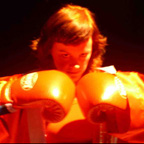
A Day in the Life of a Defective Relationship
VIDEOBOXING @ STRP Festival, Saturday March 25th Eindhoven, Netherlands:
VIDEOBOXING is a multidisciplinary videoperformance where film, new media, music, performance art, fashion, choreography and physical violence blend together on stage. The starting point of VIDEOBOXING is a collection of audio fragments from numerous arguing, fighting lovers and ex-lovers taken from the rich archives of film and television. They all display SXNDRX's main theme: the eternal struggle between man and woman.
One stage, two boxers, two screens. The screens show images of two people, a man and a woman. Fast asleep, each on his and hers own screen, literally divided. This peaceful image won't last long though. When the boxing match starts, the man and woman come to life on their screens to take it out on each other verbally. Slowly the audience realizes the connection between the boxers and the bickering couple on the screens. The boxers are this man and woman themselves.
With every succesful blow, irritation and tension rises on screen. Every well placed hit decides the intensity of the verbal violence between the two. They argue about anything and, more importantly, anywhere: in bed, on the streets, in a restaurant. Untill the inability to communicate leads to the imminent physical and emotional knock-out. Man and woman: sparringpartners for the endurance of the match, a match with no clear winner or loser. Untill the next confrontation arises.
Also on SXNDRX's Schedule:
VERSCH, organised by Beyond Expression!--March 31, Amsterdam, The Netherlands.
FIGHT will be performed at the Sensoralia Festival--April 1, Rome, Italy.
Posted by jo at 06:00 PM | Comments (0)
March 06, 2006
Collective Intelligence

Man and Machine: Continuous [Re]Cycle
Artist isolated from the world and only inspired by the Muse does not exist; it exists a person who exchanges informations and re-eleborates the signs of present/past that influence our living. The digital makes every data reproduced, re-elaborated, shared, accessible. Internet allows us to collect elements ready to be re-utilized and transformed in new artistic performances. The new artist is the hacker of the elements available on the net, in the sense that he is not limited to the passive use but he recovers, re-elaborates, he violates rules and proposes new possibility, sharing them freely, so that to give the possibility that the transformation's cycle is continuous.
The Mutaforma group, formed by Daniele Tito and Evilia Di Lonardo , suggested to the world wide web's artists to join the Collective Intelligence project. This project previews the file-sharing of audio and video available on the net, the rework of this ones and the successive file-sharing of the new videos realized according to the copyleft logic.
The project was divided in two part: research and new elaboration. Nine artists looked for ten audio files and ten video files on the net; all this files was a warehouse. It was used by project's artists to create a new video concerning the theme - Man and Machine. Everyone was not able to use more than two video or audio files he found. The project's theme is related to the influence of machines on daily life. The technology influences also our bodies and our thoughts.
The inspiration's source is the book - Collective Intelligence - by Pierre Levy, the french cyber-philosopher.
The final 9 videos are a DVD and they are also published on the net under a Creative Commons licence. In this way everyone can manipulate them to give the possibility that the transformation's cycle is continuous...
Mutaforma is actively contacting partners, television network, institutions, museum and curators interested in Collective Intelligence project's theme so as to be included in several manifestations. We ask anyone who is interested in Collective Intelligence project or anyone who has ideas, useful contacts and suggestions, to contact us at info[at]mutaforma.com. We will be happy to read your proposals for promoting the project and its artists.
[via random]
Posted by jo at 09:20 AM | Comments (0)
March 03, 2006
Taking The Time For A Walk
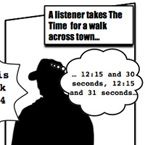
Between Performer and Radio Time
This project is an adaptation of Time Server which was first performed for the Foundry's Late Late Breakfast Show, broadcast in London on Resonance 104.4FM between midday and 1pm on July 22.
The work entailed Simon Pope walking from the NTP (network time protocol) server at University of London Computer Centre in Guilford Place, London, to the Foundry in Old Street, London, 'taking the time' and delivering it to the radio show from where it was broadcast live on FM radio. The aim of the work was to investigate the interaction between 'clock time' and 'circadian time', using radio broadcast's conventional standardized time as a gauge.
In Taking The Time For A Walk--by Simon Pope in collaboration with The Foundry--a radio broadcast of 'clock time' is 'returned' to the Foundry's radio show. Simon Pope will walk from the line of the meridian as it intersects London, 'talking the time' with him as he goes; this 'time', as moderated by the 'body clock' and movement of the performer, then becomes the standard time that the radio station uses in its radio broadcast. [a NODE.London event]
Posted by jo at 10:56 AM | Comments (0)
net campeones
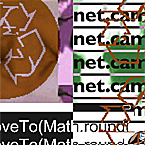
Cyber-Wrestling
In net campeones--by Antonio Mendoza, Arcangel Constantini, and Lele Luchetti, in collaboration with Andy Forbes--two web artists (net.legends) will face-off in a boxing ring to hack a web page live. The resulting changes will be seen by the public on a screen and by web-surfers on the net.
The artists will duel – using images, sounds, flash, HTML and javascript – for three hours assembling and disassembling the work and coding of their opponent. The cyber-wrestling match will be held in a boxing ring surrounded by three projections that will simultaneously display the hacked page and the desktops of the two competitors. An announcer will comment live as the battle develops. On the web you will be able to see the state of the page being hacked; listen to the music or sounds produced by both artists; listen and see the announcer and the duelist, and vote for the competitors. The winner will be decided through a combination of public voting and a committee of previously chosen jurors.
links: where its started - "INFOMERA"; “Mano a Mano” review from Mexico City Aug 2004; "CODE WARRIORS" essay; "the ephemeral angel". 1st-2nd April "SUM(1,4,6)" @ Area10 [a NODE.London event]
Posted by jo at 10:47 AM | Comments (0)
Mimeticon
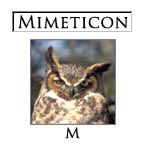
A Baroque Search Engine
Although the internet has far more images than text, we still cannot really search for them on their own terms, having to rely instead on conventional text based search engines like Google. Mimeticon, by Richard Wright, is an art project that uses a fundamentally different engine that takes a 'key image' and searches for visually similar images.
The Mimeticon is a Baroque search engine that uses pictorial alphabets from history. Mimeticon still uses keywords but requires the user to select a specific alphabet before searching. It then takes the word in this alphabet and interprets it as an image or 'word picture' used to search for similar pictures.
Searching by visual appearance is known as ‘Content Based Image Retrieval’ (CBIR) and is still an emerging technology. Mimeticon shows how the possibilities of CBIR are part of the Baroque tradition of language and image conjoined as written text. Their ornamental alphabets recall the figurative origins of the Latin alphabet back to Egyptian hieroglyphics. Although CBIR will soon allow true visual instead of textual searching, Mimeticon uses the history of the alphabet to remove the barriers between the two.
Posted by jo at 10:33 AM | Comments (0)
A la recherche du temps perdu/In Search Of Lost Time
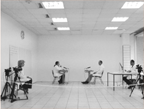
An Information Technology Presentation
A la recherche du temps perdu/In Search Of Lost Time, SPACE, 20th March 12pm-6pm, entry free.
For a long time I would to go to bed early. Sometimes, the candle barely out, my eyes closed so quickly that I did not have the time to tell myself: I'm falling asleep. Marcel Proust, In Search of Lost Time.
The performance A la recherche du temps perdu--by Karl Heinz Jeron and Valie Djordjevic--takes the code literally. We are reading the machine-code version of Marcel Proust's novel. During the eight hours of a working day the human performers are playing computer. From the analog to the digital and back again: The sequence of events of the performance is described in this manual. Starting from the ASCII-Version of Marcel Proust's novel A la recherche du temps perdu it is then re-coded into its underlying zeros and ones and then read by two performers alternately (one is reading the zeros, the other one the ones). The third person is CPU (the Central Processing Unit): She interprets the zeros and ones with the aid of an ASCII allocation table, cuts out the corresponding letter from the prepared sheets and turns it over to Display, who sticks it onto the wall panel. After eight hours of performance about 250 characters can be processed. During the act of reading, interpreting and presenting the work of art emerges, posing questions about the nature of the digital and the analogue, of work and art, time and beauty.
Posted by jo at 10:06 AM | Comments (0)
VisitorsStudio
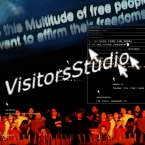
Version2
A project by Marc Garrett (director, creative), Neil Jenkins (director, creative & tech), Ruth Catlow (director, creative) and Furtherfield in collaboration with Arts Council England (London) (funder).
VisitorsStudio is an open, multi-user, online arena for creative 'many-to-many' dialogue and networked performance. Through simple and accessible facilities, the web-based interface allows users to collage and manipulate their own and others’ audio-visual files, and to imaginatively recontextualise existing media. VisitorsStudio provides a platform for explorations of collective creativity for both established artists and those excluded from traditional art structures, for reasons of geography or social circumstance.
In March 2006, Furtherfield will launch VisitorsStudio Version2, which incorporates new artistic tools and community building facilities, allowing users to schedule and promote their own performance programmes. These can be recorded, archived, downloaded and redistributed as screensavers. 25th-26th March "VisitorsStudio" @ Idea Store, Chrisp Street [a NODE.London event]
Participants upload content, image and sound files (JPG, MP3, SWF) to a shared database, responding to each other’s compositions in real time. Individuals can also chat with each other and are identified within the online space by their own dancing-cursors.
VisitorsStudio is a Furtherfield project collaboratively developed by artists, programmers, critics and curators, with significant contributions by audiences new to net art, and members of online art and technology forums. This platform continues to grow organically in response to their participation.
Posted by jo at 10:01 AM | Comments (0)
February 18, 2006
The Fibreculture Journal, Issue 7
![]()
Distributed Aesthetics
Distributed Aesthetics edited by Lisa Gye, Anna Munster and Ingrid Richardson--Abstracts: ...and Beyond: Anticipating Distributed Aesthetics by Darren Tofts; Theses on Distributed Aesthetics. Or, What a Network is Not by Anna Munster & Geert Lovink; Sharing Styles: New Media, Creative Communities and the Evidence of an Open Source Design Movement by Greg Turner-Rahman; Excerpts From ‘Portrait Of The VJ’ by Mark Amerika; Multiple Perspectives/Multiple Readings by Simon Biggs; Beyond the Museum Walls: Situating Art in Virtual Space (Polemic Overlay and Three Movements) by Vince Dzekian; Reshaping Spectatorship: Immersive and Distributed Aesthetics by Edwina Bartlem; Entropy And Digital Installation by Susan Ballard; Intimate Transactions: The Evolution of an Ecosophical Networked Practice by Keith Armstrong.
Finding new terminology for emerging art and cultural practices or for media and technological constellations is bound to be contentious. On lists, blogs and during face-to-face forums and conferences we continue to debate what the term new media entails, let alone whether this provides an umbrella for wearable computing, smart materials, mobile phone movies or bioart. It is clear that computational culture is drifting, fragmenting and laterally expanding: terminals are no longer dedicated; cultural producers are now recurrent and mobile multi-taskers; art is online, on the street, on a screen and coming at you from a million different places, now.
Rather than try to define the terminology or taxonomy of distributed art theories and practices we have proposed instead a descriptor for the ‘aesthesia’ of contemporary networked encounters. Distributed aesthetics, then, concerns experiences that are sensed, lived and produced in more than one place and time. This might equally be a sketch of reconsiderations of the operations of cultural memory or of phenomena such as endurance performances. But what we propose, through gathering together the disparate pieces in this fibreculture journal issue, is that techno-social networks are crucially constitutive of this distributed aesthesia. In various ways, all the texts here take up the mode through which ‘the network’ – the juncture and disjunction of here and there, you and I, social and individuated – functions as the crucial operand in dispersing and contouring perception, art practice and aesthetics.
It would be unwise, however, to assign distributed aesthetics the role of the ‘new’ new media. As Darren Tofts cogently demonstrates in his analysis of the burgeoning Australian media arts scene of the late 1970s and 1980s, certain network formations pre-date the current raft of theorisation. By re-visiting work from the 1980s by artists such as Philip Brophy and the band Tsk-Tsk-Tsk, which included street stencil art, live performances, video events and gallery shows, Tofts invites us to unpack media art as a temporally staggered and distributed event. The importance of drawing our attention to these pre-figurations of networked aesthetics lies in both highlighting the rich and remediated history of media arts and in sobering the frenzy around the fad for relational aesthetics doing the global rounds of art galleries and conferences. Like the Flash mobbing that arises form current distributed media, these earlier media art events depended upon a participatory audience prepared to facilitate information about the works’ distributed times and places. Geert Lovink and Anna Munster, on the other hand, discern a particular aesthetic dominating contemporary imaginings of the network, which they title ‘the will to network mapping’. In a series of speculative propositions that seek to move towards a social rather than formal aesthetics, Lovink and Munster prise this image of the network as an ever-growing euphoric entity to be charted via links and nodes away from biologistic and organisational metaphors. Instead, they suggest, networks are human constructions and their ‘aesthesia’ must come to terms with all too human experiences of frustration, boredom and labour that comprise life lived in and with distributed media.
From an altogether different perspective, Greg Turner-Rahman empirically explores the practices of resource, knowledge and skill sharing among online design communities that amount to a literal distribution of aesthetics. He offers us a different version of design practice, which is often only considered from the point of view of its corporate environment where the one-way transmission of brief from client to designer holds sway. Instead, Turner-Rahman compares an imaginative if more marginal set of designers who are operating in ‘open-source’ mode. Yet this is not an essay that is simply celebratory of the ‘network way’ again. We are invited to think through the felt tension of changes in design culture as it attempts to straddle both entrenched corporate and emerging online modes of production.
One of the most satisfying aspects of working on this issue of the fibreculture journal has been the response we have received from artists to the meshwork of issues covered by distributed media, art and practice. Satisfying because these responses tend to experiment with how to do distribution rather than worrying about the finer details of what it should comprise. In the extracts from ‘Portrait of the VJ’, Mark Amerika splices the cut and paste rhythms of computerised text with the slide and sampling of distributed audiovisual performance that characterise the art of VJjing. The VJ is a provocateur whose improvisational and hybridised practice recombines traditional art forms such as film with experimental writing, electronica and video, software and net art. In his own VJ art Amerika explores and performs the complex agency of images and sounds, often on-the-fly and comprised from a palimpsest of memories, perceptions, experimental digital effects, and geophysical and virtual networks. Such ‘visual hypertextuality’ is also a feature of Simon Biggs’ distributed and shared environments. In Babel, Biggs confounds the conventional geometry of vision – typically represented by an inverted triangle where the apex equates to the singular eye of the Cartesian subject – by creating a multi-user remote networking system so that what we see simultaneously includes the multiple perspectives of other viewers at dispersed physical and online locations. The installation Parallax also challenges the supposedly homologous relation between vision and self by creating a collective and interactive visual experience, effectively interspersing the behaviour of virtual objects in the screen with the multiple movements of inter-actors within the installation space. Keith Armstrong’s Intimate Transactions provides us with another practice-led contribution to research on the felt disjunction of networks/artworks. Armstrong’s essay is valuable in that it demonstrates that aesthetically working through the design of embodies and networked interfaces can also produce a theoretical and practical framework for artists. He names this ‘ecosophical’ – a thinking through of artist, interface, participant and artwork as a mutable ecology that produces change and difference for all nodes and interrelations.
If artists are busy distributing the event and object that we might once have called an art work, how are audiences and institutions reacting to and even re-constituting themselves as part of net-art-works? Although we may have heard quite a lot about the ubiquity of audience and the disappearance of the gallery with respect to online art, nevertheless exhibitions, installations and institutions stubbornly remain in all their localisation. Yet as Vince Dzekian points out, art galleries are increasingly both virtualised (their Web presence often producing entirely different aesthetic and cultural modes of engagement) and their infrastructure digitised. What, then, does this mean for the site-specificity of such institutions? Rather than take an online gallery as exemplary of such forces of distribution, Dzekian gives us a detailed polemic that brings distributed aesthetics into contact with the National Gallery of Victoria. Here we get a sense of the ways in which an institution wrestles with the experience of being dispersed between informatic and physical space and how its curatorial practices might negotiate this tension.
Of course as denizens of new media art we are already familiar with the splitting and conjoining of ‘the virtual’ and ‘the physical’ through analysis of virtual reality art work throughout the 1990s. In her article ‘Reshaping Spectatorship: Immersive and Distributed Aesthetics’ Edwina Bartlem challenges the notion that immersive VR or VE art and distributed or networked art are of a different experiential or perceptual order. Both immersive and distributed aesthetics, she argues, provide the conditions for a mediated yet fully engaging telepresence, which can effectively shift our understanding of art spectatorship from passive to performative mode and transform how we interpret and experience community, the human-technology relation and our own corporeality and consciousness. Susan Ballard is also concerned with a thorn in the side of new media theory, albeit a somewhat older one – entropy. Resonating with a problem that is of concern for other authors in this issue – namely, the transmission model of distributing signal – Ballard argues that entropy is not the downside to information being pushed around a space. Rather than the decay of signal, art that harnesses the material forces of leakage and dispersal might actually constitute a kind of networked experience. In examining the ways in which participants, computers, installed spaces and networks inhabit some recent art exhibited in New Zealand, Ballard suggests that fragmentation assists the pieces to materialize in their exhibition space.
What is insightful about the particularity of these analyses from Dzekian, Bartlem, Ballard and Armstrong is that they dig for frayed and uncharted elements of networked media, art and culture instead of lauding the technical as a necessary ‘connector’ of experience. Overall – and as is fitting for this issue’s theme – there seems to be no formal system, no set of objects and no one technology that can serve to ground a distributed aesthetics. But there are certainly enough shifts and cracks occurring to suggest that however we inhabit and imagine networks this habitat and this imaginary have by now thoroughly permeated and reshaped contemporary experience.
The editors would like to thank the many anonymous referees who helped with their insightful comments in their reports and for their time. In addition we would like to thank the authors for their patience in putting this issue together. Thanks also to Andrew Murphie for his skill and patience as executive editor.
Lisa Gye
Anna Munster
Ingrid Richardson
December 2005
Posted by jo at 11:28 AM | Comments (0)
February 16, 2006
Russian Roulette
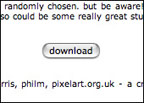
Download Gamble
The thrill of surprise that materializes in the opening of a gift / box is one of the most exploited images by the marketing professionals, also for its direct effectiveness. Sure enough the 'unknown' with pleasing premises build up a fund of expectations that sublimate in a climax, with easy-to-think-about sexual metaphors. These dynamics have their own corresponding electronic reference in the file's download that embodies many of its characteristics (the wait, the surprise, the gratifying instant). But the download has a crucial peculiarity: the distance (mostly unknown) from where the files are coming and the poor verifiability of their origin. The project Russian Roulette by Carlos Katastrofsky plays with this fascinating and fulfilling aura. It's a spartan mechanism: from a (unknowable) file archive the user get a random file clicking on the 'download' button. One one side it reminds online platforms like FileSwap, on the other side the bubble gum machines. And as it is in cheap thrills, the files' content is minimal or kitsch, but the downloading charm, that radiates from the act of receiving an unknown file after clicking on a generic button, is still unaltered. [from neural]
Posted by jo at 04:24 PM | Comments (0)
February 15, 2006
Golan Levin with Kamal Nigam and Jonathan Feinberg
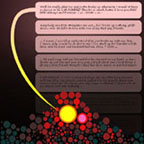
The Dumpster
The Dumpster, 2006, Golan Levin with Kamal Nigam and Jonathan Feinberg, artport, the Whitney Museum’s portal to Internet art: The Dumpster is an interactive online visualization that attempts to depict a slice through the romantic lives of American teenagers. Using real postings extracted from millions of online blogs, visitors to the project can surf through tens of thousands of specific romantic relationships in which one person has “dumped” another. The project’s graphical tools reveal the astonishing similarities, unique differences, and underlying patterns of these failed relationships, providing both peculiarly analytic and sympathetically intimate perspectives onto the diversity of global romantic pain. [See Social Data Browsing by Lev Manovich.]
“The Dumpster” is the first in a series of three works co-commissioned in collaboration with Tate Online. Critical texts and video interviews with the artists will accompany the works at http://www.tate.org.uk/netart/.
Upcoming commissions
Launch Date: March 1
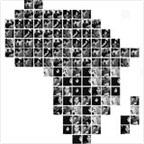
The Battle of Algiers by Marc Lafia and Fang-Yu Lin: This work recomposes scenes from the 1965 film The Battle of Algiers by Italian director Gillo Pontecorvo. The original film is a reenactment of the Algerian nationalist struggle leading to independence from France in 1962. The success of the actual battle for independence has been attributed to the nationalists‚ organization: a pyramidal structure of self-organized cells. For the Whitney’s artport, Lafia and Lin recomposed the film along a cell-based structure, in which French Authority and the Algerian Nationalist cells are represented by stills from the film and move according to different rule sets. When cells of different camps intersect, they trigger video cells displaying each side’s tactics (as depicted in the film) according to the rules of the system.
Launch Date: March 22
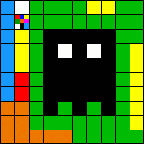
The Screening Circle by Andy Deck: This project adapts the cultural tradition of the quilting circle into an online format. Visitors to the site can enter the drawing area to compose loops of graphics and affect and edit each other‚s screens. The pieces can be made by one person or by several people and the arrangement of the segments can be haphazard or precise. In the screening area, the resulting motion graphics will be on view instantaneously.
[via newmediaFIX]
Posted by jo at 08:37 AM | Comments (0)
February 14, 2006
danwade
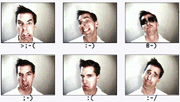
ASCII Conduit
Ikon: a symbol or visual representation. Emote: to express emotion. Emoticon: a combination of text characters that symbolize emotion. Interpersonal communication in its purest form encompasses a host of elements, including: verbalization, bodily gestures, and auditory tonality in physical close proximity between two interactants. Today’s host of cyber communications does not always allow for physical contact, which limits the availability of personal emotional cues. Person to person communication through email and chat programs have led to the development of a series of text characters designed to symbolize human emotion. Emoticons were born from the desire to humanize this correspondence, providing visual markers for human emotion.
In danwade's Emoticon, each emotional composition is matched with a series of keyboard characters that create an emotional symbol. These symbols evolve into a “danwade” interactive experience by combining medias and concepts represented in art such as portraiture, geometric composition and performance art. It infuses them with new media such as digital photography/prints, animated gifs, Flash and the project’s website www.emoticonman.com. The artist meets actor in defining these symbols as specific meaningful moments in what would be otherwise literal ASCII characters. danwade is the conduit in which these symbols are expressed. He brands them with his person through performance, technology and a photorealistic form of portraiture.
Emotions are further explored within the “ikons” segment of this project. Digital prints transform emoticon text symbols into geometric compositions. Weight, positive/negative space obscures lines of literal text characters into portraits, landscapes and abstract forms. The prints utilize a strict palette of text characters that are commonly used with standard emoticons.
danwade translates his identity as an active voice through multimedia in order to achieve a new level of emotional electronic communication. He has personally branded these emoticons as extensions of feeling and expression. The restrictions of online communication evolve. [via Evan on Cool Hunting]
Posted by jo at 08:03 AM | Comments (0)
February 13, 2006
Perfectly Normal:
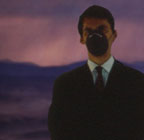
Video Therapy Dispenser
PerfectlyNormal is an interactive web based video project that presents a working model for a virtual therapist using the visual and written language of both the pharmaceutical industry and alternative medicine. Based on the user's description of their current mental state a "diagnostic video therapy dispenser" offers one of fourteen short video therapies. The therapies were created modeled on actual current and past healing techniques pulled from a number of different practices.
PerfectlyNormal toys with the conventions of both the western healthcare industry and it's rival the alternative medicine industry. By presenting video art in the ironic guise as therapy, it demonstrates some similarities between art and therapy. Both affect physical and mental states in unintended or unforeseen ways.
PerfectlyNormal is a web-based project commissioned by Soil Digital Media Suite, Neutral Ground Gallery, Regina, Saskatchewan, Canada.
Michael Stecky is a composer and new media artist whose videos have screened nationally and internationally, most recently at the Microwave Media Arts Festival in Hong Kong. His video work will next be seen at the "Supernovas" exhibition at the Winnipeg Art Gallery, and at the MAI, in Montreal during "Mini-Projo", Festival of Projection.
Posted by jo at 06:34 PM | Comments (0)
February 10, 2006
>OVER
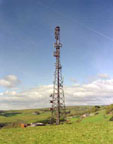
[TELE]COMMUNICATION
"Are you ready?" the message went out. The first message to cross water, the first wireless communication. The exhibition >OVER is, in part, a homage to Marconi’s ground-breaking experiments that he undertook near Cardiff to develop the first ever wireless transmission in 1887, a breakthrough to which nearly all of today’s telecommunications are indebted.
The means we use to send and receive messages influence the language we use, from the considered etiquettes of letter writing to the rash disposability of email and the text message; from the formalities of a landline telephone conversation to the obliviousness or indifference of the mobile phone user giving a prefixed report on their location. >OVER explores this territory. The artists either engage in methods of communication to produce the work, or they examine the impact, the language and significance of those methods.
Stefhan Caddick explores the text phenomenon. An LED sign facing the street from the gallery will display text messages sent from members of the public to its receiver. He gives us the opportunity to address the city. The project’s intention is to encourage members of the public to evolve a new use for these signs, which usually carry important but mundane information. Instead the Variable Message Sign will carry text messages, which by their nature are often deeply personal.
Lizzie Hughes’ two sound pieces expand and compress time and space by way of a simple telephone inquiry. In Second Empire State Building Piece, she telephones each of the building’s eighty floors, asking each occupying company in turn which floor they are based on. Their responses create an image of the building, but not one we might recognise or expect. Similarly, in a second piece, Lizzie telephones various locations around the globe to request the local time, which differs from call to call. She phones the same regions again over the course of 24 hours: this time each recipient reports identical times. The piece draws attention to the geographical and temporal scale of the world, its diurnal movement and our place within it.
Jennie Savage’s work Note To Self compels us to reflect on what we consider important enough to communicate to our future selves. We are invited to write a personal log that takes on archival significance because it will not be sent until 2011. By reverting to letter writing, a method of communication that now seems archaic, Note To Self gives a simple but enduring voice to our everyday, which would ordinarily pass without record.
If Jennie Savage opens out the communications loop by expanding the gap between sending and receiving, Paul Cabuts short circuits it. For the series Transmissions he has photographed telecommunications masts across South Wales. The range of these masts stretches across Wales and the UK, yet their surroundings are specific to South Wales. Transmissions illuminates the didactic nature of these structures, which are at once fixed yet transient, anchor points in the ebb and flow of cultural expediency and information exchange.
You are invited to the preview of the show on the 10th February from 6.30 at g39 Wyndham Arcade, Cardiff CF10 1FH. >OVER runs from 11th February to 18th March 2006. g39 is open 11-5.30 Wednesdays to Saturdays.
Posted by jo at 06:25 PM | Comments (0)
February 07, 2006
I/O
![]()
Inbox/Outbox Call for Participation
Inbox/Outbox is an e-mail institution operating and establishing connections between virtual and real public spheres as a means to propelling public access. Characterized by its temporary function as an agent, I/O avoids institutional incorporation of its subjects, thus removing itself from the final context, as well as allowing internal institutions and contexts to occur. I/O is based on a division into two binary functions, Inbox and Outbox, Inbox being the receiver of virtual data, which in turn is processed by Outbox and "forwarded" to public spaces.
Inbox/Outbox is currently channelling its activities through Centrifug, an exhibition space within Konsthall C in Stockholm, Sweden. The selection of exhibitions at Centrifug is based on a public booking list, released once every year. The Inbox/Outbox exhibition period is February 22nd - March 5th. I/O is for this occasion calling for participation. Admission will not be limited in any way, neither by amount of data, number of participants nor by any other criteria for selection, given the condition that submitted content doesn't infringe upon laws or regulations.
Submitted data must be suited for printing onto plain (A4) paper or for writing to audio-CD. Deadline is set for February 20th. Submit your data to inbox[at]inboxoutbox.org
Posted by jo at 10:36 AM | Comments (0)
February 02, 2006
The Exchange Project
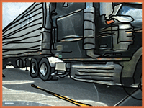
Performance of Technology Tracked Free Trade
The Exchange Project--by Nancy Nisbet--is an artistic inquiry that uses cultural resistance to unsettle questionable relationships between international politics, technological surveillance, and identity construction. Specifically this project addresses 1. The politics of trade agreements such as the North American Free Trade Agreement (NAFTA), 2. Myths of increased national security through technological surveillance of people and commodities and 3. Identity construction based on collections of economic and surveillance data. One outstanding feature of the Exchange project is a cross-border performance that combines Radio Frequency Identification (RFID) surveillance technology, a full-size transport truck, and all of Nisbet’s personal belongings.
In this sustained performance, Nisbet’s things will be inventoried, radio frequency tagged and freely traded with individuals encountered during the six month trip that circumnavigates Canada, the United States and Mexico. This project exchanges the studio for the roads, truck stops, border crossings and cities of North America. “Exchange” creates through the untidy weaving of politics, surveillance technology and identity construction. From the spaces between these coarse threads will emerge resistance, solidarity, vulnerability and moments of human connection.
BIOGRAPHY: Nancy Nisbet is a Vancouver-based artist. From a disturbing paintball gun performance enacting the chaotic fluctuation in the cost of crude oil during the lead up to the US-led War in Iraq/ War on Terror to the surgical implantation of 'identity' micropchips into her hands, much of her work considers the political, the technological and the personal. Of specific consideration in her mixed-media work are issues of power, economics, and surveillance and their cultural influences on entertainment/leisure, identity and community. Exchange 2006 is a large scale project currently underway.
Nisbet received her MFA in Photography from the California Institute of the Arts. She is currently Assistant Professor of Visual Art in the Department of Art History, Visual Arts & Theory at the University of British Columbia.
Launching May 1, 2006 at the Richmond Art Gallery. More information here [PDF]
Posted by jo at 05:00 PM | Comments (0)
g.volt
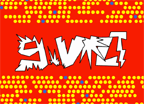
Girls Engaged in the Digital Art R/Evolution
Announcing a collaborative faculty and student web project sponsored by the Center for Women's Intercultural Leadership (Saint Mary's College, Notre Dame, Indiana):
Saint Mary's College Department of Art faculty and students--Profs. Julie Tourtillotte and Krista Hoefle with students Emily Fannon and Kristin Stransky--will be attending the Transmediale Digital Art Festival in Berlin, Germany as g.volt--girls engaged in the digital art r/evolution--from February 2-8, 2006. Track their ongoing adventures via blog, photos, and virtual maps updated regularly at their website--www.gvolt.org--beginning Thursday, Feb. 2nd.
Please contribute to our database of emerging digital media artists by submitting your url...follow the "submit this" button off of our splash page at www.gvolt.org!
Posted by jo at 03:22 PM | Comments (0)
February 01, 2006
CONFESS.OR
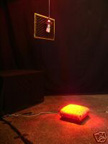
Religion for Rent on eBay
CONFESS.OR is one of the first pieces of Gerhard Schwoiger's ReReligion, a series of works that reflect on the place of religion in everyday life and investigate its Zeitgeist and adaptability.
Upon entering the room the visitor becomes part of an open confessional situation. Once s/he approaches one of the candles or places an ear on it, a single voice can be distinguished from the muddle of voices which forms a wall of noise at a moderate volume. The lattice of the confessional – the single element that is left in its original form – floats over the floor with a microphone in the back part of the room.
Kneeling upon the cushion, summons a female's voice, inviting one to confess. This enables those who avow to make an anonymous confession to the public. Upon leaving the cushion, the confession is automatically over. A confession that manages without the power apparatus of the church, without obligations. Once the confession has been made, it will be meshed with the sounds of previous confessions and omitted out of a few candles in the room. Judgment over the sins of others is placed in the hands of the individual.
Current confessions are available as podcasts (for example for your way to work). You can rent or buy the system on eBay. Acution runs for the next 10 days. Related: Pray as you go, mobile confessions, etc. [blogged by Regine on we-make-money-not-art]
Posted by jo at 11:34 AM | Comments (0)
Beatriz da Costa
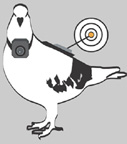
Pigeons that Blog
PigeonBlog--currently being developed by Beatriz da Costa--provides an alternative participatory way to environmental air pollution data gathering. It equips Urban Homing Pigeons with GPS enabled electronic air pollution sensing devices, capable of sending location based air pollution data as well as images to an online Mapping/Blogging Environment in real time....PigeonBlog uses a combination of Siemens’ XT 56 miniature GPS/GSM unit, an electronic automotive CO and NOx sensing unit and the Atmel AVR microprocessor. Detailed tech and datasheet information is forthcoming on this site.
However, in addition to being used for PigeonBlog, Cina Hazegh is currently working on broadening this platform towards a more general Open Source Hardware cell phone project....Pigeons releases will occur once a day throughout the duration of the festival on the ISEA premises. Release location: ClockTower in San Jose. The first release will take place during the opening ceremony of the festival on tuesday evening. Additional “White Dove” releases are planned at strategic high pollutant areas within the San Jose region. Exact locations are to be determined. [blogged by nicolas on pasta and vinegar] Related: Urban Eyes
Posted by jo at 09:29 AM | Comments (0)
January 30, 2006
Lauren Cornell Interviews

MTAA
Artists M. River and T. Whid formed MTAA in 1996 and soon after began to explore the internet as a medium for public art. The duo's exhibition history includes group shows and screenings at The New Museum of Contemporary Art, Postmasters Gallery and Artists Space, all in New York City, and at The Getty Research Institute in Los Angeles. International exhibitions include the Seoul Net & Film Festival in Korea and Videozone2 - The 2nd International Video Art Biennial in Israel. In the forthcoming New Media Art (Taschen, 2006), authors Mark Tribe and Reena Jana describe MTAA's 1 year performance video (aka samHsiehUpdate) as "a deftly transparent demonstration of new media's ability to manipulate our perceptions of time." The collaboration has also earned grants and awards from Rhizome.org, Eyebeam, New Radio & Performing Arts, Inc. and The Whitney Museum's Artport web site.
LAUREN CORNELL: Can you tell me a little bit about your net art pre-history, and how you met and started collaborating?
M. RIVER: I began working with performance and collaboration in grad school at Cranbrook (outside of Detroit). Driving North nonstop for 4 days until the road runs out, breaking into stranger's yards and mowing their lawns, backyard camping at mansions-my friends and I did these things together and called it "Art." It felt like 'odd sculpture' for me then. What I do with Tim in MTAA often reminds me of that feeling. From Cranbrook, I headed blindly to Brooklyn where coincidentally, Tim had also just moved. One day Tim called and asked if I wanted to collaborate on some paintings. I said, "Yes." And we've been working together under the name MTAA since.
T. WHID: I was working exclusively on underground comics, but I wanted to work on a painting. First I called a mutual friend to see if he wanted to collaborate. He declined but suggested I call M. since he had some canvasses stretched. We both thought the collaboration successful and continued working together.
LC: Something distinctive to me about MTAA is the heavy ratio of youthfulness you bring to everything. The voice that broadcasts out of your work or your blog is one that is always questioning and critical, and sometimes feels as angry as your average 16-year-old punk. You?ve told me before that people found you aggressive or crude. Do you find your attitude clashes with larger new media mores or manners?
MR: I think it is important to note that MTAA is performed. In MTAA, I work under the name "Mark River." This is not my name. (It's Michael Sarff-for the Rhizome record.) The M. River voice - in our work or on our blog - is not exactly mine. It's something used to create a world. Yes, you might read it as a world full of young DIY punks who want to tear things down and build new things up, but I'm not sure if that?s what our voice is all about in the end. I also think our voice has a little more depth than your average 16-year-old. (Then again...)
I do think our voice sometimes rubs people the wrong way. I'm not sure why. It might be that people feel more comfortable with art that's aloof. Humor doesn't always play well in the art world. As for aggressive or crude, I personally would like to see more "R" and "NC-17" new media and net artworks. Not that I would like everything to be blood and guts or that Tim and I strive for that in our work. I just feel that we need to get over the Science Fair default values of computer art. It's boring. That?s my 16 year old boy answer. That and I "heart" JODI. As for MTAA brawls, no, we get along swell.
TW: Hmmm. Am I totally deluded in not really seeing myself that way. I do think that a lot of new media curators don't see our work in the "big story." The problem with the new media art establishment is that it?s based too much in academia (since there isn't much of a market). Our voice, compared to this academic voice, might seem immature or angry, but in my opinion, it's just normal. Anyway, we're old fogies compared to the likes of Cory Arcangel and Paper Rad.
LC: Both of you have been involved with Rhizome since its beginning. As my job now involves mapping Rhizome's future (in collaboration with my colleagues, and the broader Rhiz network of course), I find myself constantly considering the organization's history: how it has grown, and made efforts to adapt to the changing conditions of the web, and concurrently, to internet art and new media.
Now, Rhizome's constituency is very broad. But, when it first started as a mailing list, it was quite small. People talk to me a lot about these early days during which net art belonged to an avant-garde of first adopters, an avant-garde that Rhizome, and other platforms like Nettime and the Thing, were home to. What was your impression of Rhizome, and its community, at that time?
MR: Just to skip down to the bottom line, I think people participating on Rhizome specifically, and the net in general, tended to experiment more in the beginning. Luckily, play and experimentation seem to be part of net's heart, so new weird things still show up.
TW: Rhizome was the first place that I found online where people talked about art and took it seriously. At first I remember being confused by the whole net art thing. I remember a contest to crown "Mr. Net Art" (I think Robin Murphy won). I was also confused by Robin's wrestling posts (do a deep Rhizome search for that one). I lurked for a long time before I took part in the discussion, then it was mostly "Direct To Your Home Art Pojects" (http://mteww.com/dyhap) emails.
LC: Who did you admire then, or whose work informed yours?
MR: I was looking at works by the original "net.artists" (JODI, Shulgin, Lialina, Cosic, etc) as well as Potatoland, Fakeshop, hell.com, Murph the surf, meiko and ryu, one38, Kanarek's World of Awe, restlessculture, the McCoys, GH, eToy, 01etc, Pavu, RSG, EDT, Wolfgang, blackhawk and Mouchette. It seems like I could on for a long time with this list but these are some names that jumped up.
LC: That seems like a very heady, and exciting time, those were the first artists to hash out Internet art as a form. No wonder you made the switch from painting and comics. What kind of work were you making at the time?
TW: Our first piece for the web was "Buying Time: The Nostalgia Free History Sale" (http://www.creativetime.org/programs/archive/1997/buytime/buytime.html). We didn't even have a computer when we started this project. We did it at Creative Time's offices (I remember not knowing what an HTML comment was). After that we used Rhizome and other email lists as a platform for the "Direct To Your Home Art Projects" (http://www.mteww.com/dyhap/) which was our second online project.
LC: With Both "Buying Time" and "Direct To Your Home Art Projects," and later works, you translate Fluxus, or conceptual art practices, to the web.
In your piece, "Five Small Videos..," you perform the repetitive gestures and everyday actions found in early video performances. Are these projects part of a larger interest or desire to situate net art within a larger historical art practice, or alternately, to see how particular art projects/movements translate online?
MR: For me, it is more B than A. Start with an understood set of rules or contexts. Once these rules and contexts move online or become automated within a computer, the results begin to distort. Although, I do not feel distortion is really our end goal.
Translation is the tricky word here. When you translate, you hope the meaning stays the same. I think the meaning of a work like "1YPV" is different than Teching Hesh's work upon which it's based. It's not just the difference in the mechanics of the work; it's a change of message.
TW: Part of our M.O. has been to situate our practice very clearly in art historical traditions. It was obvious to us very early on that the real power of the net was about information and interaction between individuals (as opposed to pretty moving pictures weeeeeee).
Creating art from interactions between individuals or purely out of information was nothing new to art. It felt natural to follow in this tradition.
LC: Throughout your work, you seem interested in illuminating the relationship between the artist and the audience, and by doing so, you often throw your artistic process into relief. What is your interest in visualizing these relationships? MTAA's, and the one you hold with your audience?
TW: Er, can I pass on this question?
MR: It's funny. Tim and I both have this deep interest in how people and groups communicate, but we don't talk about the "why" very much.
I think Tim's interest could be tagged as political. Mine? It's hard say.
We meet in a restaurant in Brooklyn. You ask us some questions. A few months later, you email us some more questions. Tim and I respond to the questions separately and then join the answers together. A friend edits the text. We send it all back to you.
You join all the text together in some manner. You place the text on the net for people to read and comment on. This is like our work - an imperfect group dialogue in which the process and misunderstandings might add up to some new meaning. This might be what interests me.
LC: Your works often have on off-line component, though they start with the web. In the case of "MITD" (http://lifeofmo.blogspot.com/2005/12/we-are-all-together-update.html), the piece started online, with viewers voting on which random bad art idea of yours you should make, and ended with you manifesting the piece in Artist Space. Does the nature of your work change substantially when it moves in between on and offline spaces?
MR: We've made net projects that move to installations, say "1YPV." We have installations that move onto the web, say "KDM100" (coming to a browser near you in 2006). In both cases, some details change in the move. Works like ?MITD? or "Printer Tree" are a bit different. They stand in both worlds. They make an arc from net to physical space. Both ends of this arc make the work.
TW: A lot of times the offline components are simply reformatted for the gallery space. For example, "1YPV (Gallery Version)" uses some of the same software as web version. It has the same video - but at a higher quality. In the case of "MITD," the piece itself is comprised of 3 components (a web page, a video and a sculpture). So, the nature of that piece is significantly different from "1YPV". It's more of an old school process piece, which happens to use the web and digital video.
LC: The years worth of XML code was an ingenious way to make your piece 1 Year Performance Video tangible and also marketable. I'm wondering if you ever imagine being able to quit your day jobs and be supported by your art?
MR: Strange. I never know what to make of this question. I think this might be the fourth or fifth time we've been asked in an interview or lecture about quitting our day jobs. The first thing I always feel is, "Gee" is their something you're not telling me? This thought is followed by, "I wonder if everyone gets this question?" Then, I tell myself, "No, everyone does not get this question." This thought always leads to, "Ya know, I don't care" Okay, maybe I do care, but not right now. In the end, I always look up with a dumb smile and say, "Yeah, sure. Why not" I say this because I think it's what you need me to say.
TW: Practically speaking, it would be harder for us to support ourselves as a partnership than it would for an artist working alone. We need twice the income. Theoretically, since there are two of us, we should be able to make twice the amount of art as a single artist. But the reality is that we?re lazy, so it takes two of us to produce the same amount of art as one hard-working artist.
LC: Tim, you were kind enough to make time to come and talk to the local television news station NY1 when they taped the Rhizome ArtBase 101 exhibition at the New Museum of Contemporary Art this summer. I remember I talked to them first, and gave them a pretty rote explanation of the show. (I was trying to keep it simple and sound-bytey so my main points would stay in tact.) I was really amazed at how bold your comments were. As I recall, you started talking about how other art forms were "dead media" and that net art was the art form of "the future". This was, of course, complemented by the fact that your red t-shirt made you look like a communist. Do you really believe in Internet-based art?s ascension as a medium?
TW: Yes. But I didn't mean just Internet-based art, but all digital/new media art. In any case, when artwork becomes digital, why shouldn't it be networked? Perhaps the distinction is meaningless.
LC: A question of terminology: MTAA describes its work as "net art" but surely you've noticed that people have decried "net art" dead or "over", a chapter that is now closed, etc. To me, it seems that terms like net art must be?to a certain extent?dealt with like terms such as feminism which are interpreted differently by different people in different contexts. What is your definition of net art ? and how does it relate to what you do?
MR: I guess this is the point to drag out Ye Ol' Simple Net Art Diagram (http://www.mteww.com/mtaaRR/off-line_art/snad.html) and the Abe Linkin's remix of it (http://www.linkoln.net/complex/). I'm fine with leaving terms like "net art" or "feminism" linked to certain classic moments, groups, and stances as long as people agree on the context. Not agreeing on the context leads to the same old arguments. It's like when "conceptual art" and "conceptual art" get hashed out over and over again. The other thing, of course, is that we can use "net art" or "feminism' to refer to a past set of ideals-but that doesn't exclude it from being an ongoing and evolving practice. Examples? RSS feeds or Le Tigre.
TW: My definition of net art is any art work that uses a network as an integral part of its medium. I'm really a modernist at heart (I'll just speak for myself) in that I believe that artwork should somehow marry its form, content, and subject. If you're using the Internet to make art, then the art should somehow use the network. If your work is a JPEG that would look just as good (or perhaps better) printed and hung on a wall, then it's not net art because it's not using the medium of the network.
But these definitions can change quickly. For example, XML feeds are altering the way media files are distributed over the web. If you take a series of JPEGs (or MP3s, or MPEGs) and create a feed and distribute them over time, then suddenly you're using the network and it could be net art (as opposed to digital photography or whatever).
LC: With another one of your works "To Be Listened to" (http://mteww.com./rhiz05/), it appears that you?ve jumped on the podcasting wagon?or were you riding in it before? Can you talk a bit about this piece?
MR: "To Be Listened to" (2bL2) in someways, continues the methods we used in ?Pirated Movie? (http://www.mteww.com/mtaaRR/off-line_art/Pirated_Movie.html) or "V-TAV" (http://www.mteww.com/VTAV/). We create a shell to distribute work and ask artists we like to provide the content. think 2bL2 will differ in that the shell created will allow listeners to organize as ell as participate in the work. What T.Whid talks to me about for 2bL2?s structure is a small remix and rate community. I think this is why we are dragging our feet on this one. We don?t want it to be another podcast.
TW: And that means we need more money too!:-)
LC: What does MTAA have to look forward to in 2006? Any New Years resolutions? As MTAA seems to wear its collective heart on its sleeve, I'm sure you won't mind sharing.
TW: We have plans to put "Karaoke DeathMatch 100" (http://www.mteww.com/mtaaRR/news/twhid/what_is_karaoke_deathmatch_100.html) online as a video blog and feed (URL to come, stay tuned). We've also received a grant to do a big piece that is going in a gallery somewhere (and still be net art). And our Rhizome commission, "To Be Listened to" of course.
MR: When we began working with the net it was easy to knockout a work. One good weekend together and a project could be done. Now, the scale is larger and the timeframe longer. We are looking at one big monster of a project this year, and it?s giving me the willies. I hope it turns out. I also hope we find time for the smaller scale projects. I find the small projects can be a place for the experimentation needed to drive the larger works.
As for the personal heart-on-the-sleeve in 06, or at least what "M. River' might have for a heart, I just don?t know. I?d like to give those choices for change away this year. Send me an email. Tell me how to live a better life. Send to mriver[at]mteww.com subject head: "m.river resolution 06." Best resolutions go on the blog.
+ + +
LINKS:
+ http://www.mteww.com/mtaaRR/off-line_art/snad.html
+ http://www.linkoln.net/complex/
+ http://mteww.com./rhiz05/
+ http://www.mteww.com/mtaaRR/off-line_art/Pirated_Movie.html
+ http://www.mteww.com/VTAV/
+ http://www.mteww.com/mtaaRR/news/twhid/what_is_karaoke_deathmatch_100.html
[via Rhizome]
Posted by jo at 11:14 AM | Comments (0)
January 23, 2006
Thomson & Craighead
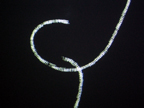
Audio and Visual Machines
January 26 – March 3, 2006 at Mejan Labs: Akademigränd 3, SE-111 52 Stockholm, Tel: +46(0)8-796 60 30; info[at]mejanlabs.se Open: Tue-Fri 11-17, SAT-SUN 12-16, closed Mondays.
At Mejan Labs Thomson & Craighead present two installations; Decorative Newsfeeds and Unprepared Piano. Decorative Newsfeeds could be described as a digital automatic drawing -a sort of contemporary update of Jean Tinguely’s drawing machines perhaps, but in this case with readable authentic up to the minute news headlines gathered in real-time from the web. The headlines are updated continuously and projected in evolving trajectories that weave and intersect each other according to a simple set of rules.
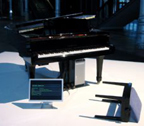
In Unprepared Piano, a Yamaha Disklavier grand piano is connected to a database of music MIDI files appropriated and compiled from all over the web. This library of found data is then “performed” automatically in the gallery with the full authority one associates with a concert grand piano. Each MIDI file contains an electronic score for a whole piece of music with different tracks for different instruments. When the piano plays one of these scores, it switches between the tracks randomly, which means it will sometimes play a piano part correctly but may also render drum parts, string sections and marimbas etc. in awkward configurations and combinations. On a monitor it is possible to see real-time information about what is being played.
The title Unprepared Piano specifically references the composer John Cage and his method of preparing a piano by fastening nails, coins and so on directly onto the strings inside the instrument, and in doing so to change the sound of it when played. But the title also refers to the piano being unprepared for the information it accesses and with no human performer and no way of knowing exactly what might be performed, Unprepared Piano becomes an endless generative mechanism for the performance of unique musical improvisations.
Thomson & Craighead: British artists Jon Thomson and Alison Craighead have been working together since the early 1990's. They are considered to be among the leading artists on the British new media art scene. Much of their work to date has paralleled the development of Internet technology by way of more traditional media such as video, sound and gallery installation, and they began working with electronic networks and communications systems when the world wide web first appeared in the mainstream around 1995. As this technology has improved and internet connections have become faster, they have begun to re-combine internet technology with their gallery work exploring the consequential possibilities of linking the internet to these kinds of physical spaces.
Thomson & Craighead often use the web as a gigantic database, procuring and reconfiguring existing material in real-time to offer new meanings and perspectives on the way in which we all might perceive the world around us. This kind of approach is in keeping with many methods used across the whole canon of contemporary art: real-time and generative processes, randomness, the recycling and misuse of information and technology and a process based flow that goes from one stadium to another.
Posted by jo at 10:13 AM | Comments (0)
January 16, 2006
Meshworks

Typing Shapes Performance
"This is a streaming video of a performance I did recently at Miami University in Ohio. It gives a fairly good idea of the screen (although blurred of course compared to the original). I'm in the room, silent, responding to the audience, and typing. The typing at the bottom of the screen is live, as is my choice of materials to run. At times, there are 11-12 Qt files open at once. By choosing materials, typing, I shape the performance."--Alan Sondheim
Meshworks was performed at the Leonard Theater, 12/1/2005.
Alan Sondheim is a multi-media artist working in written text, video, sound, and image. For the past twelve years he has been continuously writing a meditation on what it means to be "online"--a meditation that has carried him endlessly in and out of language.
His readings are a kind of one-screen laptop performance; he projects the screen as well as sound. The images are from short looped videos that appear to interact with each other. He writes live text at the bottom of the screen to accompany them. The whole thing is an improvisation.
Maria Damon writes that "In performance, Sondheim, who comes from the body-art/industrial music scene of the 1970s and 80s New York City, and who is usually associated with artists like Vito Acconci and Kathy Acker, has taken issues of process so deeply to heart that each time he presents at a conference or reading he creates a spontaneous, one-of-a-kind event: he displays videos and photographs, and plays soundtracks accompanied by his live, real-time typing response along the bottom of the screen onto which the foregoing are projected. The music is his own: frantically fast guitar-playing, distorted pipe-organ drones, or other common or rare instruments recorded and warped for use in this self-ensemble. Often there are four things to look at simultaneously -- more than one of them is moving -- as well as a compelling -- overpowering, in fact -- sound component that drives the piece rhythmically." [via netbehaviour]
Meshworks: The Miami University Archive of Writing in Performance--Meshworks is a site dedicated to documenting and preserving video and sound recordings of writing in performance. The site’s title is taken from an essay by cris cheek in Additional Apparitions: Poetry, Performance, and Site-Specificity: “Each poetry reading is a meshwork, a gathering, of differentially inflected components.”
Posted by jo at 08:03 AM | Comments (0)
January 09, 2006
The Palace at 4 AM
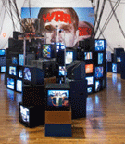
Wartime Voyeurism
New York artist Jon Kessler's recent video installations have focused on contemporary politics, representations of war, and the pleasures and problems of surveillance. His most immersive work to date, The Palace at 4 AM, is a room-sized anthill of flashing monitors, spider webs of cable, and an arsenal of rotating video cameras installed at P.S.1. Contemporary Art Center. The cameras are trained on free-standing images taken from footage of the war and political events. Like Hollywood miniatures, each briefly creates a false reality before the camera jerks away to focus on a different scene. Kessler also perforates the images, allowing flashes of the real gallery to penetrate his virtual war. Through the holes, people watching the monitors catch glimpses of other visitors between the dizzying presentations of politicians and explosions. This produces the giddy paranoia of watching and being watched, but the surveillance doesn't end in Kessler's closed-circuit. Until the show closes on February 6th, two of the cameras are streaming live to the internet. Tune in during P.S.1 gallery hours to watch bewildered visitors explore the installation--while they revel in being watched. - Bill Hanley, Net Art News, Rhizome.
Posted by jo at 10:46 AM | Comments (0)
January 05, 2006
Abe & MO Sing the Blogs

Blogs as Time-Based Performances
Blogs, like the Blues, have been credited with channeling "the voice of the people," but do blogs adhere to any one set of characteristics that defines them as a genre? And how might blogs be understood as public spaces, in light of the time-based performances that take place there?
Selecting the postings that comprise the greatest "hits" of some of their favorite blogs, Abe Linkoln & Marisa Olson sing the blogs in order to address these questions. While Linkoln's posts speak to musical genres at large, Olson's posts seek to find harmony with specific models. Both question the status of the author's voice...
The whole "album" is presented as a form of reblog, in an effort to self-reflexively dive into the meme culture that is its subject. The artists' blog gets situated as the site of a happening, and their intention is to come back and continue depositing performative ephemera.
Linkoln & Olson frequently work in the blog format. Previous examples of their collaborative work include Universal Acid and Blog Art, and separate projects My Boyfriend Came Back from the War (Abe Linkoln's 2004 Blog Mix), Screenfull.net (Linkoln & Jimpunk), and Marisa's American Idol Audition Training Blog.
Posted by jo at 01:00 PM | Comments (0)
December 29, 2005
Blogging the gifs away

Hypertemporality Animations
Hypertemporality Animations, a project by Peter Baldes, are a series of gif files laid out in a table that due to network conditions, browser idiosyncrasies, and the user’s own behaviour act dynamically. These simple, animated shapes and colors load sequencially, a typical web browser behaviour, giving birth to dynamic images that are the result of factors other than the artist's will. Reloading them or using different browsers will make them load differently everytime. Slower or faster Internet connection speed will influence how the animations are viewed.
These Hypertemps are categorized according to three subjects: color field, shape and web, which are simply a way to catalogue the artist’s inspiration for the original animated composition. Web relates to the use of an already existing animated gif. In the case of the flickr ones, Baldes created his own from a known web image (the flickr loading screen interface animation). Web also relates to representing time. Cory Arcangel's email gif gets subverted to more accurately show what an email must go through to arrive at it's destination, Tom Moody's atomic animation is broken down to show Heisenberg's uncertainty principle, flickr loads slowly… Animations labelled as color field use specific colour palettes or colour relationships that are significantly interesting to the artist. Shape follows the same principle than the previous category but now taking forms and shapes as the main interest.
These animations were originally created for an online exhibition called Hypertemportality, hosted by the University of Richmond and curated by Nathan Altice. Now they have moved to a blog, allowing Baldes to explore a more dynamic, almost performative way of creating and presenting his animated experiments.
Hypertemporality Animations
2005 - ongoing
Peter Baldes
http://hypertemps.procurate.com/
Posted by luis at 10:34 AM | Comments (0)
December 14, 2005
Brute Performance Kit

For Impromptu Exhibitionistic Moments
The Brute Performance Kit, by Stephan Hechenberger, is a prosthetic device which both cues a performance and reacts to it by translating movement and speech to sound. We live in a world where we occasionally simply have to bust out a bag of tricks, perform, and enjoy the attention. The Brute Performance Kit is designed for these kinds of impromptu-exhibitionistic moments. It is an apparatus which physically connects two people's heads to form a computer-mediated, pair of people. The primary reason for this cooperation is to move through space and sporadically utter philosophical propositions. Partly such a performance draws its character from the apparatus' blunt visual appearance, and partly from the combination of a live sound track and an algorithmically pro-scripted choreography. Users are cued and sensed. As the users follow commands, the BPK senses movement and utterance from which it composes a unifying sound scape.
There are three distinct parties involved in a performance with the BPK: the audience, the users, and the programmers. Each of them has a different vantage point. The audience are predominantly people of public spaces. They observe two persons being physically and operatively connected to one unit. Movement and speech appears scripted and exhibits a recognizable coherence. Stories are told by two people in unison and a mysticism is generated regarding the internal workings of the box. A private sphere of knowledge is overtly prominent within the public space.
The users wear the device like a helmet. They may roam spaces freely as long as they accommodate for their physical link. Two separate audio feeds--one for each user--tell stories as to why it is important to adhere to the instruction that are to follow. This sets the tone for the users' performance. Once properly introduced the device starts cuing movements and utterances ("move two steps forward, proclaim that your partner is rather slow today"). By sensing physical acceleration and analyzing spoken words the system gauges the level of participation and adjusts the cuing rate accordingly. Should the users discontinue their involvement the device falls back into persuasion mode explaining the importance of this setup. As an additional incentive to engage with the device the users will hear an increasingly more articulated percussion line as they intensify their participation.
The programmers of the box deal with a platform for experiments in the field of human-computer interaction. Unlike the usual one-to-one relation the BPK provides a triangular setup. Part of this setup are exclusive communication channels between the BPK and either one of the participants. This gives the programmers control over four different spheres of knowledge. They can specifically direct story lines at either participant separately, both participants, or the audience. By telling different stories to separate parties they can cause variance in the conception as to what the performance is all about, provoke interference, and interpersonal dynamics.
Part of the ITP Winter 2005 Show.
Posted by jo at 11:39 AM | Comments (0)
BOULDER - SCOTTSDALE - SYDNEY - WWW

24 HOUR COUNT: "a blog jam"
The 24 Hour Count is a multi-media blog band made up of Colorado artists Mark Amerika, Rick Silva, and Nathaniel Wojtalik. For this newly commissioned 24-hour online blog performance, the artists will use a variety of media including the Internet, mobile phones, digital video and photo cameras, mini-disk recorders, musical instruments, and many computer software programs to improvisationally remix, interpret, and respond to current events while filtering their "digital readings" through the prism of Count Lautréamont's "Songs of Maldoror," a classic French text written in the 19th century and whom the Surrealists adopted as the progenitor of their significant 20th century movement.
Sponsored by the Scottsdale Museum of Contemporary Art, the Alt-X Online Network, and the TECHNE lab at the University of Colorado at Boulder, the artists performing this distributed multi-media blog performance will be located in three different locations: Sydney, Australia, Boulder, Colorado, and Scottsdale, Arizona.
The event starts December 17th at 14:00 MST/Arizona; 16:00 EST; 21:00 London; 22:00 Berlin; December 18th, 08:00 Sydney.
For 24 hours straight, the three distributed artists will use the same blogging website as the virtual location for their ongoing multi-media jam session. The performance will coincide with the opening of the SOUTHWEST.net:Techno show in Scottsdale, and a living archive of the blog jam site will remain online both in the gallery through May 14, 2006, and on the web throughout the duration of the exhibition and beyond.
Posted by jo at 10:08 AM | Comments (0)
December 12, 2005
Ruark Lewis and Rainer Linz
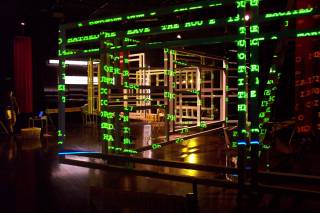
Banalities for the Perfect House
Banalities for the Perfect House--by Ruark Lewis and Rainer Linz--is a collaborative installation & performance work premiered at Sydney's Performance Space theatre on Sept 9 2005. The work proposes the house as a condition through which we perceive the world - the city an extension of grid-like structures viewed through the "frame" of an open window.
Performance texts are distilled from everyday sources including newspapers, cookery books, and snippets of overheard conversation. They consist of seven Banalities: Banalities for the Perfect House, Banalities for Napoleon, Banalities for the Modern Kitchen, Banalities for Solid Mandala, Banalities for Newspapers, Banalities for the Times and Misreading Barricades.
The texts are inscribed on all architectural surfaces, and take the form of performance scripts as well. These include cards, looseleaf and bound pages, and word sequences printed on ticker tape.
The sound is performed on five computer terminals and distributed through a 4-loudspeaker sound system. It is performed using real-time computer processing of original vocal samples, in turn derived from the written texts. The computer sound-generating software was purpose-written for the piece.
The performance space is arranged with wooden frames, boards and barriers resembling, in abstract form, a housing construction site. Each surface is rendered with text creating an immersive environment that can literally be read, and heard as speech.
The work is built around a series of duet and solo performances. Each is based on an individual text, which is the common basis for both the computer and vocal renditions.
The Perfect House is a construction site for ideas, with performers and audiences traversing it as if through rooms made from words whose meanings, too, are still under construction.
Posted by jo at 12:36 PM | Comments (0)
December 08, 2005
b-l-u-e-s-c-r-e-e-n

transversalMemory
transversalMemory Performance Instance #04: France, Lyon, Friche_RVI; Algorithm & Pix :: BlueScreen | Sound :: Julien Clauss | Light :: Karim; 2005.12.10_21h00 [december 10]
As one takes a photograph with a digital camera, a different name is given to each photograph by the camera. The form of this name is specific to the camera model. It usually comes as a an alphanumeric characters series which includes the camera model reference and a number identifying each image.
Whether they are intended to be publicly displayed, exchanged in a private or restricted context, or to be stocked, a large amount of these photographs end up being accessible on the internet, without the photographer even being aware sometimes. For each photograph we take, it is then possible to find on the net its twin images, that is to say photographs taken somewhere on the planet with a similar camera and bearing the very same name.
The transverse memory performance intends to connect a photograph taken at a given time and place with its twin images collected in real time on the internet. Once the photograph is taken in situ and through this photograph, an image of the place is projected ; a robot begins a silent exploration of the network, searching for images bearing the same name. These images gradually mingle one with the other without ever replacing the initial photo or being fully identifiable, thus opening spaces for the viewers mental journeys.
From the original image, we progressively slip mentally towards a succession of new situations, carried by the appearance and changing of different images mingling. The process taking place seems to bring to the foreground an imperceptible and imaginary dimension of the performance physical location. A dimension which stands somewhere between a fictitious past and a remote present. Even though no sense can clearly be established by what is given to see, the shift of the situations led by the atmospheres arising from the mixing of those images is an invitation to reverie, to the construction of a narration based upon the viewer's perception and individual sensitivity. Potential situations thus take shape, open fragments of narration carried out by the ability this process possibly holds to reveal, through the photography, a poetic and impalpable story of the place we are watching. It is only after a certain time, as we begin to sense the image through which it all started again, that we realise we had been carried away from it. We then have the strange feeling we are returning to a certain reality...
Posted by jo at 10:02 AM | Comments (0)
Cory Arcangel

Friendster Suicide
Dear Internet,
I am writing this to announce that I am going to commit Friendster Suicide on Thursday, ---> aka. delete my Friendster account. Yep, I just can't take it anymore. To my Friendsters, I'm sorry, ... c u on the net.
I am gonna do this as part of the launch of the Dec/Jan issue of the magazine The Believer @ ps1 on Thursday. The event starts at 6pm and also will feature lectures and talking by other people like Eric Fischl, Matthew Ronay and Lori Barbara.....for more info click here.
So yeah, if you want to see this live, please come, and if you want to watch the performance at home (yes, ... this is an Internet performance, remember that concept???? LOL!), Friendster me sometime before then, and around 8:40 EST on Thursday(ish), I assume if you keep reloading your browser window on Friendster, I think I will simply disappear from your friend list. Got it? Awesome. C U there, ... kinda.
l88888888r, Cory
Posted by jo at 09:50 AM | Comments (0)
November 29, 2005
Don Ritter Performances
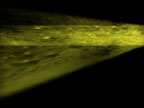
Digestion and Badlands
Don Ritter Performances in Budapest, December 4, 2005; Intro Festival Millinenáris Park, Budapest, Hungary.
Digestion:
Influenced by early 20th Century experimental animation, Digestion presents organic imagery--originating as boiling water--that is interactively transformed into a series of mechanical movements with synchronized sound emanating from the imagery. Using a pair of networked computers, viewers are presented with a hypnotic experience of multi-channel imagery that is controlled by sound. The seemingly unpredictable nature of the work provides an internal interactivity which can be observed by an audience, but not controlled.
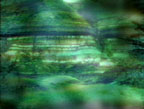
Badlands: Processed imagery of the Canadian Badlands are controlled and manipulated by live music. One or two networked computers use a musical analysis of live music to control clip selection, tempo and cinematic features of the video.
Since 1988, Don Ritter's interactive performances have been presented at festivals, museums, and galleries in North America and Europe, including the Art Institute if Chicago, New Music America (New York), Montreal Museum of Contemporary Art, and Steim (Amsterdam). [Related]
Posted by jo at 12:13 PM | Comments (0)
November 23, 2005
Nuisance

"Still Warm" Everyday Art Project
PLEASE CONTRIBUTE! Melanie is currently developing an art project that is based on digital photographs taken by people of their beds and pillows first thing in the morning - while (as the title suggests) they are 'still warm'. Her aim is to collect over a hundred photographs in order to stage an exhibition/database about 'waking up'. She is therefore calling (in a pleading way) for submissions. If you would like to contribute/help, please email Melanie a photograph (preferably 1000px although smaller is ok) to misses[at]yeeking.net. Her only requirement is that the photo is taken while your bed is literally still warm with the time and date of your snap. It would only take a few minutes and your anonymity will be protected if you so wish.
This will be be part of a larger art practice-based research project about the way people relate to everyday objects and spaces. This involves making drawings, films, bibliographies, databases and much of it involves the participation and collaboration of others.
Posted by jo at 10:35 AM | Comments (0)
November 14, 2005
17 Minutes
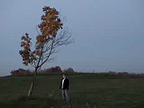
From Personal to Public
"Every 17 minutes, someone commits suicide in the United States." 17 Minutes is a video blog/performance project by Chris Barr. Each day he spends 17 minutes standing next to a tree, collapsing at end of the duration. Using time as a signifer, this ritual offers a place of reflection to the viewer and the artist, and deals with the specific circumstance of his own brother's suicide. As a reenactment it aims to be reminder of the life he is engaged in.
The project plays with the diaristic characteristics of blogs to move personal moments into the public/political sphere.
Posted by jo at 04:23 PM | Comments (0)
November 10, 2005
Transmute Collective
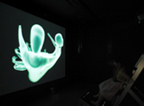
Intimate Transactions Between London and Greece
The Transmute Collective (Keith Armstrong (Dir.), Lisa O'Neill and Guy Webster) and their collaborators announce that Intimate Transactions (a networked interactive artwork) will be next shown simultaneously between the Institute of Contemporary Art, The Mall, London & BIOS (New Synthesis of Urban Culture), Athens, Greece. Date: 12 Nov - Wed 23 Nov 2005; 12 - 8pm UK GMT.
Intimate Transactions is an exciting new form of interactive installation that allows two people in separate spaces to interact simultaneously using their bodies. Each participant uses a physical interface called a Bodyshelf. By gently moving their bodies on this smart furniture they instigate Intimate Transactions, which influence an evolving world created from digital imagery, multichannel sound and tactile feedback.
Intimate Transactions was awarded an Honourable Mention in this year's Prix Ars Electronica in the Interactive Arts Category. Transmute pay tribute to all of the artists, staff and partners involved in making this project possible over the past four years.
Look out for the forthcoming ACID book/dvd, edited by jillian Hamilton: Intimate Transactions: Art, Interaction and Exhibition within Distributed Network Environments. For more details email ITBook[at]embodiedmedia.com
We particularly thank our major partners for this showing: The Australasian CRC For Interaction Design, Arts Queensland, The Institute For contemporary Art, BIOS and the Australia Council New Media Arts Board. Keith and Guy will attend this event courtesy of Arts Queensland, the ICA and BIOS.
This project has been assisted by the Australasian CRC For Interaction Design (ACID), the Australian Government through the Australia Council, its arts funding and advisory body & the Queensland Government through Arts Queensland. Intimate Transactions was developed with support from the Performance Space Headpsace Residency Program.
Posted by jo at 09:06 AM | Comments (0)
November 09, 2005
Networked Artwork
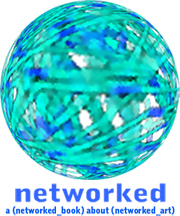
...slowly beginning to attract attention
"The Internet was supposed to bring us all together. Just ten years ago, the world was awash in bold predictions: The Web would obliterate race, gender and nationality. It would break down social barriers. It would usher in a new era of classless communication and interpersonal understanding. Yeah, right. "The Net is still a confused social space," says Andrew Shoben, founder of British artist collective Greyworld, "and for most of us, it's still a very private experience."
In the meantime, however, a diverse group of artists and engineers has quietly been developing projects that use networking technology to connect in the real world. Materials range from cell phones and Global Positioning Systems to ordinary objects such as beds and benches that are connected through a wireless network. Known as networked art, these projects are poised between art and commerce, and they are slowly beginning to attract attention..." From Networked Artwork by Leah Hoffmann, Forbes.com
Posted by jo at 11:04 AM | Comments (0)
MTAA
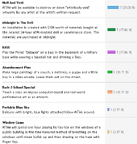
10 Pre-Rejected, Pre-Approved Performances
MTAA's 10 Pre-Rejected, Pre-Approved Performances: a list of performance-based artworks that have been rejected by curators at various venues worldwide. An on-line vote via the MTAA website will determine which performance will be created. Documentation of the performance and voting process is shown as the final work.
10 Pre-Rejected, Pre-Approved Performances ill be included in ARTISTS SPACE: Empty Space with Exciting Events Performance in conjunction with Performa05, December 13 - December 17, 2005. On-line voting starts November 8, 2005 and ends November 22, 2005.
Posted by jo at 08:23 AM | Comments (0)
November 07, 2005
Virtual Marathon
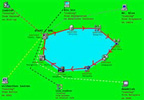
Run the Internet
Virtual Marathon is a game designed to let the players gain a new perspective of the Internet. The players become ‘virtual runners’ and run through different game servers hosted physically around the world. Through the course of running, the players running speed changes with the different servers. The players feel their (physical) relationship with the different web servers. Location becomes apparent, instead of being flat and smooth, Internet becomes a textured space.
As in a real race, you will get to train and then compete against the other players. However, for those who are not up to it, an option allows players to 'run' at leisure and enjoy the view along the way...This work is an experiment in blurring the boundaries between games, sports, and technology. Videos. [blogged by Regine on we-make-money-not]
Posted by jo at 11:07 AM | Comments (0)
October 31, 2005
Project Entropia
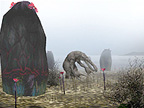
Gamer Buys Virtual Space Station
"A virtual space resort being built in the online role-playing game, Project Entropia, has been snapped up for $100,000 (£56,200). Jon Jacobs, aka Neverdie, won the auction for the as yet unnamed resort in the game, which lets thousands of players interact with each other. Entropia also allows gamers to buy and sell virtual items using real cash.
The space station is billed as a "pleasure paradise". Last year, a gamer bought an island for $26,500 (£13,700). The space station is described as a "monumental project" in the "treacherous, but mineral rich" Paradise V Asteroid Belt and comes with mining and hunting taxation rights. With the price tag also comes mall shopping booth and market stall owner deeds, a land management system, a billboard marketing system, and space station naming rights. Neverdie is a popular and well-known in-game character. He and another character, Island Girl, appeared in a 2003 dance music movie Hey DJ!, which starred Jon Jacobs, Charlotte Lewis, and Tina Leiu..." From Gamer buys virtual space station, BBC News. [Related]
Posted by jo at 11:01 AM | Comments (0)
October 25, 2005
Morgan Schwartz
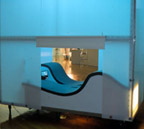
Chance Encounters, Deliberate Interventions
Pursuit of Happiness: Porta-Sky is an urban sanctuary and think tank for two. Periodic trips into the dark relaxation chambers of movie theaters became a routine survival technique for the subjects of modern society. In our post-modern world, where work and leisure have collapsed, the Internet has become a space of convergence. "Porta-Sky" is a physical corollary – a non-space, a hallway from here to there. Providing a personal view of a virtual sky, this video projection space offers alternate imagery to an anxiety-ridden sky. The unit features dual, synchronized DVD video projections, a deployable surveillance blimp and custom designed form-fitting reclining seats.

Situated in the Gallery@Green St (adjacent to the Green St. Subway station on the Orange Line in Boston, MA), Pressure was a site specific installation where computer controlled sensors manipulated the sights and sounds of daily commuting to address issues of accelerated culture and the evolving metaphors for speed and progress. Pressure seeked to explore the psychology and physicality of individuals in the contemporary urban landscape.
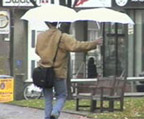
umbrellaSpace is an urban gesture. It is a design solution to a social problem. The intervention adjusts perceptions of boundaries and comfort held by observers on the street. This umbrellaSpace adopts the umbrella as a familiar, recognizable, urban form and recreates it. A permeable space of interaction is transformed from a private, individualized space. An individual in the urban sphere operates this new umbrellaSpace. He or she can choose to invite people on the street into this space. I’m interested in exploring the range of responses this intervention precipitates on the street: sociological, visual, performative. Schwartz is looking for people interested in operating the UmbrellaSpace as well as videographers and photographers interested in documenting the events.
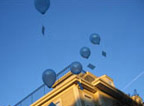
Currently in development at the Berwick Research Institute and on exhibit at Glowlab: Open Lab, Whether/Weather consists of aerial beacons that are dispersed into the weather system. The beacons are helium powered with LED blinkers. Like seeds, these beacons drift with the wind and carry information/stories/memories that hopefully germinate wherever they land. Whether used by an individual or a large organization, the project explores the idea of memory and memorialization through ephemeral and participatory public art. The person who happens upon one of the beacons that has landed, will encounter a message and the option of logging into a website to find out more about where/why the beacon originated. They can contribute their own response at this point and even decide to re-launch the beacon. By logging when/where the beacons are launched and when/where they are found Schwartz is visualizating whether/weather patterns. He hopes that the project will function like a collective 'message in a bottle' and tap into romantic and poetic possibilities of communication and chance discovery.
Posted by jo at 10:02 AM | Comments (0)
October 20, 2005
Franck Ancel

From Scenography to Planetary Network
From Scenography to Planetary Network [SPN]: an entity of creations, publications, conferences, installations and performances presented by Franck Ancel, in question over contemporary time: the last creation of 2005, in real time via wireless web, via satellite, at an altitude of 30000 feet, more than 900 kilometers per hour, to Tokyo or Shanghai, in the year celebrating France in China and the exhibition of Aichi in Japan.
In the continuation of his triptych AIT in France "Architecture - Image - Technology", these communications prepare for further rendez-vous. Ancel now inhabits the planetary space of technology to fall into and under the reality of the imaginary; a World Fair or a World Tour... like the Solarimpulse plane or like the city of Shanghai between the now and 2010.
Running the planet!: Europa - Amsterdam 09.24.05; America - Banff 09.30.05; Africa - coming soon; Oceania - Sydney 12.02.05; Asia - to Tokyo or Shanghai - End of 2005.
Scenography to Planetary Network for Urban Screens
"If the modern extension of cities is being transformed into urban territory due to the impetus of science-technology, then the classic places of artistic performance remain essentially victims of these changes without really being able to incorporate them.
These new technologies are responsible for the emergence of a “City of Bits”. This “City of Bits” that was analysed as “Space, Place, and the Infobahn” only ten years ago by the researcher William J. Mitchell of MIT in his work of the same name. This was the period of the democratisation of the internet, followed by the appearance of VRML, a time in which some believed that this cyberspace was another world, a new continent, or even, for others, a utopia. Its rise was signalled by the use of a global language, the invention of HTML by a scientist from CERN in Switzerland, which allowed us to move from one computer screen to another without any knowledge of the Internet code.
Thus our project “Being = Network” makes its mark in a city by symbolically confronting the arrival of what the internet scholar Howard Rheingold calls the “smart mobs”. I will rapidly summarize this, like the arrival of the third-generation telephone in Europe. It is this journey between the present and the virtual that I am referring to here all too briefly, that determines the time and reasons for my project, at first glance a simple confrontation of art with architecture, at the moment of the emergence of digital screens in the city.
This “Being = Network” action is not an anticipatory step, but rather a phenomenon which closes without being an end in itself the installation of our AIT triptych in France during the past three years, focusing on Architecture, Image, and Technology. A multiple creation which is not linked to the types of city projection of a Rafael Lozano-Hemmer, a Krzysztof Wodiczko, or a Dan Graham.
Without being a designer, artist, or computer scientist, I do not wish to give a too highly specialized talk, in this city of Amsterdam, birthplace of Constant, founder of the Situationist Movement. However, I am convinced that the visual arts now come from places intended to show them in order to deal with life, and vice versa. This is what propels our search outside of art, architecture, and visual arts. The closest concept is a display to be found at the Scenography to Planetary Network.
Let us call to mind the definition of modern scenography given by its founder Jacques Polieri: “all the pictorial, plastic, technical, and theoretical elements that allow the creation of an image, of a bi- or tri-dimensional set piece, or the installation of an action that is spectacular.” Let us now present the context of this “Being = Network” project that is so decisive in our process. This project of the projection on a screen took place in the centre of Paris in a square, which is situated in a locality that has many cinemas, as well as a stream of people via the metro or the train punctuating the streets.
At the middle, the Montparnasse Tower, a hundred metres from the Gare Montparnasse, at the heart of the city, signals its luminous presence in Paris by night and day. Built at the beginning of the 1970s by the architect Roger Saubot, it imposes by its height of more than 200 metres. There are over fifty floors of offices, each of more than 2000 square metres, with a panoramic restaurant for tourists. This is a Montparnasse that has nothing more in common with the international artistic bohemian life of the 1930s, with its artists’ studios and bars.
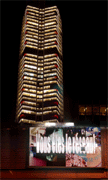
(1) Van Wagner, a world-leading communications company recently installed in France, was one of the first businesses to use large advertising spaces, with still projection, in New York during the 1970s. It now owns the screen at the bottom of the Montparnasse Tower, the only one of its kind in France. But it also has the other two screens in the world, one in London and the other in Los Angeles. This LED screen has a surface area of 38 square metres. Obviously, its location in the French capital, at the crossroads of many different types of networks, is what motivated us to spend more than six months negotiating a partnership with the Van Wagner company, with the aim of completing the project free of charge with their technical support.
Several contacts were naturally made with other businesses linked to the networks, such as RATP, the company that manages the Parisian metro system. This was in the hope of using live images from their CCTV cameras for our screen display. Also, with mobile phone companies, because I propose the appearance of cyber-traceability of mobile telephone chips thanks to software monitoring all movement within the city through cartographic superimposition.
This leads to the possibility for everyone to send live photographic and video captures from a mobile phone using MMS onto each window of the screen display. But none of this contact with these companies led to any results, either positive or negative, though the dialogue remains open for other projects. For the moment, I am not directly dealing with questions about the danger of the mobile phone waves for humans, nor about civil liberties’ with regard to CCTV.
Finally Van Wagner did not allow us to use the screen in real time. We did not therefore have access to the MP4 server broadcasting to the screen and potentially via the network to the two other screens, as I would have liked, to produce a live triptych between Paris-London-Los Angeles. In the end, the entire financing of the project came from a private source, as cultural institutions did not help this scheme.
Unlike the first two parts of the triptych, we were not consequently able to use the software in real time; we use MAX/MSP and JITTER. I came up with a global slogan which would be relevant for this specific context. A proposition of a highly prized poetic “hot spot” within the city which only contained the three words “Mobile Wireless Digital” invoked more than interactivity. The monumental projection at the bottom of the tower lasted for thirty seconds, inserted between other advertising clips, several times a minute for several weeks, until the end of December of last year.
Some video captures were selected from the first triptych projects, three for the Convent project built by Le Courbusier and Xenakis, and three from the Franco-Spanish border. These form windows whose size also has meaning. Each window of these short videos is similar to the typical holiday video captured by a mobile phone. The projection is thus made up of a video-wall corresponding to the windows of the front face of the tower. The video clips are thirty seconds in length, corresponding to the length of the advertising clips; but this is also the maximum time for sending this same video via a mobile phone file format, such as the 3GP, via MMS from one phone to another phone.
Here, whether it is appearing on my own mobile phone as a small image, or on the tower as a large one, there is a fictional connection. Without an audience, since no sign, other than newspapers and radio reporting this action, tells us that we are in front of a work and not of prospective products and/or services. If we were in Asia, the formats would be different but our comments would stay the same.
There are different technical supports depending on the continents. The history of media arts has a more universal history, founded on a re-reading and not only a French philosophical reading, with Deleuze, Virilio, or Baudrillard about the arrival of technology. Moreover, I will speak about these issues next week in Canada in a paper entitled “from Scenography to Planetary Network for refresh 01”, which is also the name of the gathering.
There is also a historical filiation for “Being = Network” with a scenography by Jacques Polieri. From the end of the Second World War, Polieri carried out research on historical avant-garde moments in the visual arts, namely those of exactly eighty years ago this year: the Bauhaus with Schlemmer, Gropius, Moholy-Nagy, Molnar, Weininger, the Paris international exhibition with Kiesler and Prampolini, etc. Polieri never stopped from going into and then beyond projects that were too limited by available resources.
Let us think, for example, of his synopsis using exterior screens at the 1972 Munich Olympic Games. Polieri tries to interconnect between them on a micro-scale: “Electronic images were installed from one end to the other of a “Leisure Street”, in the form of either colour VDUs (all along the street) of projections onto large screens permitting the public to dialogue or to participate in the various games. The five main screens were at the end of the street, together with the video control room situated inside a geodesic dome. Preparatory show.” The electronic gave it telepresence dimensions.
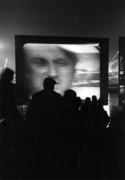
(2) In the meetings that I propose such as “Being = Network”, there can not be an area and a centre which will gain the upper hand, and the same goes for a discipline over a technique. Nor does the image in action simply constitute a performance. It embodies data which can be sound, gestures, an archive, a camera, infinite sources, thanks to digitization: a visualization whose screen is momentarily a performing technical support.
Also, the very existence of this screen in the Parisian space can not be the only grounds for our use of it. It is the context which is virtually projected. It would have been much simpler in a more formal dimension to project somewhere else with total freedom. But I do not want to move the white cube from the gallery, to open a new programme to an audience of contemporary artists, like at the crossroads of Time Square in New York at the beginning of the 1990s.
I am thinking more of an incarnation which, from now on, must no longer just remain within the context reserved for a projection, for it’s not just a projection, but rather of digital data, of finding future areas, like space that is now temporal, for the live broadcasting and recording of our lives. In this way, architecture is no longer the interface for a surface image for our projects, but is valid within a context of watching over emerging issues.
Like the support screens, the urban economy is not the framework of our practice. I am simply looking to determine and be part of the changes that are happening. Using an art without artistic limits, I am not engaging in experimentation but rather in a new way forward, one of widespread interconnection in daily life. So, for each of my designs, a desire to exchange with the professional best is a necessity.
This starts with choosing the site according to the project’s needs as much the same way as its technological items, which is not directly linked to the design or programming. Similarly, the media are no longer mailboxes with images to be re-conceived and re-designed, but are prostheses that are now integrated into our activity and lives.
For example, in our “Global Poetic System” project, which was part of a marathon, we diverted the sporting use of technology towards a digital visual and sound dimension, reconstructable using physical data. I will bring up this necessary conception of new interfaces for these emerging practices in the beginning of December, in a lecture entitled “from Scenography to Network Planetary for e-performance and plug-ins” at the School of Media, Film & Theatre, University of New South Wales, Australia.
To close this “Being = Network”, I would like to share the following anecdote from Bruce Sterling and Richard Kadrey, which is taken from “Dead Media Manifesto”, and which may be found on the Amsterdam internet site “De Balie”. They report the words of Jacqueline Goddarda, a surrealist bohemian figure of 1930s Paris:
“After a day of work, the artists wanted to get away from their studios, and get away from what they were creating. They all met in cafes to argue about this and that, to discuss their work, politics and philosophy… We went to the bar of La Coupole. Bob, the barman, was a terribly nice chap… As there was no telephone in those days everybody used to leave him messages. At the Dome we also had a little place behind the door for messages. The telephone was the death of Montparnasse.”
Our project for third-generation telephones is not necessarily the rebirth of Montparnasse. “You are not the network!” if the projection on the urban screen is your only interrogation. “I am the network!” if you redefine everything with new technology - not only as an urban accessory, but also in the universality of human beings in their future mobile interconnection with the world. While I wait, I am seeking new sensitive places like the Montparnasse Tower in Paris in order to transcribe a new temporality which is now becoming a planetary one." Franck Ancel
(1) Illustration no. 1 “Being = Network”, Paris Montparnasse Tower, photo by Simon Procter, 2004.
(2) Illustration no. 2 “Leisure Street”, Munich Olympic Games, 1972, pp. 42/44/45 “Polieri creator of modern scenography”, Bibliothèque nationale de France, Paris, 2002.
"SPN for urbanscreens05" in Europa and "SPN for refresh!01" in America, these english presentations are now online pdf.
Biography: Born in 1970, France, Franck Ancel works in Paris. He has been probing technology for more than fifteen years. He has traced the development from the avant-gardes artists of the last century to the recent mutations of creation on a planetary scale.He has thus organized and coordinated symposiums, expositions, and performances in cooperation with associations and institutions. The last one was a retrospective on Jacques Polieri, the creator of ”modern scenography,” at the BnF. Since the attacks of 9/11, Franck Ancel has set up an interactive triptych probing “architecture – image – technology” on 20th century heritage sites. In 2002, he put it in the Le Corbusier/Xenakis convent; in 2003 in a classified theater in Catalogne; and in 2004 on the screen of Montparnasse Tower in Paris. Franck Ancel challenges the viewer outside traditional frontiers, by projecting a setting of a network of information on screens. At the same time, he analyzes this technique on a more theoretical level in texts and talk.
Posted by jo at 12:19 PM | Comments (0)
October 15, 2005
theatre of restless automata
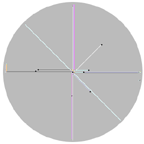
A randomSeed Online real-time Event
With the launch of a new work, randomSeed Online, within the theatre of restless automata at HTTP, you are now able to view the development of this computational system remotely, in real-time on the web.
RandomSeed Online uploads an image every hour from one of the systems installed in the gallery. Online visitors can view how the system develops from its (online) launch (which was on the 8th October) to the closing of the exhibition at 5pm on 23rd October 2005. View the work from here.
Emergence and Poetics in Restless Automata: On the 8th October Boredomresearch gave a talk at the gallery, discussing the relationship between emergence and poetics in respect to generative computational artwork. Using works from 'theatre of restless automata' they explore the notion that inherent mystification in emergent and computational abstraction takes on a poetic form. You can download illustrated text that was presented at the artists' talk.
For further information about randomSeed please visit here. Here boredomresearch presents research and development material that led to these computational systems being created. boredomresearch unveil investigations into simple rules found in natural systems and how these can produce diverse and complex images free from their aesthetic control.
randomSeed Online was created by boredomresearch for HTTP with programming by Neil Jenkins. It was made possible by Aspex Gallery.
Getting to HTTP:
Unit A2, Arena Business Centre,
71 Ashfield Rd, London N4 1NY
Tube: Manor House, Buses: 341, 141,
Car: free parking facilities
Posted by jo at 11:29 AM | Comments (0)
October 13, 2005
blinkenlights 2.0

Display your own Animations or play Tetris, Pong or Pac Man
the truly impressive blinkenlights seems to be finally running again for the next 2 weeks at the Alexander Platz in Berlin. blinkenlights is basically a huge 18 x 8 pixels monochrome screen based on computer-controlled lights that are placed behind each of the windows of a small skyscraper. users can create their own animations to be displayed, play Tetris, Pong or Pac Man against each other in real time via their mobile phone (call 0190-987654) or install a small software program to play via their computer instead. don't forget to watch the documentary movie to truly appreciate its effects. see also enteractive & internet facade. [via infosthetics]
Posted by jo at 10:18 AM | Comments (0)
October 10, 2005
Ballettikka Internettikka:
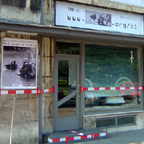
BEO Guerrillikka in Belgrade
Ballettikka Internettikka: BEO Guerrillikka [Bureau NetBallet] by Igor Stromajer & Brane Zorman (Belgrade, Serbia, 2005) (live internet broadcasting); Thursday, Oct 13th, 2005 at 9 PM GMT+1 (Berlin/Paris/Belgrade local time); Duration: 20 minutes (time tolerance: +/-4 minutes); Location X, Belgrade, Serbia; # Latitude: 44.79345 N, Longitude: 20.45340 E, Terrain Elevation: 110 m; Location will be made public on Oct 13th at 8:50 PM GMT+1 (10 minutes before the performance starts; due to security reasons).
Ballettikka Internettikka is an ongoing artistic study of the internet guerrilla performance. After invading the Bolsh.oi Theatre in Moscow (March 2002), and La S.cala in Milan (November 2004), Stromajer and Zorman will perform a new guerrilla net ballet, this time in another theatre house in Belgrade, Serbia.
Live internet broadcasting of the net ballet performance will start on October 13th 2005 at 9 PM GMT+1 and will last 20 minutes (+/- 4 minutes); the location will be made public on Oct 13th at 20:50 GMT+1 (10 minutes before the performance; due to security reasons).
They will enter the office (brain center) of the Artistic Director [location X], here the hardest artistic decisions to run the institution are taking place. The artists will use remote-controlled toy-robots with wireless web cameras.
Watch and listen live to internet guerrilla bureau ballet at http://www.intima.org/bi/beo
(Oct 13th 2005)
Artists will use low-tech mobile and wireless equipment for the invasion and live broadcasting (portable computers, mini digital camera, MP3 audio systems, mobile GPRS telephones etc). A laptop and MiniDV cam, together with Webcam32 (version 6.0) software will be used for broadcasting the video signal (running over Intima Virtual Base FTP server). Another laptop and MP3 player with online interface SHOUTcast (version 1.8.3/win32), will be used for live sound broadcasting (running over Beitthron FTP server). A local GSM mobile phone operator will be used for GPRS mobile internet connection.
Action Timetable / Belgrade, Oct 13th 2005 / GMT+1:
20:55 Equipment check on the parking place in front of [Location X]
20:57 Turning the computers on
20:59 Establishing wireless Internet connection (GSM 900/1800)
21:00 Start of live Internet broadcasting (-2) and final equipment check
21:01 Entering the building of [Location X]; climbing the stairs--3rd Floor (-1)
21:05 Entering the office of the Artistic Director [X] (3rd Floor / left): (0)
starting live bureau net ballet (10 min)
21:15 End of live bureau net ballet: exiting the office; descending the stairs (+1)
21:19 Exiting the building of [Location X]
21:20 Terminating wireless Internet connection at the parking place outside
[Location X] and turning off the computers (+2)
21:22 Taking the taxi to the O3ONE Gallery
Dancing a wireless bureau net-ballet in the office of the Artistic Director location X] represents a big conceptual and strategic challenge to the Intima Virtual Base, therefore the preparations have been taken serious, safety measures have been calculated, and the previous experience from the Bolsh.oi Theatre in Moscow and La S.cala in Milan has been very welcome.
Ballettikka Internettikka: BEO Guerrillikka is supported by Municipality of Belgrade, Ministry of Culture of the Republic of Slovenia, Ministry of Culture of the Republic of Serbia, O3ONE Gallery in Belgrade.
Bureau NetBallet Operators: Igor Stromajer & Brane Zorman
Bureau NetBallet Composer: MC Brane vs. BeitThroN vs. Thronus Sound System
Theoretical Adviser: Bojana Kunst
Curator: Ana Vujanovic
Executive Producer: Jelena Knezevic
Computer Programming: SM NORT
Co-produced by Intima Virtual Base (Slovenia) and TkH Center for the Theory and Practice of Performing arts (Belgrade)
[] [] []
Ballettikka Internettikka was presented in noumerous galleries and museums of contemporary art worldwide (from 2002 to 2005) including Le Centre national d'art et de Culture Georges Pompidou - Musee national d'art moderne in Paris, 15. Stuttgarter Filmwinter in Stuttgart, Centro em Movimento in Lisbon, FILE 03 - electronic language international festival in Sao Paulo, Titanik Gallery in Turku (Finland), P-10 Gallery in Singapore, IMPAKT festival in Utrecht (The Netherlands), Thailand 3rd New Media Arts Festival in Bangkok, Cork Vision Centre - Cork Cultural Capital of Europe 2005 (Ireland) and CEC ArtsLink in New York.
[] [] []
About the authors:
Igor Stromajer
http://www.intima.org
is an mobile intimate communicator. He researches tactical emotional states and traumatic low-tech strategies. He has shown his work at more than a hundred exhibitions in forty-two countries and received a number of awards. His works are included in the permanent collections of the Centre Georges Pompidou, Paris; the Museo Nacional Centro de Arte Reina Sofía, Madrid; Moderna galerija Ljubljana, Slovenia; Computerfinearts Gallery, New York and others.
Brane Zorman
http://www.ljudmila.org/beitthron
is a composer and sound manipulator. Between 1982 and 1986 he was frontman for the Slovene punk group O!KULT. He is a pioneer of Slovene techno scene. Since 1987 he has been composing music for both Slovene and international theatre, dance and multimedia performances and projects. and has made guest appearances throughout Europe. Recently he works with Irena Pivka on a series of audio-visual installations ZONE.
Intima Virtual Base - Institute for Contemporary Arts
Belgrade: +381 64 4200614
Slovenia: +386 41 703291
igloo [at] intima.org
Posted by jo at 11:15 AM | Comments (0)
October 07, 2005
C-Theory: 1000 Days 016

The Rebirth of the Author
"Roland Barthes’s famous prediction about the death of the author has come to pass, but not because the author is nowhere, but rather because she is everywhere. Indeed, the author has grown and multiplied in direct proportion to academic dismissals and denunciations of her presence; the more roundly and confidently the author has been dismissed as a myth, a construction, an act of bad faith, the more strongly she has emerged. The recent surge in personal websites and blogs — rather than diluting the author concept — has helped to create a tyrannical authorship presence, where the elevation of the personal and private to the public level has only compounded the cult of the author. We are all authors today. We are all ~auteurs~. We are all writers. We are all filmmakers. And we are all theorists, because what we make theorizes itself." From The Rebirth of the Author by Nicholas Rombes, C-THEORY, VOL 28, NO 3, 06/10/2005; Editors: Arthur and Marilouise Kroker.
Posted by jo at 11:01 AM | Comments (0)
CONTAINED

Improvisatory in Nature
Contained--by MIX--is a collaborative and interactive, hybrid work performance/installation that utilizes technology to blur artistic boundaries and challenges notions of presentation/audience. The artists have created a generative, improvising, real-time multimedia environment using both commercial and custom designed software in conjunction with dedicated hardware sensors, motorized robotics and real time processing or text, video, images and sound. Contained is improvisatory in nature, principles of movement improvisation are employed in the creation of the imagery, sound, and movement generated by the system.
October 7, 8, 2005; 7:30pm; Doane Dance Performance Space; Denison University campus, Denison University, Granville, Ohio 43023 USA • 1-800-DENISON; Performance with Artists' Talk to follow.
MIX is:
Sandy Mathern-Smith, dance,
Alexander Mouton, Art,
Micaela de Vivero, Art,
Christian Faur, Art, Digital Technology
Aaron Fuleki, Music, Digital Technology
Marlon Barrios Solano, dance and interactive art
http://www.unstablelandscape.org/
Mary Sykes, Lighting Designer
Posted by jo at 09:40 AM | Comments (0)
October 05, 2005
Mobile Phone Abusers Anonymous
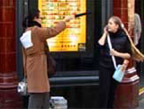
Town Crier
Mobile Phone Abusers Anonymous, a project by Hwa Young Jung, takes a critical look at mobile technology and how it influences social behaviour. She re-engineered a series of mobile phoness to challenge the idea of "being in touch".
One of MPAA performances is Town Crier. The Crier, equipped with micro-phone camera, transmits overheard mobile phone converstaions/visuals to the radio in the room. She picks conversations in public places to question the idea of inhabiting two spaces at once, and the effect on others who share our physical space. [blogged by Regine on we-make-money-not]
Posted by jo at 10:20 AM | Comments (0)
October 03, 2005
Re=purpose of Information:
Art as Network
"This paper presents an analytic perspective on the nature of Art as Network. The network (internet and intranets) is described as having properties of a nonlinear complex system, which serve to enable a network semiotic enabled by entailment meshwork. The network semiotic includes the characteristics of hierarchical structure, tendency towards self-organization and chaotic attractors, resulting in the emergence of self-similar alternates which function as dissimulators of interaction and immediacy. Art as Network is an exploration of the pandemonium of agencies forming entailment meshwork.
Art as Network is intended as a subject of discourse, not declaration. Certainly, I do not suppose that the particular theoretical investigations that I have chosen to discuss herein are the only points where the discourse of Art as Network is possible. My emphasis on complexity and semiotics involving entailment mesh, nonlinear dynamics, self-organization, homogeneity, dissimulation and the notion of alternates, is to establish a framework in which are present domains from which the artist might experiment. From Re=purpose of Information: Art as Network by Joel Slayton, SWITCH, V:4 N:2
Posted by jo at 08:45 AM | Comments (0)
September 30, 2005
Here For You
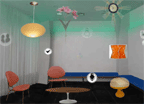
Redirect Surveillance, Control and Distance
Internet participants are invited to participate in a live network performance project opening Friday September 22nd at 7pm online and at the XINDUSTRIA exhibition at CAFKA 05, Kichener, Ontario. Here For You--by Will Pappenheimer--is a prototypical internet controlled space which allows virtual participants to adjust room lighting, see into the space, move objects, time clocks, upload messages and sound from your computer play it for the sound system. The guideline is to redirect surveillance, control and distance into channels of giving for physical visitors in the exhibition space. The exhibition continues through September 30.
This is a large ongoing project with dual physical and virtual levels and the challenges of connectivity and mechanics. It will begin simply develop as the exhibition proceeds.
“Here For You” will create a series of IP controlled conventional and fanciful domestic objects to comprise a network livingspace. Exhibition participants will be invited to relax in a living/domestic space constructed in or modified from available exhibition space. Appliances, both practical and artistic, can be controlled by anyone accessing the Internet from anywhere in the world. . The project hopes to create an environment where telepresence meets presence, remote control meets lifestyle, distance becomes proximity, surveillance becomes community and network becomes living room.
Posted by jo at 09:57 AM | Comments (0)
Mapping New Territories
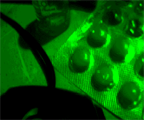
LOL (laughing out loud)
LOL: On jan 12th 2003, in Phoenix (USA), a 21-year old computer addict (called hereafter by his nickname "ripper") died of an overdosis of prescription drugs while chatting on the internet. Soon after this tragic event, a text file containing a transcription of the dialogs that occured in the chatroom appeared on numerous websites. Re-processing the dialogs recorded before, during and after his death, the N3KROZOFT MORD multimedia group expands the network tragedy into a caustic ectoplasmic seance.
"...N3krozoft Mord, a collective of media artists based in Geneva, have used the chat log as the script for a re-enactive performance. "The idea was to run this through again, like the film that runs before your eyes just before you die." The title LOL – the online acronym for "laughing out loud" – takes the chat’s commonest statement and uses it to describe the reactions of the participants as they sway between cynicism and helplessness..."
From the Mapping New Territories we site:
PERFORMANCE: 12.03.05, 19:00
The Fatal Failure of Telecommunications
LOL – a performance by N3krozoft Mord
[02:03:40]
[02:03:46]
[02:03:51]
These are the opening lines of an internet chat on 12 January 2003. Ripper is the code name of 21-year-old Brandon Vedas, who was to die at his home in Phoenix that night after taking a cocktail of prescription drugs while chatting with online acquaintances who were watching him on webcam. This tragic incident made the daily papers all over the world and within days, several websites had posted a chat log.
N3krozoft Mord, a collective of media artists based in Geneva, have used the chat log as the script for a re-enactive performance. "The idea was to run this through again, like the film that runs before your eyes just before you die." The title LOL – the online acronym for "laughing out loud" – takes the chat’s commonest statement and uses it to describe the reactions of the participants as they sway between cynicism and helplessness. Actor Nicolas Goulart plays Ripper, going through the actions that can be deduced from the text: Ripper sits, seems restless, drinks, smokes. He swallows pills. He broadcasts himself on webcam and, above all, he types intermittently at the keyboard. The actor replaces the original webcam footage, which was not recorded, and at the same time is the fictitious embodiment that recalls the lost presence of the dead man.
All the while, the chat log is screened in real time like film credits rolling: for 80 harrowing minutes the time code of the dialogue determines our sense of time. Life Images from a webcam focused on the actor are also screened. The authors of N3krozoft Mord intervene subtly in this sober yet obsessive repetition of the event. The footage of a second, moving camera is manipulated in situ as though mirroring the dying man’s drug-fuelled mental state. A troubling live sound track of booming sub-bass and high-frequency dissonance by the musician, 10111.org, underpins the moving image. The grim setting of Ripper’s desk, covered in equipment, paper, ashtrays, pizza boxes and glasses, is adapted from the opening scene of the film Matrix.
N3krozoft Mord’s manipulation of sound and image has a subliminal impact. It heightens the hypnotic magnetism of the authentic text, creating a mental space that acts as a resonator. Soon we find ourselves reacting as the participants did in the chat of January 2003, watching the bright green text unfold on the darkness of the screen, so mesmerised that we forget the reality unfolding in the room.
The virtual room in which Ripper and others are chatting is mainly about the abuse of prescription drugs. Press researchers have put the average age of the participants at 16. Ripper lists the drugs and the amounts and invites the others to watch him on webcam. Within 4 minutes and 9 seconds Phalaris has posted the cynical diagnosis: "attempted suicide # 84". At first, Ripper is egged on: "You pussy, you pussy, eat more." He takes it as a challenge, and boasts about his drug consumption and sexual exploits: "this is usual weekend behaviour, I told u fucks, u all said I was lying." Once it becomes clear that he is heading for a lethal overdose, some of them try to reason with him. Smoke2k writes: "look dude fucking cram it up your ass ... thats crazy ya know ... don't eat it... your already numb." Others send urgent virtual cries: "riipper ... RIPPER :((((" They even discuss whether to call the emergency services. But then they have their doubts – maybe Ripper is just acting out a suicide scene. Can the webcam be believed? Oea tries to call his bluff, then tries to coax Ripper back to life with a declaration of love. The medium heightens the kind of inaction that sometimes sets in among witnesses to a road accident. "you will never know if he died unless he get back on here," writes theKat, and grphish replies: "i know ... thats kinda freaky."
Another media-specific factor confuses matters: Pnutbot, who enters the conversation repeatedly at certain keywords, is not a human being capable of decision and action, but an automated chat robot. It remains a moot point whether Ripper himself programmed Pnutbot to throw in the poison control emergency number in a vain attempt to create some security within the casual framework of the chatroom. The kids in the chatroom are smart enough to find out, within seconds, the IP of the server and, with that the actual address of the anonymous Ripper. They have details – the lethal dose, the home address, the fact that his mother is in the room next door killing time with crosswords. But they do not add the bits together to a conclusive or binding narrative. Still less do they manage to translate them into the reality of the outside world and actually intervene.
In the chatroom, the gulf between simultaneous presence and absence offers protection, the liberty of risk-free intimate communication and a sense of belonging. In this serious situation, however, the same gulf becomes an insurmountable barrier. The young people are held back by the question as to what is real about what is happening in the virtual room. Or, to put it another way, what is fictional about the reality of what is happening. And quite a few of them cannot resist the temptation of simply withdrawing from their masked existence with impunity, from a chat that usually leaves only data trails, rarely corpses.
The simultaneity of presence and absence is mirrored in the setting of the performance without moral judgement. The audience is given a glimpse into both rooms, which cannot be brought together – neither in the actual incident nor in the performance. The gap between physical room and chatroom, between body and language, seals Ripper’s fate.
The N3krozoft Mord group, whose name itself combines computer and death, is interested in the subconscious, darker sides of telecommunication: "In the case of this chatroom protocol, what is unique is that the trail of the event itself describes the event. And it is a text that would not exist without the technical tools by which we communicate. It records and witnesses the death of a young man, but at the same time it is a statement about the vehicle of communication. ... The notion of telecommunication has always been linked with death. Even Edison’s phonographs were meant to record the voices of people so that they could still be heard after their deaths." The morbid aspect of telecommunication is also the subject of N3krozoft Mord’s latest audio work. Ubik is based on the sci-fi novel of the same name by Philip K. Dick, which describes how technology is used to retain the consciousness of the dead. With proper treatment, individuals become "half-lifers" and can communicate by voice from this semi-dead state, a kind of technically generated limbo. Fiction infiltrates our experience, whereas in Laughing out Loud, it is exactly the opposite: the fact of death tries in vain to penetrate the surface tension of a virtual community.
[02:55:32]
[02:55:46]
Text: Raffael Dörig und Annina Zimmermann
Credits
LOL – a performance by N3krozoft Mord
Idea & concept: N3krozoft Mord
Video projection, programming, installation: N3krozoft Mord
Audio: 10111.org
With support of: Bundesamt für Kultur/sitemapping.ch
www.n3krozoft.com
www.10111.org
Posted by jo at 09:47 AM | Comments (0)
OpenStreetMap
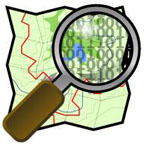
Cartographic Resistance
OpenStreetMap (OSM) is a project aimed squarely at providing free geographic data such as street maps to anyone who wants them. This is because most maps you might think of as free actually have legal or technical restrictions on their use, holding back people from all walks of life who would like to use a map for one reason or another.
OpenStreetMap is (or is almost) a free editable map of the whole world. It is still being written. OpenStreetMap allows you to view, edit and use geographical data in a collaborative way from anywhere on Earth. It comes in three major flavours: 1. Viewer--allows you to browse a map like any other; 2. Applet Editor--allows you to enter new data in your browser. Streets, points and areas can be entered and given metadata like names and whether cars or bikes can travel on them. You can upload GPS traces you've made and also edit the types of data you associate with the geographical data. You have to log in for this, so that the server can keep track of things; and 3. Home editor--this is for more advanced users who want more flexibility and prefer a dedicated application for editing data. [via]
Posted by jo at 09:23 AM | Comments (0)
September 28, 2005
MayDay NetParade
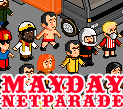
Political Videogames Against the Dictatorship of Entertainment
The MayDay NetParade--by Molleindustria--is a virtual demo that runs thru a heavily guarded and branded city put under siege by insurgent legions of brain+chain+temp workers and assorted anarchists, commies, queers and greens. The marching avatars are digital simulacra of today's exploited masses of neoliberalism: précaires, precari@s, precari, cognitarie, contingent knowledge and service workers. We are a mixed bunch, a heterogeneous multitude of precarious jobs and lives. Yet we have not spawn out of fordist assembly chains, but out of dystopian retail chains and office spaces. Why don't you give your pictorial contibution to this multicolored parade, and reclaim that visibility that mainstream media, unions, parties are denying us? Make yourself heard! Voice your anger and/or irony! You will be able to be part of a piece of collective net art. But do it fast, cos after May 1st, the NetParade will remain visible online, but it will no longer be possible to join. By clicking on JOIN, you'll be able to create your avatar, singular and (un)crazy as you want it to be. You'll have to answer a few multiple choice questions first, but these will be totally anonymous, private and dissociated from your avatar.

About Molleindustria
We can no longer consider videogaming as a marginal element of our everyday lives. In recent years, the turnover of the videogame industry has exceeded that of cinema, and there are a growing number of adult and female players. There are more frequent overlaps with other media: there are videogames for advertisements (advergames), for educational purposes and for electoral propaganda.
How did videogames become such a central element of the mediascape? During the second half of the nineties, major entertainment corporations extended their activities in this sector and extinguished or absorbed small producers. Now videogames are an integral part of the global cultural industry, and they are in a strategic position in the ongoing processes of media convergence. These developments inhibit the political and artistic emancipation of this medium: every code line is written for the profit of a big corporation.
One solution: Gamevolution! We believe that the explosive slogan that spread quickly after the Anti-WTO demostrations in Seattle, "Don't hate the media, become the media," applies to this medium. We can free videogames from the "dictatorship of entertainment", using them instead to describe pressing social needs, and to express our feelings or ideas just as we do in other forms of art. But if we want to express an alternative to dominant forms of gameplay we must rethink game genres, styles and languages. The ideology of a game resides in its rules, in its invisible mechanics, and not only in its narrative parts. That's why a global renewal of this medium will be anything but easy.
Molleindustria is an italian team of artists, designers and programmers that aims at starting a serious discussion about social and political implications of videogames. This will involve media activists, net-artists, habitual players and critics and detractors of videogames. We chose to start with online gaming in order to sidestep mainstream distribution channels and to overcome our lack of means. Using simple but sharp games we hope to give a starting point for a new generation of critical game developers and, above all, to experiment with practices that can be easily emulated and virally diffused.

Also, see //////////fur////: fighting massive-single-user-isolation, //////////fur//// develops art entertainment interfaces for multidimensional multiuser involvement: software-programs in mechatronic artefacts that create dynamic action-spaces for two or more participants. [via]
//////////fur////'s guiding idea is the alternative interface which goes beyond providing solely a visual navigation, manual control and massive single-user isolation.
Posted by jo at 08:47 AM | Comments (0)
September 25, 2005
Performing Web 3d
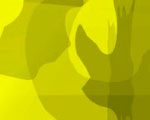
post avatar
Scorched Happiness is a live performance in 3d multi-user cyberspace using Julia Kristeva's text Toccata and Fugue for the Foreigner as a structure to explore the properties native to 3d cyberspace.
Artists Adam Nash (VRML, music) and Mari Yamanaka (visuals) collaborate with John McCormick of Company in Space to draw parallels between the text's investigation of the psychology of foreignness and the new and the unfamiliar of cyberspace. The project proposes to explore alternate vocabularies to mimicking real space, or exploring the relationship between physical presence and virtual presence by recreating the human form as avatar.
There has been little work done investigating the potential of shared networked space as a site for live virtual performance art on its own terms. Scorched Happiness is an attempt to develop a live performative vocabulary that is native to shared cyberspace.
What are the native qualities of 3D cyberspace? Real space properties such as up/down, in/out, falling/rising, heavy/light do not exist in 3D cyberspace without considerable effort expended in creating them. Scorched Happiness uses abstract, non-humanoid avatars to explore as many permutations as possible towards understanding the properties of 3D cyberspace. As the foreigner in Kristeva's text explores wildly varied emotional geographies in an attempt to know the new place, so does the avatar in Scorched Happiness' cyberspace. The foreigner is by turns ebullient, aloof, confident, melancholic, multilingual yet mute, ironic yet naive. The avatars in Scorched Happiness become huge, layered, temporally chimeric audiovisual events filling up the space then receding away as they react to one another's manifestations.
Logistically, the performance is eminently scalable. Naturally (and at its most fundamental), the performance can be experienced by logging in to the multi-user space - virtual audience members can thereby navigate the space freely, their navigation becoming part of the perception of the performance. Additionally, performances can be projected onto large screens at physical sites. It is the nature of 3D cyberspace that the performers may also be present at such a physical site or may be logged in from physically disparate locations. Multi-screen, multi-source projections can augment the experience at a physical site by projecting the performance viewpoints of different performers and audience members, with workstations provided for physical audience members to log themselves in from the physical site. Finally, the performances and avatars themselves can be made available in 'real time archive' form in single- or multi-user form to experience when the performers are not logged in. These can naturally be accessed via the internet from a workstation or projected on to a large screen.
Posted by michelle at 04:10 AM | Comments (0)
September 20, 2005
Remain in Light

Netting Ambient Analog Sound Waves
[...] Remain in Light, by Haruki Nishijima, is a visual representation of ambient analog sound waves captured using an "electronic insect-collecting kit." The "collector" carries an insect net that functions as an antenna and is attached to a device designed to capture the waves. Participants walk outside with the net. Through headphones, they can listen to phone conversations, AM radio, taxi drivers’ and police radio communications. A button on the handle allows collectors to record one-second sound bites.
These fragments of analogue information are transmitted to a computer that transforms them into points of light that are then projected onto the exhibition space. Each frequency is represented by a different colour. When visitors enter the space, their presence and movements are detected by sensors. This is how the "electronic insects" are activated, disperse then progressively disappear. Each light source is accompanied by a sound. The installation can be activated on the Internet. Remain in Light was part of the Touch Me festival in Zagreb, Croatia [...] Related: Tools for radio wave hunters [blogged by Regine on we-make-money-not]
Posted by jo at 11:50 AM | Comments (0)
September 19, 2005
OPENSTUDIO
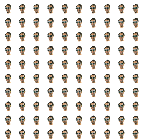
The Creative Economy is Launched
At the AIGA National Design Conference held in Boston this week, the PLW announced our new OPENSTUDIO project. OPENSTUDIO is a system we've been working on for three years now that combines "creativity, collaboration, and capitalism" in an experimental online art exchange system. Our goals are to provide simple, extensible, creative tools for free in an open, web-based environment.
Underlying OPENSTUDIO is a currency system we call the "Burak" (named after the trustworthy Burak himself) that pervades our model of online exchange. If you like a piece created in OPENSTUDIO by a friend, you can buy it with Buraks. You can sell your own as well. What are ownership models of purely digital art? This is one of the important questions we hope to experiment with in OPENSTUDIO. And if people make a few Buraks in the process, that can't be all that bad ...
As of 2AM on September 16, 2005 OPENSTUDIO had its first gasp of air and appears to look like it will make its first step forward next month. Burak, Annie, Kate, Brent, Martini, Amber, Kelly, Isha, Connie, Mariana, and Nikki seeded the AIGA conference on Friday with specially marked cards given out to visitors with "100 Burak" credits for when OPENSTUDIO becomes online to a limited audience. A total of 20,000 Buraks seed the core of the first test of OPENSTUDIO and we are curious how these Buraks will flow within the system. I have 97.20 Buraks myself, how many do you have? [blogged by John Maeda on Simplicity]
Posted by jo at 12:58 PM | Comments (0)
Net Worth
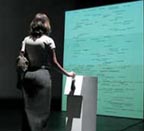
How Great is Your Net Presence?
The Internet is now the primary aggregator, disseminator and communicator of information. Individuals with greater net presence are deemed more significant. Net Worth explores a new value system for our information dependent society.
The visitor is invited to swipe one of their purchase cards in a kiosk with a magnetic card reader that stands in front of a monolith-like structure. The name contained on the magnetic stripe of their payment card is parsed and googled. The number of hits returned from the search is represented by positioning or ranking their name on the projection. Their name appears on the projection among others who have swiped as well as celebrities (whose names were fed into the system not only as a litmus test for the visitors but also as a reflection of our social condition: who has more Google hits Paris Hilton or William Shakespeare?)
The result is full of hits corresponding to people who happen to have the same name, but here the projected name is perceived as a true embodiement of the visitor.
Net Worth explores current conditions where information is given more prominence than the corporeal. The work also examines individuals' narcissism and hubris, much like carnival hammer hit games where physical muscle was tested, Net Worth gives chance for visitors to flex their data bodies.
By Osman Khan (see also one of his other works: Sur la table). Design Distinction in the Concepts Category in I.D. Magazine's 51st Annual Design Review. [blogged by Regine on we-make-money-not] [Related]
Posted by jo at 08:33 AM | Comments (0)
September 09, 2005
Ars Electronica
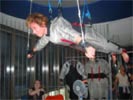
Blog From Ars
Hana Iverson and Sabine Seymour have just wrapped up their extensive report on Ars Electronica. This year's Ars, called "Hybrid: Living in Paradox," was curated by Derrick de Kerckhove, head of the Marshall McLuhan Program at the University of Toronto. A bit about Hana and Sabine is below and their report is after the jump.
New media artist Hana Iverson is currently the Director of the New Media Interdisciplinary Concentration at Temple University. Her work spans digital, video and sound media and has received support from such institutions as the Covenant Foundation, the Memorial Foundation for Jewish Culture, and the New York Foundation for the Arts (NYFA).
Sabine Seymour, Adjunct Faculty at University of Art and Industrial Design in Linz/Austria and founder of the course ‘Fashionable Technology’ at Parsons School of Design, concentrates on on wearable/wireless technologies in sports, healthcare, design, and branding. She co-curated the "Wearable Experience" section at ISEA 2004, recently published Intelligent Wearables, presents at places like Viper and Cooper-Hewitt Summer Design Institute, runs her commercial entity, Moondial and website, Fashionable Technology. Sabine floats between New York and Vienna and is intrigued by the tension the dual continent living is offering. Continue reading at Cool Hunting [blogged by Josh Rubin]
Posted by jo at 09:50 AM | Comments (0)
September 02, 2005
Unusual Encounters

Chance Encounters
Unusual Encounters is a three-part, web-based art project in which Jean Paul Gaultier has had the pleasure of participating and which is a mixture of creative sophistication and the latest technology, unique in the world, viewable at this address. Designed by the film director David Mileikowsky, under the artistic direction of Jean Paul Gaultier, the Unusual Encounters site proposes 3 original modules, offering 3 unique meeting experiences:
On September 9th, an on-line artistic improvisation will be organised for 500 trendsetters around the world and we have the pleasure of inviting you to take part in this exclusive venue. On that day, "Zhang will meet Veng" and for the first time ever, the unusual encounter between two unrivalled virtuosos, Maxim Vengerov and Zhan Yimou, the Russian and the Chinese, the violinist and the film director: two meteors of the Modern Arts will be brought together online in a live artistic performance, somewhere between China and Germany. Some 9000 km apart, the amazing duo will perform on-line, in unison. The first showing is scheduled for September 9th, at 12:00 exactly (Paris time).
You might also like to try Tango Painting, available as of today! For the first time ever, this multi-user graphic application allows user pairs to simultaneously draw up, from a distance and in an entertaining way, multimedia forms, regardless of their skill level. Their work can then be complemented by creations from artists such as Jean Paul Gaultier and Jean-Baptise Mondino, then shared with others on the web.
Finally, on September 10th, The Perfume Alchemist will be presented in an on-line world premiere. This visionary manga by Alain Escalle (director) tells a story of a child, a little prince of the streets, in a high-rise megalopolis, who decides to create the perfume of his dreams. Thanks to "Manga Maker", an on-line video editing platform, every user can participate in the adaptation of the course of the story and then pass the modified story on to his/her soul mate. An extract of this manga is available here.
Posted by jo at 10:25 AM | Comments (0)
August 31, 2005
Plug
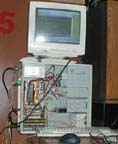
Global Headphone Festival
[Though it looks to be quite dysfunctional, this sucker sends the streaming Plug signal around the globe [Photo: Keith Axline].] "...In some ways Plug, held here Saturday, is just what you'd expect from a music fest: rotating performances in front of a live audience, socializing and plenty of beer. But the headphones (bring your own) replace a traditional concert's amplified speakers, and much of the socializing happens over a computer terminal linked to an IRC chat room, populated by members of the global audience listening to the performances over the internet...
The 13 hours of performances represented San Francisco's turn at the global le placard headphone festival, which hits cities all over the world, including London, Montreal, Paris, Brussels and Nagoya, Japan. Each city hosts a headphone party for a given period, in this case one day, before handing off the feed to the next location. Theoretically, this continues for 97 days in the hopes of providing one nonstop experience, though there are gaps in the schedule." From Fest Rocks With BYO Headphones by Keith Axline, Wired.
Posted by jo at 11:40 AM | Comments (0)
MINDPLAY:

Extended deadline for submissions
MINDPLAY is a one day conference on the social, intellectual and experiential dimensions of play and interaction in digital media environments. The conference focuses on mindful and playful relationships with digital media environments including mobile and ubiquitous media, new cinema, gameplay, wired performance spaces and networked communities. We encourage submissions of papers, practice-led research, poster presentations, demonstrations and installations. Selected papers may be published in a special issue of the journal Digital Creativity. Conference date: Friday January 20th 2006; Extended deadline for abstracts: Friday 30th September.
Posted by jo at 10:30 AM | Comments (0)
Pillow Talk
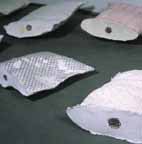
Pillow Secrets
Babs Reingold and Caroline Burton seek participants to reveal a secret by posting one or more on their Pillow Talk website. Pillow Talk is a two-person exhibit that illuminates as object the symbolic pillow and all that it implies. What if pillows could talk? Exposing our intimate secret conversations, obsessions, longings and fears. The concept for Pillow Talk embraces the need to reveal and store our secrets in a safe place.
All secrets submitted on the site will be utilized in the exhibit and in the opening night performance. Their specific use in the exhibit will be disclosed on the site at the start of the show. Before the exhibition, you may continue to view the secrets submitted on the site, the postings will remain on the site until the close of the show.
Posted by jo at 07:56 AM | Comments (0)
August 30, 2005
Pedestrian:
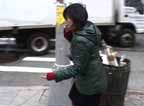
A Walking Tour for Multiple Voices and Portable Phones
Pedestrian: A Walking Tour for Multiple Voices and Portable Phones--by Geek Ink--is a performance piece that takes New York audiences on walking tours in groups of ten on three separate routes led by three actresses through the East Village. It allows the participants to "eavesdrop" on cell phone conversations exploring the topic of loss - from lost tempers and lost loves to lost identities. Pedestrian explores the public airing of private speech, which occurs daily on the streets of New York. Connected by cell phones, the actresses invite the audience to overhear their conversations, confessions, and revelations; in fact, all participants are connected by a conference call service, allowing each tour participant to hear all three tour guides simultaneously. The audience follows these women through the streets, taking a journey through the emotional lives of the tour leaders, while interacting with many East Village landmarks that may have gone unnoticed until now.
Geek Ink is a not-for-profit company dedicated to producing challenging, high-quality entertainment by presenting an examination of ideas with a liberal dose of irreverent humor. It seeks to nurture a diverse theatrical community that includes people of all backgrounds on both sides of the curtain. Toward this goal, Geek Ink is committed to making the cost of theater-going within reach of all New Yorkers.
Posted by jo at 12:25 PM | Comments (0)
August 27, 2005
Obsession
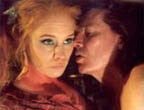
Manuscape: An Instrument for Non-Linear Storytelling
"I have just got back from Helsinki where I saw Pia Tikka's interactive film Obsession at Kiasma Art Museum. This is a four screen work of immense complexity, working with an automated rules-based system of clip selection, influenced by an audience's physiological reactions to what is seen on screen. Swivelling chairs allow the programme to compile data on viewers's gaze direction, while an interactive handprint on the chair arm picks up subtle alterations in skin conductivity and pulse rate and augments the presentation of image according to arousal states. The subject of the film is sexual obsession and attitudes to rape-conflating female desires and fantasies with a semi-documentary narrative. This is an innovative work, using aspects of audience mobility and biology to alter content." [blogged by Martin Rieser on Mobile Audience]
Obsession (2003-), Finland
Project URL: http://crucible.uiah.fi/crunet.nsf/etofilmpages/obsessio
Actor: Media Lab / University of Art and Design
People: Pia Tikka, Rasmus Vuori
Genre: interactive film/ installation and research project
Obsession is an interactive film/ installation and research project by film director Pia Tikka which uses motion sensors, cinematic metadata and generative algorithms. The participant has control over the drama flow in a manner that respects the affective nature of the cinematic media, where the participant may even lose conscious control over the flow of the events. Both conscious actions and unconscious sensorimotor reactions of the participant‘s mind/body can have effect on the narrative. Analyzed images are assigned a position in the narrative story-world map, i.e. the manuscape. The manuscape works as an instrument for non-linear storytelling and allows development of a range of interactive multimedia applications. Interaction and software design by Rasmus Vuori.
From the project web site:
Obsession is an attempt to describe, how the traumatic acts of violence not only affect the individual, but how his or her family and the life-environment are also violated. The narrative level of Obsession, in regard to its subject matter of "sex and violence" in our representational culture, brings this important subject matter to the focus of discussion. Inside the four walls of a self-service launderette, young Emmi and an entrant stranger, Henrik, measure embodied distance. From their interaction, a loaded emotional situation emerges, framed by a trauma that Emmi and Emmi’s mother Jatta share. The distorted mind of Emmi creates an endlessly wandering path of narrative potentialities and interpretations.
The computational core of Obsession is a narrative engine, based on content metadata. Inspired by the Russian film theorist Sergei Eisenstein (1898-1948), the”montage-machine” of Obsession maps spectators’ psycho-physiological states to cinematic elements. Obsession is a kind of enactive cinema: How the narrative unfolds, and how rhythm and soundscape are formed, depend on how the spectator lives by the emotional dynamics between the characters.
Posted by jo at 01:03 PM | Comments (0)
August 25, 2005
StarChild + FlatWorld

Data Sonification
Data sonification has been viewed as a tool with great potential for studying complex sets of scientific data. Sonification can provide the researcher with the ability to perceive variations and trends that are invisible to more established data analysis techniques. However, few have explored the potential artistic applications of sonification. In 1996, Jarrell Pair worked with Alec Robinson to se Matlab and Csound to prototype software to transduce data from various sources such as images, temperature, and light intensity into aesthetically pleasing audio. We used this work to develop the audio effects for StarChild. Using Csound and a custom C program, astronomical data from the Shoemaker Levy-9 comet collision was used as input to create audio for portions of StarChild. Additionally, images of the collisions with Jupiter were transduced into audio effects using Hyperupic, an application running on a NeXT computer. 440k MP3 file (low sample rate) taken from the sample files created from the comet collision.
From July 1995 through June 1996, Pair was extensively involved in the technical development of StarChild, a multimedia opera. The opera was composed and produced by Audio Research Team director, James Oliverio. Alec Robinson and Pair created sound effects for the opera using data sonification methods we had developed as part of an ongoing team project. He was also involved in the installation, testing and evaluation of the eight channel audio steering system used in the opera.
The StarChild production team included visual futurist Syd Mead (designer for the films Blade Runner, Aliens, Tron, and Star Trek: The Motion Picture ), the internationally recognized lighting designer Lloyd Sobel, animator Steve Walker, and scientists and engineers from across the Georgia Tech Campus. Students met and worked with the guest artists in workshops, lectures, and in the production of the opera itself. An internet MBone broadcast of StarChild took place on June 5th, 1996. Two live performances followed on June 6th and 7th.

FlatWorld: The Mixed Reality Simulation Space
Since 2001, Pair has overseen the design and development of the FlatWorld project at the University of Southern California's Institute for Creative Technologies (ICT).
FlatWorld is a mixed reality simulation environment merging cinematic stagecraft techniques with immersive media technology. Current virtual environments have severe limitations that have restricted their use. For example, users are often required to wear bulky head mounted displays that restrict a person’s freedom to physically move as they would in the real world. Furthermore, a person cannot touch or feel objects in the virtual world.
This project addresses these issues by developing an approach to virtual reality simulation which allows individuals to walk and run freely among simulated rooms, buildings, and streets.
Posted by jo at 10:33 AM | Comments (0)
August 18, 2005
Video Traces
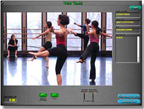
Capturing and Annotating Media both Visually and Verbally
Video Traces was conceived and designed by Dr. Reed Stevens of the College of Education and has been developed and studied in collaboration with PETTT. Video Traces is a system that makes it easy to capture a piece of rich digital media, such as video or a digital image, and to annotate that media both visually (using a pointer to record gestures) and verbally. The resulting product is a "video trace": a piece of media plus its annotation--in essence, a recorded "show & tell". Traces can be viewed by their creator, exchanged with others, and further annotated for a variety of teaching and learning purposes. Video Traces provides a unique opportunity to capture embodied knowledge and educational interactions by supporting the most common ways people communicate their ideas--through talking, showing, and pointing.
The Video Traces project serves PETTT goals in a number of ways:
· Explore the interplay of technology and pedagogy in real settings: We have collaborated with individuals both within and outside of the University, and have explored educational uses of Video Traces in settings such as dance studios, architectural sites, and science museums.
· Facilitate thoughtful and innovative educational technology uses: We have found that using Video Traces prompts reflection on the part of both learners and instructors, and in several cases has inspired instructors to adopt innovative new strategies for teaching their courses and for assessing student learning.
· Make strong connections between research, design, and practice: We have used our observations about how people use Video Traces and our interviews with learners and instructors to inform the redesign of the software and generate further questions for research.
Video Traces: Rich Media Annotations for Teaching and Learning by Reed Stevens, Gina Cherry, and Janice Fournier
Posted by jo at 05:39 PM | Comments (0)
August 04, 2005
EA's m/M
Six Hour Continuous INSTALLATION-PERFORMANCE
EA's m/M: [1] As computers keep offering us the ability to play with numbers in increasingly complex ways, our perception of proportional relationships is being exponentially challenged. We begin to realize our involvement in a ubiquitous hyper-game where reality fades into its own representation. [2] Even time is no longer regarded as an absolute parameter to which safely anchor ourselves. With the realization of these, ever-shifting dynamics comes the desire to take on an active role and to start interacting with the idea of relative magnitude, and with the way in which we perceive proportions. Microphones and amplifiers, optical lenses and projectors are some of the instruments that make it possible for us to monitor, analyze and redefine ourselves within our environment. Such technical tools, as well as philosophical hypotheses, are abundant and allow us a wide range of exploratory possibilities.
This exploration is the scope of m/M, EA's installation/performance in Williamsburg's Galeria Galou and its surroundings. During six hours, sounds and images will be collected from near and far, processed and re-presented in our first attempt to formally engage with the fluctuating interface that lies between the micro-bound and the macro-bound. An empirical test bench equipped with various electronic devices will be installed inside the snug space of the gallery. Its function will be to collect and process the sensorial information and to send it back to the outside world - the gallery's bare industrial surroundings and further on, eventually reaching EA member Andre Goncalves who will participate to the event via Internet connection from Lisbon, Portugal. Guest sound artist Brendan Murray, visiting from Boston, will provide yet another "outside perspective" to be internalized in the performance. Rather than a specific sound or an image, EA's piece will be constituted by the whole machine/environment. m/M is the whole functional apparatus designed to create dimensional loops and to attempt a short-circuiting of the conceptual extremities of inward and outward subjective planes. Passers-by will be attracted to the core of the performance space, and encouraged to participate in this empirical and expansive process.
EA is Gill Arno, Richard Garet, Andy Graydon, Andre Goncalves (performing from Portugal via internet), Brendan Murray (special guest from Boston) and Gil Sanson.
Galeria Galou: 237 Kent Ave. (bet. North 1st and Grand), Williamsburg, Brooklyn, NY 11211. Take the L train to Bedford - about 5 minutes walk from the train. Tel: 718-486-3730
Posted by jo at 12:14 PM | Comments (0)
August 01, 2005
Isabella Bordoni
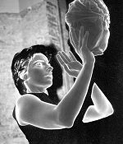
Language is the First Creative Act
"Isabella Bordoni: My first language is my body. Body is a language into temporal and spatial coordinates. I always felt and feel the need to enlarge my body's borders and explore the experience of sharing. A digital network is an enlarged body. In my entire work micro- and macrocosmos are engrafting one into the other, making thicker and thicker the grid of different glances. Everything appears, in its own nature, as being "point" and "place". Then, whatever creative act means: art for me is to create a place. To write, to walk, to follow a rhythm with words or music, whatever: the existence looks for a place to stay. A digital network is the enlarged body that explores a new concept of border and territory. Its geographical references move to the community of ideas, and this community of ideas is the main interest for me in art and net..." From Language is the first creative act: Isabella Bordoni in Conversation with Sabine Breitsameter, AudioHyperspace, March 2003.
Posted by jo at 08:53 AM | Comments (0)
July 27, 2005
Laurie Anderson: The Record of the Time

Sound in the Work of LAURIE ANDERSON
Laurie Anderson: The Record of the Time is a 30 year retrospective of Laurie Anderson's works that opened last week at the NTT InterCommunication Center [ICC], Tokyo. It will run through October 2, 2005.
Laurie Anderson (born 1947) rose to acclaim on the New York art scene of the early 1980s with her distinctive electronic performances, and continues to be a major globally active artist, one the very few truly international stars of performance art today. Utilizing synthesizers, video and computer graphics as well as various electronic devices of her own design, she blends diverse elements - music, moving images, language, action - into eclectic cocktails of experimental ideas and avant garde modes of expression that appeal to a broad popular audience. She is, in a word, the very embodiment of colorful postmodern performance.
Recently invited to become the first ever Artist-in-Residence at NASA, she created a new performance piece under their auspices. She is also currently showing an installation-video-performance work in a Japanese garden as part of Expo 2005 Aichi. Indeed, her keen creative energies seem inexhaustible.
The present exhibition was produced by the Musee d'Art Contemporain de Lyon, after which it toured to Dusseldorf, Milano and Dublin before coming here. Comprising some ninety pieces - everything from early works steeped in the conceptualism of the 1970s, to videos, assemblages, installations and original violins, to photos and drawings right up to projects for Expo 2005 Aichi - the exhibits span an artistic career of over thirty years, making this a real retrospective show, and for many of us here in Japan, a prime opportunity to take in the full scope of her multi-disciplinary, multi-media pursuits.
Posted by jo at 08:35 AM | Comments (0)
July 26, 2005
Infomera.net

HTML Wrestling
"How did you come up with this idea? What was the concept behind this Infomera HTML Wrestling?
The idea was to create an ephemeral project for the Internet. The name of the website is the combination of to ideas "informacion" (Spanish: information) and "efimera" (Spanish: ephemeral; feminine version). I deal a lot with the isis and tropos process with objects and I was hoping to create a metaphor of this on the web.
Infomera.net is a process that happens on the web, two artists confront each other in a context elaborated as a metaphor within a specific period of time. Infomera.net is a conceptual performance/happening elaborated as a ludic expression that demonstrates the diffusion and execution of the technique between the confronting artists. It’s not really a fight; it’s more of a collective expression between two people, an event of user/artist expectations and unique situation's." From Ephemeral Angel: Arcangel Constantini, Wrestler, Artist, Curator, Petite Mort, Issue #3.
Posted by jo at 09:52 AM | Comments (0)
3 x 3
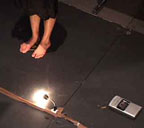
Looped
3 x 3--by Gemma Shusterman: the project looks at the fundamental relationship between audience and performer by putting the audience in the active role as collaborator rather than simply the passive role of observer. The performer becomes a conduit for a structure created by the audience. The audience in turn is given active involvement in creating their own experience and becomes engaged in an exchange with other audience members controlling the course of the piece.
The project consists of a web interface which allows the audience member to enter coordinates that map to the performer's space. These coordinates are then sent to a microcontroller (using the cockroach microcontroller) which controls the power supplied to the selected portions of the space. It is then the performer's job to find a way to move from one section of the space to another in improvisational form. The subsequent performance is then broadcast back to the site via webcam. video documentation. full video from live performance on 12.08.2004.
Posted by jo at 09:05 AM | Comments (0)
July 25, 2005
Haptic Spaces
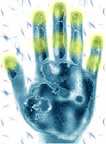
The Philosophical and Psychological Relation Between Touch and Space
"Touch and digital performance: This examines the expressive possibility of digital media performances that involve technologies of touch. This analysis includes examples of artworks divided into three separate 'moments' - the 'skin' and the discourse of surface; the 'flesh' and the notion of technological extension and prosthesis; and the 'body' and its motility, the way interactive touch is performed both on stage and online.
In digital performance some interesting developments have occurred whereby the body becomes displaced, and the senses distorted. This refashioning of the body in digital space has implications for theories of embodiment and of body morphology. Some digital performances positively engage in Luce Irigaray's (1993) discourse of fluidity in its evocation of the virtual environment, even the way the body navigates and moves around the virtual world, not by mastering space but by being penetrated by it." Continue reading >>. From Haptic Spaces by Mark Paterson.
Posted by jo at 12:10 PM | Comments (0)
July 22, 2005
Autonomous Expressionism and Network Arts:
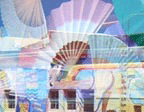
New Paradigms in Art, Emotional Interaction, and Information Retrieval
"Abstract: In this dissertation, I depart from traditional computer science metrics and methodologies and introduce a new framework for building computer systems with an emphasis on the creation of new artistic installations and interactions. Specifically, I introduce Autonomous Expressionism, an extension of Abstract Expressionism, whose goal optimizes the emotional experience in human computer interaction. I exemplify Autonomous Expressionism through the creation of several installations which externalize the World Wide Web as a repository of cultural connections; this is Network Arts. Each installation uses media...as a source and directs a performance using salient images and text found via web search. Together, the development of Autonomous Expressionism and Network Arts provides several advancements in Information Retrieval and Interaction Design. Additionally, I sub-classify types of Media Arts installations, which provides a framework for their comparison. Finally, I look towards the integration of Autonomous Expressionism in product design and software interaction." From Autonomous Expressionism and Network Arts: New Paradigms in Art, Emotional Interaction, and Information Retrieval, by David Ayman Shamma, Northwestern University [via]
Posted by jo at 09:41 AM | Comments (0)
July 11, 2005
Transparency to Exodus:
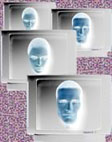
On Political Process in the Mediated Democracies
"...The most obvious contribution of the visual arts to the anticapitalist movements is the merger of community-oriented video with the distribution system offered by Internet, giving rise to innumerable non-normalized media projects that combine documentary information and expressive politics, in the lineage of Tucuman Arde. These projects carry out a specular combat with broadcast TV – that is, with the spectacle society – and in that way, they at least partially fulfill the political aspirations of the early videomakers. Another, more subtle thread is the proliferation of mail art, first through ‘zine culture and desktop publishing, then through the net, culminating in the mid-nineties in the widespread circulation of subversive texts and media pranks under multiple names like Monty Cantsin or Luther Blissett. Multiple names bring the refusal of copyright and intellectual property to the very center of ego-dominated subjectivity, in an attempt to dissolve the proprietary function of the signature which has always served as the barrier between contemplative, individualistic art and collective, interactive forms of expression. Yet another artistic contribution to the movements is performance culture, with its emphasis on the embodiment of the political, played out in its inseparability from the sexual, ritual, generational, ethnic, and psychodramatic dimensions of human experience...." From Transparency to Exodus: On Political Process in the Mediated Democracies by Brian Holmes, NOEMA.
Posted by jo at 10:08 AM | Comments (0)
July 08, 2005
1001 nights cast

A Durational Performance
In 1001 nights cast, Barbara Campbell performs a short text-based work for 1001 consecutive nights. The performance--begun on 21 June 2005--is relayed as a live webcast to anyone, anywhere, who is logged on to http://1001.net.au at the appointed time, that is, sunset at the artist's location.
1001 nights cast is a project generated by the forces of that great compendium of Arabian tales, The 1001 Nights also known as The Arabian Nights. The project explores the theatrics of the voiced story, the need for framing devices, the strategies for survival, the allure of the Middle East and its contrasting realities. Submit a story. View the archives.
Posted by jo at 04:18 PM | Comments (0)
July 07, 2005
July on empyre
Join the Discussion
Helen Thorington and Michelle Riel are guests on the empyre list for July 2005. The following are their first two posts on the subject of networked performance. You are invited to join the discussion: to subscribe and contribute, go here.
1. Greetings empyre:
First of all thank you for inviting us to be guests at empyre this month. Jim, especial thanks to you for encouraging our participation.
We are proposing a return to the subject of networked performance, which this list dealt with in September 2003, and a second look, this time from the perspective of recent new and transitional work.
On July 14, 2004, we (Jo-Anne Green of turbulence.org, Michelle and Helen) launched the networked_performance blog to explore the shifting paradigms in performative cultural practice. Our goal was to take the pulse of current network-enabled performance practice, to obtain a wide range of perspectives on current issues and interests—which we felt were under-examined—and uncover common threads that might help shape a symposium in 2006.
We didn’t expect what we found.
With more than 1,000 entries in its first year, the networked_performance blog reveals an explosion of creative experimental pursuits, as artists investigate the possibilities opened by the migration of computing out of the desktop PC and into the physical world, and by the continuing advances in internet technologies, wireless telecommunications, sensor technologies and Geographic Information Systems (GIS).
The ephemeral conceptual art practices that came into existence during the 50s and 60s – with Happenings, Fluxus, the Situationists – and that re-emerged as participatory works on the Internet in the early ‘90s, are now, with mobile networking technologies, networked sensors and embedded computing, proliferating as new ways of working and experiencing.
The interest in these emergent practices is keen, as the 150,000 visitors to the blog attest.
For the purpose of this presentation to the empyre list, we’ve defined networked performance as any live event that is network enabled. There is nothing clear-cut about what we are presenting – it’s exploratory and necessarily messy. But we see a great advantage in beginning to look at this outburst of new work – in chronicling it, understanding its commonalities and beginning to think about how it impacts our notions of performance.
We would therefore like to start by setting out four broad categories under which this new work falls, suggesting works within each that are particularly meaningful to us, namely works that occupy liminal spaces – the in-between – and are transformative and generative. We would like to invite the originating artists to describe their work, and then proceed by posing questions for the empyre list, such as: “How do we understand performance in relation to these new activities that are between the existing and the developing, and what can we learn from stretching our understanding of performance in light of these perspectives?”
2. Surveying the blog we identify four areas of networked performance practice which current work explores in various combinations. We have categorized these as (1) telematic events, (2) locative media, (3) wearables, and (4) active objects and responsive environments.
Telematics connect people to people or people to objects through a network, such as telerobotics or haptics; locative media provide location aware engagement; smart environments enable architecture and objects to respond to environmental changes of state generated by occupants/inhabitants; and wearables extend the body's senses through technological prosthesis.
We see lots of overlap and combinations in the works we survey, so these are not to be considered rigid categories but an effort at broad representation. We’re keenly interested in the commonalties across emergent art/technology practice with attention to artist/audience/object/environment, performativity and the open work.
1. TELEMATIC EVENTS
To date this has been the most prolific, comprehensible/understandable area of practice, encompassing the exploration of networked performance by the traditional performing arts where new technologies are integrated into existing forms (dance, music, theater). Examples of this would include the musical performance. InteraXis with Jesse Gilbert, Mark Trayle and Wadada Leo Smith and dance performances such as those created by AdaPT, an interdisciplinary association of artists, technologists and scholars.
http://www.turbulence.org/Works/interaxis
http://www.dvpg.net/adapt.html
Others move us onto new terrain. Jeff Mann and Michelle Teran, for instance, create performance events that explore new ways for computers to support social experiences in the physical environment. Their objective is not performance for an audience but creating a shared experience in which everyday social spaces become “electronically activated play environments, capable of transmitting the physical presence and social gestures that comprise…human interaction” across time and distance. No longer dependent on the work-based screen and keyboard, in these environments ordinary goods and wares – furniture, cutlery etc. – “come to life as both kinetic art and telecommunications interfaces”.
http://www.lftk.org/tiki/tiki-index.php
http://www.lftk.org/tiki/tiki-index.php?page=Telepresence+Picnic
http://www.interaccess.org/telekinetics/template.php?show=intro
2. LOCATIVE MEDIA
Locative media practice has exploded since the public availability of GPS and its consequent inexpensive and ubiquitous availability in mobile electronic devices. Some of this practice makes urban areas into game boards and city infrastructures into play spaces. Blast Theory, a London-based group, is renowned internationally for their contribution to this genre with works that make a public space ‘playable’ by participants in the street and online.
http://www.turbulence.org/blog/archives/000221.html
http://www.turbulence.org/blog/archives/000033.html
Others create “geo-annotation projects.” This involves assigning geo-spatial coordinates to media content so that it can be accessed at a specific geographical location with an enabled device. While the “true” location of the content is a database, by making it possible to access that content from a particular location, its place (so to speak) migrates into the physical environment, making urban streets and the landscape “programmable.” Urban Tapestries and the Aware Platform are examples of this. Both are location-based wireless platforms that allow users to access, author and share location-specific content (text, audio, pictures, and/or movies) – But there are many more: Yellow Arrow, Grafedia, MapHub, and, as Anne Galloway says, “ and oh, about a million others now.”
http://www.turbulence.org/blog/archives/000151.html
http://www.turbulence.org/blog/archives/000555.html
There are also projects specifically designed to enable communication and shape transient networked communities. Yuri Gitman’s Magicbike turns common bicycles into WiFi hotspots that broadcast free WiFi connectivity to their proximity. And Jonah Brucker-Cohen and Katherine Moriwaki’s UMBRELLA.net develops ad-hoc networks based around the haphazard and unpredictable patterns of weather and crowd formation. The system consists of a set of umbrellas as nodes that can spontaneously form a network when unfurled.
http://www.turbulence.org/blog/archives/000114.html
http://www.turbulence.org/blog/archives/000051.html
3. WEARABLES
Wearable computing enlarges the use of computers to include wearing them on ones body—much as eyeglasses or clothing are worn—and facilitates interaction with the user, and between users, based on specific situations. Fionnuala Conway and Katherine Moriwaki’s Urban Chameleon, for instance, is comprised of three skirts: 1) “Touch” changes visual properties upon contact; 2) “Speak” reacts to urban noise; and 3) “Breathe” visualizes pollution and urban exhaust as it travels through the garment.
http://www.turbulence.org/blog/archives/000146.html
Tina Gonsalves’ Medulla Intimata is responsive video jewelry. The overall function of the piece and its video content is to reflect the full character and content of the wearer’s emotions and thus present a fuller living portrait: the wearer as he/she is in unmediated interaction and the wearer as he /she feels at that moment.
http://www.turbulence.org/blog/archives/000137.html
4. ACTIVE OBJECTS AND RESPONSIVE ENVIRONMENTS
Increasingly, through ubiquitous/pervasive/ambient computing paradigms and wireless sensing, artifacts, objects and physical space itself are being charged with properties traditionally associated with living bodies.
In their recent Benches and Bins, Greyworld creates furniture that is able to roam freely through the new public square in Cambridge, England and respond to its surroundings and ambient movement.
http://www.turbulence.org/blog/archives/000335.html
http://www.junction.co.uk/HTMLTemplates/our_work/news/digital/Bins___Benches_to_be_Unleashed.htm
http://www.greyworld.org/contact/index.html
While Chris Salter, in the environment-inhabitant interaction Suspension / Threshold, focuses on the theme of thresholds or bardo (in between) states, and creates a body responsive environment where the aggregate breathing patterns of the collective audience/participants lighten an otherwise dark environment.
http://www.turbulence.org/blog/archives/000053.html
Much of this work is conceived to provoke interaction between people, and between people and their spaces. More than not it encourages people to be performers within the work and thus to enable or realize the work. This calls into question the accepted nature of performance and introduces a shifting relationship between the artist, artwork and audience.
We locate this practice within an historical continuum (Kaprow’s “Happenings,” Galloway’s “Electronic Café,” “Experimental Art and Technology (EAT),” the Situationists, Fluxus, etc.) and suggest that this trajectory is redefining the performative as a socially networked, collaborative model for artistic and cultural practice.
The overarching question, then. is:
“How do we understand performance in relation to these new activities that are between the existing and the developing, and what can we learn by stretching our understanding of performance in light of these perspectives”?
Other questions we are interested in include:
1. How is performance changing in response to networked computing technologies (mobile, satellite/GPS, internet)?
2. What is the relationship of 'real-time' computing to liveness and performativity?
3. What is the relationship of agency and authorship to performativity? Is performativity synonymous with being an actor, agent, or author? Is “performer” another label for the user/viewer/visitor/ of an interactive work?
4. As the use of the network becomes more social, adopting the peer-to-peer model, what does this imply for performance and net.art as performative?
5. How are network processes (algorithmic, procedural rule-based systems, generative) influencing or being investigated by performance?
6. How are networked concepts as modes of communication (granularity, open source, emergent behavior, affordance, latency, ubiquitous computing) impacting performance?
-- Helen and Michelle
Posted by jo at 07:40 AM | Comments (50)
June 28, 2005
Step + Repeat: Pittsburgh Cycle
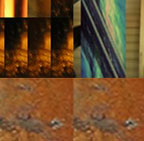
Shifting Technologies and Economies
Step + Repeat: Pittsburgh Cycle--by Carlos Rosas and Robert Dansby--Call for Participation: Submit your images of Pittsburgh. Your images will be entered into the image database and be included in the participatory tile sequence projected in the Palmer Museum and viewable on the Internet via live webcast. For more information on this project, to submit images and to view the live broadcast visit the project web site.
Abstract: A live audio and video based piece using networked media. Based on digital “step and repeat” cycles: a loose metaphor, the Pittsburgh iteration uses video and audio samples recorded in Pittsburgh, PA, and the surrounding western Pennsylvania area –with touchpoints including Primanti’s, the Strip, the Southside, East Liberty, the Northside, Beaver Falls, Jones & McLaughlin, the Monongahela Incline and Pittsburgh’s three rivers.
Divided into into six primary segments and a seventh segment including material contributed by viewers to be filtered through a digital randomizer, step and repeat: Pittsburgh cycle maps entrance into an urban environment via incline railway, transit through the city, reflections of the community’s industrial past, particularly steel, and the transformation of city and countryside as the industrial economic base shifts and nature again takes hold of old worksites. In the last two segments the viewer leaves the city, again on incline railway, and watches as the evening paints the city as a visually appealing study of water and reflection.
Concept and Development:
With a nod toward Allen Sekula’s work: specifically “Fish Story.” This piece chronicles (in a documentary fashion) the ironies, displacements, shifting values, economies and systems: the transformation of an American city as an industrial and economic center shifting from steel to telecom, and the reclamation of areas of the city and countryside dedicated to old economies/technology by both nature and the population at large - a population with new needs but retaining a core identity.
The “Step and Repeat” cycles are variable and highly dynamic works performed live with laptops or in automated modules prepared for web or installation on site. The media resources are mixed, filtered, and emitted via live performance software…deriving image, video, qtvr, audio, and net streams from databases and databanks resident on local and networked laptops and servers.
Posted by jo at 12:21 PM | Comments (0)
June 17, 2005
The Head

A Wearable Sculpture
The Head is a wearable sculpture with a connection to the internet and a public access via sms. The sculpture contains "an eye" (a camera lens) and a camera phone which captures images and sounds in certain intervals. People can send the Head sculpture an SMS to which the sculpture responds by capturing an image and recording a short soundfile. This image and the sound are sent back to the SMS-sender. They are also uploaded to a website with date and time of the capture accompanied with the sent sms-message.
The Head will be adopted and carried around by people and its "vision and hearing" is both automated and triggered by public to collect memories on the way. It will be also set (by the artist) to be adopted by people in professions which generally have "a view" on the society: police officer, politician, tourist guide, teacher, etc. Author: Laura Beloff (one of the developers of the Seven Mile Boots.) [blogged by Regine on near near future]
Posted by jo at 10:01 AM | Comments (0)
June 16, 2005
Contemporary Art Month
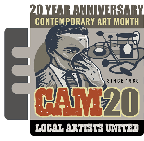
Call for Submissions: Networked Performances
CAM San Antonio (Contemporary Art Month) is currently accepting submissions for networked performances in July. Events would be included on our online calendar and promoted in print and via local radio. We currently have two virtual events scheduled--one will be at the Lab Gallery in NYC, the other is local.
If you have anything going on or know of anyone who does, please pass this communication along. If you'd like more info on CAM, check out our press page and history.
Posted by jo at 02:28 PM | Comments (0)
Human Browser
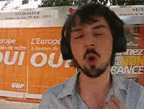
Helping France Vote
Paris, Sunday, May 29, 2005 : Jérôme Piques v1.0, the first Human Browser, created by net artist Christophe Bruno, experimented nearby a Parisian polling station. "This piece is a wireless Google hack: as I enter keywords in a Wi-Fi pda, to briefly describe the actor’s context, a program on a laptop uses these keywords as search strings in google. Then the laptop sends a text-to-speech audio of the search to an actor who then repeats what he’s getting via the headphones."
As a new epidemic of Turing Syndrom is spreading in France, unable to decide its own future, The Human Browser offered to help the nation. During a few hours, thanks to its brand new Wi-Fi connection and its amazing ability of real-time Web-mining, The Human Browser tried to invest in language derivative by-products, in a deflationary global semantic market. [blogged by Murphy at post.thing.net]
Posted by jo at 11:18 AM | Comments (0)
June 13, 2005
Indeterminacy

A young man in Japan arranged his circumstances...
John Cage was an American composer, Zen buddhist, and mushroom eater. He was also a writer: this site is about his paragraph-long stories -- anecdotes, thoughts, and jokes. As a lecture, or as an accompaniment to a Merce Cunningham dance, he would read them aloud, speaking quickly or slowly as the stories required so that one story was read per minute. Indeterminacy archives 186 of those stories. Each story is spaced out, as if it were being read aloud, to fill a fixed area. If you like, you can also read them aloud at a rate of one a minute. The stories are taken from two of Cage’s books, Silence and A Year from Monday, and from the Folkways recording of him reading 90 of them aloud as David Tudor plays piano (among other things).
Posted by jo at 09:57 AM | Comments (0)
June 10, 2005
A SoaPOPera for Laptops - robotic performance
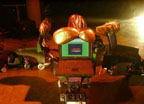
Performing Cars
A SoaPOPera for Laptops consists of four laptops on radio controlled cars. The laptops are mounted on custom made loudspeaker-trailers. The piece uses voice recognition and text-to-speech as well as max programming. The four vehicles are essentially performers. The work involves the four characters talking to each other or singing. Peter Sinclair and G.H. Hovagimyan also perform with the characters, by playing guitar or talking to the characters. A pitch tracking software allows the laptops to listen to a string of notes and sing along. The characters respond to each other via keywords that trigger responses thus affecting natural conversation. The characters cars are controlled by perfomers.
The performances were concieved of as unique and evolutive. The artists created new content and programming structures for each performance. As a consequence there are several difference titles for this performance work denoting the different developments. The alternate titles are: Exercises in Talking and Les Jaseurs. A SoaPOPera for Laptops is in the 2005 Summer Exhibition of the Jeu de Paume museum in Paris.
Posted by jo at 04:54 PM | Comments (0)
GilbertandGrape
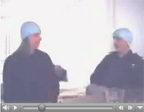
EXTRA: NEWS FLASH ON LIVE REPORTAGE
Steve Kurtz and Steven Barnes were in Stavanger this week to present Critical Art Ensemble. Steve is falsely accused for mail fraud by the FBI and is awaiting a trial. Please reed more about the case and support Kurtz by joining the mail list.
Steve and Steven came along for a ride in the Volvo Amazon with GilbertandGrape, we were planning to do ritual nr 34: Wear a swimming hat whilst making a hubcap think of Esther Williams. The rain was heavy so we skipped the hubcap, went inside to talk about the notions of heroes whilst wearing swimming hats. Watch our live reportage online.
Posted by jo at 03:57 PM | Comments (0)
June 08, 2005
Eliza Redux
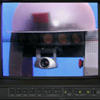
Turbulence Spotlight
Eliza Redux features a physical robot which, having passed the Turing test with flying colors, thinks it is a human psychoanalyst and persists in offering online pseudo- psychoanalytic sessions. Please help us to bring this robot to its sensors. Peer consultation is available in the Reception Area as well as archived sessions and other reference materials.
This human-robot interaction project is inspired by Joseph Weizenbaum's 1966 M.I.T. computer program ELIZA, which allowed for text-based human conversation with a computer playing the role of a psychotherapist. Weizenbaum's program was not meant to demonstrate intelligence, but to engage the user emotionally and intellectually in a simulation of artificial intelligence. In spite of the transparency of the program's lack of intelligence, lab personnel were unable, or unwilling, to distinguish the machine from a human psychotherapist and became so dependent upon ELIZA for "therapeutic sessions" that eventually Weizenbaum had to withdraw its use.
BIOGRAPHY
Adrianne Wortzel's work explores historical and cultural perspectives in both physical and virtual networked environments as venues for interactive robotic and telerobotic installations, performance productions and texts. Recent projects have been made possible by funding from the PSC-CUNY Research Foundation, a National Science Foundation Award for developing robotics and theater, and a Franklin Furnace Fund for Performance Art Award. Wortzel is a Professor of Communication Design at New York City College of Technology/CUNY as well as a member of the doctoral faculty of the Interactive Technology and Pedagogy Certificate Program of the Graduate Center. She is also an Adjunct Professor of Mechanical Engineering at the Cooper Union for the Advancement of Science and Art where she is also the Founding Director of StudioBlue, a fully equipped arena for creating telerobotic performance productions.
For more Turbulence Spotlights, please visit http://turbulence.org/spotlight
Posted by jo at 08:53 AM | Comments (0)
June 07, 2005
Interfacing/Radiotopia/KeyWorx
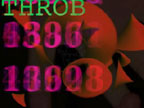
Translocal Exchanges
Interfacing/Radiotopia/KeyWorx consists of one space that has no images and has only sound, and one space that has no sound and only images. They are connected both physically and via the Internet.
SPACE 1: [Radiotopia] Walk into a theatre and enter an audio space with no images. Artists from all over the world are asked to send in audio material to fill up a database. Behind every sound is an idea, a world of words and definitions. The one big experience with Radiotopia is the peaceful confrontation of all the world's sounds, audio artists, concepts, sights and sometimes ideologies. In the Scapino theatre, the sound is mixed live by musicians and resent as an audio stream.
SPACE 2: [KeyWorx] Walk out of the theatre, down a narrow hallway and enter a space filled with images. Three artists sitting in the space, are connected with three artists in New York City. Three translocally linked pairs, three simultaneous and connected performances.
Behind every sound is an idea, a world of words and definitions. In the KeyWorx space, one listens to the world of words within the audio–spoken words, ideas, emotions, memories–and translates that world into actual text.
Inspired by a Surrealist game 'Parallel Stories', a word sent by performer or public from a mobile phone in response to the audio appears simultaneously in all three performances. Each performance pair responds to this foreign text input sent via 'sms' by creating a visual story around it. Three parallel translocal exchanges within one physical space (a room in New York, the V2 bookstore) are connected by the same word yet are unique in the visual interpretation of it. The performance is improvised and created collaboratively in real-time.
These compositions are projected onto the screens throughout the V2 space.
Want to know how we put this performance together? Follow the process log.
Credits: Concept KeyWorx Space: Isabelle Jenniches and Michelle Teran with Sher Doruff • KeyWorx performers: Isabelle Jenniches, Arjen Keesmaat, Lodewijk Loos, Eric Redlinger, Michelle Teran, Dan Vatsky
• Radiotopia project created by: Rupert Huber, August Black and Norbert Math KeyWprx project created by: Waag Society for Old and New Media.
Posted by jo at 11:57 AM | Comments (0)
2.4_interference_interaction
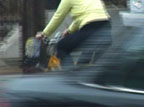
Interaction Defined by Interference
2.4_interference_interaction by Michelle Teran: A wireless, networked play space is constructed from cameras, bikes and public monitors in stores, banks and cafes. The movement and flow of an urban environment is captured and transmitted by wireless cameras connected to moving bicycles. The interaction and interference of flow when travelling through the city is visualized and broadcasted from television sets at local businesses, blurring the boundaries between interior and exterior spaces.
The cameras transmit wirelessly on the same frequency and interfere with each other. This collision of radio waves translates into distorted and volatile real-time editing of video and audio viewable on a monitor within range. Interaction is defined by interference. Either entering as a cyclist or non-cyclist, the public becomes engaged with a network where negotiations between people and hardware, cross signals culminates in a continuous spatial-temporal state of change.
Posted by jo at 11:50 AM | Comments (0)
June 06, 2005
Intimate Transactions
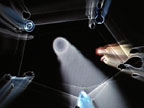
Sensory Intimacy Across Time and Space
Intimate Transactions--by The Transmute Collective--is a new type of interactive installation that allows two people located in separate spaces to interact simultaneously using only their bodies. Each participant uses a physical interface called a ‘Bodyshelf’. By gently moving their bodies on this ‘smart furniture’ they instigate ‘Intimate Transactions’, which influence an evolving ‘world’ created from digital imagery, multichannel sound and tactile feedback. This shared experience allows each participant to gradually develop a form of sensory intimacy with the other, despite the fact that they are geographically separated and cannot physically see or hear each other. As this highly immersive experience evolves, each participant begins to sense their part in a complex web of relations that connect them, and everything else within the work. In this way a subtle, indirect form of collaboration develops via an increasing sense of intimacy between sites.
Participants may choose to act in different ways as they begin to understand how their actions affect everything within the environment AND the other Participant. Hence the work focuses participants upon understanding influences and relationships within the work's ecologies.
Intimate Transactions was awarded an Honorary Mention in the 2005 Prix Ars Electronica Competition. It will next be shown in Sept 2005 at the Ars Electronic Festival, Austria and in October 2005 at the Institute of Contemporary Arts, London.
Posted by jo at 11:03 AM | Comments (0)
May 30, 2005
Parsons School of Design: Design & Technology Thesis Exhibition
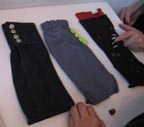
DT Saved My Soul
This past Wednesday was the opening for the Design & Technology Thesis Exhibition at the Parsons School of Design in New York City. The exhibit featured amazing thesis projects from both the MFA and BFA students in the department. It provides a chance to check out work and artists that have been mentioned elsewhere, such as Lina Fenequito’s Swap-O-Matic and fi5e’s Graffiti Analysis.
However it also provides an opportunity to check out new brilliant projects of those less known to the blog sphere media circuit. Discreet Interfaces, by Kaho Abe, explores the idea of wearable technology. By imbedding switches in the sleeves and hiding them with simple buttons or tags, the user can navigate the controls of a portable electronic device discretely without drawing any attention to themselves (well… other than that of someone who fidgets incessantly). Continue reading >> [blogged by Carol T. Chung on cool hunting]
Posted by jo at 12:37 PM | Comments (0)
May 22, 2005
Voice Mosaic
![]()
Turbulence Spotlight
Voice Mosaic--Martha Carrer Cruz Gabriel--is a web-art application that converges speech and image, building a visual mosaic on the web with the chosen colors and recorded voices of people who interact with it from any place around the globe. The voice interface, developed with open-standards in speech synthesis and voice recognition technologies, works through phone calls from any telephone.
Martha Carrer Cruz Gabriel is Director of Technology at NMD Internet & Multimedia, Ltd. - developers of several successful websites in Brazil, like HBO's, Sony's, and Warner Bros' television channels and Monica's Gang - winner of 9 Internet Best Awards in Brazil since 1998. She is Professor of 'New Technologies' and 'Marketing' at Universidade Anhembi Morumbi; International technical advisor in US for AllHealthNet.com; and a frequent speaker at Internet conferences in Brazil and the US. Engineer, postgraduate in Marketing and Graphics Design, she is currently pursuing her Master's degree in Multimedia at ECA/USP, focusing on man/machine interfaces.
For more Turbulence Spotlights, see >>
Posted by jo at 12:01 PM | Comments (0)
May 19, 2005
Playable Media and Textual Instruments

This is Not a Game
"The statement that "this is not a game" has been employed in many ways — for example, to distinguish between high and low culture electronic texts, to market an immersive game meant to break the "magic circle" that separates games from the rest of life, to demarcate play experiences (digital or otherwise) that fall outside formal game definitions, and to distinguish between computer games and other forms of digital entertainment. This essay does not seek to praise some uses of this maneuver and condemn others. Rather, it simply points out that we are attempting to discuss a number of things that we play (and create for play) but that are arguably not games. Calling our experiences "interactive" would perhaps be accurate, but overly broad. An alternative — "playable" — is proposed, considered less as a category than as a quality that manifests in different ways. "Playable media" may be an appropriate way to discuss both games and the "not games" mentioned earlier.
The impetus for coming to this term was not a love of terminology, but the author’s need as an artist to situate a set of experiments in creating "instrumental texts" and "textual instruments" within an appropriate context. While it doesn't make sense to discuss all of these experiments as games, what distinguishes them from other electronic texts is their playability — both that they can be usefully considered as playable, and their particular structures of play. This essay discusses, particularly, two "textual instruments" recently constructed by the author in collaboration with David Durand, Brion Moss, and Elaine Froehlich. While both of these instruments operate according to the logic of n-grams (as first used in textual play by Claude Shannon), one instrument is designed to play with known local texts while the other is designed to employ the contents of network RSS feeds and web pages. One composition for each of these instruments — Regime Change and News Reader, respectively — is considered." Read Playable Media and Textual Instruments by Noah Wardrip-Fruin, Dichtung-Digital, Issue 1, 2005
Posted by jo at 10:09 AM | Comments (0)
May 16, 2005
BlogStarTheater
![]()
Remaking Other Peoples' Blogs
BlogStarTheater is a weekly web show in which people create theatrical reinterpretations of strangers' blog entries, in video format. Anyone can produce and submit an episode, and every blog is a potential source of material. The project, an experiment in participatory mass media, is a show by everyone, for everyone, and about everyone. It was created at the Interactive Telecommunications Program, NYU, by Laura Garcia-Barrio, John Geraci, Luna Vega, Pete Vigeant, and Akio Wada. The idea is to examine the tension between blogging as a form of public diary versus blogging as a form of broadcast media. [via]
Posted by jo at 11:45 AM | Comments (0)
May 03, 2005
Scream
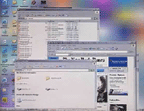
The Lost Art of Screaming
Scream is a software application to facilitate screaming. Scream sits quietly in your computer's system tray and automatically springs into action when it detects a scream. Scream disturbs your Windows interface. But it isn't aimed just at computer frustrations. In a world where "anger" is paired with "management," Scream encourages the return to prominence of the lost art of screaming. As Howard Beale said in 1976, "I don't have to tell you things are bad.... all I know is that first you've got to get mad."
But whereas Howard advised his viewers to turn their television sets off to get mad, Scream proposes that you leave your computer on. Scream can be used in private. Or public. It can be used at home, at work, or on the street; at a Fluxus-style Scream-in; at the mall or at your favorite cafe. When your throat gets tired, Scream can double as an unusual music visualizer - or as a new approach to digital filmmaking. Use Scream to start a meme. Or simply as a random act of deprogramming. Try this (RealMedia)
Scream - The Screaming Enhancer. (Also indicated for use with door slams, domestic disputes, and police helicopters.) More info, demo movies, software download and more at: http://scream.deprogramming.us
For more Deprogramming software, VJ/musical performances, and more(?) visit the deprogramming.us homepage.
Posted by jo at 03:42 PM | Comments (0)
April 29, 2005
The Telepathic Table
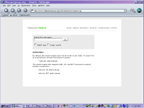
Step 1: Select a Table
16 Beaver Group was invited to be part of Version<05 in Chicago. We will be given a table at the Zhou B. Center (Chicago) between 12:00pm and 8:00pm on Saturday April 30th and May 1st.
While we've tried to deal with placing representative objects on display, whether it is a wall, a table, or a pedestal, it is very difficult, if not impossible, to 'represent' what we do. Instead, we insist on ‘activating’ the social environment to which we’ve been invited. So having been offered this table has now triggered the following kinds of questions: How are tables social and political objects? How can this social aspect be enacted, rather than represented? What can we all do with a table, to fully take advantage of its potential? Are tables used for the same things in different cities around the world? What is the significance of tables in the date of May 1st?
We are also aware that events like Version<05, as well as the World Social Forum, or more specifically art oriented endeavors, such as the growing number of international Biennials, are based on the assumption that people need to be physically present in one place at the same time. This creates a big conflict with the reality of art budgets, which are hardly sufficient to provide for a basic living. Needless to say, the idea of travelling around the world on this budget seems impossible, especially for alternative initiatives and artist run spaces. So, very much like we’ve done in the past with projects like ‘The International Lunchtime Summit (2003, in 21 cities around the world), we are now telling everyone who is interested in art, politics, and social change, that they don’t have to move from where they are. You can join the Telepathic Table, and be with us all, in different places, at the same time.
1. How it works and how you can join, wherever you are.
- Select a table in your town or city, invite some people to do something with it at any time this coming Sunday, May 1st. What you do, and what you call it may or may not have anything to do with the questions or ideas listed above. What you do on May 1st can be the first gesture toward a table project you can develop for two weeks after that. We will collect materials related to all table projects between May 2nd and May 15th, and then put them all up, organized by city at: http://www.16beavergroup.org/chicago
The webpage will be up on the night of May 15th.
These are the kinds of materials we’d love to put up related to your project:
- Take a photograph of the table when your gathering begins, and one when it ends (Note that your table may be a cloth, if it’s a picnic, or many other things)
- Any texts, images, or ideas that can be emailed, produced on May 1st or afterwards (May 2nd to May 15th ) related to your table or the ideas above.
- A list of participants, title of project if there is one, and any urls that might be good to put up for more information on participants.
Email all materials gradually or in one big bunch to: peterlasch(at)16beavergroup.org
You don’t need to contact us before May 1st. Just do something with other people at a table, think telepathically, politcally, artistically, and send us the results after it happens! We’ll put it all up.
2. Local contacts and information for your city (so far Arhus, Baltimore, Chicago, New York, more coming)
Go ahead and add your own group/table/project and let us know what happened after you do it. You can also join one of the following if you’re in NY, Arhus, Chicago or Baltimore. See the details or email the contact person for info.
Aarhus, Denmark – at - rum46
Contact: rum46(at)rum46.dk
Baltimore, USA - at The Contemporary Museum- Patriot
Contact: Jesal Kapadia: jesalkapadia(at)hotmail.com
Chicago, USA (Sunday, May 1st – 1:00pm – 4:00pm)
- 16Beaver, Red76, Mess Hall, Polvo, Temporary Services, Chiapas Media Project, subRosa, others (not all participants are confirmed)
Contact: Peter Lasch: peterlasch(at)16beavergroup.org
We will gather at 1:00pm at the 16Beaver Table at the NFO Expo, work on tables and then literally carry our table into the Chat Room for a discussion on Alternative Spaces in the same building (Zhou B. Center) at 2:30pm. Everyone is invited, and no need to stay the whole time. You can drop in and out as you wish.
New York, USA (May 1st -- Washington Square Park, 2:00pm-4:00pm)
16Beaver, Reverend Billy, many more
Contact: Ayreen Anastas: everytime(at)16beavergroup.org
We’re joining the Rally at Washington Square Park, against the redesign / privatization / fencification of the park. We’ll meet under the Arch at 2:00pm.
See the info online at: http://www.openwsp.com/user/may1alert.htm
Please sign the online petition if you like.
A table in the park is a table cloth mostly and it can be used as a rally
banner as well as a picnic cloth. We’ll do both at different times. Bring
your banner. Bring your table.
Eat and scream.
Posted by jo at 10:35 AM | Comments (0)
April 27, 2005
Art-Domains
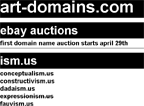
Connecting The Public Domain to the Artworld
Art-Domains, by Peter Luining, is a project that brings internet domain trade to an art context, thus penetrating the space of the white cube with one of the most lucrative virtual money making businesses, that of selling domainnames. For this particular project Peter Luining did over one year of research and became a domain broker himself. He bought and sold domain names to get the knowledge of how this trade works and also to get the best art related names available. Over the last year Luining aquired domain names like clementgreenberg.com, artcriticism.org, marcelduchamp.info, whitecube.us, etc. The Art-Domains stand Luining will present at Art Frankfurt will connect virtual to real space and the public domain of trade to the artworld. At the moment Luining owns about 200 art related domain names that will be offered for the first time for sale at Art Frankfurt. Starting April 29th, art names will be offered for auction at eBay.
For his presentation of Art-Domains Luining uses Mel Bochner's "Working Drawings And Other Visible Things On Paper Not Necessarily Meant To Be Viewed As Art." (1966) as a basis. Bochner's presentation used photocopies and contained ephemeri of "non- art" sources, which were put in identical ring binders and displayed on standard white plinths. Whereas Bochner used new materials to display the creative process over it's results, Luining uses Bochner's classical presentation method (use of standard office techniques i.e. laser prints of webpages) to connect virtual selling strategies with the institutional artworld in a low tech manner.
Posted by jo at 03:03 PM | Comments (0)
April 26, 2005
Video Conferencing Software as a Performance Medium

Is There No There There?
"ABSTRACT: This paper surveys past performances in which the author collaborated with several other dancers, musicians, and media artists to present synchronized co-located performances at two or more sites. This work grew out of the author's participation in the landmark computer music ensemble, "the HUB". Each of the various performances were made possible by an evolving array of video conferencing hardware and software. These will be discussed. The problems and interesting side effects presented by latency and dropouts are a unique part of this performance practice. Leveraging the concepts of shared space, video and audio feedback generate evolving forms created by the combinations of the space, sounds and movements of the participants. The ubiquity of broadband Internet connections and the integration and constant improvement of video conferencing software in modern operating systems, makes this unique mode of performance and essential area of research and development in new media performance." From Video Conferencing Software as a Performance Medium by Scot Gresham-Lancaster.
Posted by jo at 10:31 AM | Comments (0)
April 20, 2005
9PIN

Mapping the SCAN Community
In summer 2003, a call for artists was sent out for the project 9PIN. The call asked artists to respond to the (then) 9 geographical locations occupied by the consortium members of SCAN. Proposals were submitted for a series of residencies and commissions looking at the possibilities for networking and mapping in the SCAN community. James Coupe, Hedley Roberts and Rob Saunders, Hywel Davies, Armin Medosch and Ivan Pope were chosen because of their range of inventive approaches to the SCAN network.
From Armin Medosch’s data visualisation research starting with a comparison between real and virtual ports through to Hywel Davies’ compilation of a sound database, gathered from each of the consortium venues, for the composition of new material by both himself and other musicians and composers, each of the artists involved in 9PIN makes a significant contribution to their own areas of practice and dissemination of content, whilst helping SCAN to cohere a very disparate group of organisations brought together by their desire to collaborate on high quality experimental work.
Ivan Pope brings his sketches and ideas using GPS, to enhance his interest in psychogeography, to his workshops, while James Coupe and Hedley Roberts take on the difficult task of examining and building an intelligent system which reflects activity (data drawn from sensors installed at SCAN’s member organisations) at each venue in the SCAN network.
The 9PIN project is premised on research and development and brings together artists and makers who are at the forefront of their field. This is a flagship project for SCAN and sets a precedent for the organisation’s aspiration to facilitate an environment for practitioners to develop their process outside of other areas of institutional research whilst working towards high quality outputs for the SCAN network.
SCAN is the innovative new media arts agency in the south of England. As a network of organisations, SCAN is committed to the delivery and facilitation of collaborative works.
"SCAN presents a unique model of networking across a number of diverse arts organisations in the south of England. We commissioned the 9PIN project to explore the network and build a model for SCAN as a whole. We invited artists with an interest in data analysis and mapping to produce a body of high quality work. They have come up with some extremely creative interpretations of the commonalities and differences across the organisations in the network"- Helen Sloan, Director of SCAN
The aim of 9PIN was that each artist should make a significant contribution to their own area of practice, whilst helping SCAN to make connections between the disparate group of organisations that constitute the SCAN network. 9PIN is a flagship project for SCAN and sets a precedent for the organisation’s aspiration to facilitate an environment for practitioners to develop their process outside of other areas of institutional research whilst providing high quality outputs for the SCAN network.
Posted by jo at 09:50 AM | Comments (0)
April 15, 2005
Urban Eyes
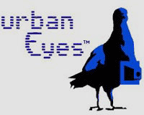
A Bird's Eyeview Experience to the Urban Public
Urban Eyes--by Martin Buschle, Marcus Kirsch, Jussi Ängeslev--is a service combining 2 natural networks, the CCTV and the pigeon population in a city to provide an alternative view on the city. Similar to shamanistic journey, a bond between human and an animal is created when one feeds the pigeon with Urban Eyes bird seed. When the bird flies about, the seed triggers the CCTV / webcam network in a city based on its proximity to the camera. The images are then sent to the person (his PDA) who fed the bird creating a story about the bird and the city.
Due to the purpose of the camera network, the view one perceives, is quite different from the market orientated, everyday media exposure. Ranging from traffic cameras on the lamp posts to gate cams to back yards and living rooms. The experience is essentially about being connected to the bird, the way it experiences the common living circles. Hence acquiring the data, the images and videos directly from the net would be utterly different experience, lacking the physical connection to one's environment and its inhabitants." [blogged by Martin Rieser on Mobile Audience]
Posted by jo at 09:40 AM | Comments (0)
April 14, 2005
Kings X Phone In

Musical Intervention
"During the day of Friday 5th August 1994 the telephone booth area behind the destination board at kings X British Rail station will be borrowed and used for a temporary cybercafe. It would be good to concentrate activity around 18:00 GMT, but play as you will." [see Heath Bunting's King's X Phone In]
"The calls "created a musical intervention that disrupted the daily routine of an urban transportation hub, as commuters circulating through the station chatted with strangers from around the world … public space was reconfigured aurally and socially."" From Heath Bunting's Kings Cross Phone-In and Lyotardian Disruptions by Jeff Lee
Posted by jo at 08:23 PM | Comments (0)
April 13, 2005
PUBLIC TRANSPHERE
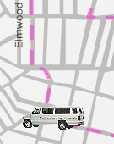
A Two-Way Mobile Communication Solution
Public Transphere is a free public transportation service for passengers from different parts of the city. Riders are encouraged to discuss their everyday realities, share opinions and exchange concerns about their communities. The event aims to bring residents of Buffalo together on an itinerant free speech platform, creating a nomadic, convivial environment in which they can converse about the communal experience of living in Buffalo.
Jesse Fabian imbues the vehicle with a small amount of self-awareness through sensation and self-localization. Through its many eyes, ears, its mechanical and electronic self-analysis, its data links, and its sensitivity to space, the vehicle assembles elements to form a picture of its whole self. The vehicle is reactive to its environment and its occupants. It participates in the journey as its passengers do.
Paul Visco will be manipulating live data collected by Jesse Fabian en route and enabling the public to explore these images, audio streams and GPS data feeds at http://www.public-transphere.info. At this site, the public will also be able to communicate live with the participants in the Public Transphere project, creating a unique two-way mobile communication solution during the event.
Public Transphere will be a two-day public event, taking place in a van touring three Buffalo neighborhoods: Allentown, the Buffalo Niagara Medical Campus and the Fruit Belt. The bus will be traveling among these three areas on Saturday, April 23 and Sunday, April 24 between the hours of 11:00AM and 2:00PM and from 3:00PM until 7:00PM.
Date: Sat. & Sun., April 23 and 24
Time: 11:00AM – 2:00PM, 3:00AM – 7:00PM
Place: Allentown, Buffalo Niagara Medical Campus, Fruit Belt
Cost: Free and Open to the Public
Contact: Arzu Ozkal Telhan at ao9 @ buffalo.edu and 716 - 400 6728
Public Transphere is the thesis project of Arzu Ozkal Telhan, an MFA candidate in the Art Department at University at Buffalo. Arzu Ozkal Telhan, Minoo Amini (UB, Center for Urban Studies), Jesse Fabian (UB, The Department of Media Study) and Paul Visco (UB, The Department of Media Study) are collaborating on this project.
Posted by jo at 10:45 AM | Comments (0)
April 11, 2005
What's Eating Gilbert and Grape?
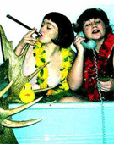
An Epic Voyage
"Courtship between two periods in history customarily leads to each sharing the other's things, like tastes for fashion, art and home decor. But, perhaps it is the impossibly bridged distance between flirting times and aesthetics that keeps history perpetually romancing itself. GilbertandGrape (hopefully their singing namesakes would enjoy being conflated with a Leonardo DiCaprio movie) are two New Europeans who describe their art practice as 'performance journalism.' Helen Pritchard (UK) and Anne-Marte Eidseth Rygh (Norway) have set out on a stubborn three-year journey called 'Lone Ranging Romance,' during which they will travel by Volvo through their homelands, with an iconic 20-kilo moose head, conducting interviews around the subject of nostalgia with the ‘heroes’ they meet along their way.
These found respondents will be subsequently mythologized into the epic voyage, and the interviews will be posted to GilbertandGrape’s blog every second Thursday of the month. 'Lone Ranging Romance' will conclude when the aforementioned moose head, 'The Lone Ranger,' reaches Nordkapp, Norway, 'where the midnight sun never sets.' This will occur in 2008, timed with the UK and Norway each hosting European Capitals of Culture, and thus becoming sites for historic and arbitrary convergence." - Kevin McGarry, Net Art News, Rhizome. Related [1] [2] [3]
Posted by jo at 09:20 AM | Comments (0)
April 07, 2005
cell.SPACE
![cellFREE[1].gif](http://www.turbulence.org/blog/images/cellFREE[1].gif)
freeSTYLE
Dana Karwas' cell.SPACE application allows users to make a short live music video using SMS as lyrics and camera phone pictures as graphics. Users can send text and picture messages from their mobile phone to the freeSTYLE and have their written text messages show up on the screen with a voice accompanying the text. Simultaneously a hip hop instrumental is creating and guiding the voice and graphics so the text becomes the lyrics and the pictures from the phones form the graphics.
The application has 21 different voices to choose from including male, female, creature, robot, and even human laughter. Instead of just being read back to the user, the voice is controlled by the beat of the music. [Video] The work will be at the Interactive Multimedia Culture Expo, on April 14th - 23rd, at the Chelsea Art Museum, in New York. [blogged by Regine on near near future]
Posted by jo at 05:43 PM | Comments (0)
Social Residue
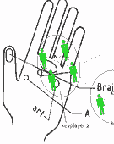
Online/Offline Hybridity
Social Residue--by Hyunjoo Oh and Noah Shibley--is a project that explores the relationship of online/offline hybridity to social connectivity, the mapping of complex social growth and the spread of ‘memes,’ that are brought and transmitted by artists and audiences during the show. By using a nontoxic invisible contamination simulation powder, Noah & Hyunjoo creates a gesture and organizational logic of mapping and cartographic spread vectors of social networks that develop during the show.
During the transmission process, there are many different kinds of social interaction involved consequentially or inconsequentially. It symbolizes that artists and audiences’ ‘presence’ and participation as performers whether they know or not. As a result of this performance, the visual map of spread vector will show the a multilayered spectrum of physical/virtual or online/offline networked systems through which social interaction is taking place in real time. [via Rhizome]
[d.t.t.e.d.q.u.a.d] a new media artist, technologist group that is co-founded by noah shibely / hyunjoo oh in 2002. Their works involve Virtual Reality, interactive storytelling, surveillance technology, improvisational network sounds, cartographic sciences, distributed social softwares, kinetics, database art and Networked sound synthesis. They are currently working on several virtual reality projects, such as Inside/Outside System II and Nodule Resonance and had joined the post-production team of the Chicago Millennium Park Fountain Project. Noah and Hyunjoo's work has been shown in Versionfest>04 (Chicago, IL), IMMEDIA (Ann Arbor, MI), OpenEnd Art, Polvo, Buddy, 1926 gallery and Chicago Tourist Center (Chicago, IL). Hyunjoo holds a B.F.A (2002) in Philosophy and Art Education from the SungKyunKwan University in Seoul, Korea and M.F.A (2005) in Art and Technology studies at the School of the Art Institute of Chicago. Noah received a BFA degree in Art & technology studies at the School of the Art Institute of Chicago and is currently in the graduate studies, Interactive Telecommunication Program (ITP) at the New York University.
Posted by jo at 04:49 PM | Comments (0)
March 31, 2005
Can You See Me Now in April

Blast Theory performs again their first hybrid reality game
Can You See Me Now?, the hybrid reality game developed by U.K.'s group Blast Theory and Nottingham University's Mixed Reality Lab will be perfomed twice this upcoming month of April in Cambridge, U.K. People from all over the world are able to play online on the virtual streets of Cambridge against Blast Theory's runners on the real city streets. To participate, you need to log-in to the game's website (Can You See Me Now) on April 1-3 from 2-5pm (GMT) or on April 6-8 from 4-7pm (GMT). A more extensive explanation of the game can be found at the same website.
Posted by at 07:39 PM | Comments (0)
March 30, 2005
Networked Multi-sensory Experiences:
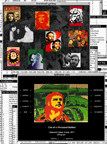
Beyond Browsers on the Web and in the Museum
"Abstract: The defining characteristic of the digital era is the potential that it brings for “real-time” interconnection between anything that can be measured, expressed, or controlled digitally. The World Wide Web stems from one type of digital interconnection: well-defined standards linking a “browser” with remote machines presenting information to be browsed. Yet digital technology enables more than just new approaches to presentation, browsing, and searching. It can create dynamic connections between different physical spaces and across sensory boundaries, and provide experiential interfaces for interaction that move beyond the mouse, keyboard, and screen. It can relate the physical space of the museum to the virtual space of the Web for both individual and group experiences." From Networked Multi-sensory Experiences: Beyond Browsers on the Web and in the Museum by Fabian Wagmister and Jeff Burke.
Posted by jo at 08:30 AM | Comments (0)
Phonic Frequencies:
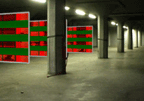
Shaping Networked Realities
ABSTRACT: The paper introduces a networked multi-user installation and interactive mixed reality environment that combines the fields of interactive art, telecommunication and streaming technologies. Phonic Frequencies is an audiovisual data space whose appearance can be altered via networked communication devices. Visitors are active agents and participate in shaping spaces as they control audiovisual data with their telephones.
Linking the physical space to the digital network space, Phonic Frequencies opens a hybrid reality for distributed sound exchange and visual communication, blurring the boundaries between verbal communication and digital information. The work attempts to break the conventional communication cycle of bidirectional dialogue and to consider the meaning of in- and output from a different perspective." From Phonic Frequencies: Shaping Networked Realities by Tamas Szakal, Christoph Groenegress, Wolfgang Strauss, Predrag Peranovic (c) 2003
Posted by jo at 07:40 AM | Comments (0)
March 29, 2005
DIALTONE

Teleinteractive Net Audio Experiment
DIALTONE is a net audio installation exposing the physical and virtual space of the internet and attempting to open this hybrid space for sounds, noises and words by using simple telecommunication instruments like telephones and answering machines. This audio interface between telephone network and internet explores how interaction and compression changes audio in a network. The installation connects the venue to our telecommunication network through sound and vision.
Posted by jo at 03:01 PM | Comments (0)
Switch Interview with Victoria Vesna
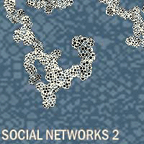
Extending Our Influence Beyond Our Local Spaces
"Inna Razumova: The Web is an ephemeral, virtual medium that is associated with the mobility, manipulability, and transformation of data. Web is also one of this culture's primary places for a fetishization of the body. (spy cams, pornography, dating networks, avatar-based chat rooms, etc.). In your opinion, why is a medium that functions mostly through disembodiment so fascinated with the idea of body?
Victoria Vesna: It is because our bodies do not only consist of embodied, physical parts and our minds are not separate from our bodies and we are not separate identities. I do not consider this an opposition (idea of body/disembodiement), but a return to learning that we have etheric bodies, and can make telepathic connections to others on the other side of the planet. It is very empowering to have a sense of connection to someone who shares your ideas, whatever they may be, and feel a physical sensation in relation to this...The Internet provides a space for exploring our many identities, and experimenting with ideas of extending our influence beyond our local spaces." From Interview with Victoria Vesna by Inna Razumova, May 15 2001, Switch, Issue 16.
Posted by jo at 02:11 PM | Comments (0)
Liquid Gold
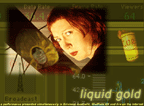
An Artery of Liveness
Liquid Gold--by the Transmute Collective--was a live performance event that spanned the globe, using the Internet to link several sites and audiences into one entire 'net-worked' performance. It consisted of several intensely quirky performances, accurately coordinated across multiple time zones. Liquid Gold demonstrated a new kind of net-work, using the Internet as the artery that spreads a new performance experience of networked 'liveness' across the world.
Liquid Gold brought together filmmakers, artists, musicians, network specialists and writers to make a new work of live art both in real space and throughout the global electro-o-sphere. It employed a custom built chat server ('idea animator'), running in the physical live venues and on all Internet located audience's browsers. This allowed writers in both Australia and England to describe what they saw locally in their own performance venue - putting back some of the 'liveness' lost through the lo-fi images and sounds the web currently allows.
Liquid Gold used its novel approaches to present one woman's journey of reconciliation - a trip that will allow her to reconcile the ghosts of her chequered past and travel towards the new futures that her vivid imagination are now making possible.
Performer Lisa O’ Neill, in the persona of adventurer and strong woman 'Ling Change', was filmed live on video as she traveled throughout the stunning internal landscapes of the Brisbane Powerhouse Centre for the Live Arts, an old industrial site now converted into a major arts complex.
Her journey proceeded from the depths of the 'turbine room' and finished in the dramatically patterned glass of the main atrium.
Video imagery of this journey was streamed live across the Internet to Site Gallery, Sheffield, England. There an assembled audience watched as Keith Armstrong directed the work, mixing the Australian streamed vision with further performance vision and audio, unfolding a bizarre narrative which developed in real time between the live and pre-edited footage.
The two steams of video (From Brisbane, Australia and Sheffield, England) were projected upon adjacent screens in both the physical spaces, with the audiences 'editing' their own performance from these two images.
The work was webcast live for online audiences and incorporated a custom interactive chat facility, called an 'idea animator'.
LIVE WEB CAST: The live webcast showed prerecorded footage of the main character ('Ling Change', performed by Lisa O'Neill) traveling through animated landscapes mixed live with the images from the live performance in Brisbane. This mix was undertaken by the show's artistic director Keith Armstrong in Sheffield. All original sound for the show was composed by Guy Webster.
These dual narratives showed Ling's journeys in some past time, and now in the present, as she moved through strange industrial landscapes. (filmed live in the striking industrial interiors of the Brisbane Powerhouse). Hence audiences were asked to construct the narrative online, as the characters' actions shifted from virtual to actual architectures"
Online viewers with high specification machines and plenty of bandwidth could enjoy the luxury of participating in both the video stream and interactive chat dialogue, whilst also surfing background information. The video stream was kept as minimal as possible to avoid excluding other users on slower computer systems.
IDEA ANIMATOR: The 'liveness' of this work, particularly for the web-based audiences, was enhanced by a idea/animator/custom chat server which allowed two writers, situated both in Brisbane and Sheffield, to comment in real time upon their impressions of the performance as they saw it evolving in their respective venue.
The writers at each physical venue referenced performers, imagery, audience, environment and global communication. Remote viewers, and those present at each venue, watched the writers words appear in real time on their screens alongside the performance imagery. Throughout this poetic dialogue key words/ideas were extracted from each writer's texts and became animated upon a large projection screen.
This idea animator software, designed and constructed by Gavin Sade, allowed keywords and ideas to float onto the screen and animate.
When online users logged in their presence was seen by all those also logged via the Internet along with those audiences present at the two live venues. Online users could participate by selecting words already animating on the screen by clicking upon them... this caused the ideas/words to regroup and grow according to the online audience interactions. [Related]
Posted by jo at 12:17 PM | Comments (0)
March 25, 2005
Eliza Redux

A Robot Who Talks Too Much
Eliza Redux--by Adrianne Wortzel--is an interactive telerobotic web site providing a space for text-to-speech and oral discourse, acting out, and playfulness in the virtual environment of a psychoanalyst's waiting room and inner office. Video and audio of a real physical robot is streamed to the web reactive to visitor text input. Issues of control and lack of control become paramount for the user. Wortzel is implementing ways to bring Weizenbaum's original 1966 ELIZA program into the 21st century.
Wortzel is seeking a computer science professional or student in the New York City area who can lend his/her skills to an internet-broadcast robotic art installation. She is looking for a developer to facilitate communication between clients running flash applications, a server database, and an extremely talkative robot.
Job Requirements:
- SKILLED DEVELOPER in jsp, flash, xml.
- Be able to learn a pre-existing set of commands from the robot control interface.
Ideally, you will also
- Have understanding of database retrieval & modification
- Patiently explain technology needed to execute high-level art ideas
- Be willing to troubleshoot & debug until things work right, everything from web-cams to multiple socket connections.
Job length: Immediate start, completion deadline -end of May.
You will receive at the very least a $500 stipend, and experience/credit in a robotic art installation bound for gallery showing. An article about the project is coming out in the June issue of the prestigious Journal: Leonardo. Plus, you'll get to work in a tech-decked paradise lab with fun people and an even more fun humanoid robot. Even if you don't have all the skills outlined above, we're very interested in hearing from people who are enthusiastic & quick at learning. To apply, contact Prof. Adrianne Wortzel at muse(at)cooper.edu or cell: 646-567-9648
Posted by jo at 01:19 PM | Comments (0)
March 24, 2005
John D. Mitchell + ADaPT
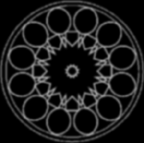
Expanding Sensory and Creative Experiences
John D. Mitchell is a multi-disciplinary composer, educator and researcher committed to using technology for expanding sensory and creative experiences in the arts and education. He has worked with artists from around the world to design and realize projects ranging from multimedia dance archives to interactive multi-site distributed performances.
ADaPT, initiated in December 1999, was the brain child of Mitchell while working under the auspices of the Institute for Studies in the Arts at Arizona State University. ADaPT originally included researchers and information technology specialists from five institutions: Arizona State University, The Ohio State University, The University of California, Irvine, The University of Utah, and The University of Wisconsin, Madison. Over the years ADaPT has expanded to include partners in other countries on four continents.
In 1987, Mitchell and choreographer Gary Lund created Movement Initiated Sound Events (MISE), one of the earliest dance works to use a personal computer and optical sensors for creating a completely interactive, performer driven sound score. Over the next three-years Mitchell and Lund produced several dance-driven, interactive multimedia works for the stage, often collaborating with visual artists and live musicians.
Upon joining Arizona State University in 1990 Mitchell became a founding member of the Institute for Studies in the Arts. At the Institute, Mitchell was instrumental in pioneering the development of the Intelligent Stage – both as a concept and a facility – where he continued to work for the next ten years as a composer, director and interactive media designer. Mitchell has collaborated with numerous artists to create performance works that have been staged throughout United States and abroad.
Mitchell currently directs the graduate emphasis in Dance and Technology and teaches interdisciplinary media and telematics courses in the Department of Dance at Arizona State University. See Using Human Movement to Control Activities in Theatrical Environments by Robb E. Lovell and John D. Mitchell.
Posted by jo at 12:56 PM | Comments (0)
March 22, 2005
eBay: VIDEO outsider art burka guido-catherine
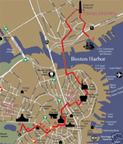
Burka on Freedom Trail
Subject: Burka on Freedom Trail
"You are bidding for me to walk the Freedom Trail in Boston wearing a burka and bunny ears. Winner will receive a video and 3 photographs documenting this event."
Current bid: US $0.99; Time left: 4 days 17 hours
[Related]
Posted by jo at 06:05 PM | Comments (0)
March 18, 2005
This Text Has Legs
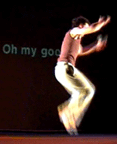
SMS >> Physical Poetry
Theatre etiquette states that mobile phones should be turned off before a show begins, but this new production by C!RCA embraces the intrusive technology. Blending physical theatre, acrobatics and circus tricks, This Text Has Legs is the local circus troupe's most interactive show to date.
Described as a circus show for the communications age, This Text Has Legs has audience members send SMS messages to a large, on stage projection screen. Relying on their improvisation skills, the C!RCA troupe then turn the messages into physical poetry. Guest experimental musicians Lawrence English and Zane Trow weave live sound into the performance and add to the information exchange between audience and performers.
Audiences who are sceptical about a show which relies on live texting should think again. This Text Has Legs premiered last year as part of C!RCA experimental One Night Stands series and it evolved into a full season thanks to the audience's overwhelming response.
Formerly known as Rock'n'Roll Circus, C!RCA is Brisbane's leading post-modern circus troupe. This Text Has Legs is C!RCA first show for its 2005 season, which will feature the troupe's usual modern take on traditional circus skills as well as performances that embrace improvisation, multimedia and experimentation. [PLAY MOVIE [2.3MB] Windows Media] [via creativity/machine]
Posted by jo at 03:34 PM | Comments (0)
March 15, 2005
IN Network

Sleep Webcast
April 15, 2005: From their bedtime at 11PM in Los Angeles, and 2AM in New York, until they wake eight hours later, the artists Michael Mandiberg and Julia Steinmetz will sleep together on the phone. Separated by three time zones and 3000 miles, they curl up in the same sonic space. Connected via cell phone, they will hear the sound of each other breathing, tossing and turning, snoring, etc. This audio will be webcast in real-time as they sleep.
IN Network Sleep Webcast Schedule:
Tuesday, April 15th, roughly 11PM PST to Wednesday, April 16th, roughly 7:30AM PST; Wednesday, April 16th, roughly 9PM PST to Thurs, April 17th, roughly 5:30AM PST; Tuesday, April 22nd, roughly 11PM PST to Wednesday, April 23rd, roughly 7:30AM PST; Wednesday, April 23rd, roughly 9PM PST to Thurs, April 24th, roughly 5:30AM PST
This sleep webcast is part of IN Network their month long extended cell phone life-art performance about distance, communication, intimacy, telepresence, and living together while apart. In August 2004 Michael moved to New York; Julia remained in Los Angeles, postponing her move until the end of April because of commitments to her job and her collaborative art practice. Faced with most of a year apart, one of the things they did was switch both of their cell phones to a provider with free "IN Network" service.
Michael and Julia started out having normal conversations, giving each other updates about their days, and sending cameraphone pictures back and forth, etc. As they switched to using hands-free microphones, they began using the phone differently. What began as a pragmatic attempt to make their relationship last the separation through good communication, turned into something less about communication and more about intimacy and presence through technology, and sharing sonic-virtual space.
During the month of March the artists are presenting this cell-phone life-art performance via a Photo Moblog and Podcast on Turbulence.org. In addition to these webcasts, the IN Network site will host a Podcast of recordings of their phone conversations, and all of their text and picture messages.
IN Network Sleep Webcast:
http://turbulence.org:8080/ramgen/encoder/mandiberg.rm
Free Real Player (Required for webcast):
http://www.real.com
IN Network Website
http://turbulence.org/works/innetwork
IN Network Podcast (RSS 2.0 Feed)
http://turbulence.org/works/innetwork/mp3/rss.xml
Contact Info
juliasteinmetz -at- yahoo -dot- com
michael -at- mandiberg -dot- com
IN Network is a 2005 commission of New Radio and Performing Arts, (aka Ether-Ore) for its Turbulence web site. It was made possible with funding from the Jerome Foundation.
Posted by jo at 01:05 PM | Comments (0)
March 14, 2005
Feelings Are Always Local

Open Systems: Networks
Feelings Are Always Local by Dan Gillmor; V2_Publishing/NAI Publishers; ISBN 9056624237:
The network concept and its cultural fallout are still far from fully understood. Analyzing sets of entities which relate to one another communicating intensely with the outside world means to be ready to cast a different light on environments which, until now, were considered closed systems. In fact, the fundamental difference between 'system' and 'network' is that the former is wholly defined by the relations between its elements, and is intrinsically coherent, while the latter expands and communicates in every direction without losing its coherence. Thus, networks, seen as 'open systems', can be decoded in new ambits, such as the social dynamics in urban environments, the roads taken by scientific discoveries, specific natural ecosystems or the incredible collabirative heap of neurons inside our brains. [from neural.it]
This text, written as a catalogue of the DEAF 04 exhibition, interlaces these themes with the description of the installations, but with a particular attention to networks and their intrinsic contradictions, such as the production of new types of RNA and proteins between the brain cells which implement the memory functions and the great rise in the quantity of information meant to exercise control, proportional to the general rise in the size of the infosphere. This wide perspective makes possible to break free from the social evolutionist theory and to follow paths of thought which connect and intertwine, generating complex visions, necessarily multidisciplinary.
Posted by jo at 11:14 AM | Comments (0)
mapping performance

Performance
Here, here and...here (2003) [Duration 40 mins DV Cam] A 40 minute performance/drawing at the ICA in in London. The piece was made prior to, and was part of, a lecture on "Locative Media and Performance". "Here, here and ..here" used a GPS to globally position the ICA and drew the information from the GPS screen onto the pavement in white chalk - mapping the ICA using 3D GPS Location and coordinates.
On either side of the drawn GPS screen are two other sections drawn in dotted lines. These show the variations of the coordinates on either side of the doorway, which suggest the infinite and ongoing grid of coordinates beyond this location.
The screen and drawing included; numbered satellites; position of satelites; accuracy; elevation; along with bars to show satellite strength, and a date, and time. The seconds on the time, were the last thing to be written – giving a precise time, using an atomic clock, to mark the conclusion of the piece.
Posted by michelle at 03:18 AM | Comments (0)
March 10, 2005
Notes Toward a More Pervasive Cyberdrama
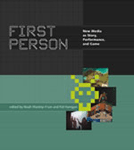
The Nomadic, Embodied, Embedded Aesthetic
"What would cyberdrama look like off the computer screen? To put it another way: Could there be a more pervasive cyberdramaturgy? Computing is increasingly ubiquitous and mobile. Why shouldn’t cyberdrama be, as well? Imagine a set of scripting, design and production strategies that employed digital technologies but tended toward a more nomadic, embodied, and embedded aesthetic. What might we learn about the dramatic potential of cybernetic systems and new media — or about the cybernetic potential of modern drama — from performances developed along these more pervasive guidelines?" From Notes Toward a More Pervasive Cyberdrama by Jane McGonigal, Electronic Book Review, June 2004 (in response to Cyberdrama by Pat Harrigan and Noah Wardrip-Fruin from First Person).
Posted by jo at 03:51 PM | Comments (0)
March 09, 2005
CITYCLUSTER

From the Renaissance to the Gigabits Networking Age
CITYCLUSTER is a virtual-reality networking matrix, a creative high-tech container with original technological features, navigation, interactivity and graphic and content style. In which multiple environments, ambiences or cities both real and imagined, can be hosted, coexist and be interrelated within themselves through a common, virtual territory, interconnected by high-speed network, enabling remote participants to interact and collaborate in shared environments.
The framework may be expanded, modified, enriched, developed, and produced ad hoc in accordance with the nature and typology of the environment to be incorporated. Visitors, with their own creativity and communicative skills, can become protagonist and/or free citizen: navigate, interact, intervene exchange buildings, objects and ideas and or create their own ideal environment.
Posted by jo at 11:30 AM | Comments (0)
March 08, 2005
Confessions of an eBay Artist

Auctioning Time + Choice
"I am selling my day, March 19th, on eBay. Why? Because March 15th seemed like a bad idea. I will be starting with my breakfast, then dividing the day into blocks of times and events that buyers can choose for me to do, and end with an auction for my bedtime...
...the ebay passageways are seemingly infinite, in a choose-your-own-adventure format. Inspired by this idea, I decided to list things that the buyer could choose. "Settle the Dispute: Catherine wants to paint the bedroom pink. Guido wants to paint it white with red spray paint graffiti accents. The winner decides, and will receive a photo documenting that their decision has been carried out." For that listing I found imagery of walls from around the world—the Berlin wall, the Great Wall of China, the Western Wall in Jerusalem, Iraqi walls with graffiti of mullahs, aerial maps of walls, and internal diagrams of walls...
...I realized bidding is a complex means of communication when I learned that two of my bidders are a mother and daughter who aren’t talking with each other, but are both bidding on current auctions, including pictures of my breakfast, lunch and dinner, and 100 pictures of Condoleeza Rice..."
From Confessions of an eBay Artist by Guido Catherine, Big, Red & Shiny, Issue 19.
Posted by jo at 05:34 PM | Comments (0)
March 07, 2005
Chris Barr is Available on Thursday

Body as Commodity
Chris Barr is Available on Thursday is a collaborative live art and documentary project. Events, actions, ideas, situations, etc. will be scheduled by the public for Chris every Thursday for the months March and April. Chris will perform the actions and events scheduled for him by the users of this web site. The schedule for each Thursday will be posted on this site in order to encourage the gathering of audiences and the recording of community documentation. This project is a stepping stone to investigate issues of authorship and collaboration, body and self as commodity, and artist as social organizer.
Posted by jo at 10:13 AM | Comments (0)
Interactive Video vs Performance Cinema
Live on Empyre, March 2005
From a post by Henry Warwick: "...I would also distinguish the difference between interactive video and performance cinema, and I would tend to question much of what constitutes the "interactivity" of "interactive" video, as much of what I see as "interactive art" (much less video) is not much more than various elaborations on a boolean if/then decision tree, which I find to be completely, and too often profoundly, UNinteractive...
...The other aspect that differs Live vs. Other Cinematic practices (interactive or otherwise) is a matter of synchrony vs diachrony. A movie is diachronous - it is essentially identical from one showing to the next. It can be shown to an empty theatre. It exists as a loop outside of time. A performance is synchronous - it will always differ from one performance to the next: even if the performance is a film and completely diachronous, the reaction of the audience will differ, making each performance unique. It exists Only in time...
As the internet allows a kind of fractal dimension of time (kind of like 1.2 D) where the arrow always goes forward, but it can stop for a while and skip around that which has occurred, it obviates most of the possibilities of any real live cathexis between the audience and performer through the vessel of the art and the environment of the art work itself by the very exigencies involved with what it is to use the internet..." Continue reading this post by Henry Warwick.
Source:
Message: 4
Date: Sat, 05 Mar 2005 00:04:28 -0700
From: Henry Warwick
Subject: Re: [-empyre-] interactive video software
To: soft_skinned_space, soft_skinned_space
Message-ID: Content-Type: text/plain; charset="US-ASCII"
Posted by jo at 07:35 AM | Comments (0)
March 02, 2005
YellowArrow at DiVA
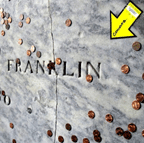
Art in Motion
Digital and Video Art Fair [DiVA] kicks off with an opening after party on March 10th that will definitely be an event in itself. The party will feature special performances by YellowArrow. Attendees are invited to participate in the art in motion. In addition to YellowArrow stickers’ distribution and projections displaying the content of the YellowArrow Global Gallery, mobile YellowArrows will point out a series of live micro performances staged throughout the party and announced via TXT messaging.
DiVA is the first art fair in the United States dedicated exclusively to digital and video art. DiVA will serve as an international destination for collectors, art dealers, museums, curators, and artists. Around forty galleries willfeature the diverse and innovative work of new media artists exploring and pushing the digital envelope. Digitally created work is a dynamic platform of expression in contemporary art that includes film and video, animation, photography, printmaking, sculpture, painting, architecture, and performance.
The YellowArrow is a global public art project that merges graffiti and sticker culture with wireless media, creating an interactive forum for people to leave and discover messages pointing out what counts in their environment.
Participants place arrows to draw attention to different locations and objects -- a favorite view of the city, an odd fire hydrant, the local bar. Each arrow has a unique code, and by sending a text-message (SMS) from your mobile phone to 1.646.270.5537 in the format "+code your message" you associate a short text with your arrow -- messages can range from literary quotations to personal commentaries to game-like prompts to action.
When another person encounters the arrow, he or she sends "code" to 1.646.270.5537 and immediately receives the message associated with it on their mobile phone. Through this location-based exchange of text-messages, the YellowArrow becomes a symbol for the unique characteristics, personal histories, and hidden secrets that live within our everyday spaces. And it's not just places, it's people: YellowArrow TXTshirts are individually coded just like the stickers.
YellowArrow text-messaging is currently compatible with all phones and service providers in the US as well as internationally with those networks under the GSM standard. The website, YellowArrow.org, allows participants to annotate their arrows with photos and maps and is the online gallery of YellowArrows placed throughout the world -- visit to order arrow stickers and tshirts and see announcements about new events and features.
Posted by jo at 11:16 AM | Comments (0)
March 01, 2005
IN Network

Living Together While Apart
IN Network--by Michael Mandiberg and Julia Steinmetz--is an extended cell phone life-art performance about distance, communication, intimacy, telepresence, and living together while apart. Faced with the prospect of a long-distance relationship when Michael moved from Los Angeles to New York in August 2004, the two artists got their frequent flyer numbers handy, and switched both of their cell phones to a provider with free "IN Network" service.
During the month of March the artists will present this cell-phone life-art performance via a photo moblog and podcasts of their phone conversations. There will also be several live webcasts of audio of the artists sleeping together on their cellphones. They will route all of their text and picture messages through the IN Network website. If you'd prefer, you can have installments of the performance sent directly to you via their Podcast. How to Podcast?.
"IN Network" is a 2005 commission of New Radio and Performing Arts, (aka Ether-Ore) for its Turbulence web site. It was made possible with funding from the Jerome Foundation.
BIOGRAPHIES
MICHAEL MANDIBERG is a new media artist who uses the internet, video and performance to explore subjectivity, labor, and commerce. His projects include "Bush Poll," a statistical survey of the 170 George Bushes of the United States, 2004; the DVD exhibition "First Person" in collaboration with Carla Herrera-Prats and Anne-Julie Raccoursier, 2003; and "The Exchange Program," a collaborative performance, 2002. Mandiberg has exhibited at Ars Electronica Center, Linz, Austria; ZKM in Karlsruhe, Germany; Transmediale Festival, Berlin; Tirana Biennale, Albania, and C-Level, Los Angeles. His work has been reviewed in The New York Times, The Chicago Tribune, The Berliner Zeitung, Wired, and a new survey "Internet Art" published by Thames and Hudson World of Art. Mandiberg is Assistant Professor in the Department of Media Culture, at the College of Staten Island/CUNY. URL: http://www.mandiberg.com/; Contact: michael -at- mandiberg -dot- com
JULIA STEINMETZ is a founding member and co-director of the Toxic Titties, a Los Angeles based collective working in performance, video, photography, and new media. Their work has been performed at such venues as Museum On Contemporary Art, Seattle, REDCAT at the Walt Disney Concert Hall, Out Fest Film Festival Los Angeles, LA Freewaves festival and the Hammer Museum in Los Angeles. Titties have performed in events such as the "Intersectional Feminisms" conference at UC Riverside, CA and at "Outside Field: International Performance Festival" at Ex-Teresa Arte Actual, Mexico City, "Cyberfem Spirit," at Edith Russ Site for New Media, Oldenberg, Germany and at Schnitt Ausstellungsraum, Cologne. Their work has been written about in Tema Celeste, the Los Angeles Times, the LA Weekly, Mexico City's La Reforma, Black Book Magazine, and Kolner Stadtanzeiger. Toxic Titties performance documents and design work have appeared in "Gendered Geographies," edited by Kaucyila Brooke, and "SITE, Schinitt Austellungsraum" published by Krefeld, Germany. Their work in collaboration with Austrian artist Dorit Margrieter was recently featured at MUMOK in Vienna. Contact: juliasteinmetz -at- yahoo -dot- com
Posted by jo at 11:53 AM | Comments (1)
February 24, 2005
Liveform Telekinetics [LF:TK]
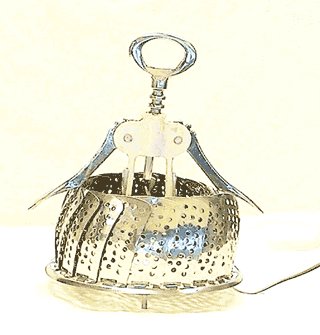
Experiments in Connected Social Spaces
"...Sharing a meal, a walk in the park, weddings, sports, or cafés...are the kind of social activities and rituals we associate with human relationships...What if you could go out for dinner and dancing with friends, even though you're a thousand kilometers away?...(W)ireless Internet "hotspots"...provid(e) the possibility of multi-situated presence, but (are) also placed within a fixed physical location, a social environment rich with familiar objects, rituals and codes of behaviour.
LF:TK takes a playful approach to the ways we might inhabit such a hybrid environment. Furniture, decorations, cutlery, bric-a-brac and cultural debris are reconstructed as networked interfaces that populate surfaces within everyday social spaces. Each object provides a simple function, yet when combined with others helps build a complex arrangement of movement and gesture. Imagine a shared creation, a social ritual, a dance through objects, a table that is played." [Recipe for Corkscrew Man]
Posted by jo at 05:34 PM | Comments (0)
Ku:iyashikei-net

Tear 2 Tear [T2T]
Ku:iyashikei-net by Urico Fujii and Ann Poochareon is a networked crying sculpture that allows people to communicate through the interface of tears, a physical output of human emotional expression that has been overlooked, and never made exchangeable with current communication devices. Two sides, installed at different locations, communicate over the Internet. On Side A, Tear Well allows a sad person to express his/her feeling by pumping a traditional water pump, the water representing her/his tears. The tears are sent over to Side B over the Internet, where teardrop sculptures called KU act as networked surrogates.
As soon as Side B receives the crying signal, KUs start to cry. When a viewer on Side B wipes KUs’ tears, KUs stop crying. At the same time comforting response is sent to the sad person to cheer them up. Read PDF [blogged by regine on near near future]
Posted by jo at 11:36 AM | Comments (0)
The New Performer: Data as Performer and Performance
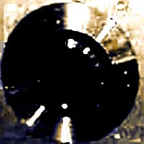
In Pursuit of the Virtual Performer
"The nature of all performance includes the elements of time-based experience and space as "stage". I use the term "stage" as a simple reference point to describe the space in which a performer performs and not as reference to the theatre. The nature of performance in the computer age includes these elements of time and stage as space. A simple definition of performance is : that which is feigned or pretended. It is action. It is speech. It is anything performative. The nature of the performer includes any entity who/which feigns, pretends, acts, and speaks. So, it is natural to include non-human entities, such as robots, cyborgs, and databases in this discussion of performance. Baudrillard might describe performing and the performer as more real than real, so real that they are virtual. "Of course we have a multitude of objective, real proofs, but what does one do with historical reality in a system which itself has become virtual? "(1)
New media's complex nature has influenced the nature of performance to become something many don't consider performance. Anything involving action, interaction, time, and space is performance. Therefore, performing is both real and virtual, becoming more real than real through the very nature of simulation. Performance on and of the net includes everything from virtual actors (interactors) interacting with real actors, Moos, Mud's, Mucks, Games, Chat groups, telepresence, Database as performance. The performer is data. The performer is virtual. The history of virtual performance begins with interaction between the real and hyperreal in time-based experience in a space referred to as the stage." From The New Performer: Data as Performer and Performance by Sheila A. Malone.
Posted by jo at 08:11 AM | Comments (0)
February 22, 2005
Welcome To The Scene
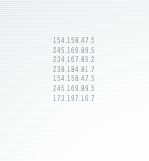
A Serial Drama from the Point of View of Webcam
""The scene" in this case refers to the social culture that goes along with the "pirate" infrastructure (the so called "darknet") that is behind the release of Hollywood movies onto the Internet. We see that scene through fictional character Brian Sandro, NYU college student and member of the notorious CPX release group.
The drama unfolds entirely from the point of view of a webcam focused on Brian at his computer and a recording of his desktop as he IM's, browses the web, rips DVDs, listens to mp3s, etc. Of course, looking at someone's desktop is normally boring but in this scripted desktop world its the vehicle for the character interactions, so we see Brian as he organizes rips with his release group mates, makes shady side deals with a street vendor in Asia, worries about financial aid and flirts with his girlfriend." [blogged by akb on Demand Media]
"Refreshingly, unlike most other 'net only tech related video dramas this one has a story line and character development. Brian descends into addiction and lies with increasing frequency to cover himself. The viewer experiences the dissonance of the unpleasant real world, with its crappy food service job, boring classes, and financial problems, when it intrudes into the fantasy world of "the scene" where Brian is an untouchable worldwide hero.
In addition to the unorthodox storytelling technique, "Welcome To The Scene" innovates on several other fronts that show a savy sure to be copied in the future by other independent producers of independent online video.
# Its delivered as a serial. That is, 4 episodes in have so far been released with the next scheduled for March 4th. Getting your audience to come back for more (stickiness) is crucial to building an audience for future projects.
# The show is licensed under a Creative Commons license, allowing it to be freely distributed by anyone.
# The show has agreements with other entities, for instance it has sponsors that get a plug as each episode begins and features the music of independent musicians.
# On the tech front, the show is available in high quality and makes excellent use of delivery technologies. Luckily, like anime, the content compresses very well, so 800x600 video can be delivered at 300kbps. The show is available via major p2p protocols (bittorrent, Ed2k, Gnutella, Fasttrack ). This leverages both bandwidth savings and the communities around the respective p2p networks.
One important thing to note, "Welcome To The Scene" is not produced by a college kid in their dorm room. Its produced by Jun Entertainment. They seem like a small shop with a corporate client list whose principals have a standard corporate background who have hired a college kid that knows about file sharing. For some the smell of venture capital and market seeding interferes with the enjoyment of the product, for some it does not. Regardless, there is some enjoyable content for Joe netizen and valuable lessons for hopeful Internet video distributors."
Posted by jo at 03:02 PM | Comments (0)
February 17, 2005
THE A - Z OF INTERACTIVE ARTS
![]()
From Double Gaze to Telenoia
Double Gazing: Just as we see, hear, and feel in ways unknown directly to biological man, we also now live in an environment which increasingly hears, sees and feels us. With computer laser tracking of our retina, the artist's gaze is returned. The walls will indeed have ears, and buildings will speak volumes.
Interactivity: Trivial and non-trivial. The first is a closed system with a finite set of elements. The second is open ended and infinite in its capacity to accommodate new variables.
Telematic Imperative: When there's no more geographical boundaries, territorial aggression is as irrelevant as polarised politics. The only imperative is to connect. Nowadays even the self is permeable.
Telenoia: Computer-mediated, distributed mind-at-large: asynchronous global connectivity. In celebrating telenoia we reject the individualism of the old industrial culture- solitary, anxious, alienated, neurotically private. Telenoia replaces paranoia in the telematic culture.
From THE A - Z OF INTERACTIVE ARTS by Roy Ascott, Leonardo Electronic Almanac, Volume 3, No. 11, November 1995
Posted by jo at 08:35 AM | Comments (0)
February 14, 2005
Peau d'Âne
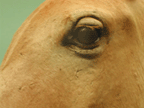
Locating Immaterial Materials
Peau d'Âne by Valérie Lamontagne: in the Charles Perrault fairy tale Peau d'Âne, a young princess, whose family's riches are dependent on a gold-excreting donkey, orders impossible wedding gifts from her father in order to avoid marrying him: three dresses made of immaterial materials. The first is to be made of the "sky" and should be as light and airy as the clouds. The second is to be made of "moonbeams" and should reflect the same lyrical intensity as the moon at night. The third, and last, is to be made of "sunlight" and should be as blinding and warm as the sun above.
Lamontagne will develop three wearables based on the Charles Perrault folk tale. Each dress--as a networked costume--aims to hybridize notions of computer interfacing and fashion. The "patterns" on the interactive material of the dress will morph according to information transmitted from a wireless weathervane to a computer chip implanted in the fabric. Utilizing wireless and solar-powered energy sources, Peau d'Âne goes beyond "making something out of nothing" and becomes a functional article marking another step in our aspiration to build truly ubiquitous objects.
InterAccess Electronic Media Arts Centre
Open Studio: February 19 - March 2, 2005
Work-in-progress Exhibition: March 4 - 24, 2005
Progress Presentations:
Saturday, February 19, 2005; 3 - 5pm
Saturday, February 26, 2005; 3 - 5pm
Valérie Lamontagne is a Montreal-based artist, freelance art critic and curator. She received her BFA (1993) and MFA (2001) from Concordia University (Montreal) where she is presently teaching in the Digital Image/Sound & Fine Arts program. Valérie has been exhibiting in and curating shows across Canada since 1997.
InterAccess is a centre for electronic media arts that enables artists and the general public to explore the intersections of art and technology. It is Ontario's only gallery and production facility devoted exclusively to electronic and new media art.
InterAccess Electronic Media Arts Centre
401 Richmond Street West, Suite 444
Toronto, Ontario, Canada
Gallery Hours: Tuesday - Saturday, noon - 5pm
Free Admission.
Related >>
Posted by jo at 10:56 AM | Comments (0)
February 10, 2005
Dziga Vertov Performance Group
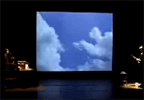
Performance Hybrids
Founded by artist/director Douglas Rosenberg in 1991, Dziga Vertov Performance Group's purpose is to create works bridging numerous disciplines including dance, performance and the visual and media arts. It takes its name from the Russian filmmaker of the early 1900's. DVPG's fundamental mission is to create new and challenging works of art based in the language of performance, dance and media that often combines voice, text, video and projected images. The work of DVPG is concerned with both content and form. The purpose of the work is to engage the audience, other artists and community groups in a dialogue that reaches beyond the usual performer/spectator relationship. In order to do this, we have set out to create a hybrid form of performance that is intended to both engage and challenge, using concepts and images that speak to contemporary and historical issues of human existence.
One of DVPG's many projects is ADaPT, an interdisciplinary association of artists, technologists and scholars from five educational institutions dedicated to research and critical dialogue on performance and media in telematic space.
ADaPT comprises five dance studios in five universities in the USA.:
1. Arizona State University
2. Ohio State University
3. University of California-Irvine
4. University of Utah
5. University of Wisconsin
In Wisconsin, the ADaPT team consists of Douglas Rosenberg (principal investigator), Chris Dowling (telematic technologist) and Jeffrey Gray Miller (technical director).
The objectives of ADaPT are to:
* create a site for telematic collaborative inquiry for the purpose of developing new models of practice and training techniques for the creation of networked dance and performance
* explore embodiment and somatic intelligence through reconceptualization of spirit, body and machine in Internet 2 culture- develop a shared mediated space for investigating performance and creative collaboration through a distributed environment across time zones
* situate research within a larger cultural and political context that acknowledges how mediated performances both frame and are framed by issues such identity, privilege, and access.
Posted by jo at 11:48 AM | Comments (0)
January 28, 2005
Pete Gomes

Locative Performance
Peter Gomes, (parkbenchtv.org), uses GPS in Here, here and... here (2003) [Duration 40 mins DV Cam] A 40 minute performance/drawing at the ICA in in London.
The piece was made prior to, and was part of, a lecture on "Locative Media and Performance".
"Here, here and ..here" used a GPS to globally position the ICA and drew the information from the GPS screen onto the pavement in white chalk - mapping the ICA using 3D GPS Location and coordinates.
On either side of the drawn GPS screen are two other sections drawn in dotted lines. These show the variations of the coordinates on either side of the doorway, which suggest the infinite and ongoing grid of coordinates beyond this location.
The screen and drawing included; numbered satellites; position of satelites; accuracy; elevation; along with bars to show satellite strength, and a date, and time.
The seconds on the time, were the last thing to be written – giving a precise time, using an atomic clock, to mark the conclusion of the piece.
Posted by michelle at 12:19 PM | Comments (0)
January 27, 2005
Here I come again (Flying Birdman)

Between Sites and Non-Sites
Here I come again (Flying Birdman) was a telematic "earthwork" - an earthwork dance linking five remote sites in the United States with two locations in Brazil. It was based on narratives/dreams and structured spirally as a "Renga" (the old Japanese form of a linked poem) composed of live dance; real-time audio and sound processing, pre-recorded filmic images; still images, and both spoken voice and graphic text communication exchanged by participants during the live performance.
Thematically, the performances delved into "left overs," debris, decomposing sites, dumps, and the idea of re-cycling of landfills: what is returned needs to be transported from one site to another. The dramaturgy for this telematic "earthwork'" envisioned a spiraling dialogue/communication -between sites and "non-sites"- with at least 2 sites dialoguing with each other (video, audio) at any given time during the 10 scenes. The dialogue was passed on and moved around, as in the Renga for of a linked poem. The online viewer was invited to follow the spiral. View movies >>
Posted by jo at 08:56 AM | Comments (0)
January 24, 2005
true look

networked performance
Isabelle Jenniches true looks takes over a store's webcam system, intended as a marketing ploy for online clients to check out their collection of smart Italian furniture. The artist's friends and colleagues -dancer, cook, choir member -are sent into the furniture store located in SoHo (NYC) as covert protagonists. Mingling with the clients, shop assistants and teamsters they are instructed to initiate subtle dramatic occurrences amidst the beds and sofas. Everyday patterns of consumer behavior are being poached, subverted into micro-dramatic moments which are followed and captured using the store's robotic webcam system. A selection of these images distills the routines and surprises of daily life in the shop into a series of episodes -part photo novella, part documentary -with text by theatermaker Richard Foreman.
Posted by michelle at 07:09 PM | Comments (0)
book on topic
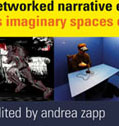
networked narrative
Andrea Zapp edits Networked Narrative Environments. Via various forms of audio-visual communications, from chat protocols, net and software art to online theatre and immersive telepresence, artists are using a wide range of technologies to explore the digital network as a narrative space. Human presence is increasingly subject to a constant flow of online contributions, material, and data. How does this reposition our collective understanding of the physical and the virtual, the real and the imaginary?
In this context the 'networked narrative environment' must be defined as an artistic modus operandi and experiment that reflects medial and social processes. The book documents exemplary and unique research positions within a developing genre. It serves as a resourceful illustration of the cultural debate on narratives, networking, and media art.
Leading international artists, writers, and curators examine specific examples of public installations and dramatic spaces that are linked to the Internet with the aim to integrate the viewer into the artwork. Key artistic projects and initiatives reflect sophisticated and complex new models of audience participation, real-time experience, and production of content:
Posted by michelle at 06:41 PM | Comments (0)
January 22, 2005
The Telepresence Garment
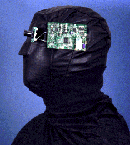
Engaged by Others, Remotely
"(Eduardo Kac) first conceived the Telepresence Garment in 1995 to investigate the notion of the mediascape as an expanded cloth; i.e., to consider wireless networking as a new fabric that envelops the body. The Garment, which I finished in 1996, gives continuation to my development of telepresence art. This time, however, instead of a robot hosting a human, we find the roboticized human body itself converted into a host. The Garment was designed as an interactive piece to be worn by any local participant willing to allow his or her body to be engaged by others remotely." Continue reading >>
Posted by jo at 12:10 PM | Comments (0)
January 19, 2005
TellBush.org

Giving Bush An Inaugural Ear Full
Announcing TellBush.org, An Experiment In Telephonic Democracy. Call 1.800.734.1463 to leave a voice message for bush. Your voice message will appear on TellBush.org--and a flag gradually builds on the web site--and get itself emailed to Bush at the Whitehouse.
Posted by jo at 05:22 PM | Comments (0)
January 17, 2005
Mutsugoto/Pillow Talk
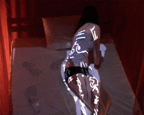
A Body-Drawing Communicator for Distant Partners
Mutsugoto--by Tomoko Hayashi, Stefan Agamanolis, and Ciaran McGrath--is an intimate communication device placed in the bedroom environment. Instead of exchanging e-mail or SMS messages using generic interfaces in business-like venues, Mutsugoto allows distant partners to communicate through the language of touch as expressed on the canvas of the human body. A specialized computer vision and projection system allows users to write or draw on their own bodies while laying in bed. Drawings made by one partner are transmitted to and revealed on the body of the remote partner. [via medialab europe]
Posted by jo at 10:15 AM | Comments (0)
Grafedia
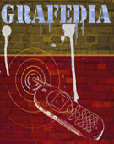
GraffiTML
Keyboards often eclipse pens as the writing tool of necessity. As computers continue to gain precedence in our lives, we fill a graveyard with lost penmanships and John Hancocks of decreasing legibility. John Geraci combines the personal imprint of handwriting with the connective possibilities of the Internet in his newly released project Grafedia, developed at NYU's Interactive Telecommunications Program. Elaborating on themes explored in neighbornode--a wireless, localized bulletin network Geraci built in 2004--Grafedia turns the city of New York into a potential webpage. An author can write, draw, even tattoo, a hyperlink onto a public space in the form: my_original_thought@grafedia.net. The author also uploads media corresponding to or enhancing to the location, like an original photograph, to the Grafedia site. Passers who encounter a link can 'click' it by sending a text message to my_original_thought@grafedia.net. In turn, Grafedia beams the author's hidden media back to the inquiring wireless device. Since Grafedia's annotative marks are not anonymous but in fact scrawled by the hands of their authors, viewers are able to follow particular people and stories. And the cherry on top my original photograph? It's a lot fun. - Alyssa Wright, Rhizome's Net Art News.
Posted by jo at 09:38 AM | Comments (0)
January 14, 2005
800-178968

...I'll Call You
800-178968--by Luca Bertini--was a toll-free number that attempted to establish an obsessive and addictive relationship with individuals. It called people back, even after a few weeks, and pleaded with them to come back.
800-178968 was invasive, insinuating itself into the homes and mobile phones of people, violating their privacy, and becoming part of their daily lives. The advertisements for it--which began three months before the start of the service--were hidden among information channels (by adopting their language, codes and instruments), thus were able to reach an unaware, vulnerable audience. The project ended on July 2003 with over 10.000 people contacted. [via Rhizome]
Posted by jo at 09:30 AM | Comments (0)
January 13, 2005
OptionalTime/Public Expanse

Between Reality and Fiction; Before Meets After
OPTIONALTIME/Public Expanse, by Joes Koppers and Susann Lekås, uses new new media to make a non-linear experience tangible in public space...It appears as a big mirror that in fact is an interactive movie...OPTIONALTIME/Public Expanse is a layered projection visually blended into one 'real' image. One layer is pure fiction and has been filmed by the artists, forming their most direct (personal) contribution...(It) uses cameras with full transparency; what is recorded is shown and nothing is archived. All images are processed in real-time by a computer, resulting in playback that sometimes is 'live' (a normal mirror image), sometimes buffered (delayed or accelerated image) and sometimes spatially manipulated. The playback 'mode' of the projection is directly controlled by the actions of the public.
Posted by jo at 08:24 AM | Comments (0)
January 11, 2005
Code Zebra
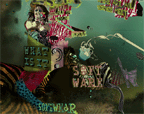
New Artistic Practices Meets Performance Art, Art and Science
Code Zebra is a highly interactive interdisciplinary, performance and software system where art meets science. The performances occur at sites around the world and on the web. CZ induces dialogues and debates between science (with an interest in computer and biological science) and arts (including visual art, design, fashion, architecture). Code Zebra consists of fictional flirtation sessions between an artist and a scientist, actual conversations and debates between the arts and sciences. Code Zebra is built as a scaleable performance series that allow venues to plug and play.
Elements of the development of Code Zebra will be captured in video and Internet streams and form part of a significant archive that will be used in performing the work. Users on the site will experience live events via streamed audio, and at times video. Live events will be publicized through the web site. The project draws from performance theory (art, literature, sociology), discourse theory and grammatology, cross-disciplinary research methods, visualization theory and computer science practice, simulation, new media analysis.
The metaphor of "zebra" is at the core of the project because zebra's stripes are reaction/diffusion patterns; a provocative but resolution based way of describing dialogue. Evolutionary theory uses zebras as a case study, and reaction/diffusion has been at the core of this emerging performance series and at the heart of the operations of computer code. Zebras are the unexpected evolutionary protocol. They stand out in a crowd, but induce nausea in lions, their former predators. Above all zebras survive by moving in camouflaged herds.
Performances will take place in various real and simulated locations. The software of Code Zebra also combines panel discussions and debates, live and on-line, chat, simulated conversations and patterns and visualizations of chat or performance art metaphors using software and fictional performances.
CodeZebra OS (Orifice System) Software
In November and December of 2000, a group of leading artist/software developers, streamed media artists, discourse theorists, chat analysts, computer scientists and programmers gathered in San Francisco, led by Sara Diamond and hosted by the ArtsAlliance. Together, they modeled Code Zebra, a software that will analyze and allow people to author on-line chat, video streams, producing visual patterns that allow users to better understand and symbolize their own position within discussions. The software deploys reaction/diffusion patterns from nature, but permits individuals or groups to have a personalized pattern at any point in time. The design retreat includes some of theworld`s leading thinkers in Internet dialogue analysis, streamed media, and pattern creation. It links to the larger Code Zebra project. The software is capable of analyzing all forms of chat, but will be focused on debates and discussions in art and science as a development phase.
The software provides users with the ability to use visualization patterns to locate themselves within an Internet discussion, review their histories of dialogue, enter a deeply moderated or anarchic space that is designated by topic and/or by mode of chat and feel physically located in this space; monitor other chats simultaneously, use physical links to relate ideas; build a personal pattern icon and a personal tale of chats and Internet dialogues that unfolds as a visually beautiful, navigable, shareable 3D and sound movie.
Fear and self-preservation need to be confronted and transcended in the process of enacting cross-disciplinary exchange. This will be so in the performances and is already a part of the software design process. The performances and the software translate constantly, between the semantic meanings of concepts, people's relationships, into visualization new levels of understanding. The software enables agency (you choose topics and people), but its intelligence constantly suggests new possibilities of idea, related concepts and people for you to connect to. While appearing light, beautiful and playful, this project is in fact serious and viral.
The software development workshop may be a good example of the lock-up technique (referred to later), as the artist placed fifteen top-end researchers and coders in a room with her and several other artists. They came up with the chat visualization software that was a complex melding of computational linguistics, social instincts, and simulations of animal and human physical characteristics and evolutionary logic. First and foremost, they combined an emotional system with the anarchic or unconscious dynamics of Internet interaction. Code Zebra is all about process, allowing a series of lenses on the process of dialogue and creativity. While driven by the vision of one artist, it is highly collaborative and hence high risk, requiring the cooperation of different talents and disciplines for its success.
The user enters each chat or dialogue session by dwelling on the surface of the site and then diving into a familiar or seductive pattern. Once inthe pattern one moves through its moving mass and can stay at any point for dialogue. The software monitors styles of discussion through pattern analysis and can impose patterns on certain kinds of dialogues should these go astray or at least suggest these. Patterns can be used to analyses what people are talking to each other, about what, but most profoundly how they are talking. Character scripts based on the reaction diffusion character team (Code Zebra, Os Zealot, etc.) will arrive in at least text, if not visual form, to moderate discussions or suggest changes of mode (e.g. you have a limit of ten words posting for e.g. and it looks like playful leopard spots). This process of swimming through the topography of the site is called orifice systems (OS).
Each user creates their icon on the site, a moniker for HOW they interact. Each chat sessions produces a pattern that they can capture at any point in time. It forms a ring, or layer attached to their icon. Over time, these layers build to create a personal tale. These are three-dimensional forms that the user can enter, fly through, fly around, pull out layersof for reconsideration. Although highly visual (and eventually sonic), drilling down into these results in precise data base information about whoone has spoken to, about what and in what style (aggressive debate, playful banter, formal panel discussion) at what time. The forms operate as 3D movies, luscious and beckoning. The icons sit on the surface of the site, but at any time, users can share these or revisit these alone or accompanied.
Posted by jo at 06:55 PM | Comments (0)
January 10, 2005
Public Genitals Project
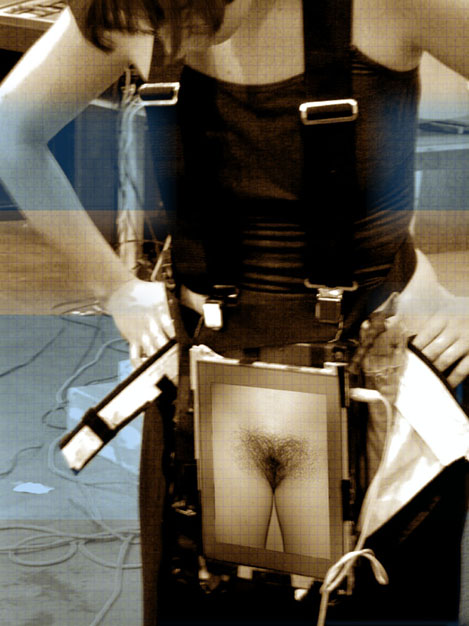
Not Safe for Walks
The Public Genitals Project , by Sandy Stone, playfully questions the boundaries between inside and outside, revealed and hidden, representation and reality.
Each PGP unit consists of a video broadcast receiver, battery pack, two small loudspeakers, and two modified laptop computers worn by a person walking the streets of Austin.
In one version, the person is naked except for the screens, which are attached to suspenders and worn so they cover the genital areas front and back. In the second version the person is fully clothed except for cutouts over the genital areas front and back, within which the two screens are mounted.
In operation, participants worldwide send images of their genital areas via webcams. The images are digitally manipulated according to an algorithm driven by the number of times the words "sex" and "violence" appear on the webpages of CNN, MSNBC, and CBS. The digital manipulation smooths and abstracts the images; the more the terms "sex" and "violence" appears in the media, the more that actual body images recede toward imagined recollections. The images are then broadcast and displayed on the flat screens. Concurrently, the loudspeakers present ethnographically recorded narratives of personal experiences with nudity, shyness, and desire, which are stored as sound files on the computers. The juxtaposition of images and physical body surface is meant to convey the illusion that the viewer is looking through a transparent electronic window at the surface of the wearer's body.
In reality, no actual flesh-and-blood genitalia are directly visible, and no explicit representation of individual genitalia is shown, though it is likely that this distinction may be lost on the naive viewer -- we hope. (Posted by Régine Debatty)
Posted by Regine at 09:19 AM | Comments (0)
January 09, 2005
Three by Thomas Charveriat

Animatronic Installations
The Machine Manifesto is an interactive musical performance that reflects upon the relationship between human beings and machines. It is composed of a series of mechanical musical instruments or automatons, and directed by an orchestral conductor. The instruments--programmed to perform independent tasks--follow the commands sent by the conductor via image recognition software. Machine Manifesto reflects the existing asymmetry between humans and machines (conductor and instruments), and provides an ironic look on the privileged position of machines in our society.

Light Activated Faces: A torch flashed at a square panel standing vertically on the floor, produces the sound of human onomatopoeias which vary depending on the area onto which the light is projected. Nine different grimaces are depicted on this photographic panel. Each facial expression becomes visible by means of a light box mechanism, whenever the flashlight points at it. A corresponding onomatopoeia is then produced by a sound sampler. The effect is a large human chorus conducted by the action of a flashlight.
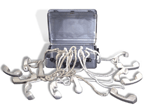
Telephones: Artificial intelligence is a rapidly developing area of scientific research. Many jobs formerly held by humans are now being done by computers, often by "bots" (computer generated intelligent entities that present themselves as human in order to perform tasks for others). One field where this has become common is automated phone service. This piece illustrates the computer's potential by replacing live person on a sex phone line with voices created by a computer. In it, twelve different computer-generated personalities have intimate conversations.
Thomas Charveriat (Paris, 1974) lives and works in Barcelona, Spain. Studied photography at the School of Visual Arts(SVA)and afterwards obtained a master degree in sculpture from Columbia University. Both schools are located in New York City. After finishing his studies in New York, he moved to Barcelona, where he obtained a master degree in digital arts at the Pompeu Fabra University. He has won a number of scholarships and prizes. He has participated in collective art exhibitions in New York, Paris and Barcelona since 1998. At the moment, Thomas Charveriat creates animatronic installations with GPS, SMS, video, sound, electronic data and humor that interact with the viewer in a peculiar environment, where the complexity and elegance are combined to create sensorial ambiguity associated with an atmosphere of vulnerability and apprehension.
Posted by jo at 11:59 AM
December 31, 2004
The Analogous Landscape: Rim of Fire

Inferencing Techniques for Navigation of Terrains
Defining the nature of resemblance between things that are otherwise unlike is the focus of The Analogous Landscape project. In the tradition of monumental works by environmental artists Robert Smithson, James Terrill, Christo, Richard Long and the Harrison's, C5 intends to produce a large scale conceptual and performance artwork. The Analogous Landscape: Rim of Fire project integrates a sophisticated research agenda within the context of adventure sports, corporate culture and art. Beginning with the successful expeditions in 2003 to ascend Mt. Shasta and Mt. Whitney in California (the highest peak in the continental United States) C5 is planning research expeditions with the intent of climbing 20 volcanic mountains along the Pacific Rim of Fire. The environmental space of the Pacific Rim is a complex dynamic shaped by a context of economic globalization and post-modernization.
The objective of The Analogous Landscape: Rim of Fire project is to develop inferencing techniques for navigation of terrains of similar characteristic. At issue is whether navigation paths can be transposed by analogy on a selected terrain's other. To address this, initial expeditions will be analyzed to produce predictive navigation scenarios that can be imposed on the succession of expeditions. C5 intends to re-describe the landscape as a factor of expeditionary experience. Using GPS (Global Positioning Systems) technology C5 research teams will collect ascent path tracking data that will be computer modeled in three dimensions. Video and photographic documentation of the expeditions will be interactively linked to the tracking data (time and location data) through a unique computer interface design. Each mountain will be computer fabricated directly from space shuttle and satellite DEM (Digital Elevation Mapping). A singular model will be produced directly from a cumulative integration of the track logs. The final installation will include the above elements within an interactive display environment.
Posted by jo at 10:09 AM | Comments (1)
December 30, 2004
Vidget 3.5

Experimental Performance Device
Vidget 3.5 is an experimental interactive audiovisual performance device which allows the user to manipulate video in real time online. As well as mixing a number of video clips together, the user may search for still images from the Flickr photo sharing site and mix them together. [via unmediated]
"...this version (Vidget 3.5) follows on from previous versions: Vidget 1; Flickr Image Viewer (Vidget 2); and Vidget 3...For instructions on Vidget 3.5 usage, see previous versions above.
Notes:
The main feature which has been fixed is the Flickr image search function. Over the last few weeks flickr.com (a very cool photo sharing site) has been changing the way they format their RSS feeds which means previous vidgets are broken. Things seem to have settled down now after a brief period of including 'enclosure' tags in their feeds I am back to parsing information from the 'description' tags for each image.
I am also back to using separate movies for the controls and output of the vidget. This improves the performance greatly as the output movie (which composites up to 3 source movies over the top of each other in real time) is rendered at 320*240 and may be increased to 640*480 by viewing at 'double size' in the Quicktime Player. I was having a lot of problems with sending the url of each of the 'source' movies from the controller movie to the output movie to be loaded. The solution was to have the output movie effectively 'ask' for the url via a custom event.
The controller movie now finds the url of the selected source movie (from either the xml file which lists the names of my clips or the Flickr RSS search response), sets it as a 'string variable' and then executes a custom event in the output movie which reads the 'string variable' back from the controller movie. The same process applies to tell the output movie which Movie In A Movie track to load the clip into.
Here's a bit of the LiveStage Pro Qscript for the controller movie:
SetStringVariable(1, channel)
SetStringVariable(2, bignumber)
SetStringVariable(4, movpath)
MovieOfID(12345).TrackNamed("Untitled Sprite").SpriteOfID(1).ExecuteEvent(42684)
The output movie then executes an event which gets these variables and sets them as 'Movie Variables':
SetString(channel, MovieOfID(838482).GetVariable(1))
SetString(bignumber, MovieOfID(838482).GetVariable(2))
SetString(movpath, MovieOfID(838482).GetVariable(4))
TrackNamed(channel).AddChildMovie(bignumber, movpath)
TrackNamed(channel).LoadChildMovie(bignumber)
Livestage Pro source files: Controller, Output"
Blogged by David Wolf
Posted by jo at 08:40 AM | Comments (0)
December 29, 2004
Communication Grill Chang-tei

Chat or Go Hungry
Communication Grill Chang-tei (CGC) by Japanese artists Kou Sueda and Kouji Ishii, is an electric cooker controlled by a chat software for making Yakiniku (Japanese-style barbecue). The conversation exchanged on a network powers the electric heater. In order to roast meat, you have to continue carrying out a chat with the person that shares your table. Once you stop chatting, the fire of the electric heater goes out. But beware, if the conversation gets too lively, the meat could burn. View movies [via unmediated].
Posted by jo at 12:13 PM | Comments (0)
December 28, 2004
Co-Operation
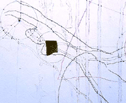
Encoding Memory and Mouring
For Natalie Loveless' 4th performance-based wall-drawing installation--Co-Operation--she is fasting and isolating herself in the Bromfield Art Gallery. During this time her contact with the outside world will be mediated through instant messaging technologies. You are invited to communicate with her from December 28th – January 1st, between 5 am and 12 am (EST), through either Yahoo or MSN (handle:bromfield_co_operation).
Please share your stories of mourning, memory or memorials; these will be used to generate this installation. Your communications will be encoded across the gallery walls through a silverpoint graphing system based upon the spatial organization of our primary mediating mediating technology: the computer keyboard.
Posted by jo at 12:57 PM | Comments (0)
December 27, 2004
netzwissenschaft
![]()
Emerging Infrastructures of All (Inter)net Research
Dr. Reinhold Grether's network research | netzwissenschaft site maps the "emerging infrastructures of all (inter)net research endeavours. net.science as an anthropology of connectivity is trying to overcome the constraints of specialist method transfers on net matters. the protuberance of technical networks necessitates a professionalization of human net knowledge. neither the isolation of concepts as in basic research nor the encapsulation of processes as in applied sciences will ever be able to adequately describe the complex autopoiesis of networks. net.science is undoubtedly developing into a scienza nuova of its own right."
Check out his Mobile Art and Virtual Performance research areas.
Posted by jo at 04:45 PM | Comments (0)
December 24, 2004
Telematic Dinner Party
![mike_fork[1].jpg](http://www.turbulence.org/blog/images/mike_fork[1].jpg)
A menu of food and electronics
During the experiment that Jeff Mann and Michelle Teran made of the Telematic Dinner Party, conversations between the table guests in Amsterdam and Toronto were mediated by streaming media and networked kinetic objects. So, for example a clinking spoon or glass in Amsterdam could produce a slamming door in Toronto.
The dinner table was turned into a physical platform for networked media supports live video streams, tele-robotic talking fish, gourmet cooking, singing chandelier, Keystroke media mixing, wine-pouring machines, telematic toasts, party games, etc; linking two dining rooms and thirty dinner guests across the ocean in a mediated mechatronic middle-space for social interaction.
Throughout the meal, the guests made toasts and speeches using the sensored and motored wine clinking devices. Everybody played games with food, cutlery, and chef attire to create interesting and coordinated video feed. After the first course, people changed seating arrangements to have access to all telekinetic props and streams distributed across the table. A coordinated storytelling game was played using the audio stream with the guests in Amsterdam. Finally, a punk magician performed for those physically and virtually present. (Posted by Régine Debatty)
Posted by Regine at 02:28 AM | Comments (0)
December 10, 2004
OFFLINE

Net Jamm
Outside the frame of the exhibition and for the opening of Unzipping Codes, the net jamm performance will be led by the members of the group OFFLINE, Brian Mackern, Arcángel Consantini, and Fernando Llanos. They will mix live inputs from the internet provided by themselves or OFFLINE colleagues that will resemble a mixture of DJ and VJ procedures while revealing the unstable nature of digital reality.
OFFLINE is a cross-border global group of artist collaborators working creatively with the Internet and related digital and networked media. The purpose of OFFLINE is to bring together online art practitioners and creative technical consultants for collaborative projects staged at real world locales such as art and music festivals, symposiums, cafeterias, rooftops and city streets. OFFLINE projects will take the form of live performances, installations, and diverse experimental augmented reality displays. OFFLINE is organized via an online mailing list and a central server.
Posted by jo at 09:28 AM | Comments (0)
December 08, 2004
Infrasense
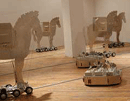
Trojan Horses and Bugs
Worms, back doors, Trojan horses and bugs are some of the better-known terms and metaphors for viral activities on the Internet, on desktops, laptops and in digital research and development labs around the world. The Infrasense project uses the idea of the 'Trojan Horse' and the 'Bug' as two digitally bound elements, which are subsequently produced as physical entities and in turn are partially controlled from the Internet again. The idea is to take concepts from the digital world, render them as physical objects and then return the control of the physical back to the digital landscape of the Internet.
Using 3D figures of bugs and Trojan horses to represent computer viruses, the artists turn the gallery into an interactive game space. Movement of the visitors influences the movement of the bugs and horses but so too does user input from the project website. As the visitor tries to interact with the system in order to access hidden information, questions of control, coordination, and location are raised through the installation. [via near near future]
Posted by jo at 01:25 PM | Comments (0)
Simultaneous Translation - A Networked Collaboration
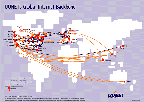
Distance and Time Through the Lens of Streaming Media
Friday December 17 & Sunday January 16, 2004; Madrid, Spain 20:00 (19:00 Greenwich Mean Time. 2PM Eastern Standard Time); Concert and live internet audio stream. Developed by John Roach with Miguel Ramos and Willy Whip Performers: Carlo Giordani, John Hudak, The Same Room Left, James Rouvelle, Mike Rosenthal, John Roach & Miguel Ramos.
Simultaneous Translation is an international networked performance that draws connections between language and the internet. Just as language has changed over time and as dialects have evolved as groups of people moved geographically from place to place, so in this project, live sound will be effected by time and distance. Audio created by the participants in Madrid, the US, Germany and Italy, will be broadcast live on the internet. [Related]
Posted by jo at 11:54 AM | Comments (0)
December 03, 2004
Spinne
![spinne_electro1[1].gif](http://www.turbulence.org/blog/images/spinne_electro1[1].gif)
Touching of the spider-web
Spinne, by Laura Beloff and Erich Berger (the duo from the Seven Mile Boots), is a networked audio installation of four sculptures made of plastic spheres, loudspeakers and metallic leg constructions. They correspond to four software programs, little search engines known as web-spiders that are sent out into the internet to chase some words or phrases. For example the word "women" can be searched from informational, religious, entertainment, and shopping sites.
Everytime a websurfer is accessing the website, the physical installation is reacting to it by shaking of the cables ("touching of the spider-web"), vibrating the speakers and modifying the soundscape. Little spider replicas are also placed on top of each loudspeaker membrane and the amount of the chased words can be heard and make the glass spiders dance on the membrane. Video.
Originally blogged on near near future
Posted by jo at 02:02 PM | Comments (0)
December 02, 2004
.ran [real audio netliterature]
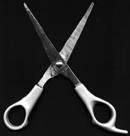
Automatically Generated Authorship
In five parts, the series .ran [real audio netliterature] - curated by Johannes Auer - will pick up various approaches of net literature (code, montage/collage, authorship, text-image-(sound) indifference, reference systems) and try to apply them to the medium radio. The current panorama is sketched out approximately by presenting 5 different positions.
December 5, 2004, 23:05-23:45, KUNSTRADIO: .ran part 2: "Authorship and its automatic generating" by Cornelia Sollfrank and Timothy Didymus: along with the possibility of technical reproduction provided by the printing machine the individualization of authorship came in the 18th century, as well as the invention of copyright. During the 20th century, a diversity of artistic attemps was undertaken in order to deconstruct individual authorship and the implied ideas about geniality and originality.
Started by Dada and continued by the Surrealists one can follow this development which now faces an expected culmination, caused by the rise of the digital media. Playing with identities, the availability of an endless amout of material and information on the Net, the possibility of copying without loss of quality, as well as anonymous and decentralized ways of distribution have formed a networked culture which often makes it impossible to identify a single author. And also the works are in a permanent state of re-work and variation.
"Generative art" is a special variation of this networked culture. Here, authorship very often is distributed to several contributors - for example the user, the programer, the artist who makes the concept and provides the environment, the authors of the re-worked 'original' material, and most import the computer(-program). A consequent handling of this kind of art, makes it hard to almost impossible to categorize it by parameters like "authorship" and "originality" on which not only the art world but also copyright is based.
The radio play "Automatically Generated Authorship" tries to relate in form and content to the described development. Four characters represent the different layers of discourse around the issue: a male and a female computer voice, as well as a male and a female human voice. The spoken text, noise and generative music compositions comprising the radio play have been rendered from a jump-cutting timeline. Although the content is seeded by the authors (Sollfrank & Didymus), the final form has been left purely to a software based music-engine to arrange.
The shock of jump-cutting, the un-fixing of order, creates new symbiotic meanings and relationships, manifesting not only as a disruption of the codes of listening, but also perhaps more importantly a 'bringing together' of ideas not (fully) intended by the artists. This act demonstrates the seductiveness of the timeline, and time based media in general.
next programme:
23.1.05 Sylvia Egger: DADA TO GO: A WALKTHROUGH LEVELS
30.1.05 Heiko Idensen: live!
13.2.05 Florian Cramer: Codeworks
previous programme:
07.11.04 Beat Suter/René Bauer: Man - Machine :: Apple in Space ::
Search the World
Posted by jo at 11:57 AM | Comments (0)
Energie_Passagen
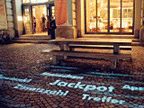
Public Voices Thrown Into the Flow
From Audiohyperspace: "Emergie_Passagen: Reading and (De)Scribing the City" - so the subtitle of this interactive audiovisual installation, which [could] be experienced until November 29th on Munich's Salvator Place. The installation understands a city's public speech - its inhabitants' chatting, the language of politics and media - as diverse streams of energy, from which an architecture is taking shape. The latter is made audible and visible by the art work. Every evening between 6 and 10 p.m. the square in Munich's city center is becoming a place, where a mediated, up-to-date intellectual-political milieu is emerging. The installation is mainly dealing with the interactive generation of semantic connections. A process, which can be initiated by every single passer-by and whose principles can be followed very well online.
Starting point for "Energie_Passagen" are texts taken from a mass medium, the daily newspaper. An automated computer process analyses the German newspaper "Süddeutsche Zeitung" and reduces it to catchwords. The terms which are filtered in this process are then projected as the "information flow" on the square "Salvatorplatz" in Munich.
As a visitor, you can choose between terms and "throw" your choice into the flow. Thus, movements of text are initiated and links between the terms become apparent. The resulting networks of terms create contextual links and new meanings which differ from the original linear texts. Computer voices immediately react to your "input" and accompany you in an echo of many voices.
In addition, a world map visualizes the path through the geographic landscape of news which the visitor takes based upon her/his choice. A developing linear illustration emphasizes the links between local location and global events.
The visible result of this interactive process is the "Living Newspaper". Its dynamically generated texts are projected on the square's "information cube". Newspaper texts are fragmented and transformed, creating new sense or non-sense. - A model maybe, how texts become catchwords, catchwords become arbitrary language patterns. It shows, how not content is the object of mental appropriation, but selections of terms and words are based on association and deliberate playfulness. By this, an intellectual is emerging, coined by the concert of terms and catchwords.
A livestream, accessible via the project's index page, makes the process audible via Internet.
Posted by jo at 10:21 AM | Comments (1)
THEATRALIS
![]()
mean meant meaning
Commissioned by Turbulence.org in 1999, THEATRALIS--by Eric and Michelle Riel--explores theatre for the net. Traditionally, theatre is defined as a live, text-based performance narrative, experienced by a collective audience. Theatralis investigates the paradigmatic shift of the performative, narrative, technological, and interactive experience through the individual, mediated web interface.
In A Novel of Thank You, Gertrude Stein explores the process of making a novel. As a documentation of the process of thinking, the content is rich in repetition. On the surface it appears random and nonsensical, although it is carefully edited. As it is about the aural and visual patterns of thought the reader becomes an actor.
Theatralis explores the process of experiencing how random and nonsensical content generates thought processes that can always construct a seeming narrative. Humans search for meaning, comprehend through stories. On the net we are creating our collective meaning from our individual stories.
what can it mean
there is a mean
to be meant
Posted by jo at 09:03 AM | Comments (0)
November 25, 2004
laptop_orchestra
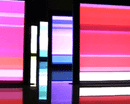
Conducting Synaesthetic Intruments
laptop_orchestra is an interactive synaesthetic instrument designed for performances of audio visual compositions in real time. Fifteen laptops are arranged in rows similar to the formation of an orchestra. Algorithms activate sounds and abstract visual shapes based on the color spectrum; each laptop has its own sound and instructions for the construction of a shape.
Interacting from the orchestra conductor podium by lightly touching metal stems, it is possible to activate or deactivate each laptop, permitting the generation of an endless number of different compositions. Compared to the software of elementary audio and visual compositions, this installation puts the interaction in a defined and public space dimension, drawing a reactive environment in the contour of its physical dimension. Software made with Processing. Download pde file and sound sample.
Limiteazero is an architecture, media design and media art studio based in Milan, Italy.
Limiteazero’s areas of expertise include: network installations design, set design, exhibition design, media in architecture and public space, interaction design, digital identity design, sound design, creative-network-software design.
Limiteazero's experimental activity is concerning the exploration of alternative relations between man, machine and environment, bridging the physical and the digital. It tries to establish an emotional approach using interface systems, instead of a logical/deductive one.
The work around form is mainly focussed on investigating forms and images generated by mathematical processing and through random evolution processes. The "random" sequence is our most used coding expression.
Posted by jo at 12:07 PM | Comments (0)
November 20, 2004
Evidence Locker

Retrieval Room
For the Liverpool Art Biennal, American Jill Magid worked with the operators of the city's CCTV surveillance cameras to teach them the techniques of professional filmmakers.
During one month, Magid wore a red trench coat and boots, ensuring she could easily be spotted throughout the city. She called the police on duty with details of where she was and asked them to film her in particular poses and even guide her through the city with her eyes closed - all using the public surveillance cameras. All around Magid, the most innocent passers-by were transformed into potential bag-snatchers, rapists and serial killers by the camera's behaviour.
The final work was made into two installations: Evidence Locker at Tate evokes the space of the CCTV monitoring station, with a soundtrack of the police log being read aloud, and CCTV footage featuring the artist. Evidence Locker at FACT reveals Magid's evolving relationship with the CCTV staff through a daily diary and video projections [until November 28th at the FACT gallery in Liverpool.] From near near future.
Posted by jo at 10:22 AM | Comments (1)
November 15, 2004
Mobile SCOUT

"Our Automated Quirky Naturalist"
Mobile SCOUT A Mobile Phone and Web Public Art Project by Julian Bleecker, Scott Paterson and Marina Zurkow: are you in a concrete jungle or swamped by tourists? Who's around you, what do you see? A deer, a dump or a daydream? Saintly acts or sinful facts? Mobile SCOUT is a public art project that collects audio narratives of your local surroundings, personal rituals and public sightings. Using your mobile phone, you leave a voice message of your observations with the Mobile SCOUT Ranger, our automated quirky naturalist.
Turn your observations into a brief message about the flora (landscapes), fauna (characters) or behaviors (events) that populate your surroundings. Call the Mobile SCOUT Ranger - 1 (877) 564-3060 - he will guide you through the experience. [via]
When you call you'll:
* pick your mission (flora, fauna or behavior)
* pick two habitat attributes
* leave a recording
Further instructions for operating Mobile SCOUT are available at our online brochure. Mobile SCOUT defines place as being made of social habitats, not geography. Your recordings are organized into an audio/visual field guide according to the kind of space you occupy, be it play, work, nature, culture, public, private, branded or free speech. See the field guide and listen to recordings left by others by visiting the web site.
Mobile SCOUT was commissioned by "The Database Imaginary", an exhibition at the Walter Phillips Gallery at The Banff Center, and curated by Sarah Cook, Steve Dietz and Anthony Kiendl. Mobile SCOUT was produced with support from BeVocal for voice application hosting.
Posted by jo at 11:21 AM | Comments (0)
Capacitor

Capacity for Charged Performances
Capacitor* is a group of interdisciplinary movement artists that accumulate energy from our technologically impacted culture and release it through innovative, multi-sensory performances. One of their pieces, Avatars (2002), takes the characters and themes of computer games and incorporates them into their performances. (Video clips are available of this performance).
From the movement of the human diaphragm to the story of evolution; from the behavior of electricity to genetic manipulation; from the birth of the moon to the cycles of digestion - science and technology form the basis for Capacitor's study of performance. Obsessed with the mechanics of the human body as well as machines that propel the body through space, Capacitor artists have become masters of rigging systems and large-scale props designed to stretch the limits of physical poetry. [via]
*ca·pac·i·tor (kƒ pas‚i tƒr) n. a device for accumulating and holding a charge of electricity.
To cultivate new and relevant performance concepts, Capacitor developed the Capacitor Lab, a think-tank of artists engineers, scientists and philosophers who exchange ideas, share knowledge, and ignite each other's imaginations towards the creation of innovative performance pieces.
The lively dialogues and debates that take place in the Capacitor Lab bring a broader outlook to the creative process and provide a vehicle for critical feedback as new work is developed. By engendering dialogue around contemporary technological and scientific issues, Capacitor aims to find common ground amongst individuals from varied fields of inquiry and, together, shape a new performance aesthetic built on today's innovations.
Capacitor has created works that tackle the creation of the universe (Within Outer Spaces, 2001), the past and future of mankind (futurespecies, 2000), the modern phenomenon of video gaming (Avatars, 2002) and, most recently, a journey through the visible and invisible layers of the Earth (Digging in the Dark, 2004). Capacitor's uncanny and contemplative use of technology won the company an invitation to speak at the Monaco Dance Forum in 2002 and has been covered by Computer Graphics World, Wired.com, SHIFT Magazine, NBC 11's Tech NOW!, CNET Radio, TECH TV, Dance Magazine and The New York Times.
Founded in 1997, Capacitor is grateful for support from San Francisco's Grants for the Arts, California Arts Council, the Zellerbach Family Foundation, Altria Group, Inc., the LEF Foundation, Theatre Bay Area, and the American Composers Forum.
Posted by jo at 10:35 AM | Comments (0)
November 14, 2004
in favor of networked practice

excerpted from Roy Ascott's essay Is There Love inthe Telematic Embrace" (1990), at the Walker Art Center's online show "Telematic Connections":
This question, which seems to be at the heart of many critiques of art involving computers and telecommunications, suggests deep-seated fears of the machine coming to dominate the human will and of a technological formalism erasing human content and values. Apart from all the particulars of personal histories, of dreams, desires, and anxieties that inform the content of art’s rich repertoire, the question, in essence, is asking: Is there love in the telematic embrace?
In the attempt to extricate human content from technological form, the question is made more complicated by our increasing tendency as artists to bring together imaging, sound, and text systems into interactive environments that exploit state-of-the-art hypermedia and that engage the full sensorium, albeit by digital means. Out of this technological complexity, we can sense the emergence of a synthesis of the arts. The question of content must therefore be addressed to what might be called the Gesamtdatenwerk—the integrated data work—and to its capacity to engage the intellect, emotions, and sensibility of the observer. Here, however, more problems arise, since the observer in an interactive telematic system is by definition a participator. In a telematic art, meaning is not created by the artist, distributed through the network, and received by the observer. Meaning is the product of interaction between the observer and the system, the content of which is in a state of flux, of endless change and transformation. In this condition of uncertainty and instability, not simply because of the crisscrossing interactions of users of the network but because content is embodied in data that is itself immaterial, it is purely an electronic difference, until it has been reconstituted at the interface as image, text, or sound. The sensory output may be differentiated further as existing on screen, as articulated structure or material, as architecture, as environment, or in virtual space.
This and other essay by Ascott are compiled in the book by Edward Shaken " Telematic Embrace: Visionaru Theories of Art, Technology and Consciousness".
Posted by michelle at 01:06 PM | Comments (0)
cell phone passed
paroxysmal stage
Miss Mobile has been going for some time. It's from Slovenian director and performer Emil Hrvatin who brings a Reality Telephone Game Show featuring mere talk and invisible performers, of which critic Darinka Nikoli wrote: "Emil Hrvatin's Miss Mobile is one of the most intelligent, boldest and most critically engaged contributions. His interactive performance, based on collaboration of the audience in the theatre and 'virtually' invisible people on the other end of the line, brought to the event via mobile telephones with an incredible amount of manipulation, is the 'bread and games' principle reaching its paroxysmal stage." Miss Mobile has been performed in Gent, New York, Ljubljana, Novi Sad, Paris and Rijeka. Before Boston it will be performed in Rome and Zagreb; after Boston in Los Angeles, Riverside and Santa Ana. Sponsored by Emerson College Institute for Liberal Arts and Interdisciplinary Studies, Emerson College Visual and Media Arts, School of the Museum of Fine Arts Performance Area.
Then Miss Mobile moved to Cal State University Fullerton. A reflection on public/private relations by one Slovene performance artist and 40 audience members and their cell phones. Bring a cell phone if you have one! The artist may ask you to call your friends and allow him to converse.
Emil Hrvatin is a theatre director and performance artist who manages the non-profit organization Maska in Ljubljana, Slovenia. He will perform "Miss Mobile," which is based on a "reflecting of public/private relation." It's a performance in which he asks audience members to call their friends by mobile phones and then he lends them eight phones to do so. The content of the conversations varies; it's basically about politics and people's relationship to it. At the end, audience members vote for the "Miss or Mister of Virtual Characters." Emil is also the artist in residence at the Grand Central from May 1 through May 20, 2003. Miss Mobile will also be featured at Highways Performance Space, 1651 18th St., Santa Monica.
Posted by michelle at 02:05 AM | Comments (0)
November 10, 2004
cyberPRINT
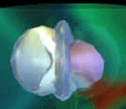
Bodies: Inside Out
cyberPRINT is a virtual reality dance environment...(W)hile a dancer performs on stage, he or she is wearing wireless sensors that monitor key physiological signs (respiratory and muscle activity, cardiac activity and the nervous system). Then, these measurements are captured in real-time during a performance and projected via colorful 3D renderings on a screen for the audience to watch...You can read the main write-up about the cyberPRINT project, which includes a good overview, descriptions of the technologies and images.
Multimedia choreographer and artist Yacov Sharir, the creator of the cyberPRINT project, conducted a workshop about this program at this September's Symposium on Arts & Technology. Here's how this workshop is described:
"The cyberPRINT is a real time Virtual Reality (VR) environment that totally surrounds a dancer during performance. This electronic architectural and musical bio-feedback system is driven by physiologic data drawn from the performer via special sensors attached to her body and transmitted wirelessly to computers which, in turn, generate and project a especially designed and programmed 3D/music world in real time. The resulting "architecture of being" offers multiple expressive choices as its multidimensional character undergoes continuous change. Although the use of the body to electronically drive media events is not new, most of the existing works have paid little or no attention to the potential of interactive 3D and aural virtual environments. Nor have they been so technologically advanced, interdisciplinary involved, or spatially focused as the cyberPRINT. The cyberPRINT has been nationally and internationally performed with success since May 2000." [via]
Posted by jo at 10:37 AM | Comments (0)
November 09, 2004
performing art performing science

Call to Performance
TRANSNET Conference [Transdisciplinary Network for Performance and Technology] asks:
"How can a transdisciplinary perspective communicate new knowledge emerging at the intersection between disciplines?"
"How can this alter approaches to performance?"
Call for Proposals to the conference, June 16-18, 2005 at the School for the Contemporary Arts at Simon Fraser University, Vancouver, Canada.
Posted by michelle at 04:32 PM | Comments (0)
November 07, 2004
DEAF04

participatory locative sound imaging hoedown
Dutch Electronic Art Festival (DEAF) is a biennial international festival for electronic art, presented by V2_, Institute for the Unstable Media, in Rotterdam, The Netherlands.
TRAMJAM V.03- ROTTERDAM RUSHHOUR by Mumbai Streaming Attack is a multi-track- multi-driver mix hub streaming jam session of Rotterdam city vibe, orchestrated in sync with the city's tramlines' routing schedule. Play along November 12 if you're in Rotterdam. Mumbai Streaming Attack is a networked performance study group currently based at SNM/HGKZ in Zurich.
Also at DEAF04 (and simultaneously in New York, Brisbane, Linz, and Singapore) is media artist Zhang Ga's public art project The Peoples' Portrait, where five photo-capturing kiosks, including the location in the Times Square Alliance Information Center at 150 7th Avenue in New York City, are set up globally to capture a diverse range of people in their unique environments. Every few seconds, a central server will retrieve the portraits and display them first in time stamped order, then randomly from the archive. [Related]
Originally posted by Eli Chapman on unmediated
Posted by jo at 06:55 PM | Comments (0)
November 06, 2004
Time [Re]Sequenced

user dependent cinema
PLACE--a year long series of exhibitions that explore the role of networked technologies in transcultural experience, organized by MediaNoche-- presents the first exhibition in the series. Time [Re]Sequenced (Networked Cinema) is a project by Cyril Tsiboulski which explores the ways traditional cinematic structure can be affected by new media.
Time [Re]Sequenced is a screen based interactive project in which a four minute scene from Solaris (1972), a Russian film directed by Andrey Tarkovsky, is broken into individual frames by the users accessing the project site. The sequence is then reconstructed and played back using shots initiated by the users. Time [Re]Sequenced depends on and responds to the virtual participation of the audience. A unique network driven algorithm creates a new space and a new language of cinema. Edited in real time, the film sequence can only be reconstructed as a result of audience participation. It depends on the network traffic volume thus creating potentially endless variations. As a contributor to the cinematic structure, but a passive viewer of the result, an audience member is challenged to re-think the role digital technology plays in how we experience our culture.
November 5th - 24th, 2004; Opening reception: FRIDAY, NOVEMBER 5th from 6 - 8p.m.; MediaNoche is located at 161 East 106th Street, New York City.
DIRECTIONS: Take the 6 subway to 103rd Street and walk north along Lexington Avenue to 106th Street. Turn right on 106th Street. MediaNoche is on the north side of the street in the middle of the block.
HOURS: The gallery is open Tuesday through Saturday, from 3PM to 7PM. Appointments can be made by calling 212 828 0401.
http://www.networkedcinema.org
Posted by jo at 10:00 AM | Comments (0)
November 02, 2004
Scan Your Skin

Beneath the Surface
Following in the footsteps of Plug'n'Pray, a new adventure is about to begin. Scan your Skin [SyS] will take the form of a book, web site, and offline activities.
Call for ideas and proposals: Our skin is our vulnerable shell. It protects us and characterizes each one of us as an individual. Besides its physical attributes, our skin conveys differences between people; it takes on ancestral, historical, cultural and political implications. As time flows on, it carves more signs and meanings on our skin. SyS wants to explore this territory from different points of view.
Creative personalities will suggest artistic interpretations of the project message, thus offering their own reading of the human skin. Photography, graphic arts, the written word; a bold, abstract approach or a sober and realistic one - each contribution will be a key component of this multifaceted jigsaw puzzle. The goal is to build a well-structured picture of human skin as a concept/research object. The final work will be published in a book.
Artists, writers, designers and cultural producers: we are calling you! Send us your work! (Format: 1 to max. 8 pages; approx. size: 17x24 cm/6.70x9.45 in) It can be anything from a photo or photo series/sequence, to graphic work, to a story, an article or a poem.
We plan to organize a number of offline happenings and events to support and promote the book, and to link it to an ad-hoc web site: the "Scan your Skin" online project is under construction right now (check it out on www.scan-skin.org, coming soon.)
Posted by jo at 09:25 AM | Comments (0)
October 30, 2004
Radioscape III
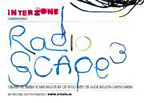
Mixing the City
In Radioscape III--a project by Edwin van der Heide--there are fifteen transmitters installed around and on the Leidseplein in Amsterdam, each broadcasting its own musical layer. Van der Heide designed a receiver that allows you to receive and mix the signals of two, three or more transmitters simultaneously. At a certain moment you receive one transmitter the strongest, the second a bit softer and the rest might be inaudible. By walking through the environment the balance between the transmitters is changing, new ones are fading in while others are fading out. Van der Heide: "The city centre forms a musical labyrinth with different layers of sound that, together, form a meta composition. By moving you mix the different layers which lead to new combinations and interferences."
Radioscape is open from Thursday the 28th of October till (including) Sunday the 7th of november. You can obtain a Radioscape receiver at the counter of De Balie. They can be fetched between 13:00 and 20:00
Radioscape is freely accessible for the audience. In order to borrow the receiver you have to deposit either 50 euro's or an id card. You have up to one hour to 'radioscape'.
Radioscape III is part of the Interzone series by De Balie, a series of artistic explorations crossing the borders between the existing artistic disciplines.
Posted by jo at 10:14 AM | Comments (0)
October 28, 2004
Cell Phone Drum Machine

Collaborative Rhythm Generator with an SMS Interface
Cell Phone Drum Machine is a rhythm generator that can be controlled by users with their phones by sending text messages. Here's how it works: the operator links his/her phone to the computer and starts the drum sequencer. Users can then send special SMS commands to the operator's phone that controls the rhythm. The on-screen display shows from which phones commands originated.
Matt Hall and John Watkinson will present the project at dorkbot-nyc on Wednesday, November 3rd, 7pm at Location One in SoHo.
Posted by jo at 10:08 AM | Comments (0)
October 23, 2004
Wirefire

Touch Through the Wires
Wirefire was an online performance and communications environment. The project, by entropy8zuper's Auriea Harvey and Michaël Samyn, utilized technology they developed to faciliate 'touch through the wires', combining chat, sounds, images, animations and live camera streams to form an interactive, improvisational expression that went beyond words. Wirefire is currently available in RANDOM FIRE/REPLAY VIEW only. [Flash 5 plug-in required.]
Wirefire was LIVE online every Thursday night at Midnight to Friday 1am ( Belgian time). Wirefire was meant to be performed and viewed online but non-virtual Wirefire performances were presented in venues such as the Brooklyn Academy of Music, New York; the Walker Arts Center; Minnesota; GMI screen, London; and Passage44, Brussels.
Posted by jo at 06:27 PM | Comments (0)
October 15, 2004
City of Heroes
Virtual Memorial
"City of Heroes players memorialize Christopher Reeve: Memorial vigil held by players of the online superhero MMORPG honors passing of the Man of Steel"; by Tim Surette--GameSpot; POSTED: 10/12/04 02:01 PM PST
After the news of the passing of Christopher Reeve hit the airwaves, players of the massively multiplayer online role-playing game City of Heroes gathered together for a memorial for the fallen hero. Players gathered in full hero garb and saluted in tandem in memory of the man best known for playing Superman on the big screen. Reeve, who became a champion of spinal cord research following a paralyzing horse riding accident in 1995, died Monday as a result of heart failure stemming from an infection related to his paralysis. He was 52 years old.
Posted by jo at 12:47 PM | Comments (0)
October 14, 2004
Liebst du mich Lump

Thoughts run through the net
In Beckett's "Waiting for Godot" nothing happens. Twice. During Beckett's "Liebst Du mich Lump" a lot of things happen. Simultaneously and in different places. The piece adresses the internet-public, only 8 spectators are permitted on location.
"Liebst du mich Lump" takes place in a labyrinthine theatrespace with the walls full of graffiti located in the heart of Berlin-Friedrichshain. But already the delicate, frail nervestream of a Sleeping Beauty in deep sleep, lying in the "skulpturalen Versuchsraum 2" of the "Deutschen Museum" in Munich can change the way the actors act. Thoughts run through the net, also from the internetcafe "Oraniennet" in Berlin- Kreuzberg 36. There, an ironmask is connected with a computer through which users can also manipulate the play with the vibration of their voices. A neuro-virtual "ménage a trois" is being created. Coincidence rules, speech dissolves to a mathematic formula, to oracular words which are put together every evening in a new way.
Opening night: October 19 -November 2, 2004 at 8 pm; Watch the Internetlivestream: www.beckett-pi.de; DSL/Windows.
Posted by jo at 05:15 PM | Comments (0)
October 13, 2004
Cinéma
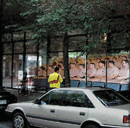
Shuttled Between Worlds
Cinéma is a multi-artist, cross-disciplinary performance presented in a storefront, converted into a theatre which looks out onto an urban streetscape. The audience inside this theatre watches and listens to video and sound elements while live performance takes place on the street outside. Narrative elements in Cinéma are in both French and English. Cinéma opens with texts which deal with the nature of the first word, the dominance of the ‘cinematic eye’ in our experience of the world, and the fragility of the human body. The myth of Orpheus and Eurydice, with its shuttle across the transitional space between the worlds of the living and the dead, is used as a structuring device for the piece.
Cinéma will be presented at SAT (Society for Art and Technology/La Societé des arts technologiques), 1195 rue Saint-laurent, Montréal [between René-Levesque et Sainte-Catherine - métro: Saint-Laurent]; October 12-15, 2004 at 8pm. During the day visitors can sit in the theatre observing the street while listening to an audio piece in which fragments of the performance soundtrack are adapted as an installation.
Thematically, the use of the myth is of interest in examining the very contemporary problem of the ability of art to influence the unfolding of events. What is the use of art in the face of political and social conditions which appear to be beyond our control? Can art create a window onto invisible forces which seem to control our lives? Can it open a process which allows us to approach spiritual and existential questions without falling into romantic clichés? In short, what is the potential relevance of art beyond its contemporary relegation to the role of diversion and entertainment?
Music: Rainer Wiens
Texts: Shauna Beharry, Andrew Forster
with: Monique Romeiko, Robert Schweitzer, Solomón Díaz, Michael Fernandes, Nathalie Claude
Posted by jo at 09:33 AM | Comments (0)
October 11, 2004
Auracle
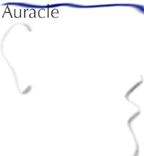
A Networked Instrument
Auracle, a voice-controlled, networked instrument on the Internet, was created over the past year at Akademie Schloss Solitude in Germany by the Auracle team (Max Neuhaus, Phil Burk, Sekhar Ramakrishnan, Kristjan Varnik, David Birchfield, and Jason Freeman--read PDF). The project is inspired by Max Neuhaus' interactive radio works from the 1960s and 1970s.
The site is now live, and you can try out Auracle at any time (you'll need a computer with a microphone). The official launch event is Friday, October 15th at Donnaueschinger Musiktage, a new music festival in Southern Germany. You are welcome to join in via the Internet by using Auracle at 2:30 p.m. Eastern Standard Time this Friday; see the web site for details.
Auracle is a networked sound instrument, controlled by the voice. It is played and heard over the Internet. To participate, simply launch Auracle in your web browser, join an ensemble, and create sounds with other participants in real time. While it takes years to learn how to control an instrument such as guitar or piano, Auracle requires no special training to play. It takes advantage of the sophisticated and flexible vocal control we all have from our ability to speak.
Your voice, however, is not the source of Auracle's sounds — it is merely a way of controlling those sounds. You play Auracle with other people anywhere in the world in groups of up to five players called Ensembles. All members of an ensemble are able to hear each other's gestures. Listen to the active ensembles in Auracle by clicking on their names. Stay with a group that you like, or create a new ensemble yourself and invite others to come and play.
Auracle is an instrument, not a piece; it is a system, not a musical composition. It has an internal structure, but it does not define or control the interaction of its participants. The architecture itself adapts over time in response to how it is used.
Posted by jo at 02:58 PM | Comments (0)
October 09, 2004
Warehouse Operation - v.beta.

Actions Reseaux Numeriques
Combining human and technical possibilities, the hypermedia project Warehouse Operation (GDS) by Actions Reseaux Numeriques focused on building a warehouse of various objects and materials. The technical and human possibilities, consisting of a link to a website and a warehouse established in a concrete physical space, provided the opportunity to 'enter the warehouse--with the help of the link--and see the objects it contained.
The communication mechanism was based on the circulation of commands and responses between the users and operators. Users communicated with operators--who were physically located in the warehouse--on the internet. Users sent in their orders and the operators performed responses, thereby transforming the link.
The process consisted of a sequence of specific actions, whose beginning and order the user indicates to the operator in the warehouse:
* selecting objects and taking them out of the warehouse
* transferring them to a separate zone and creating an identification document
* exhibiting and general identification
* placing them back to the warehouse.
In a separate zone a document representing the object, generally accessible with the help of the link, is presented. Any user can attribute to the observed object a meaning that he considers the most appropriate, or can present rational or imagination-based assessments and in this way create the general memory of the warehouse objects.
In this way a link between the digital and physical reality is established. The developing relation between these two forms of being makes one to take a new look at the mutual relations of humans/machines and the perception of the net-generated reality.
# Laurent Neyssensas: implementation of the project
# Yann Le Guennec: modelling/programming
# Sylvie Bourguet: project manager responsible for the conception
For more info on this project, see http://www.x-arn.org/y/wakka.php?wiki=GestionDesStocks (in French).
Posted by jo at 01:21 PM | Comments (0)
October 06, 2004
Organised Sound: An International Journal of Music and Technology

Networked Music
Interconnection has always been a fundamental principle of music, prompting experimental artists to explore the implications of linking their computers together long before the Internet reached the public consciousness. As the Internet achieved critical mass over the past decade, networking technology took centre stage as the key to a vast new territory of possibility, facilitating remote participation, distributed processing, and redefinition of musical space and time. The Web emerged as a virtual venue for countless musical purposes, and as analog acoustics transformed to digital representations, packets of data carried by IP from one address to another became a modern metaphor for air molecules transmitting the tone of vibrating body to eardrum.
As with any new technology, applications of networking to music have evolved from naïve proofs-of-concept to more sophisticated projects, and we stand now at a point when 'internetworking' is taken for granted, novelty is expiring and artistic goals more often transcend technical considerations. From this vantage, the essential question is not how networking and music are combined, but why. What is the unique experience that can be created? Whose role can be empowered or transformed: composer, performer, audience? Where can sound come alive that it couldn't otherwise? Networked music can reinterpret traditional perspectives on stagecraft, ensemble, improvisation, instrumentation, and collaboration, or enable otherwise impractical relationships between controllers, sensors, processors, inputs, and outputs. The network can be an interface, a medium, an amplifier, a microphone, a mirror, a conduit, a cloud, or a heartbeat.
The network is all of us. Music is the sound we make. Listen...
Call for Articles and Works
Volume 10, Number 3
Issue thematic title: Networked Music
Date of Publication: December 2005
Publishers: Cambridge University Press
We invite submissions from composers, performers, artists and researchers working in the realm of digital media and sound. Submissions related to the theme are encouraged; however, those that fall outside the scope of this theme are always welcome.
Issue Co-ordinators: Margaret Schedel [gem at schedel.net] and John P. Young [sound at netmuse.org]. This issue is being prepared in collaboration with the International Computer Music Association (ICMA).
The theme represents many avenues for discussion including, but not limited to:
Networked control interfaces (hardware/software)
Sensor arrays/interaction
Distributed/remote participation (composition, performance, reception)
Broadcasting/multicasting/streaming media
Virtual musical environments/venues
Aesthetics/philosophy of musical interconnection
Web-based music projects
OpenSoundControl
Distance learning/education
Online collaboration
Networked data sonification
Real-time remote sensing
Distributed processing
Networking for fault tolerance
Musical avatars/agents/bots
Emergent network phenomena/effects/behavior
Neural networks
Internet2
Alternative musical networks (RF, MIDI, WiFi, Bluetooth, etc.)
Strategies for mitigating network limitations (bandwidth, latency, etc.)
This issue continues the annual partnership between Organised Sound and the International Computer Music Association, with previous themes including "Performing with Technology" and "Collaboration and Intermedia." In exploring these prior areas, networking has emerged as a common element underlying a wide variety of innovative projects, prompting a more focused look at the mutual influence between networks and music. This should be no surprise in the electroacoustic field, where our machines are partners as much as tools, and working with other artists or often even solo requires connection between multiple machines. In the pre-network era, technical obstacles frequently dictated that much computer music occurred in relative isolation, with musicians expending precious attention acting as interpreters between hardware and other humans. So in one sense, networked music can be simply a recapitulation of acoustic music principles, of listening and sensitivity to other performers and audience, by enabling computers to participate equally in the musical conversation. Networking can also radically alter these traditional principles, most obviously by decoupling the spatial framework, enabling some or all of the participants to act and perceive without being physically present. Thus networked music is fertile territory for the composers, performers, and researchers that comprise the ICMA as both a potential means of overcoming challenging limitations of technology, as well as presenting new possibilities we have yet to imagine.
Submissions may consist of papers, with optional supporting short compositions or excerpts, audio-visual documentation of performances and/or other aspects related to your submission. Supporting audio and audio-visual material will be presented as art of the journal's annual DVD-ROM which will appear with issue 10/3. Related discussion will be located on the ICMA Array website, and additional multimedia at Organised Sound's Cambridge University Press website.
SUBMISSION DEADLINE: 1 March 2005
SUBMISSION FORMAT
Notes for Contributors and further details can be obtained from the inside back cover of published issues of Organised Sound or from:
http://uk.cambridge.org/journals/oso/
Email submissions should be sent to (please see SUBMISSION FORMAT above): os at dmu.ac.uk
Hard copy of articles (only when requested) and other material (e.g., images, sound and audio-visual files, etc.) should be submitted to:
Prof. Leigh Landy
Organised Sound
Clephan Building
De Montfort University
Leicester LE1 9BH, UK.
Editor: Leigh Landy
Associate Editors: Ross Kirk and Richard Orton
Regional Editors: Joel Chadabe, Kenneth Fields, Eduardo Miranda, Jøran
Rudi, Barry Truax, Ian Whalley, David Worrall
ICMA Representative: Mary Simoni
International Editorial Board: Marc Battier, Laurant Bayle, Hannah Bosma, Allesandro Cipriani, Simon Emmerson, Rajmil Fischman, David Howard, Rosemary Mountain, Tony Myatt, Jean-Claude Risset, Francis Rumsey
Posted by jo at 09:27 AM | Comments (0)
October 05, 2004
Life: a User's Manual, Part 2

Inhabiting Image Spaces
Commissioned by and currently on exhibit at Impakt Online, Life: a User's Manual locates the city of Utrecht as its game board, where every story, every piece stands on its own, but is part of an intricate jigsaw puzzle. Both public physical spaces and private interior spaces contain traces of fragmentary personal [hi]stories tied together by an invisible network of media. How people inhabit the hidden 'image spaces', discovered by a wireless surveillance camera scanner, while at the same time inhabiting physical outdoor spaces, was revealed through the daily practice of walking during the Impakt Festival 2003. The findings of Michelle Teran's walks have been arranged on a map of Utrecht's secret transmissions.
Life a User's Manual is a series of walking performances taking place in different cities (see an earlier post on this site), based around the activity of tapping into the unencrypted transmissions of wireless security cameras using a 2.4 Ghz receiver. In a search for the hidden stories within the city, a walk through the urban streets reveals an invisible network of watched spaces. The unencrypted signal from the camera leaks into public space, making it easily viewable from the street. This puts us in an interesting moment of uncertain inhabitation, of being in two spaces at once.
A tiny fraction of the spectrum of the airwaves has been allocated for public use, as if space and the air are not public already. Taking advantage of this unlicensed part of the spectrum, we have seen an increased used of wireless devices that are all fighting for use of this narrow band. Use of wireless [wifi] networks, cordless phones, bluetooth, and wireless cameras transmitting on this frequency contributes to an already existing invisible world of electromagnetic fields and frequencies that saturate our bodies on a daily basis. It becomes impossible to separate our bodies from the traffic reports, surveillance video, phone calls and pop songs of others. We wear each other's information.
Posted by jo at 11:10 AM | Comments (0)
October 04, 2004
Ursula Endlicher

Web Performer and More
Ursula Endlicher has created the October 4 artport gate page. She is a multiple-media artist working at the intersection of Internet, performance, and installation art. Since 1996, she has been keeping a critical yet humorous eye on the intricacies of the online experience, focusing on its technical and social protocols and the visualizations of interface. Her most recent web work, "Famous For One Spam" (2004), repurposes the overload of SPAM email. Another piece, "Web Performer II" (2000), lets the user choose and bring to life different characters in a play via search engine results. "Web Performer" (1999), the 'prototype,' turns your browser experience into a stage full of characters searching for their online identity. Endlicher's artwork has been presented in Europe and the U.S. by THE THING, Channel13/WNET online, Postmasters Gallery, and the Austrian Cultural Forum, New York.
Posted by jo at 10:24 AM | Comments (0)
September 27, 2004
Urballoon
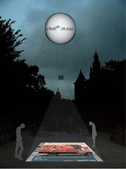
An Urban Media Space
Urballoon is an urban media space: a balloon equipped with a projector and wireless connection to the web that enables people to submit content online and broadcast it in public spaces. The balloon is located in open urban spaces frequented by pedestrians at sunset and night (e.g. plazas, parks). The ball is tethered and floats at a height of approximately 3 stories. The images and text submitted via the site are projected directly below it. By accessing Urballoon people can send text or images which will be queued and shown by the balloon in the order received onto the street. An archive of all submissions can also be browsed.
The balloon is located in the entrance of City Hall Park in New York as part of the Spectropolis event (October 1- 3, 2004). Share with people on the streets by submitting materials to the queue now. Submissions will be projected at sunset. Post an image or text.
Via Mia at popgadget.
Posted by jo at 11:02 AM | Comments (0)
September 26, 2004
QUIXOTE

A Moblog Performance in Turin
During the week of September 23, 2004 Quixote, a puppet, will explore Turin travelling within a network of writers, undefined at the beginning and growing day by day. Their task will be to accompany him around sharing his story with us, chronicling his journey through the city.
Quixote's journey is tracked via a GPS/GSM system in order to show on the website the exact geo-location of each moblog post and to define the topology of the network arisen during the performance. The project is an ongoing investigation around digital mobility and social networks in relation to new forms of mobile expression and interaction.
As of March 2005, Quixote has a new moblog.
Posted by jo at 03:45 PM | Comments (0)
September 18, 2004
Chased in Brighton and Barcelona
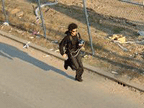
Can You See Me Now?
(from AudioHyperspace of SWR2 RadioART: Hörspiel by Sabine Breitsameter.) Highly recommended: For those who want to experience Blast Theory's live and online game "Can You See Me Now", note the following dates: From 27 September to 1 October 2004, you can take part - corporeal - in Brighton, UK, and from 28 to 31 October 2004, join the game in Barcelona during the "ArtFutura"-festival. Those who cannot make it to these places: It is also fun to join the game online. [more]
Posted by newradio at 10:48 AM | Comments (0)
Automated Prayer Machine

Immersive Radio
The Automated Prayer Machine repositions radio as an antidote to despair. We create an expansive radiophonic sound environment by manipulating signals rebroadcast through a low-watt FM transmitter to multiple receivers in the audience. Digital video projection, live accordion, violin and voice complete the circuit, activating the metaphorical prayer machine.
"Bridging locative media and radio, as well as offering a critical and feminist voice, is the work of Anna Friz...and Annabelle Chvostek...Automated Prayer Machine...seeks to "proactively change the function of radio" by integrating radio speakers into (what was) the audience, thereby "activating acoustic listening space that also has a radio quality... making one aware of being out in the audience, in an immersive radio experience."
Mixing live radio samples, shortwave noise, fundamentalist talk radio, and prayers sent via voicemail and email, Chvostek and Friz are reinserting community voices and empowering wireless practice and discourse by spanning the tradition of radio with an awareness of context and location that addresses the crucial tensions of the wireless arts. For Friz, "radio addresses the same subjects new media tried to address. The hopes are and were the same, the barriers are the same: Who are you when you are in this mediated state? What is it that you want? How profound is this communication, and through the distance and nearness of geography? In new media, the tool still leads the work: beware the tool that leads." From "Sound Tracks and Data Footprints Stalking the footfalls and echoes of the wireless invisible," Tobias C. van Veen, HorizonZero, Issue 15.
Posted by jo at 08:39 AM | Comments (0)
The web is a living organism project
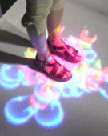
symbiotic relationships
the web is a living organsim project is a net.art installation in both hyper and physical space. It is trying to examine the relationship between internet users, information and the internet itself in the same way we look at the relationship between blood cells, Oxygen and the body itself. By this equation comes a great opportunity of discovering a new model for politics- based on the idea of Symbiotic Relationships. The interactive composition is an examination of microscopic activity inside an internet tissue.
The participants/users are invited to take part in the installation's game system. [1] Each participant/user types in a search string he would like to discuss. [2] When stepping into the interactive stage, he is joined by a microbe. The microbe is a digitally-crafted animated avatar based on the aesthetics of microbiology. Each microbe projects a unique sound and has a unique style of movement. The microbe is powered by a search engine (at this stage we have integrated Google, Altavista and Lycos). [3] In physical space, the interactive stage serves as a screen for a projector that beams from its top. The Microbe is projected upon the user and follows his movements. The search string is projected on the floor right after being submitted. [4] Stepping on text on the floor with the microbe sends the text to the microbe's search engine and returns the title of the first search result. The new text replaces the old ones and become new triggers for a search. The composition creates a conversation between users using search engines combined with a live interactive music score. [5] The work will be available online (controlled by the users mouse&keyboard) constantly like any other net art work but will reach it's full potential in the form of realspace installation that interacts both online users, activating their microbes through the use of the mouse, and physical participants, moving their microbes by the movement of their bodies.
[see online interactive demo for a better grasp of the composition]
The project deals with issues within the discourse of net-ethics, but tries to use the artistic method to create an experience which is theoretically challenging on one hand and pure fun on the other. It is using a physical computed tracking system conjunct with live internet search-engine activity, interactive visuals and sounds and a game system to deliver the concept.
Posted by jo at 08:00 AM
September 16, 2004
Extensions Online Journal

for Embodied Technology
The editors of Extensions: The Online Journal for Embodied Technology are pleased to announce the launch of Volume One. Included are six provocative essays by authors concerned with the many new points of contact between our bodies, digital technologies, and aesthetics; and six artworks engaging themes of memory, identity, perception, and performance.
EXTENSIONS is produced by the UCLA Dance and New Media Project. The Project brings together graduate students and faculty from the departments of World Arts and Cultures, Design Media Arts, and Film/TV to explore new intersections between dance and emerging technologies and how virtual space affects our sense of the body, place, culture, and collaboration. Founded in 2002 by Norah Zuniga Shaw, the Dance and New Media Project produces EXTENSIONS and presents annual dance on camera screenings for new work by UCLA students and faculty.
Posted by jo at 09:46 AM | Comments (0)
September 13, 2004
Mobile Feelings
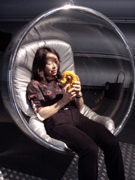
Involuntary Actors
"While mobile phone users are generally glad to embrace the enormous advantages of being reachable any-time and any-where, a reduced sense of privacy combined with the involuntary witnessing of anonymous people's private businesses has created a strange and sometimes awkward form of self-awareness and attention towards others. Mobile phones have transformed ordinary people into actors who narrate their most private details on the theatrical stages of train stations, restaurants, public spaces, streets, meeting areas, and any other social gathering places.
"Mobile Feelings is an artistic project that explores the ambivalence of sharing personal information with an anonymous audience. Instead of communication via voice or images to people we know, Mobile Feelings lets people communicate with strangers through virtual touch and body sensations including smell and sweat using specially designed mobile phones." Read more.
Mobile Feelings, a work by Christa SOMMERER & Laurent MIGNONNEAU, was part of Transmitter, April 21st - May 23rd, 2004; Kunsthalle Dominikanerkirche and around the city of Osnabrück.
Posted by jo at 11:58 AM | Comments (0)
September 09, 2004
tanz performance köln

European Complements
tanz performance köln founded in 1989, develops concepts and realizes dance-related series, festivals and dance film programs, that are representative of new developments in contemporary dance both nationally and internationally including projects with a strong focus on new media technologies. Their projects include DAMPF_lab, an interdisciplinary collaborative project fostering new and distinctive art works of high quality that integrate interactive media technologies with the performing arts while seeking insight into questions such as: how do emerging software practices impact performance; what is the experience of the performer on an interactive stage; how are the relations between maker, performer and audience still shifting; and what are the aesthetic/social consequences?
tanz performance köln partners include:
Animax Multimedia Theater (est. 1999) of the Bonn Development Workshop for Computer Media (est. 1985) focuses on the roduction/presentation of media arts and provides an outstanding operational basis for the exploration of new interactive technologies in the area of performance arts and immersive arts.
Ars Electronica Center/Futurelab offers one of the best-equipped and most efficient research and development workshops for Interactive Spaces, Virtual Environment and Digital Surfaces in the context of Ars Electronica which has been an internationally unique showcase for digital art and media culture and encounters between the arts and sciences since 1979.
V2_Lab is the aRt&D department of V2_, Institute for the Unstable media (est. 1987) that concerns itself with research and development in the field of art and media technology and brings to the project a variety of knowledge/ expertise derived from an interdisciplinary approach to the field of unstable media including specific critical perspectives.
Partners work on the following complementary strands:
research labs aiming to generate shareable outcomes by drawing questions from and in turn supporting the creative work of the co-productions; stimulating other new artistic work; innovating technology solutions together; and devising unique dramaturgical and user testing approaches to the artistic process. In addition, the labs will gather documentation to contribute to theoretical and educational approaches to this area of work.
co-productions aiming to nurture and help realise two specific art works: composer/director Klaus Obermaier working with the Ars Electronica Futurelab to develop interactive media technologies for use in a new performance for the stage; and choreographer Angelika Oei working with the V2_Lab on the creation of a large scale performance/ interactive media installation work.
Associate researchers:
Matt Adams (Brighton/ London)
Daniel Aschwanden (Vienna)
Johannes Birringer (Nottingham)
Carol Brown (London), Nuria Font (Barcelona)
Nik Haffner (Frankfurt/ Barcelona)
Prue Lang (Frankfurt), Cindy Lee (London)
Martin Kusch (Vienna/ Montreal)
Christopher Salter (Berlin)
Stephanie Thiersch (Cologne)
Ariella Vidach (Milan)
Posted by jo at 01:09 PM | Comments (1)
September 08, 2004
Transmute
emotional and spatial residue
 Intimate Transactions: First Proof of Concept by Keith Armstrong + The Transmute Collective (c) 2003: "A performing body carves through the space, energizing & sculpting the environment in which it inhabits. Stillness is very important. The moment before & after a movement is crucial. The emotional & spatial residue left behind from each action is where the drama lies." Lisa O'Neill
Intimate Transactions: First Proof of Concept by Keith Armstrong + The Transmute Collective (c) 2003: "A performing body carves through the space, energizing & sculpting the environment in which it inhabits. Stillness is very important. The moment before & after a movement is crucial. The emotional & spatial residue left behind from each action is where the drama lies." Lisa O'Neill
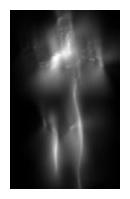 And, from the introductory essay by Linda Carroli (c) 2004: "Presently, in Brisbane, 'mixed reality' works...are emerging as a focus for artistic and creative industries research with several projects currently in development. Transmute's core ideas were presented in an "evolving audio-visual experience driven by a highly tactile interface that requires active physical engagement. Individual participants...navigate by either drifting or traveling actively within a landscape comprised from ghostly bodies, dynamic texts and emergent sound." To be more specific: The work is comprised of several elements including a 'body shelf' designed by Zeljko Markov which is the interface; interactive imagery comprising a text-based non-narrative drawing on the story Smog by Italo Calvino and an interactive imagescape based upon a single, ambiguous body image (pictured left) which dissolves, morphs and transforms between states of sublime calm and pixillated agitation; and a fluid interactive soundscape designed by Guy Webster (and his collaborators Woods and Jenkins). Participants are literally shelved on the body shelf in which a number of sensors are positioned to correspond with their hands, feet and back."
And, from the introductory essay by Linda Carroli (c) 2004: "Presently, in Brisbane, 'mixed reality' works...are emerging as a focus for artistic and creative industries research with several projects currently in development. Transmute's core ideas were presented in an "evolving audio-visual experience driven by a highly tactile interface that requires active physical engagement. Individual participants...navigate by either drifting or traveling actively within a landscape comprised from ghostly bodies, dynamic texts and emergent sound." To be more specific: The work is comprised of several elements including a 'body shelf' designed by Zeljko Markov which is the interface; interactive imagery comprising a text-based non-narrative drawing on the story Smog by Italo Calvino and an interactive imagescape based upon a single, ambiguous body image (pictured left) which dissolves, morphs and transforms between states of sublime calm and pixillated agitation; and a fluid interactive soundscape designed by Guy Webster (and his collaborators Woods and Jenkins). Participants are literally shelved on the body shelf in which a number of sensors are positioned to correspond with their hands, feet and back."
Posted by jo at 11:40 AM | Comments (0)
September 07, 2004
UNSTABLELANDSCAPE

Dance and Mutable Media
"I envision the development of UNSTABLELANSCAPE beyond the local performance and gross movements of the dancers towards the use of autonomous streams of data, subtle measurement of biological functions (breathing, heart beat, earth movement, GP systems and distributed performance using the internet)...I would like to explore the augmentation of the system hybridicity and maximizing its bottom-up architecture with the integration of organic tissue such as neurons and muscle cells to the real time aspect of the video-sound-movement continuum (residency at Simbiotica, Australia). Later, I will expand the performance with this bio-digital generativity and with analog/biologically inspired robots. It is a continuation of the aesthetics of emergence."
marlon barrios solano
Posted by jo at 10:06 AM | Comments (1)
September 04, 2004
Work by Don Ritter
Physical Aesthetics
"Unlike art from previous times, interactive art considers the viewer’s body as an integral component of the experience; the quality of this experience is measured by the term physical aesthetics, being the pleasantness or unpleasantness of the physical experience involved with the control of an interactive experience. The involvement of a viewer in an artwork could be viewed as being more democratic than the autocratic experiences presented by older art forms." Read the full interview.
![]()
Vox Populi endows anyone with leadership, regardless of their personal wealth, family origins, or political connections. A video projected crowd chants "speech, speech" and encourages visitors to speak from a lectern. When a visitor speaks through the microphone, the voice is amplified and political speeches begin scrolling on a teleprompter located within the lectern. In response to a speaker’s voice, the crowd reacts with varying degrees of support and repulsion.
Other works by Don Ritter (Real movies available on site):
The Technophobe and the Madman: Internet-2 distributed musical
telecommunications video-music performance, 2001; 12 channels audio and 6 channels full screen video connection between Frederick Loewe Theatre, New York City and iEAR Studio, Troy, New York; collaborative performance: performers share audio and video between 2 cities.
Performance Telematique: Interactive telecommunications performance between two cities, 1993; PictureTel system, two channels full screen video and two channels audio Obscure, Quebec City, and McLuhan Program, University of Toronto, Canada (500 miles, 800 km).
Nervous Orpheus: Interactive telecommunications performance between two cities, 1994; PictureTel system, two channels full screen video and two channels audio; Vancouver and Toronto, Canada (2800 miles, 4500 km).
Posted by jo at 11:34 AM | Comments (0)
September 01, 2004
Observing the net
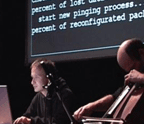
Ping Me a Melody
"Ping Melody is a music-net-performance. Temporary and unique state of all actions of Internet users has an influence on form of music composition. Musician (instrumentalist or singer) is playing on acoustic instrument/singing and sounds coming from instrument/voice are shared in packets of data information (granulated), then transmitted to selected Internet location (as "ping" unix command).
Most of net artists are using some specific possibilities of Internet: they are working with WWW, streaming, etc. In Ping Melody I treat Internet not so much as a tool which functions in given way, but as a space, that can be observed."
Posted by jo at 06:43 PM
August 30, 2004
Benoit Maubrey
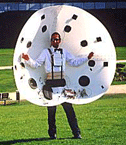
strutting and projecting his stuff
AUDIO PEACOCK is the most recent performance by Benoit Maubrey (2003). These wearable electronic instruments are constructed from polycarbonat plexigalss material shaped into a peacock's fan-like plumage. The plexiglass surface is equipped with 16 loudspeakers (150 watts power), amplifiers, and rechargeable 12 volt batteries. The "audio-plumage" is highly directional and functions like an electroacoustic radar dish--esthetically it has much in common with the way a peacock parades itself in front of the pea-hen (the audience). An Audio Peacock can either amplify its own electronic instrument and voice or receive sounds from outside sources via transmitter/receiver and disseminate them in a space by orienting his high-tech "plumage." Four Audio Peacock units can be acoustically choreographed as a mobile quadrophonic loudspeaker system.
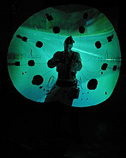 VIDEO PEACOCK: An Audio Peacock costume (constructed from white polycarbonat-plexiglass) is used as a mobile projection screen. This is a solo audio-visual concert where the electro-acoustic quality of an Audio Peacock is visually enhanced via a video beamer: moving images (both live and recorded) can be projected directly onto the performer's costume. A story is told "live" by a figurant who simultaneously samples his own amplified voice, manipulating the sound (loop and pitch): the performer dubs his own hallucogenic dream. View video (33.4 MB, Quicktime)
VIDEO PEACOCK: An Audio Peacock costume (constructed from white polycarbonat-plexiglass) is used as a mobile projection screen. This is a solo audio-visual concert where the electro-acoustic quality of an Audio Peacock is visually enhanced via a video beamer: moving images (both live and recorded) can be projected directly onto the performer's costume. A story is told "live" by a figurant who simultaneously samples his own amplified voice, manipulating the sound (loop and pitch): the performer dubs his own hallucogenic dream. View video (33.4 MB, Quicktime)
See a brief history with images of Maubrey's work.
Posted by jo at 02:00 PM | Comments (0)
Christophe Bruno
FashMobs and WiFi-SM
I came across this post on boing boing today: it suggests the possible fascist undertones of flash mobs, "depending of course on who organizes the particular gathering, their motivation..." It then refers to Christophe Bruno who has created a net art work called Global Artists. Bruno asks "Imagine that the history of the world was turned upside-down and that the historical characters who left their mark in our schoolbooks, were reincarnated as... artists. What works of art would they produce?" One example he gives is FashMobs by A.Hitler:
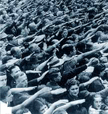 "I created a website where people can leave their mobile phone number. The idea is that when the number of people is large enough, a SMS instruction is sent to all of them simultaneously by the server. When they receive it, people have to perform the instructions. The instructions are simple ones, like raising an arm, but the effect is amplified by the fact that many people do it in the same place, at the same time, as in a symphonic orchestra."
"I created a website where people can leave their mobile phone number. The idea is that when the number of people is large enough, a SMS instruction is sent to all of them simultaneously by the server. When they receive it, people have to perform the instructions. The instructions are simple ones, like raising an arm, but the effect is amplified by the fact that many people do it in the same place, at the same time, as in a symphonic orchestra."
Similarly disturbing is WiFi-SM: Feel the Spectacle of Pain. 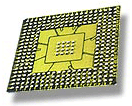 "You have the impression that the disasters of the world do not touch you anymore? You feel vaguely sorry for other people's misfortunes but you don't feel the inner urge which used to make you help your neighbour? WiFi-SM is the solution!"
"You have the impression that the disasters of the world do not touch you anymore? You feel vaguely sorry for other people's misfortunes but you don't feel the inner urge which used to make you help your neighbour? WiFi-SM is the solution!"
Bruno reminds us that, as always, technologies can be abused and/or produce the opposite effects for which they were orginally intended. Or, is this what they were orginally intended to do?
Posted by jo at 10:59 AM | Comments (1)
August 27, 2004
SPEAKERS CORNER

dialogue between the street, the web and people's mobile phones
From "Interactive Street Interface" by Jaap De Jonge: Speakers Corner is a 15 metre long interactive LED text display fixed to the outside of The Media Centre in Huddersfield. Running 24 hours a day, 365 days a year, Speakers Corner will display a wide range of content, information and news, providing entertainment and services to people using The Media Centre and the local area.
Users can interact with content on the screen in three ways by sending a text message, by using the phone booth outside The Media Centre which converts speech into text, or by adding comments from the web at www.speakerscorner.org.uk. Users' comments are then archived in the database and sent to the display, building a dialogue between the street, the web and people's mobile phones.
Read more at Patrick Lichty's [re]distributions.
Posted by jo at 10:20 AM | Comments (0)
August 25, 2004
Poetrica

Teleintervention
Poetrica is an investigation about reading and reception in cybrid and entropy situations. The project involves a series of visual poems conceived by Giselle Beiguelman with non-phonetic fonts (dings and system fonts), a DVD, digital prints, movie trailers and a teleintervention which allowed to anyone compose visual messages and submit them, by the Web or SMS, to three commercial electronic billboards located in downtown São Paulo, using the same typographic background she used in her nomadic poems.
Posted by jo at 07:51 PM
August 24, 2004
Media Psychosis
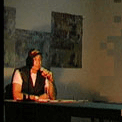
Live Rant
Rant/Rant Back/Back Rant, by G.H. Hovagimyan and Peter Sinclair, samples and re-mixes news report catch-phrases cycling through the global information environment. The work looks at the use of targeted language within the framework of mass media, and posits a media overload psychosis embodied by the live performance word jam created by Sinclair and Hovagimyan. Two live performances will be performed at Groningen Museum and STEIM, Netherlands and streamed live on August 23rd and August 26th.
Peter Sinclair and G.H. Hovagimyan have been artistic collaborators over a number of digital performance and installation works. Mr. Sinclair who is a well-known sound artist lives in Marseille, France while Mr. Hovagimyan who is a multi-media artist lives in New York City.
Sinclair’s works have recently been highlighted in the French contemporary art magazine artpress. (Art Press special edition, number 24, 2003. Le Burlesque. Une Aventure Moderne.) One work, A SoaPOPera for iMacs done in collaboration with Hovagimyan will be included in a historic exhibition called Le Burlesque that will be on view in Paris at the National Galeries Jeu du Paume Museum in 2005. Documentation and video of this work can be seen at: http://nujus.net/gh_04/gallery3.html
Part of the inspiration for the work Rant/ Rant Back/ Back Rant developed out of xenophobic rants that Sinclair encouraged Hovagimyan to do for their 2001 Interactive sound and laser installation work titled Shooter. You may view documentation and video here: http://nujus.net/shooter-new-site/index.html
Their latest work Rant/Rant Back/ Back Rant will be performed in the Netherlands at the Groningen Museum, August 23rd and August 26th at STEIM, Amsterdam.
While investigating synthetic voice programming in 1996 Hovagimyan met Peter Sinclair. The two began to collaborate on a series of works that used text and synthetic voice as an element for robotic performance and installation work. Sinclair brings to the collaboration a fascination with the mechanic possibilities inherent in programming and digital art as well as his expertise in the realm of sound art and performance works. Indeed, before meeting Hovagimyan, Sinclair was quite accomplished as a performance artist in France. A survey of his works can be seen at: http://www.nujus.net/peterhomepage/html/
Hovagimyan brings to the piece a long history of using text within his work both individually and in collaboration with Sinclair. In 1994 Hovagimyan did a billboard campaign for Creative Time in New York City. The billboard , Hey Bozo… Use Mass Transit, used a block of text somewhat in the manner of rap lyrics. Documentation as well as an NBC news report can be seen
at: http://nujus.net/gh_04/gallery2.html
In 2000-2001 Hovagimyan created a series of rant performances for the palm pilot called Palm Rants. Documentation can be viewed at: http://nujus.net/gh/html/rants.html. An example can be seen at http://nujus.net/gh_04/video/entertainMenow.mov
As far back as 1974 Hovagimyan has been using agit-prop as part of his work. Indeed a 1974 work Tactics for Survival in the New Culture was shown in a 1978 group show called Manifesto organized by Collaborative Projects in New York City. Subsequently, in 1994, Hovagimyan updated the piece, turning it into a hypertext work and one of the earliest examples of what is now known as Net Art. The work can be viewed online at: http://www.thing.net/~gh/artdirect/tactics.html
Their collaborative works as well as their homepages can be accessed via the web at: http://nujus.net (note the site uses pop-up windows and javascript. Enable scripting and pop-up windows to view the site)
Posted by jo at 11:28 AM | Comments (1)
August 23, 2004
Dissension Convention
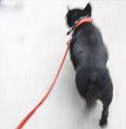
A Transatlantic Collaborative
Multimedia Protest Jam
Dissension Convention will coincide with the Republican Convention in New York. 10 pairs of net/digital artists from the Americas and Europe will create live, online multimedia performances. These will be projected at RNC NODE Postmasters Gallery, as well as by other appointed NY platforms in 'store windows, bars.'
5 days of live mix performances, online in real-time from 29th August-2nd September between 12noon and 6pm (NY time) via Furtherfield's VisitorsStudio.
If you are viewing from home you can visit versions mirrored on the artists' websites (check project URL for updates).
* If you wish to mirror this event on your site please target this file http://www.furtherstudio.org/live/dissensionconvention.swf
Programme Participants:
Sunday 29th August
4-7pm NY (9-12pm BST) *Maya Kalogera & Marc Garrett*
7-10pm NY (12-3am BST) *Moport.org & Glowlab.org*
Monday 30th August
4-7pm NY (9-12pm BST) *Chris Webb & Sim (Soy.de)*
7-10pm NY (12-3am BST) *Lewis Lacook & Alan Sondheim, Sheila Murphy & Jason Nelson*
Tuesday 31st August
4-7pm NY (9-12pm BST) *Helen Varley Jamieson & Karla Ptacek*
7-10pm NY (12-3am BST) *Joseph and Donna McElroy*
Wednesday 1st September
4-7pm NY (9-12pm BST) *Neil Jenkins & Roger Mills*
7-10pm NY (12-3am BST) *Digitofagia vs. Autolabs*
Thursday 2nd September
4-7pm NY (9-12pm BST) *Michael Szpakowski & Ruth Catlow*
7-10pm NY (12-3am BST) *Ryan Griffis & Mark Cooley*
Postmasters Gallery is creating RNC NODE, a way-station, serving as a physical node of an ad-hock public broadcasting, a system of online, real time protest performances and alternative news actions. All online streams will also be output in local bars and projections from windows. Dissension Convention will be part of this programme.
DissensionConvention is a Furtherfield project.
Posted by jo at 10:06 AM | Comments (0)
August 21, 2004
Demonstrate
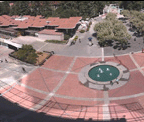
Emergent Opinion
On September 1, a team at UC Berkeley led by Ken Goldberg will reveal the world's most advanced webcamera. Dubbed Demonstrate, the camera allows anyone online to watch what's happening at Berkeley's Sproul Plaza, the birthplace of Free Speech Movement in 1964. The student movement will celebrate its 40th anniversary this coming month.
Users are able to control the camera, capture and post photographs and write comments for one another. Among crowds, juries, and voters, opinion emerges from a dynamic interplay of actions and influences.
Posted by jo at 11:35 AM | Comments (0)
ultra modern - very social
Another Motherboard project, ultra modern - very social is a streaming theatre concept for 2002 and beyond. This space is dedicated to the pursuit of experimental theatre which is somehow modulated and mediated by the intermediary influences of the net, but may also involve communcation appliances such as telephones, mobile phones, walkie-talkies, radio, etc. Our emphasis is on improvisation and experimentation where "here and now" and "there and then" are relative expressions in collaborative networked spaces.
Posted by jo at 11:31 AM | Comments (0)
August 20, 2004
murder
Those were the themes in an interactive, fictitious murder mystery and sightseeing tour developed by four graduates of the Canadia Film Centre's Habitat Lab, Toronto. The idea was to let participants tour the neighborhood while at the same time trying to solve the mystery. En route they visited the Gladstone and Drake Hotels, the Beaver Cafe and the DeLeon White Gallery, gathering clues and directions by dialing their cellphones, reading text messages, and examining physical evidence and computer displays at different sites.
The mystery/sightseeing tour was a prototype. It lasted only two days, but interesting developments were expected. Regrettably Ian Harvey, a journalist and one of the project's producers was the only person named in the Globe article.
Posted by newradio at 05:26 PM | Comments (2)
Motherboard
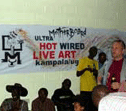
Ultra Hot Wired Live Art
In February 2003 a group of artists from Norway, Germany, Holland, Canada, England and Austria, working together on a project called Ultra Hot Wired Live Art initiated by Motherboard and BEK traveled to Kampala with 15 powerful Macintosh computers in their baggage. The aim was to create African computer art in an attempt to answer Brian Eno's question: "How can you africanize a computer"?
In collaboration with over twenty artists and musicians in Uganda, the artists held a workshop to share competencies in music and art production that utilize digital tools and the Internet. This was to develop a social and technical infrastructure for the creation of networked performances and future collaborations. More info
Posted by jo at 04:10 PM | Comments (0)
Responsive video jewellery
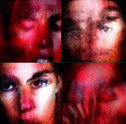
Capturing Neuroses
Medulla Intimata introduces a new form of non-verbal communicaton in the form of responsive video jewellery. Video displayed on a screen embedded in the jewellery is generated in real-time in response to the wearer's emotional state by monitoring the dynamics of conversations in which they are engaged.
Medulla Intimata explores social performance. Every interaction in a social setting starts as a performance of selves, a formal dance of introduction and a search for expression. Medulla Intimata provides a medium in which to visualise this informal social performance, allowing the interactors to monitor and feed off their mutual performance, and others to act as sporadic audience. Read more.
Posted by jo at 12:05 PM | Comments (0)
where are we eating?
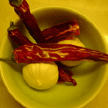
Digesting Sound
where are we eating? is a translocal radio feast. Site-specific dining at ISEA 2004 and around the world. This is a project which aims to nourish. "We are interested in exploring hybrid transmission spaces dispersed and mobile modes of exchange, eating as a particpatory performance, cooking as a collaborative creation."
where are we eating? radio feast will be broadcast on 21-22 August 2004 on ÄÄNIRADIO 103.1 FM, online and on the streets of Helsinki where Grilli Radio will explore the local foodscape.
Posted by jo at 11:52 AM | Comments (1)
August 18, 2004
play that space
Intelligent Street
Intelligent Street by the Swedish/UK group Ambigence is a multi-space interactive sound installation that processes text message commands sent via mobile phones to create an ever-changing musical composition. The text commands determine the mood, energy and style of the music. The intention is to use the music to create a more flexible space and a more stimulating environment, where the users of the space become the co-creators of the musical composition.
iHiFi-the intelligent hi fi
iHiFi by the Ambigence group is an extension of the domestic hifi and is used in a domestic environment to provide music as a source of entertainment according to taste, mood and user activity. Unlike a standard hifi it has an intelligence that gives it a flexibility to change and adapt the content of the music to provide a personalised or enriched experience for the user. The idea is to create not consume. The catch may be that you have to buy it first.
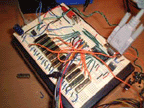
Speaker Phone
Jonah Brucker Cohen did something similar to this with his SpeakerPhone project where a sequence of individually addressable speakers could be controlled with a mobile phone and sound targeted instantly to a precise location and to travel along a path. The project enables a range of presence applications including the creation of highly customized spatial soundscapes and the transmission and layering of sound information across multiple locations in space or time.
Posted by jo at 07:18 PM | Comments (0)
coffee and avatar, please
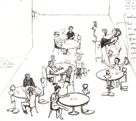
The Chit Chat Club
It will be a real cafe, with real tables, real coffee and pastries...some of the chairs will be regular chairs;... others will be seats for avatars, equipped with monitors and network connections...There are multiple ways to interact ... in the Chit Chat Club. As in an ordinary cafe, people can walk into the physical Chit Chat Club space, order a coffee, sit down and talk with others and people watch. One can also enter the Chit Chat Club remotely through the website and occupy an avatar chair. This action opens a real-time two-way audio and graphical connection between the physical space and the online participant. Finally, a person physically present in the Chit Chat Club space may also occupy an avatar chair.
Sounds fun to me. Check out the website
Posted by newradio at 05:47 PM | Comments (0)
Telematic Dreaming
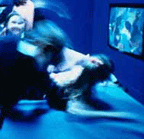
Touch at the Speed of Light
Telematic Dreaming [1992, Paul Sylvester Sermon], with its connotations of intimacy and dream states, extends telepresence beyond the screen to spatialize the site of interaction and transform it into a live theatrical event in which visitors are key performers. The work explores presence, absence and the psychology of human interaction within technologically mediated communications. Read an essay by Paul Sermon; more telematic works by Paul Sermon.
From medienkunstnetz>
...Sermon uses video-conferencing to connect people in different places, which enables communication with mime and gestures and results in astonishing, almost intimate encounters. In Telematic Dreaming a bed is the medium for high-definition images; images of a partner who is perhaps thousands of kilometers away, in live and intimate proximity. The clear projection of another person, who is able to react almost in real time to the other's movements on the bed, is so surprisingly suggestive that to touch the image of the body that is projected onto the sheet becomes an intimate act. Sermon's declared aim was to expand the user's sense of touch: obviously it was not possible to actually touch the other virtual bedmate, but one experienced the suggestion of touching through rapid and vigorous or tender and reflective movements. Many users said that they found it a very contemplative experience; a sensory impression achieved synaesthetically where hand and eye fuse. This quality distinguishes both Telematic Dreaming and other works that Sermon produced in subsequent years.
Posted by jo at 05:11 PM | Comments (1)
August 12, 2004
SimpleTEXT
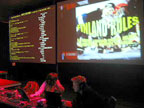
zeitgeist performing
SimpleTEXT is a collaborative audio/visual public performance that relies on audience participation through input from mobile devices such as phones, PDAs or laptops' (from simpletext website). This installation, created by mixing and matching older software projects by Jonah Brucker-Cohen, Tim Redfern and Duncan Murphy, accepts real-time SMSs and text messaging in order to create live music and visuals. The software first parses the text, which dictates the music, then uses these messages to rhythmically drive speech and picture synthesizers (direct from the web using google's image search). Although I've never seen it, my guess is that the most interesting part of this performance would be seeing a dialogue emerge between the piece, the performers, the audience SMSing in the space, and the audience texting from the web. A zeitgesit of ASCII that reiterates.... iterate.... iterative.... (ad nauseum) (Posted by Nathaniel Stern)
Posted by at 02:57 AM | Comments (0)
August 10, 2004
Silent Cell Network
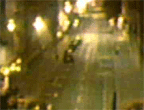
Silent Dystopia
After taking part at the International MICRO performance in Ljubljana/Slovenia, Silent Cell Network performs live again: August 11, 2004, 1:30 AM, GMT+1 (Paris/Berlin time); performed at an unknown location and broadcast live on the net. Silent Cell Network is an international group of multimedia artists, this time joined by Hooman Sharifi. Sharifi is an established Iranian performer, dancer and choreographer, living and working mostly in Norway and Belgium.
Posted by jo at 08:46 PM | Comments (0)
August 09, 2004
MYRIORAMA
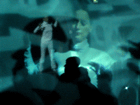
responsive performance space
ambientTV.NET and kondition pluriel invite you to MYRIORAMA a locative media dance performance. In London: August 12 & 13 2004, 21:30h at Project Market, Silwex House, Quaker St., E1 6SN; in Helsinki: August 21, 2004 14:00h at Kiasma Theatre as part of ISEA2004 festival. Myriorama explores position- and motion-tracking at widely different scales: across the city, and inside the venue. The wanderer’s location in the city is reported by satellite-based Global Positioning System (GPS), and fed into the venue’s local network via a cellphone network (GPRS) and the internet. Inside, the data are manipulated and transformed in real time by the dancer's gestures, using a wireless sensor system. The emergence of cellphones, GPS, and other location-aware devices seems to favour the local and contextual over the global. However, most of the communication networks that these devices operate in remain centralised and closed.
Once upon a time, in the kingdom of Myriorama, there ruled a king who knew the art of reading and bending the thoughts of his people over great distances, which rendered him famously powerful. One day, a wanderer entered the kingdom...Taking a hint from Italo Calvino's story 'A King Listens', Myriorama unfolds the world of one whose environment is all ears and all eyes; one for whom every whisper and rumour is heard distinctly, for whom every movement is watched and logged. Today, equipment designed for a paranoid king has become the plaything of the people, part of our everyday gadgetry and woven in the fabric of the city.
For this production, ambientTV.NET and kondition pluriel have repurposed location-aware mobile devices, motion sensors and audio-visual transmissions to fashion a responsive performance space that both extends beyond, and is concentrated in the venue itself. The protagonist at the centre of Myriorama tracks his subjects, agents and avatars as they move through the city. The one in the place of the king watches, commands and interprets a mediated world, a domain of data, a screen of projected subjectivities in which inside and outside are entwined.
Posted by jo at 12:59 PM | Comments (0)
Séa.nce
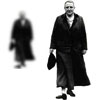
A Sea of Emotions
You are invited to Séa.nce, a networked performance that is part of ISEA2004. Séa.nce--a collaboration between Norie Neumark, Maria Miranda and Greg Turner--is a 'pataphysical' experiment to demonstrate the relays of perpetual emotion on the Internet. Séa.nce will be particularly helpful for those of you who are feeling at sea with your networked emotions.
Please bring your own data. For those on board the ISEA ferry please bring your own laptop. Be there: August 15, midnight–1:00am GMT+2; August 16, 22:00-23:00pm GMT+2 [GMT+2 is Helsinki time]. Bring all that pentup listAngst, emailObsessiveness and spamRage. The Board is here to help.
In the 19th century Etienne-Jules Marey, Henri Bergson, Arsène d'Arsonoval and Marie Curie met to investigate "the manifestations of yet undefined forces" through scientific investigations using Marey's graphing instruments. These investigations attempted to measure radioactivity and electric discharge of hysterics; to study telepathy and levitation; and to hold Seances.
Séa.nce, following these earlier experiments, is based on this popular parlour game from the 19th century. The original Ouija Board was also known as the Talking Board or the Message Board where one would search for answers from the spirit world. The modern equivalent of this 'searching for answers' could be imagined as Google or any search engine for that matter. Are there 'unknown forces' still at play? What happens when answers depend on a network of movement? Read more.
Séa.nce is part of a larger project, The Perpetual Emotion Project, which researches emotion in digital culture. The Perpetual Emotion Project and several other Miranda/Neumark works are at turbulence.org.
Séa.nce was assisted by the Australia Council, the Federal Government's arts funding and advisory body.
Posted by jo at 09:56 AM | Comments (0)
August 05, 2004
cellular trans_actions 091101

Amplifying the Self
cellular trans_actions 091101, a cell phone performance by Victoria Vesna, was part of an exhibition called Avatars and Others. It took place on September 14, 2001. cellular trans_actions consisted of a series of works that looked at our relationship to time, the constant interruptions, and how the rupture of private and public spaces changes us. Cell phones are central to the interactions created in public spaces, amplifying issues related to our shifting perception of self...People were given numbers of others and through the mediation of the cell phone, talked to strangers that they would normally not have more than superficial conversations with. The performance was accompanied by site and time specific installation, recording the flavor of a particular geographic and social location. Read more.
Posted by jo at 06:09 PM | Comments (0)
Ballettikka RealVideo Internettikka
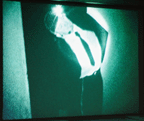
Tactical Ballet
Ballettikka RealVideo Internettikka is the third self-contained action in the tactical project Ballettikka Internettikka, which began in 2001 with the exploration of Internet ballet. The second installment, in March 2002, consisted of Stromajer and Zorman carrying out an illegal ballet invasion in Moscow’s Bolshoi Theater and transmitting it live on the Internet. In Part 3, Grassi, Stromajer and Zorman brought together two Moscow performative acts: the ballet break-in in the Bolshoi and the Chechen terrorist act in the Dubrovka Theater in October 2002. The condensed version of Ballettikka RealVideo Internettikka consists of a video with Morse-code dramaturgy. The net performace Ballettikka Internettikka: ilegallikka robottikka, by intima, will take place in November 2004. (more)
Posted by jo at 05:38 PM | Comments (1)
Spectropolis: Mobile Media, Art and the City
New Urban Experience
Spectropolis: Mobile Media, Art and the City is a three-day event that highlights the diverse ways artists, technical innovators and activists are using communication technologies to generate new urban experience and public voice. The event explores what is possible when wireless communications (both new and old), mobile devices and media converge in public space. The increasing presence of mobile communication technologies is transforming the ways we live, construct and move through our built environment. The participants of the Spectropolis exhibition make obvious or play with this shift, creating new urban perceptions and social interactions with cell phones, laptops, wireless internet, PDAs and radio. In addition to the projects presented in the park, there will be several hands-on workshops and two panels free to the public. Find out more
Posted by jo at 12:41 PM | Comments (0)
August 04, 2004
After the Crash

RICHAIR2030
RICHAIR2030 by TAKE2030 is a fictional wireless performance set in year 2030. RICHAIR2030 incorporates ideas of the freenetwork movement developed worldwide in the early 21st century and proposes shared public consumption of wireless bandwidth in an "After the Net", "After the Crash" scenario.
It is the year 2030. The great wireless hope that promises mobility and connectivity has bubbled. The GPS satellite signals have lost track of its urbanites when cutting through the Ozone layers. The ocean-apart digital divide has sabotaged the Net. What remains of the feeble bandwidth is held and safeguarded by the wireless freenetworkers, whose self-organized and decentralized network maintains its data cloud in local communal mesh-settings. The mobile generation is grounded. The tribal gathering around freenetwork nodes is the only game in town, bringing together the signal-seeking Desparati. The self-appointed renegade roller girls, acting as the Transmitenti of free bandwidth, travel city limits in auto-powered modules. Equipped with homemade lunchbox chiputers, the roller girls pump the remaining wireless signal strength in RGB codes and sonic extravaganzas. RICHAIR2030 mobilizes roaming nodes and calls for trans-national virtual mesh network.
RICHAIR2030 works with London freenetworkers and pays tribute to the world wide wireless freenetwork movement.
RICHAIR2030 team has developed 3 chiputer (compact computer with single chip motherboard) lunchboxes that draw parallels and refers to the techno DIY culture characteristic to the UK media scene at the turn of this century. The software system is based on free BSD, linux and mesh AP applications that allow automated reboots, wireless roaming, and data push at chosen locations. The interface programming further translates raw data into visual and sonic applications. In its compact lunchbox a 256 MB flashcard holds all the data.
RICHAIR2030 is developed by TAKE2030 brave new media society that sets up and manages multiple research+development+action media-working units. TAKE2030 designates its media practices in Commons societies and proposes its strategic programme development till year 2030. Take2030: Ilze Black, Alexie Blinov, Shu Lea Cheang, Chia-liang Kao, Paul Khera, Gio D'angelo in collaboration with East London community network and sonic artists: Supermoden and 1010.org.
RichAir2030 is currently touring the UK. Next performance: August 15, 2004, Bow Arts Festival, London
Posted by newradio at 12:16 PM | Comments (0)
August 03, 2004
Painting the Street
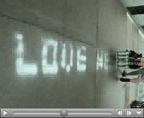
Bikes Against Bush
From "Bike Writer Pedals for Protests" by Leander Kahney, Wired News, August 2, 2004
New Yorker Joshua Kinberg is a bike messenger of a different stripe. Instead of ferrying legal papers between lawyers, he uses a homemade, wireless, bicycle-mounted dot-matrix printer to spray protest messages in the street...[Bikes Against Bush is] "painting on the street, but on the Net, too," said Kinberg, a post-graduate student at Parsons School of Design.
Continue reading at Wired.com
Posted by jo at 10:37 AM | Comments (1)
August 02, 2004
Mesh Performance Practices
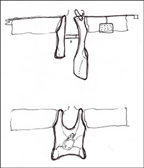
Exiles, Ghosts and Astronauts Physical interventions in the critique of virtual culture
Aura: Film Studies Journal, Volume IV, Issue 1, 1998, Susan Kozel
Exiles, Ghosts and Astronauts was a performance experiment occurring simultaneously between Riverside Studios and The Place Theatre in London (England). The videoconference link was made by Macintosh computers and basic internet videoconferencing software (CU-SeeMe). Performers in each location were projected into the other for a physical exploration of intimacy, weightlessness and altered materiality. It was part of Digital Dancing 1997, the London Dance Umbrella platform for dance and technology collaboration.
As physical exploration is undertaken, with telepresence and other forms of digital intervention in performance, the physical and philosophical vocabularies that emerge are mutually shaped and critical of one another. This article charts a course through philosophical debate and performance practice. Many voices and perspectives unfold across three sections: dialogue with Paul Virilio, devising process, and performance.
Continue reading at Mesh Performance Practices
whisper is a real-time interactive media installation based on small wearable devices, wireless computer communication, and handheld technologies embedded in evocative and playful garments worn by the participants. whisper intervenes aesthetically and critically in the evolution of our human environment by transforming the physical practices and technological interfaces that mediate our physical and emotional interchange. whisper is about creating new physical, technological, kinesthetic & affective vocabularies. whisper is a collaborative project involving artists (dance, sculpture, music), designers (of visuals, objects & textiles), computer scientists, and hardware/software engineers.
Posted by jo at 03:14 PM | Comments (0)
August 01, 2004
Mixed Reality in Los Angeles
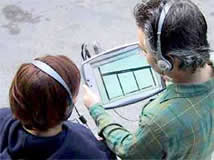
GPS Walkabout
34 North 118 West plays through a Tablet PC with Global Positioning System receiver and headphones. GPS tracks your location to determine how the story unfolds - in real time, in real space, as you traverse the sidewalks of Los Angeles.
Description of Tour: Imagine walking through the city and triggering moments in time. Imagine wandering through a space inhabited with the sonic ghosts of another era. Like ether, the air around you pulses with spirits, voices, and sounds. Streets, buildings, and hidden fragments tell a story. The setting is the Freight Depot in downtown Los Angeles. At the turn of the century Railroads were synonymous with power, speed and modernization. Telegraphs and Railroads were our first cross-country infrastructures, preceding the Internet. From the history and myth of the Railroad to the present day, sounds and voices drift in and out as you walk. Read Narrative Archaeology by Jeremy Hight.
Posted by michelle at 06:07 PM
July 31, 2004
Mobile Culture-Scratching

by Julie Andreyev, at New Forms Festival 2003, consists of 3 cars fitted with video projection on the rear windshield. Each car has a theme determined by the character of the car, and by characteristics of the host city where the fleet is mobilized. The choice of cars for the project reflects the specific car culture of the host city expressed through customization and branding.
Mobile Equipment
The cars are set up with equipment to allow for mobile video downloading, and video mixing using data from the car. While the fleet is mobile, videographers in the downtown site are creating videos for projection on the cars. The themes are used as a guide for them to create footage of the activities of a city's inhabitants.
Networked Process
This footage is uploaded by the videographers onto a web server. Then, the footage is downloaded by the cars as they drive by WIFI (wireless internet) download sites. A sound artist records ambient sound using a microphone held outside the window of one of the cars, mixes this, and plays it back using an FM transmitter. Nearby cars can tune into our frequency and hear the audio sampling. Each car is equipped with a sensor and software patch that interprets data from the car.
Software Interface
For example, one sensor reads data from the engine speed. This data causes a kind of 'jittery' effect to be applied to the video. The faster the car revs, the more 'jittery' the video. In this way, not only are the inhabitants of the city portrayed, but also the car is expressed in the video. After the performance, the cars can be driven into a gallery space where they can be set up to project their archive of the evenings' videos.
Mobile Portrait of the City
The goal of this project is to create a mobile portrait of the city through video and audio sampling of real time events. VJ-Fleet relies on current VJ (or video jockey) culture and the hosting city's local car and social culture. For each performance the project is customized and scaled to reflect the particular nature of the host city.
Posted by michelle at 06:37 PM
Historically Locating Distributed Performance
2004.04.05 Helen Thorington, writing about an early conference proposal:
The following are examples of distributed performances:
Finding Time (Jesse Gilbert, 2000). Finding Time linked performers on six continents in a series of live musical events, each an hour’s duration.
World Wide Simultaneous Dance (1998, Laura Knott). The project took place simultaneously in twelve countries.
In both examples the performers played to audiences in their performance spaces and to a worldwide Internet audience by means of especially created websites.
I then move on to a brief history, beginning with Kaprow's "Hello Hello" in the mid-60s--about which I can find very little information other than that it linked five sites in a television event. And on to Kit Galloway and Sherri Rabinowitz.
But the history is the not the question for me. Internet works resonate with historical issues. But what I'm beginning to think as I research for the conference is that we may already have witnessed the passing of the (pre)structured presentation of large-scale performance works--I keep thinking, for instance, that while Adrift (1997-2001) was very different from other works produced at its time, it was also very traditional. It was a work by three artists (the senders), in which its audiences had no agency at all--Like radio, like television, they were cast in the role of "receivers."

From the Adrift performance
Now...when did it happen?...the Internet environment is in a far more participatory stage and people-interest runs to works/platforms/
environments in which the former viewer can play an active role. Which may begin to explain why there are really not very many interesting large performance works being produced at this time. Not only is the technology still difficult but the environment is no longer congenial.
Or am I wrong? And if not, what does this do for/to our conference?
I'm going to think about this for awhile. Right now my only thought is that if this is so, the conference itself should reflect it and include the many twists and turns performance has taken in the last years.
Posted by michelle at 01:22 PM | Comments (0)
July 30, 2004
Distributed Cinema
SPEC-FLIC
Described by Adriene Jenick as a "Speculative Distributed Cinema Project....a series of fictional events performed as distributed cinema. SPEC-FLIC is a platform for speculation, creative experimentation and imagination among UCSD students, faculty, staff and the larger public. SPEC-FLIC's title refers to speculative fiction (an area of science fiction that is focused less on new science/tech and more on societal impacts) as well as to the size (a "speck") of the PDA-based video frame that serves as the conduit for this durational collective performance. Originally described as a distributed science fiction soap opera in three phases."
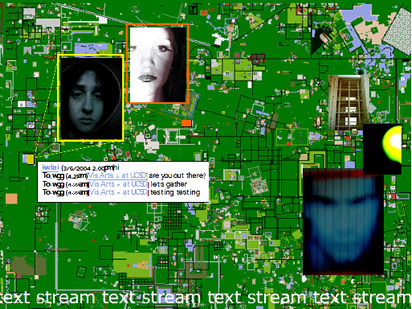
Adriene, tell us about this image.
What is the technology and experience behind this work?
Would you speak about the progression of your work from Paper Tiger television to Desktop Theatre on the internet to Active Campus and Spec Flic on the wireless network?
In your initial post you note these ongoing issues. Can you discuss them by way of examples from your work?
- timing/pacing/duration
this can be thought of from the perspective of participants or from "viewers" - in my experience the "lags" and glitches are all absorbable within the context of a live event. The archiving of this work does not allow for its tension to exist
- relationship of writing to performing, or textuality and orality
this is hugely fascinating to me especially considering the constant evolution of written and spoken language
- use of agitprop to catalyze unexpected engagements
all of my work is engaged within the larger "publc sphere" and cedes a large amount of control to the folks who are engaging with it.
Regarding SPEC-FLIC, your blog shows you in the midst of testing equipment. What are you testing? What is your creative process for working with technology and networks?
Posted by michelle at 09:42 PM | Comments (0)
Distributed Performance or the Left Hand Knows...
July, 1962:
Nam June Paik devised a piano concerto for simultaneous performance in San Francisco and Shanghai, with the left hand part being played in the USA and the right hand in China. The first telecast to Europe and America took place over Telstar 2 in July 1962.
Posted by newradio at 07:33 PM | Comments (0)
What connects the future and the past?
The following comment from Benton Bainbridge frames a question that we, the organizers have been asking since we first thought of this blog. What connects the future and past of networked performance. How has networked performance evolved? What directions has it taken? A real understanding will come from individual replies to the questions Benton has posed. We hope you will make an effort to answer them.
From Benton: "my personal interest would be connecting the dots between the future and the past of networked/collaborative performance. can we advance today's efforts in distance collaboration through global and local digital networks by studying similar ambitions in earlier networked media?
my background is live audiovisual performance. the history of this discipline still hasn't been written, so as a country boy i drew inspiration and guidance from other collaborative arts: live music, underground comix 'jams' and performance art. Laurie Anderson, "Good Morning Mr. Orwell" and Youngblood's "Expanded Cinema" were key triggers too.
i'm curious how networked performance artists on this blog developed their art. how did you get into networked performance; what was your inspiration and how did you map the territory - firsthand R&D or study of past masters?
~benton-c"
Posted by newradio at 07:03 PM | Comments (0)
Networked Local Performances
Three Performances: 2001-03: A Comment
The three location-specific performances Dialtones: A Telesymphony, Flip Flop, and Texterritory --you had to be there to experience them--introduced in the last posts were produced between 2001 and 2003 They made use of networked technologies--mobile phones, video/audio relayed by wireless broadband--to involve their audiences in the creation of the performances. Each has done this successfully in its own way, while maintaining control, in the case of Dialtones, a tight control, over the performance itself.
Posted by newradio at 10:06 AM | Comments (0)
July 29, 2004
Networked Local Performance
Dialtones: A Telesymphony
Dialtones, as described on Golan Levin’s web site, "is a large-scale concert performance whose sounds are wholly produced through the carefully choreographed dialing and ringing of the audience's mobile phones. Because the exact location and tone of each participant's mobile phone can be known in advance, Dialtones affords a diverse range of unprecedented sonic phenomena and musically interesting structures."
Preparatory to the concert, members of the audience register their wireless telephone numbers at secure Web kiosks located in the performance space. In exchange for this information, they then receive seating assignment tickets for the concert venue. New "ringtones" are then automatically downloaded to their handsets. During the concert, a small group of musicians perform the phones en masse by dialing them up with a specially designed, visual-musical software instrument. "Because the audience's positions and sounds are known to the Dialtones computer system, the performers can create spatially-distributed melodies and chords, as well as novel textural phenomena like waves of polyphony which cascade across the crowd; these musical structures, moreover, are visualized by a large projection system connected to the performers' interfaces. Towards the end of its half-hour composition, Dialtones builds to a remarkable crescendo in which nearly two hundred mobile phones peal simultaneously."
Posted by newradio at 06:26 PM
Networked Local Performance
Flip Flop
Flip Flop comprises a group of motion poets, cyborgs, and sound, video and net-artists who collaborate on ‘site-specific remote connection theater performances’ that, in their words, "challenge boundaries between audience and performer, on-stage and off-stage, the venue and the street outside."
For instance: the audience is invited to a party where, over the course of the evening, one of the partygoers (actor and motion poet Ajay Naidu) emerges as a performer, and the audience gradually realizes that it is participating in theater. As the performer shifts between private conversation and "narrative outbursts," the event shifts in mood and form.
Simultaneously, a performer, equipped with a wearable multimedia-streaming computer roams the neighbourhood. The route is choreographed to synchronise with the performers story, and a live "point-of-view" video feed (as well as audio) from the wanderer is relayed by wireless broadband to the performance venue. Flip Flop was performed in July, 2002. Read a report on Live Streaming as Dramaturgy.
Posted by newradio at 06:17 PM
July 28, 2004
Networked Local Performance
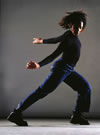
Texterritory v.2.3
Texterritory is a playground performance concept in which the audience has control over physical bodies (dancers and musicians) along with lighting, music and midi system at specific times during the performance. Their influence alters the direction of each performance. Texterritory was performed in May 2003 at the Mumford theatre in Cambridge (UK). Its plot is described as follows:
"Grace, a Legal Secretary arrives home early to prepare herself for her first real date with Jerome. She’s just bought a new pair of shoes to go with one of those outfits. At the moment she drops her keys on the kitchen table, the text arrives from J — he has been delayed but will be there soon. From optimism to despair from knowing to kneeling in prayer, Grace's dilemmas and insecurities unfold as she figures out what to do with this unexpected time on her hands. Together with the influence of the audience she decides exactly what to wear, who she might call if he doesn't show up as well as trying to reassemble a photofit image of what Jerome really looks like."
The multi-media, non-linear narrative "is told through texting/photo-messaging, dance, music, spoken word and animation."
Texterritory makes use of a mobile gateway created by new media company Digit. Computers that tally the results of text messages sent to the audience and derives instructions for the performers from them. It thus gives the audience a certain amount of interactive control over the physical bodies, music and lighting at specific times during the performance.
Posted by newradio at 05:52 PM | Comments (0)
July 27, 2004
Networked Streaming Audio Performance
forwarded by Shu Lea Cheang -
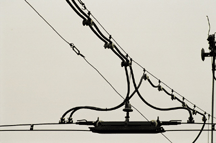
TRAMJAM - VIENNA RUSHHOUR by Mumbai Streaming Attack
A multi-track-multi-driver mix hub streaming jam session of Vienna city vibe, orchestrated in sync with the city's tram routing schedule.
TRAMJAM is a project that Shu Lea Cheang started when teaching networked performance at Zurich's HGKZ. The work will go on to other cities where there are tramlines. The next stop- Rotterdam and the Deaf Festival ’04 Affective Turbulence: The Art of Open Systems in November.
Thanks for sharing this event Shu Lea.
Would you comment on your involvement in this project?
Can you, for instance, compare the Zurich and Vienna experiences?
Is there online documentation of the Zurich events that you can direct folks to?
Collaborative and collective process is really important to us (blog & conference organizers) and we see it as a core component of networked_performance - both within groups developing work, and with the inclusion and contribution of viewers/users/participants/ to the work. The website notes that 'the Mumbai Streaming Attack study group expands to include local participants for each performance'. Do you mean in the respect that participants can upload sounds and contribute in that manner - or do you also connect with local artists for implementation/augmentation of prior iterations of the work? Would you talk about the technology and process involved?
Would you give us an overview of your personal practice and describe how this particular project is a continuation of that or has grown out of your former practice? Would you comment on your specific involvement in this project?
ABOUT THE WORK: Each driver/jammer conceives and collects soundfiles for a chosen tram route, joins together on location and online to perform collective impressions of Vienna city limits, whose tramlines connectivity forms the city's transport mainframe.
Along each tram route, personal, social and political association are considered for the composition of the specific sound files. Local sound artists, hackers, jammers are invited to “drive” and “mix” the (sound)stracks. The city's tram info broadcast cuts in to inform the happenings by the minute as the trams cable through the cities.
TRAMJAM also extends its programming to involve the city's mobile community. Through mobile devices, the transporting public are invited to send in voice/sound/texts messages for the mix.
The live performance is streamed live on the internet and on local radio. We invite the travelling public to listen in with their travelling radios. The orchestration of the tramlines/tramtracks is self-directed syncopation with open source soundfiles that are accessible to all participants.
Mumbai Streaming Attack is a networked performance study group currently based at SNM/HGKZ in Zurich. The group first performed TRAMJAM-ZURICH RUSHHOUR for broadcast at reboot.fm (Berlin) in February, 2004. The group's members expand to include local participants for each tram city performance.
Posted by michelle at 01:58 PM | Comments (2)


